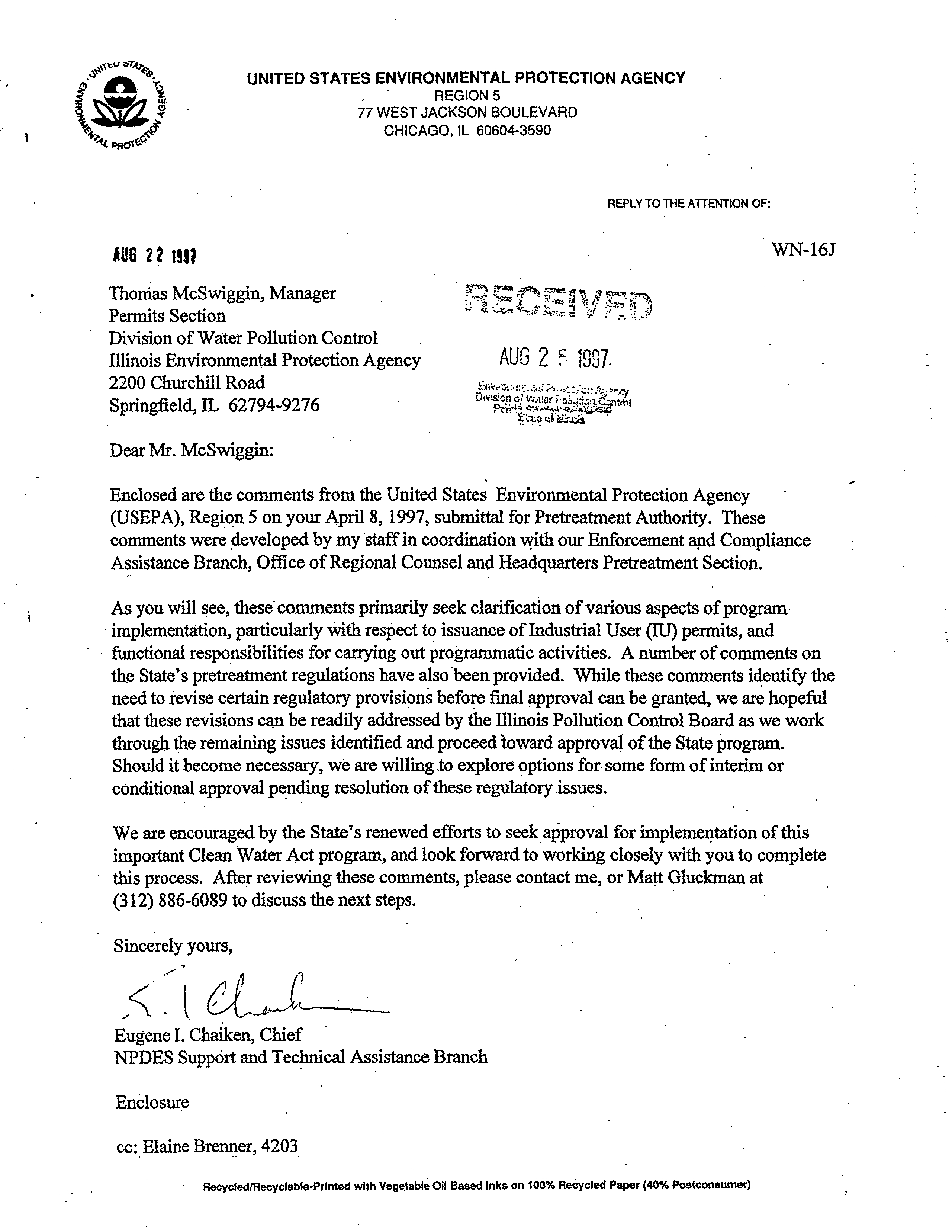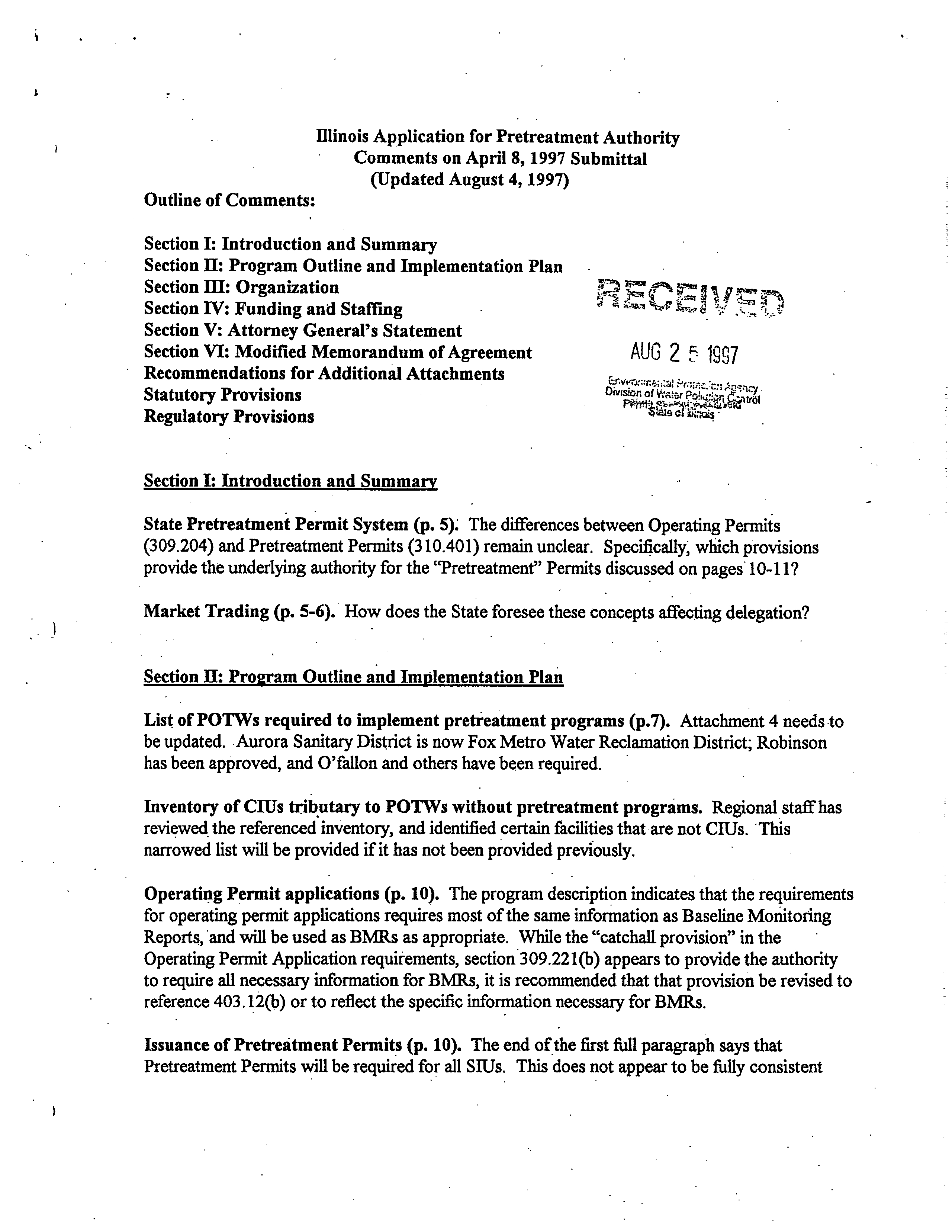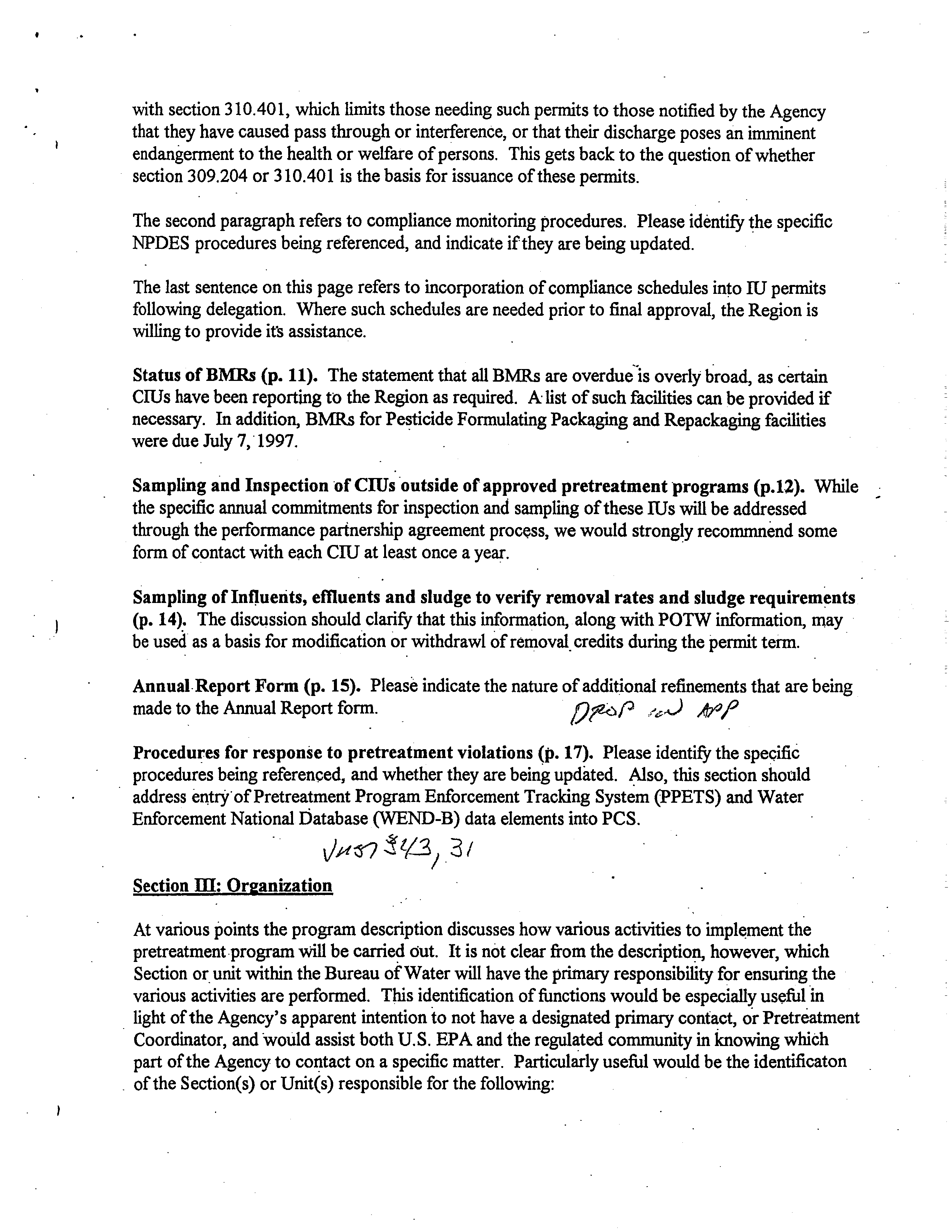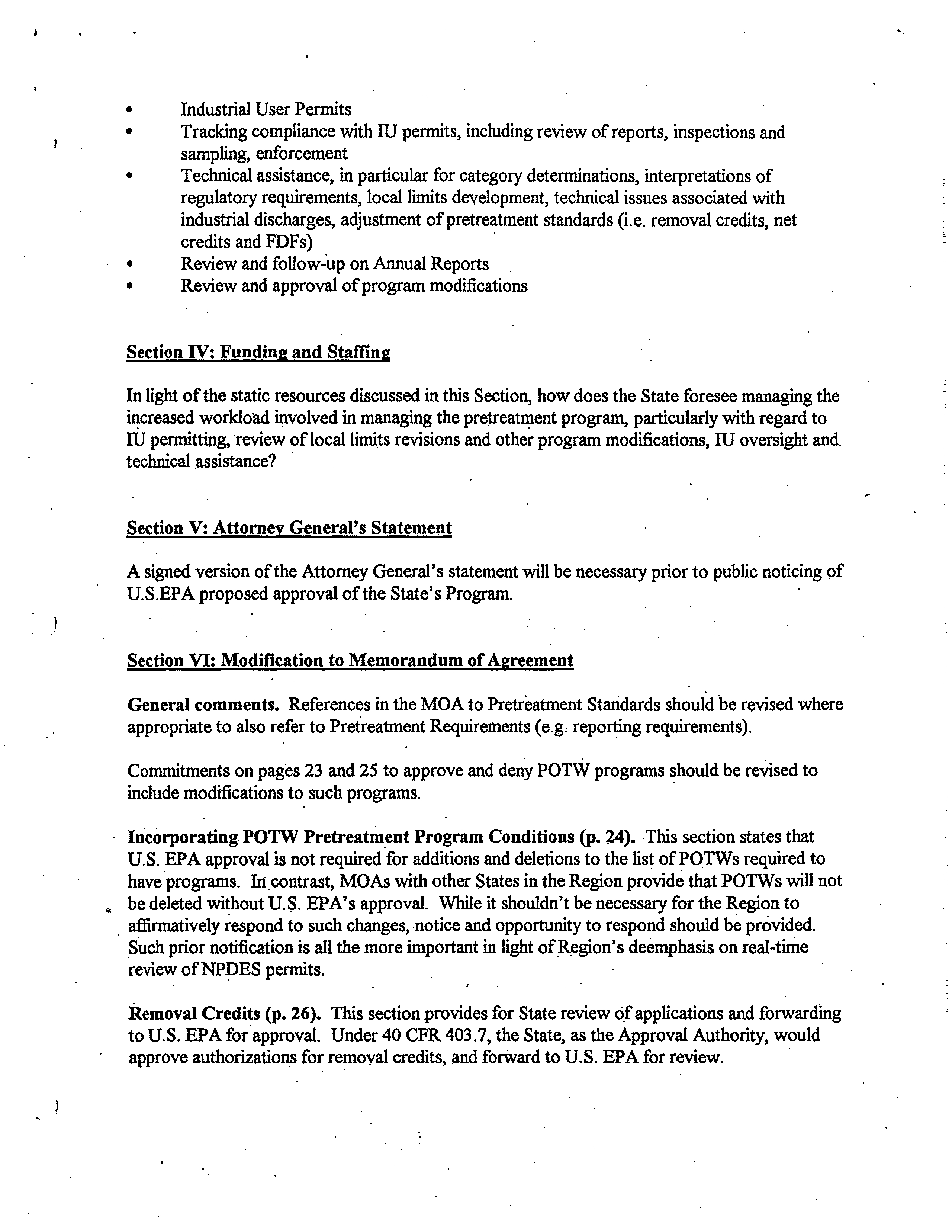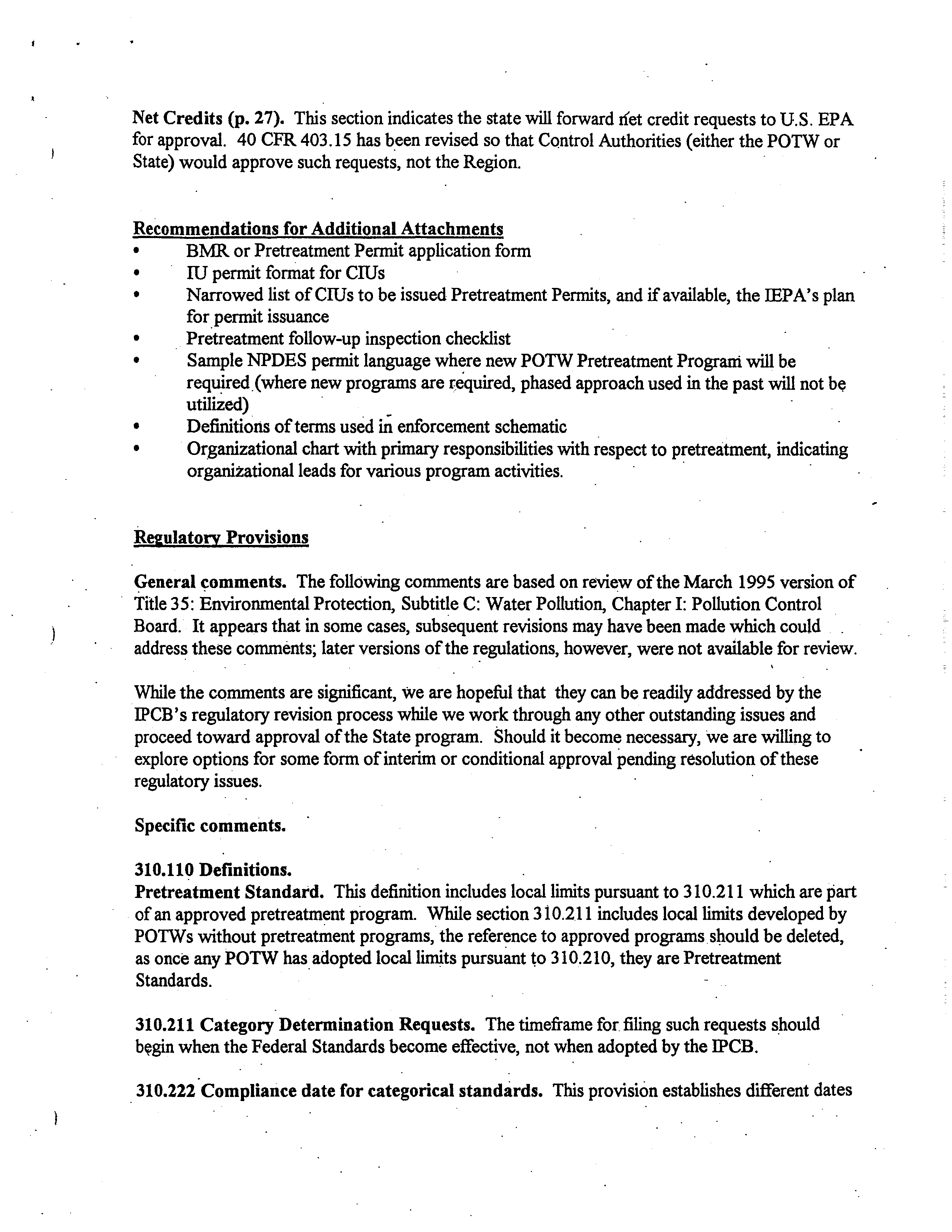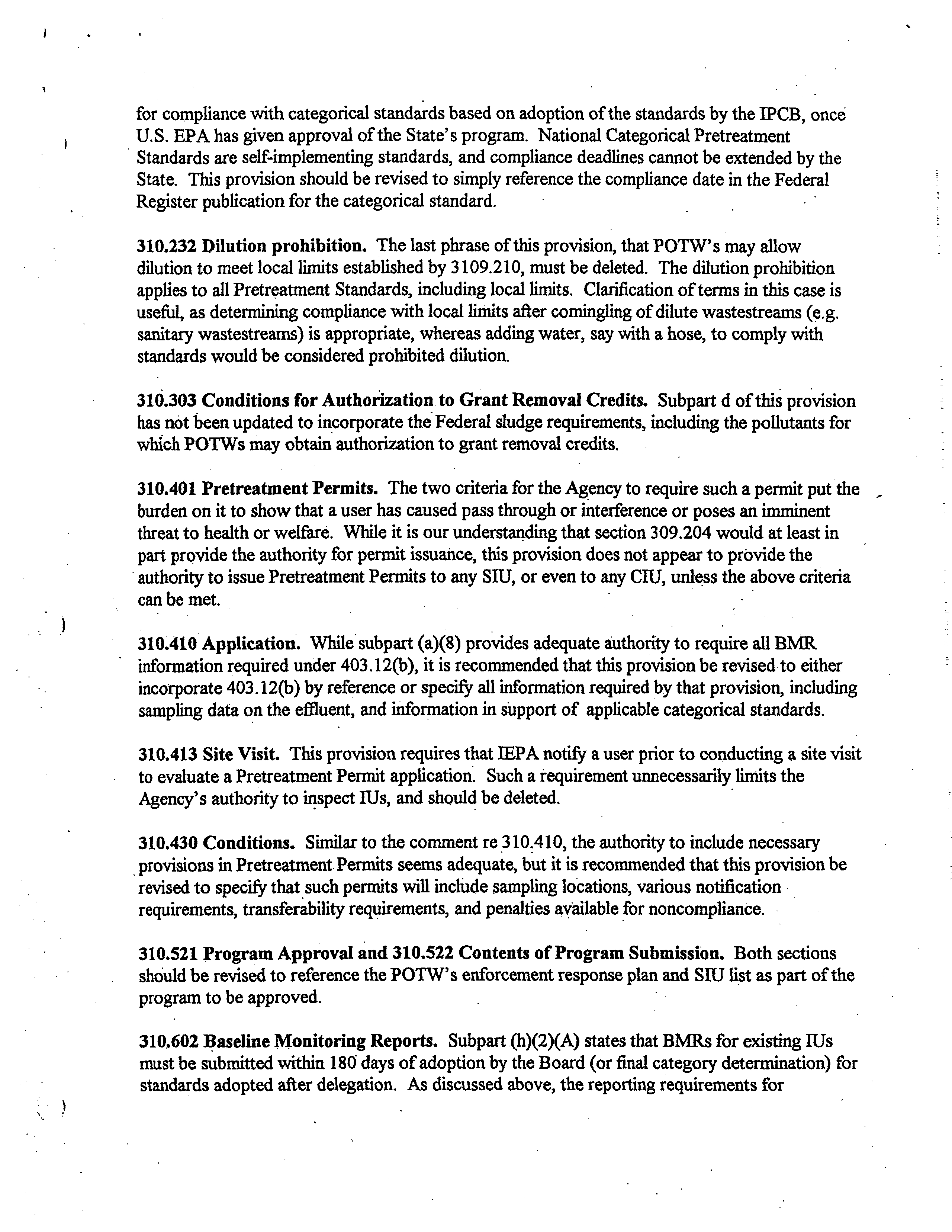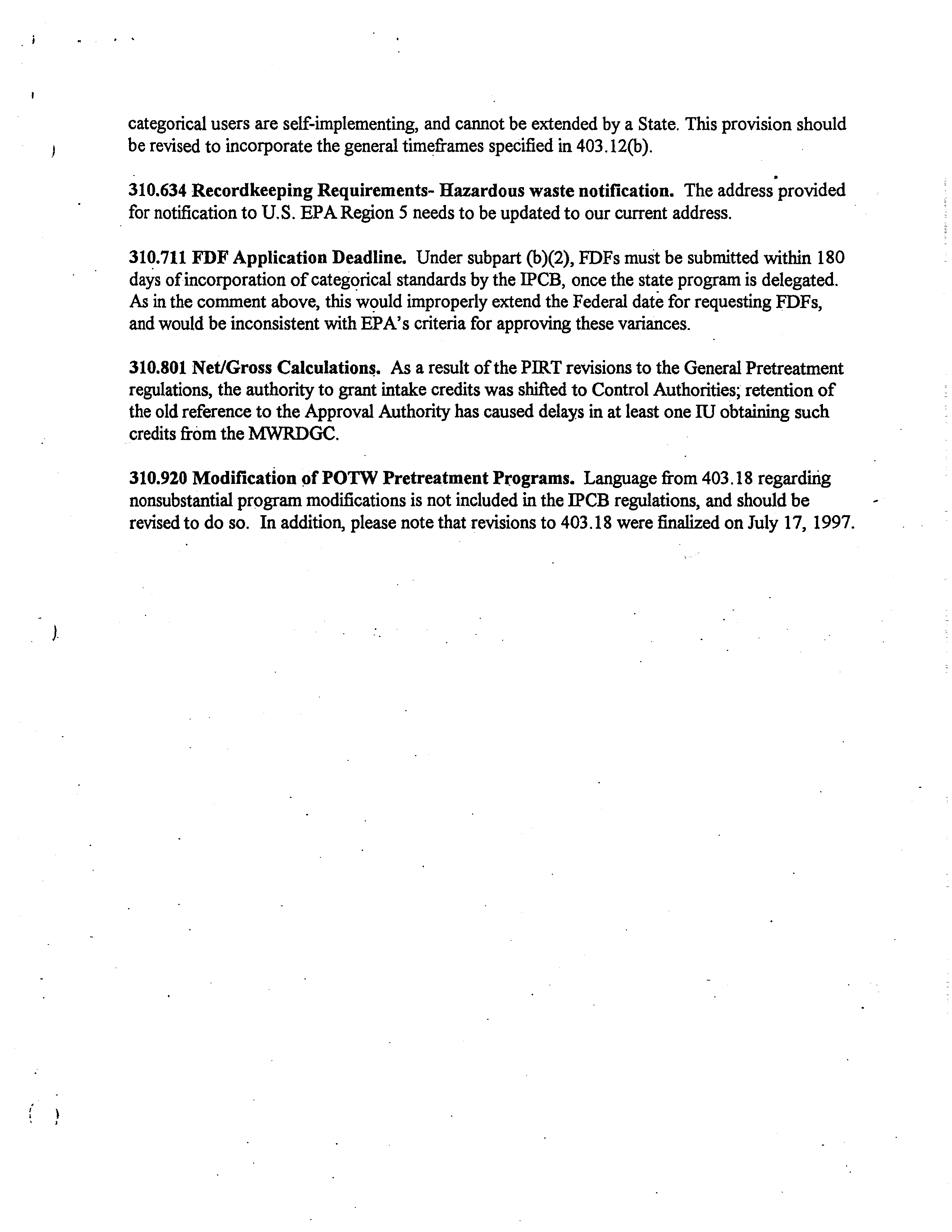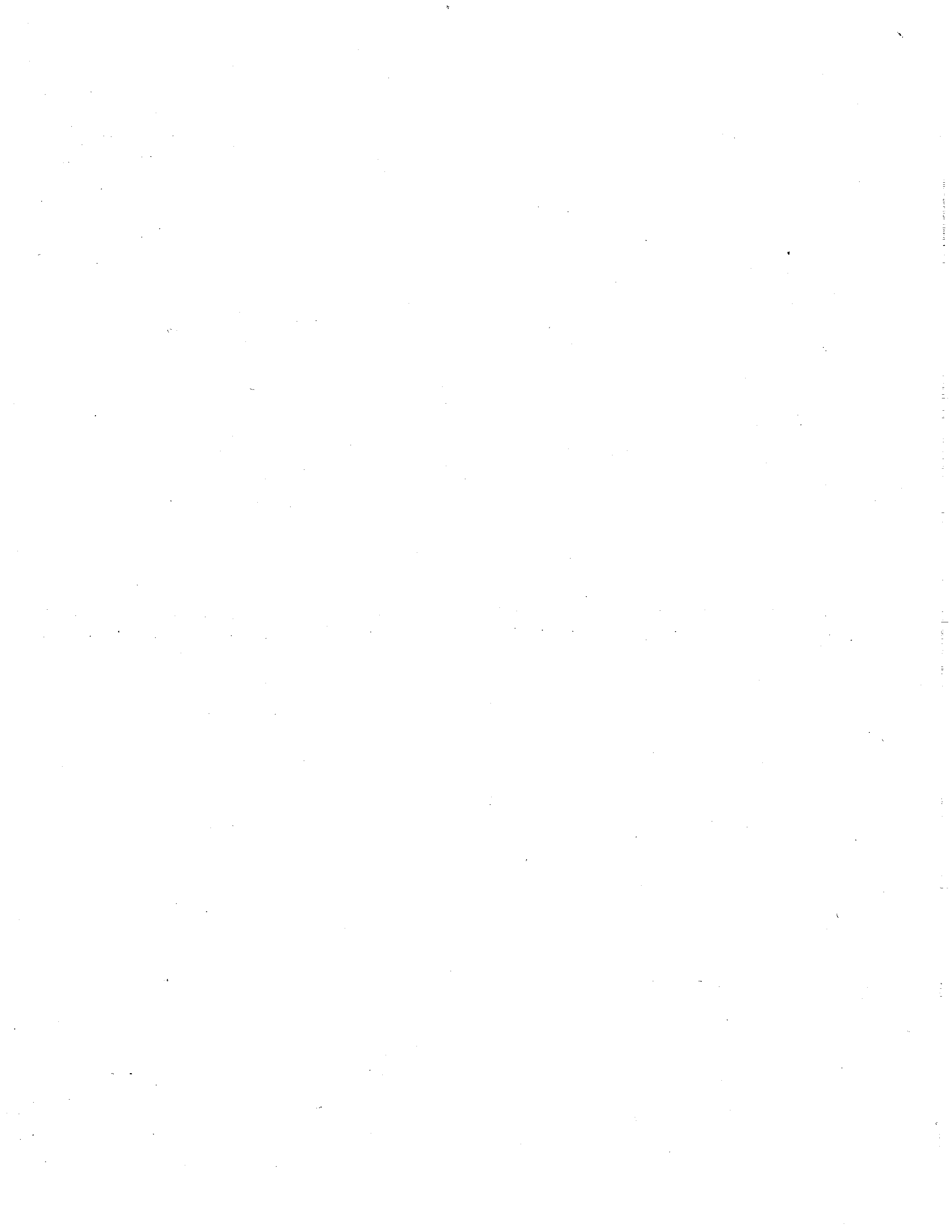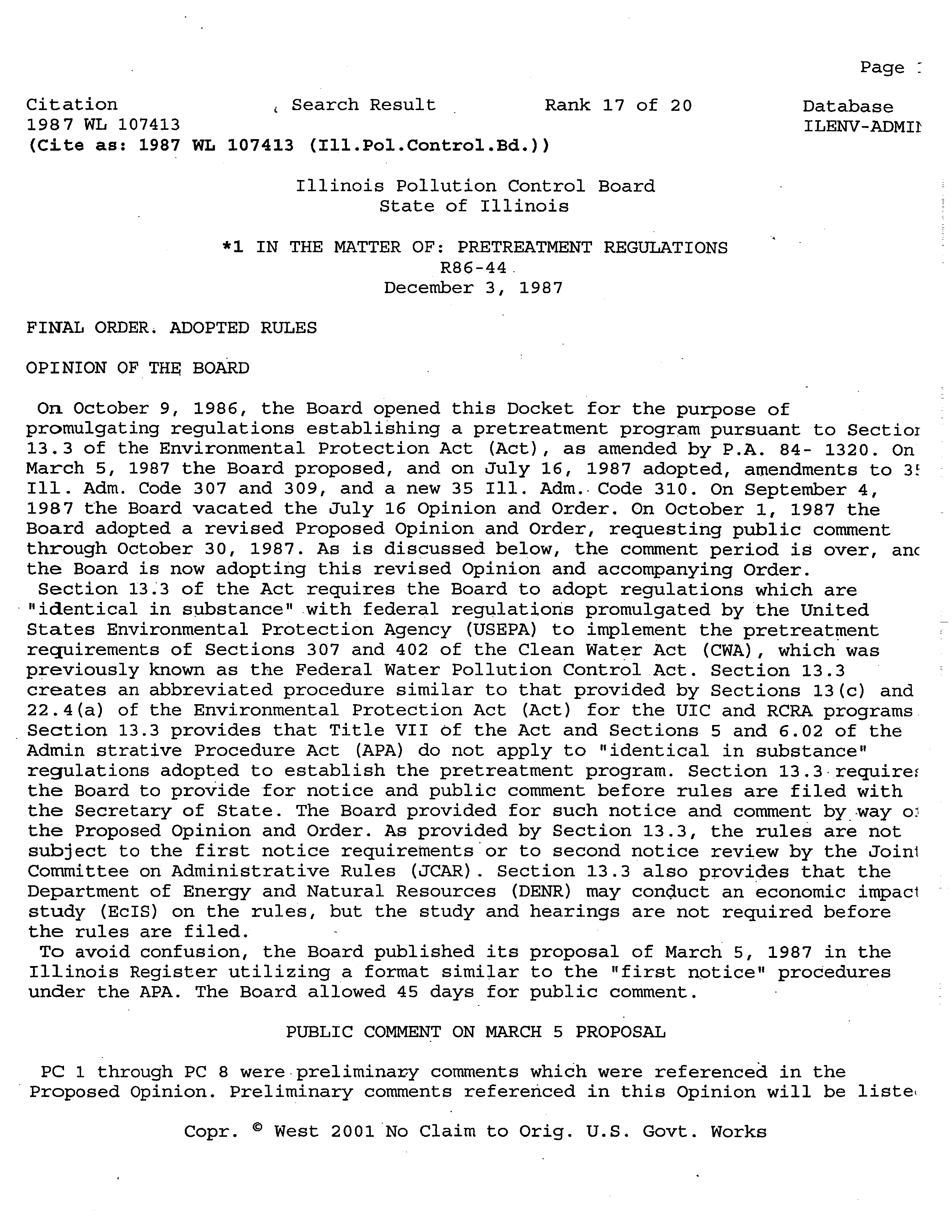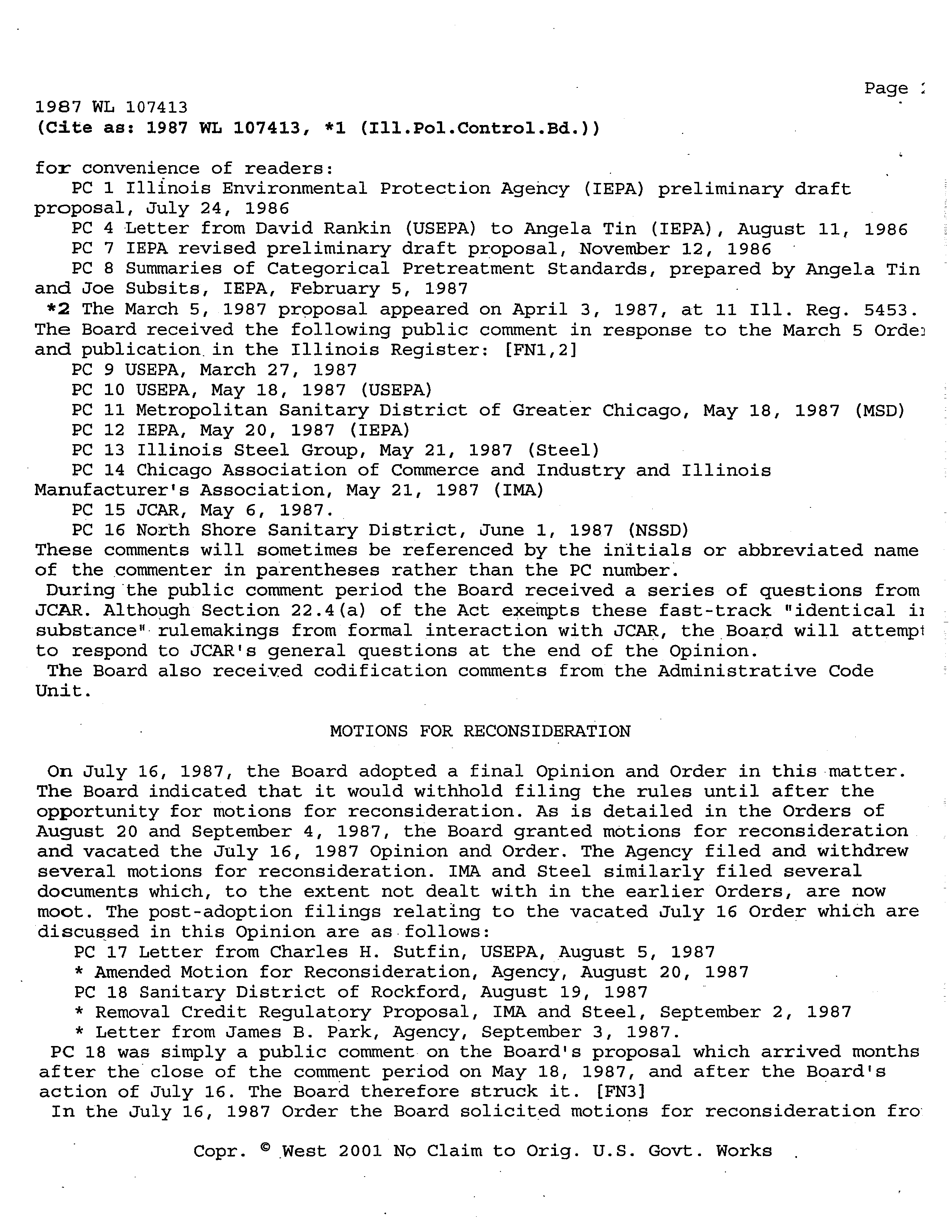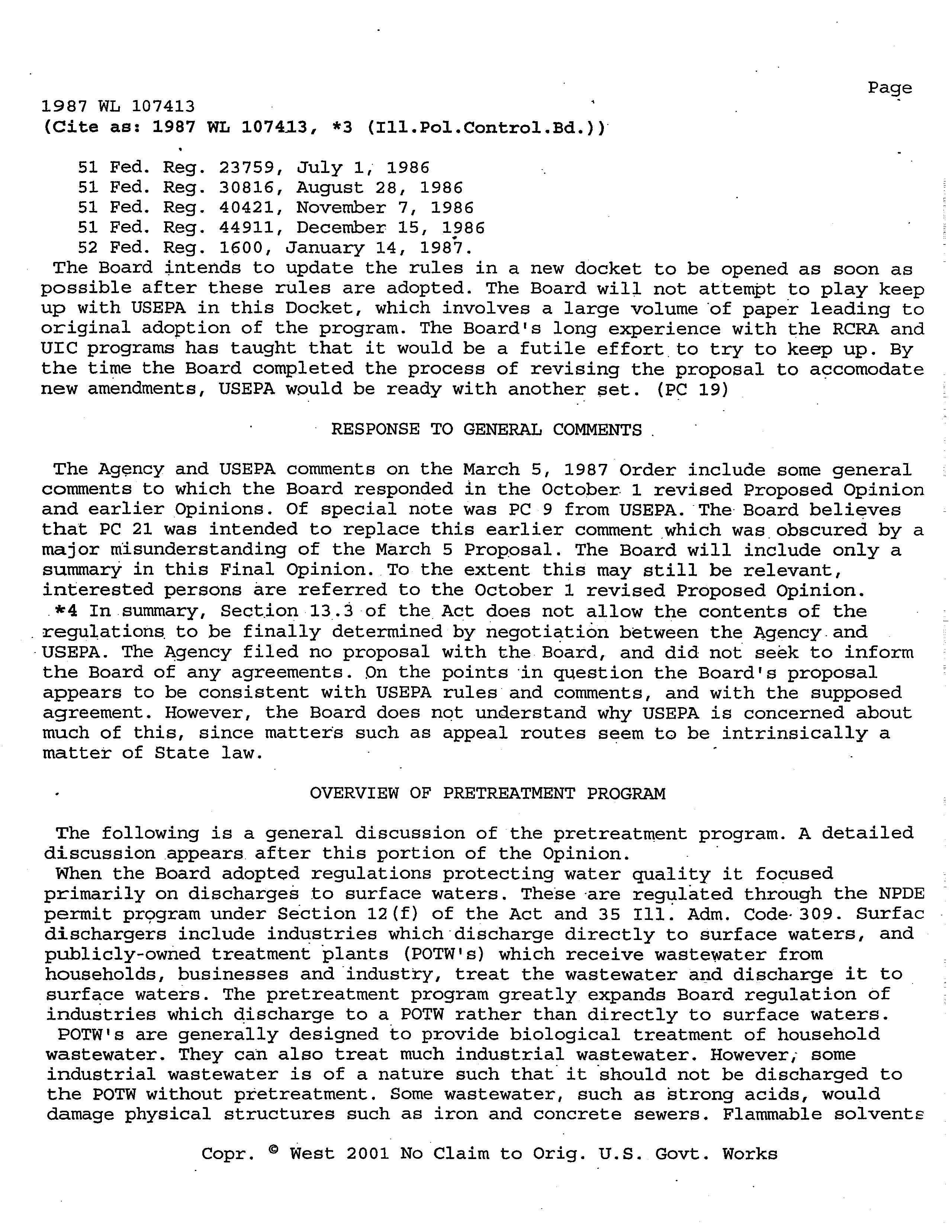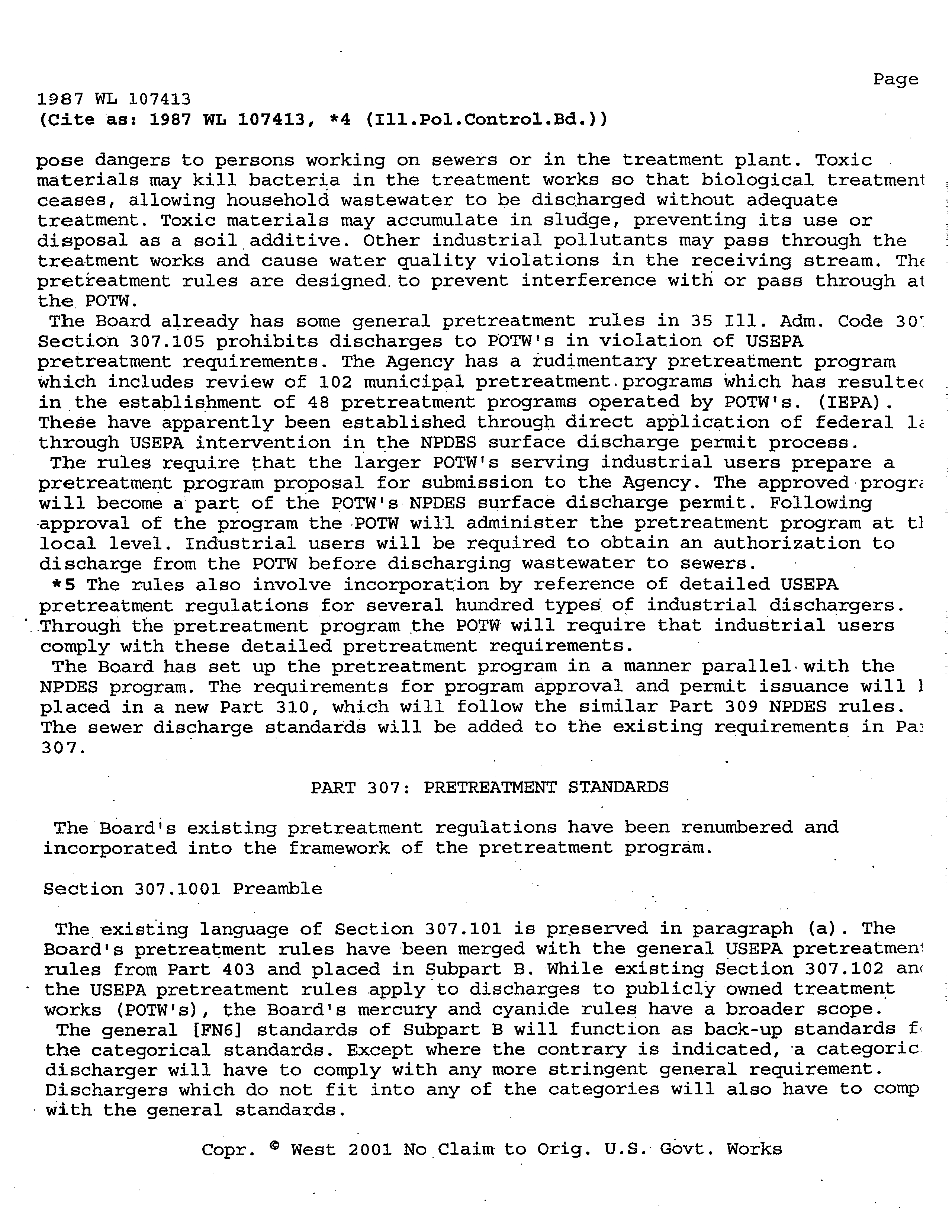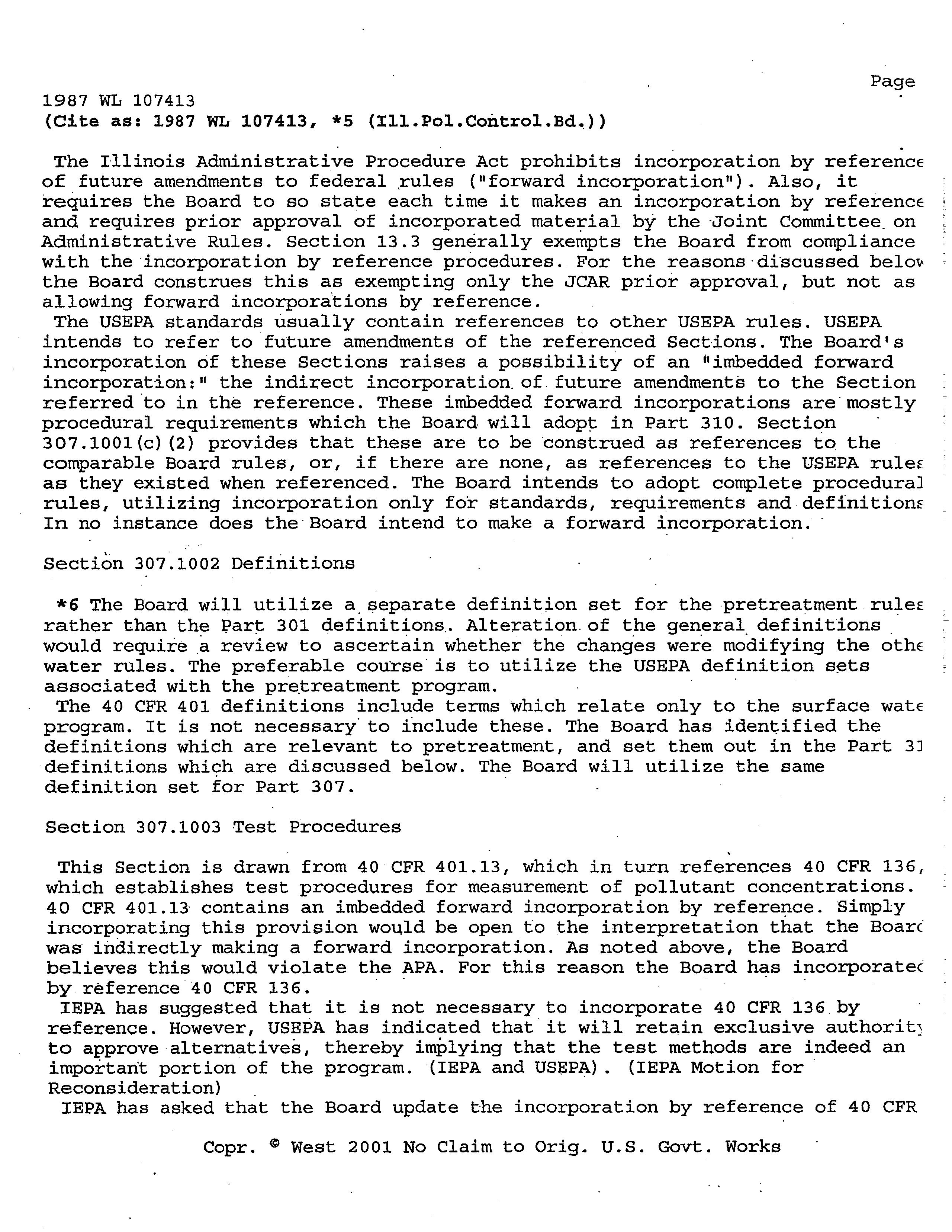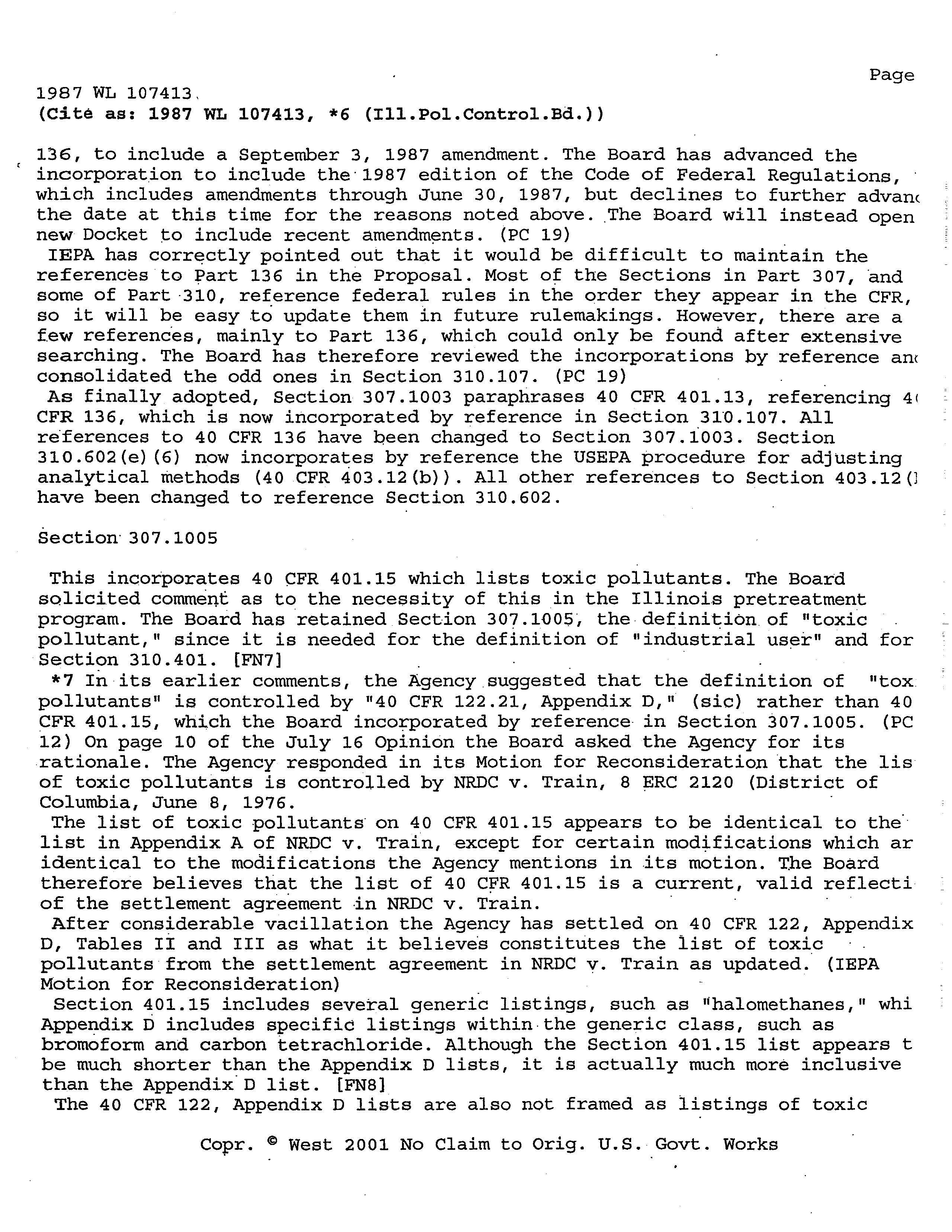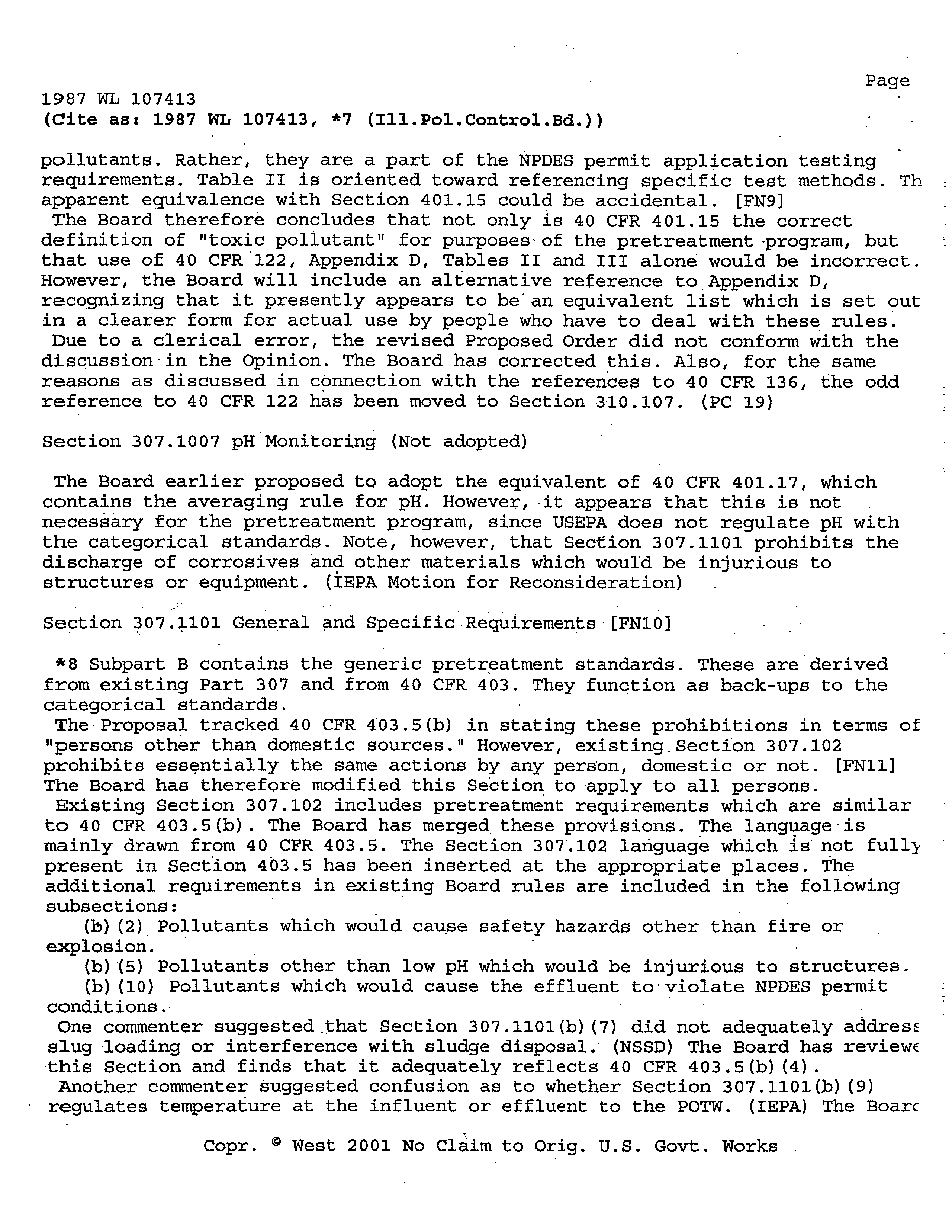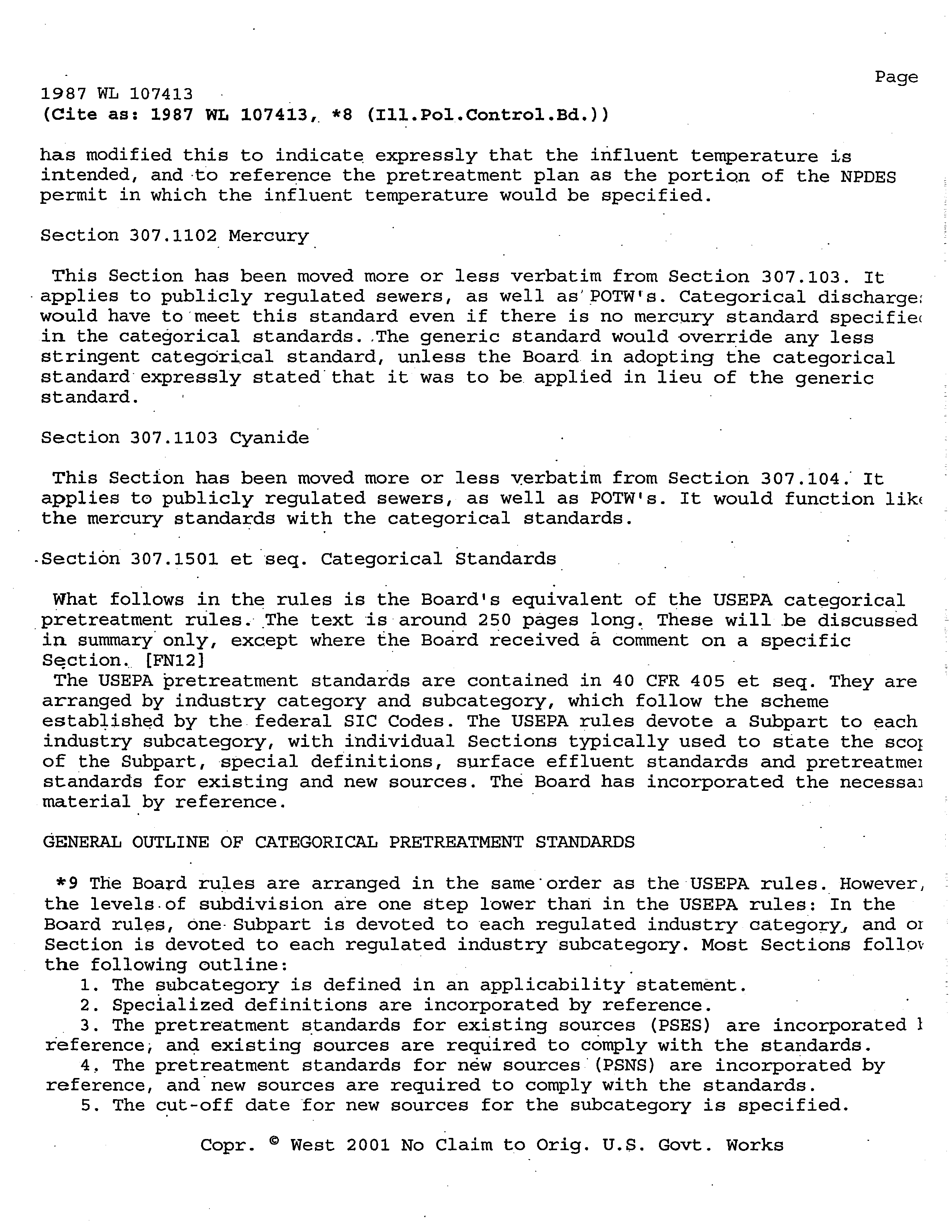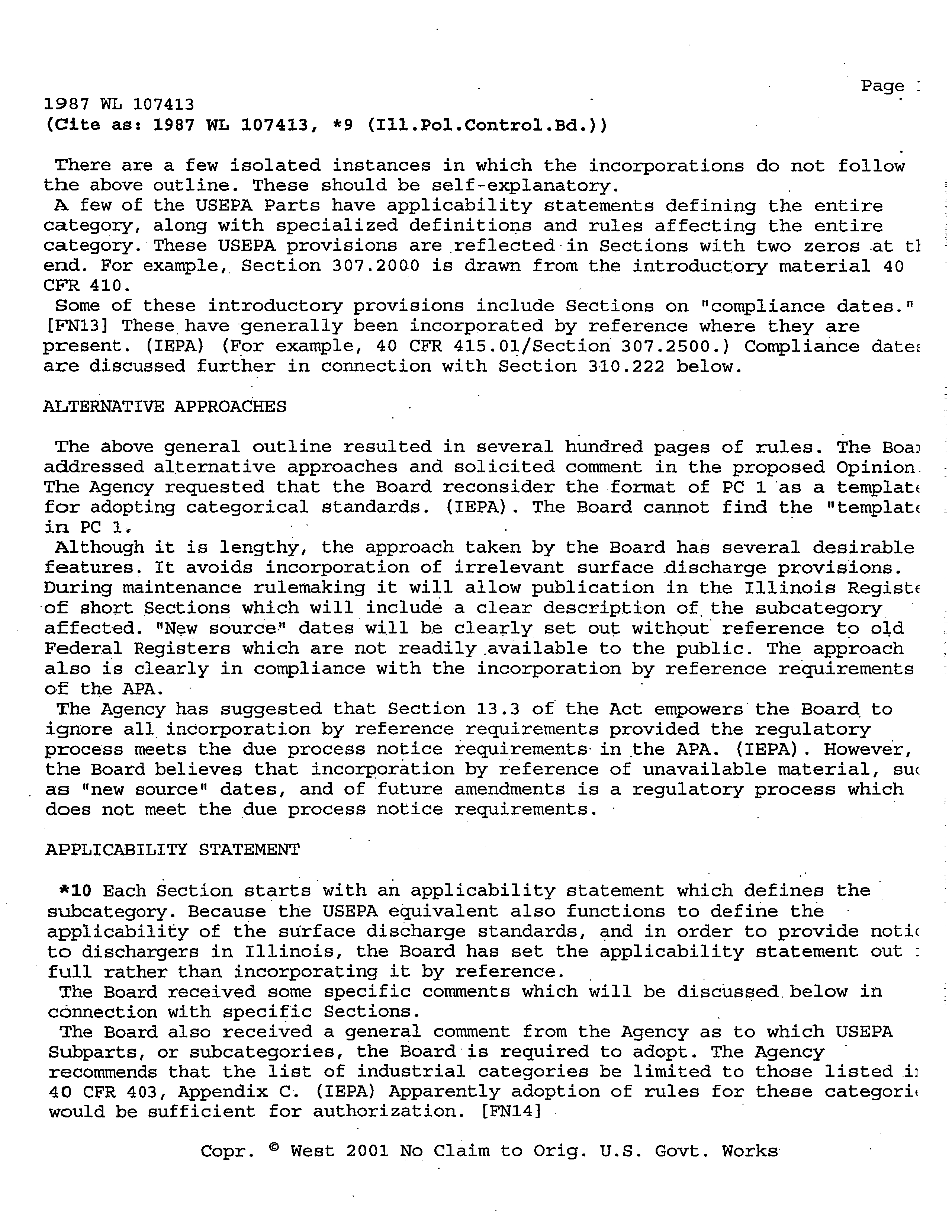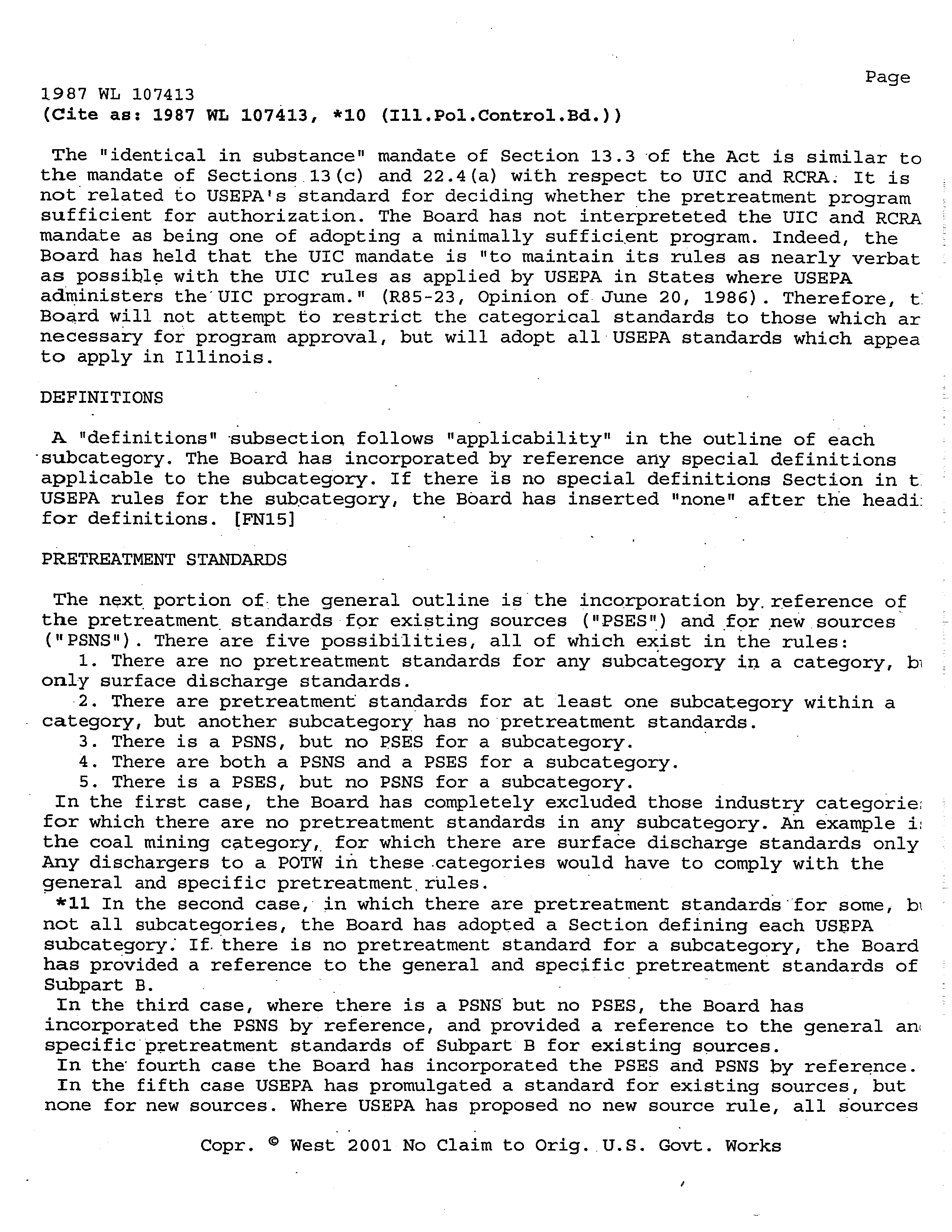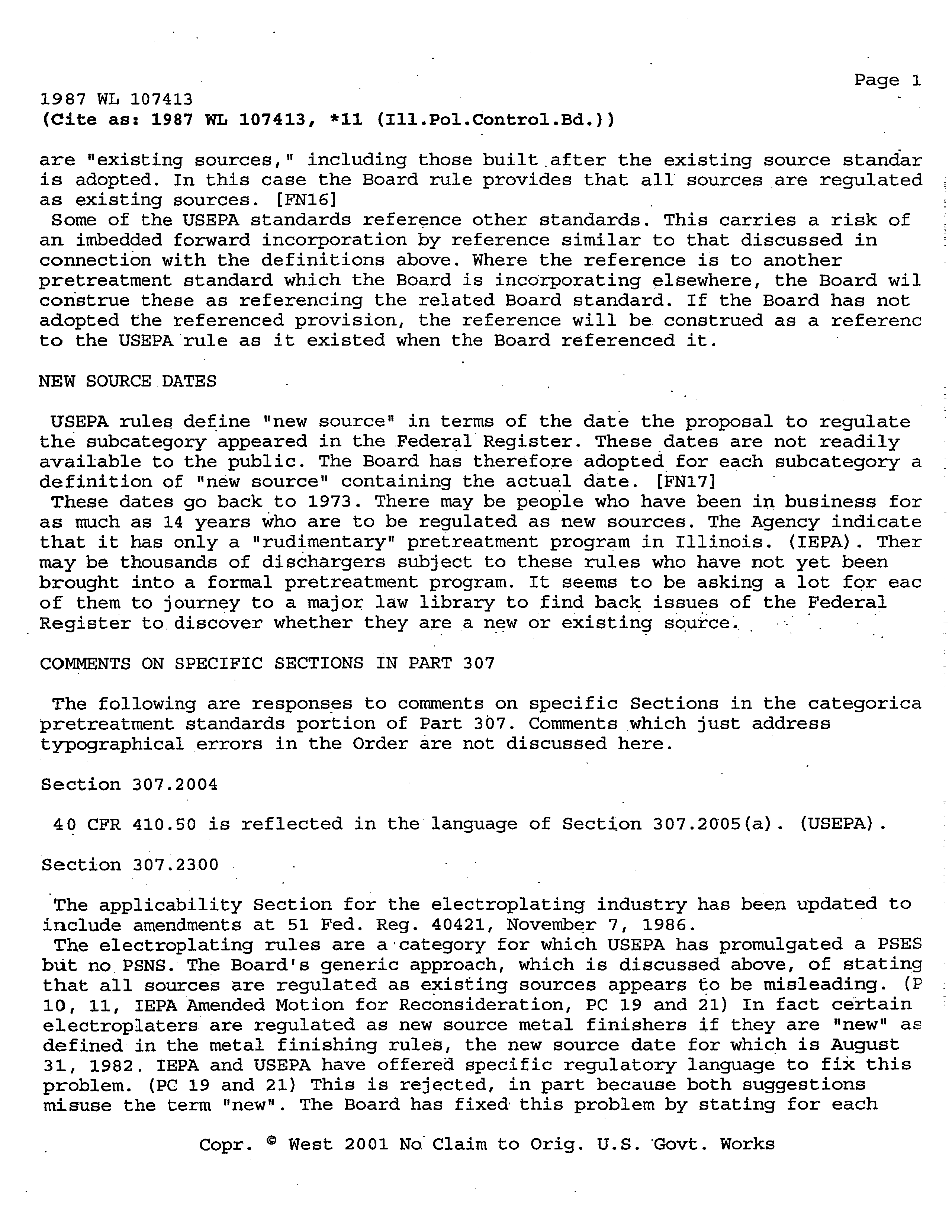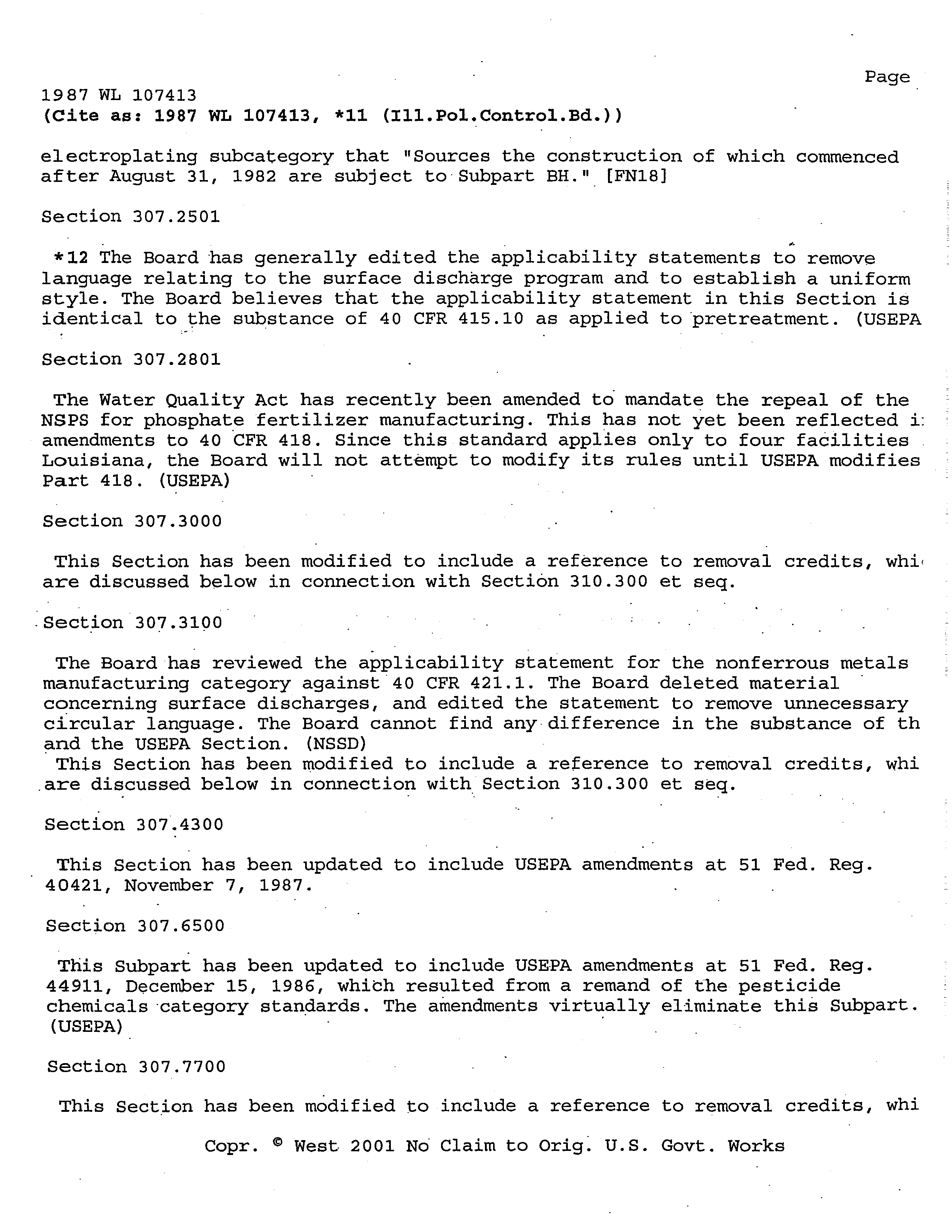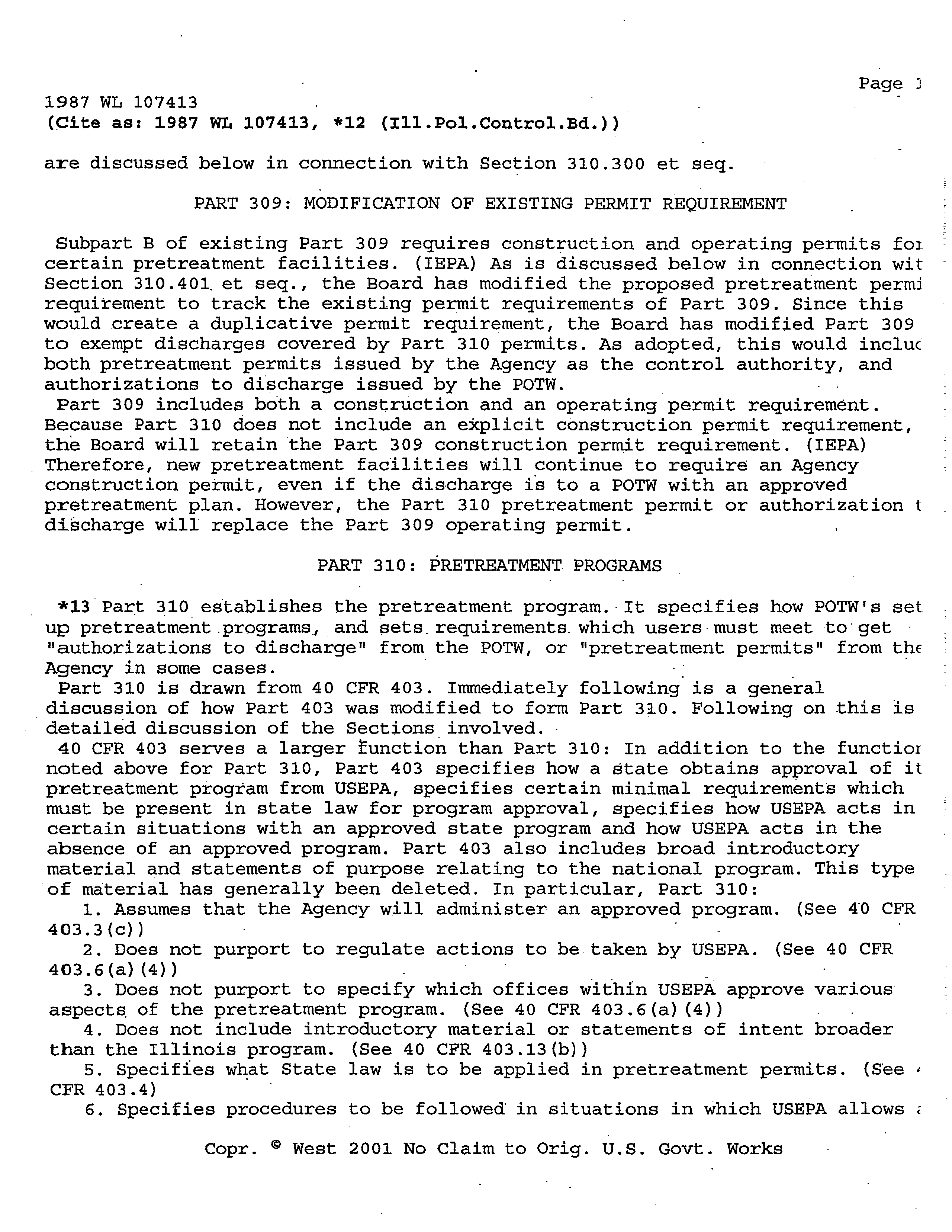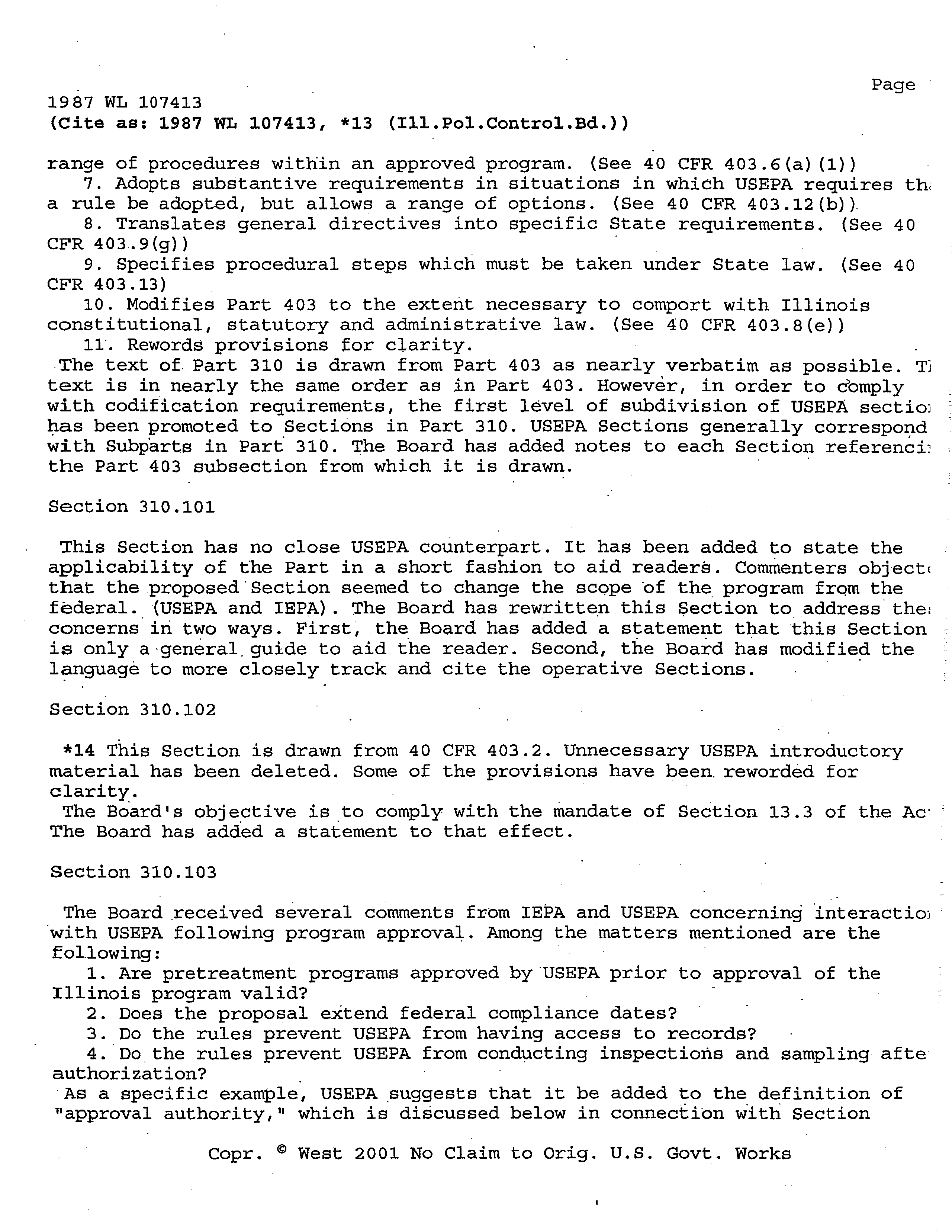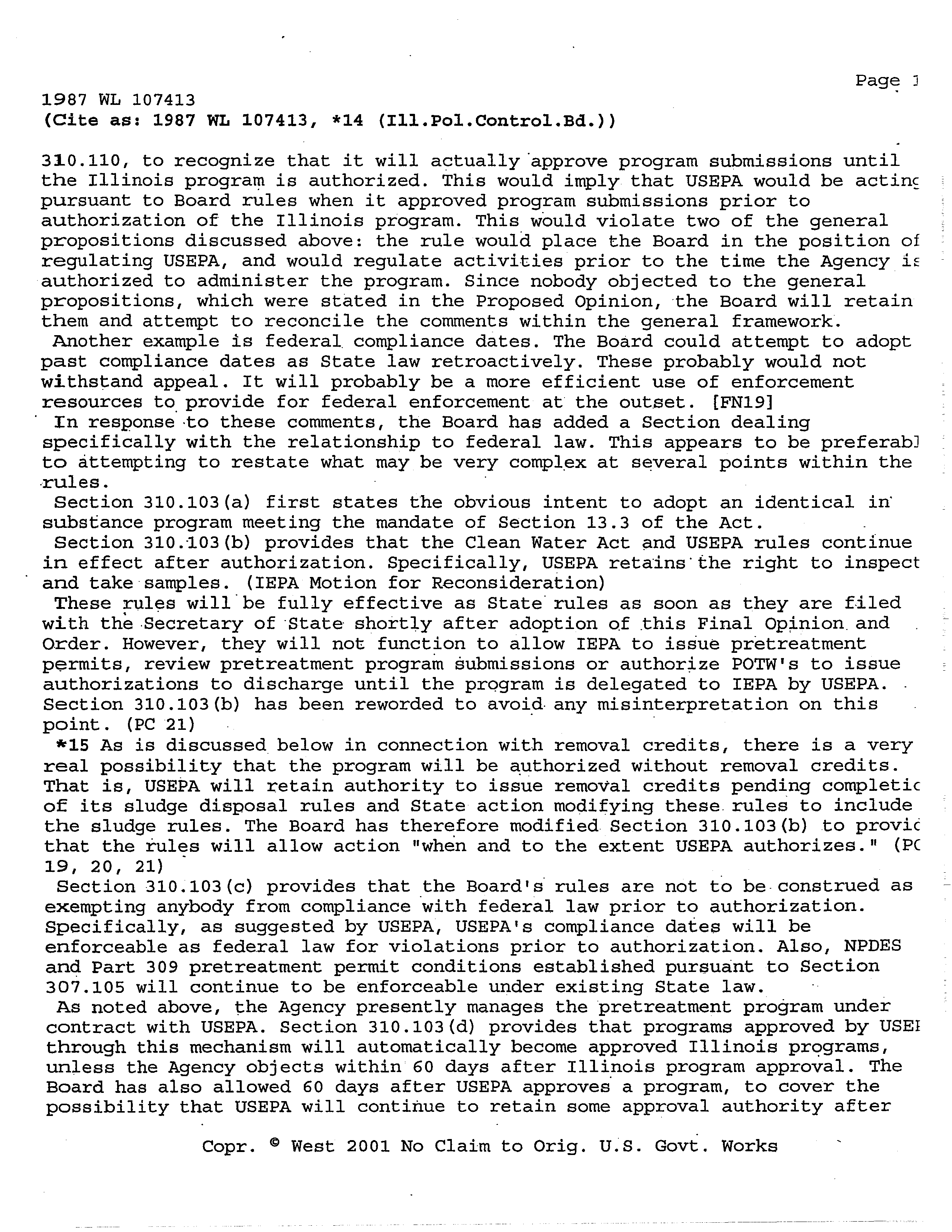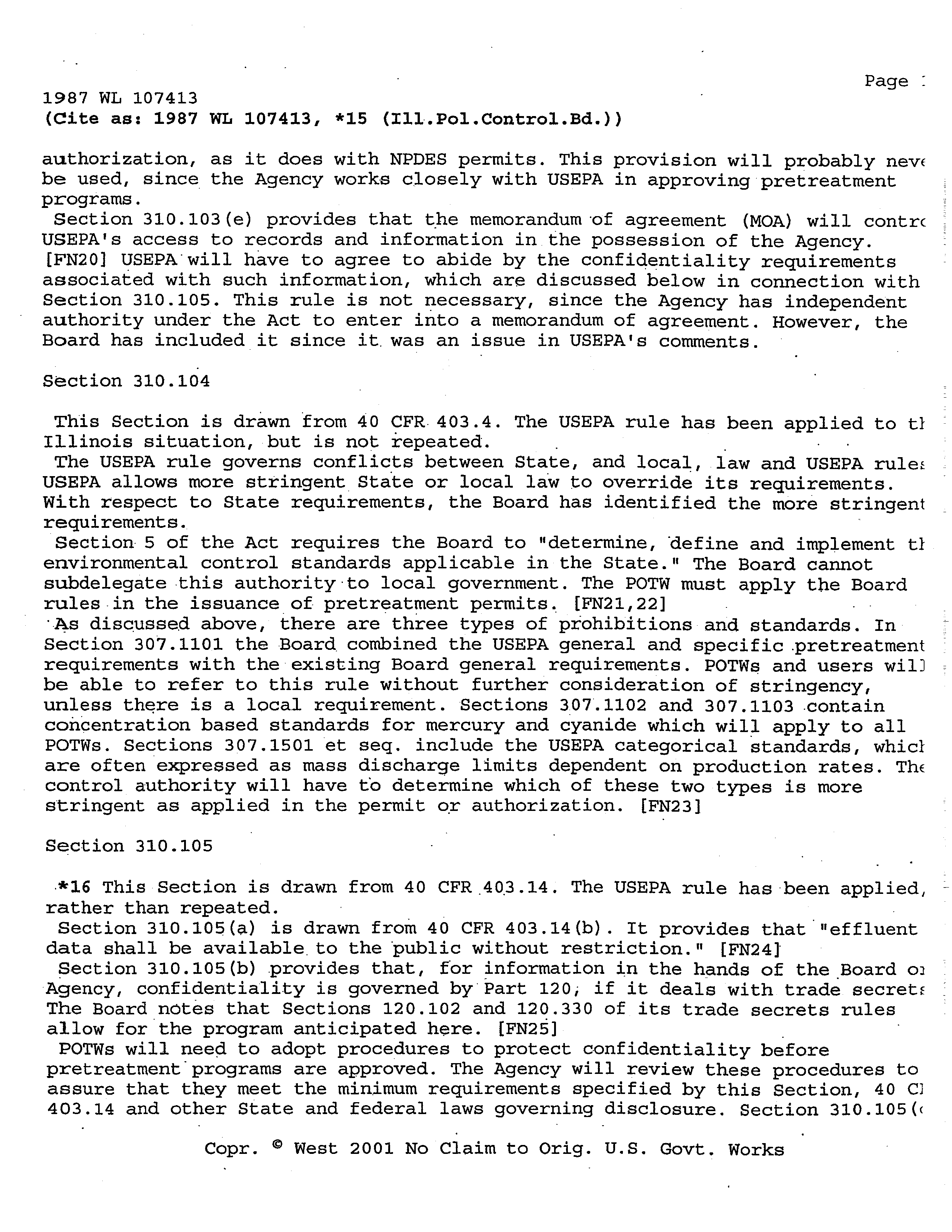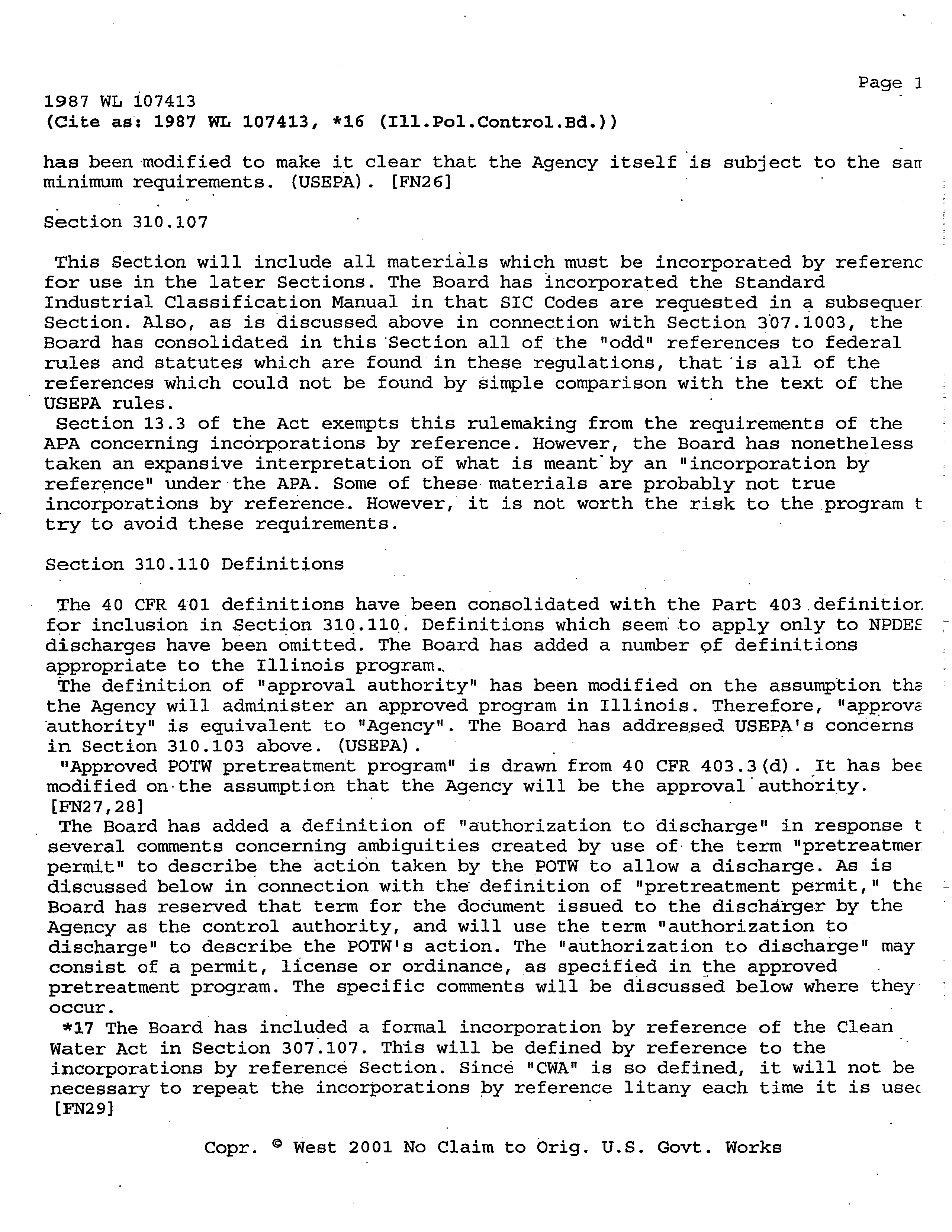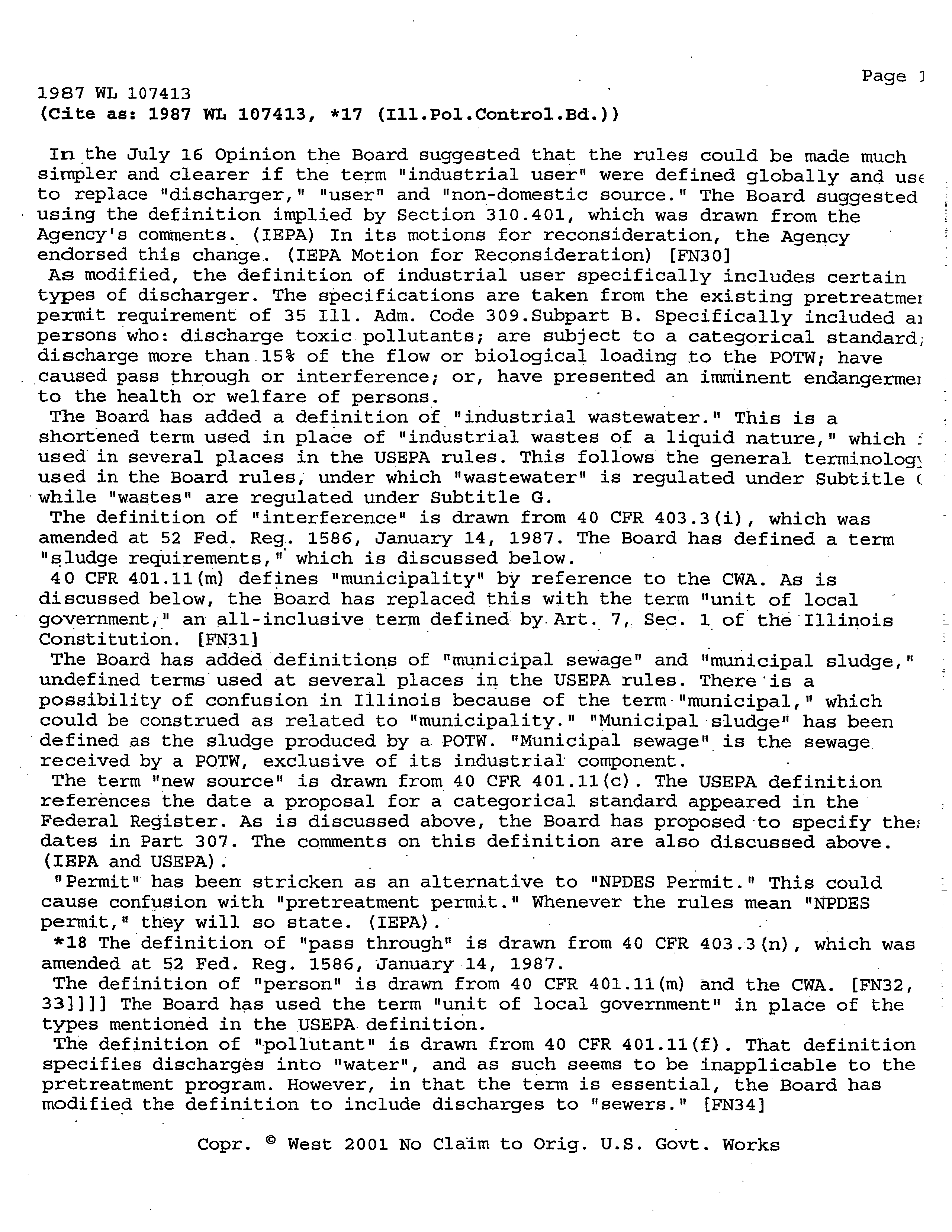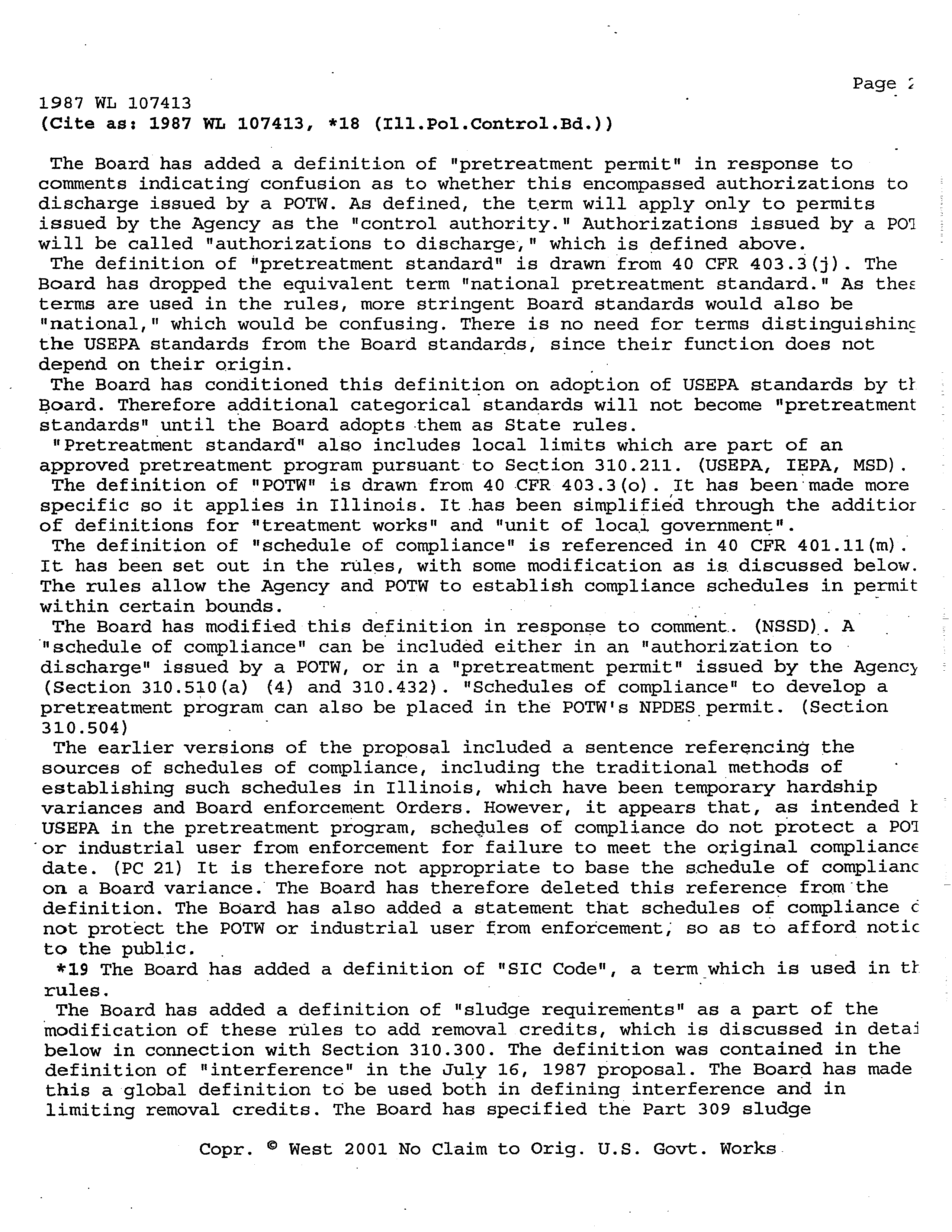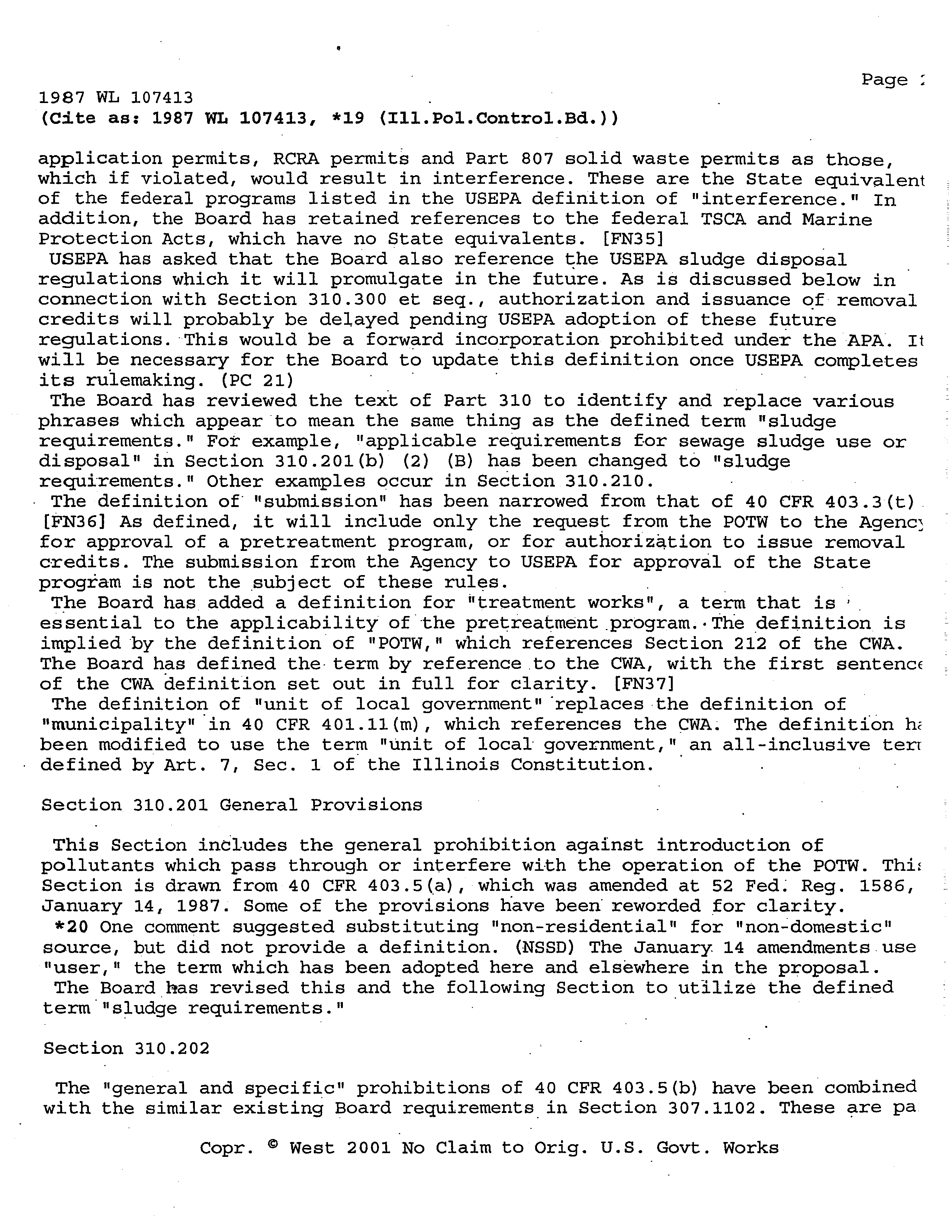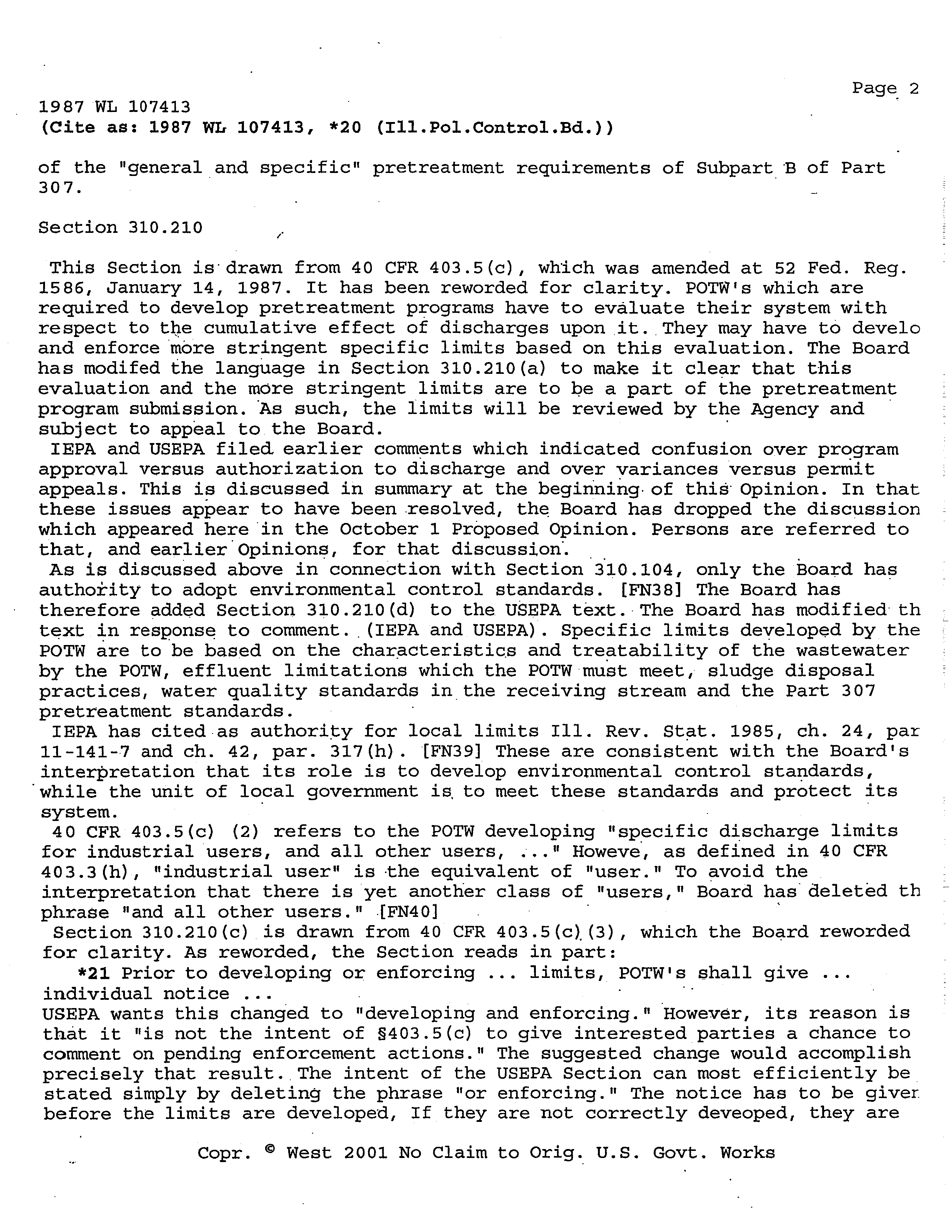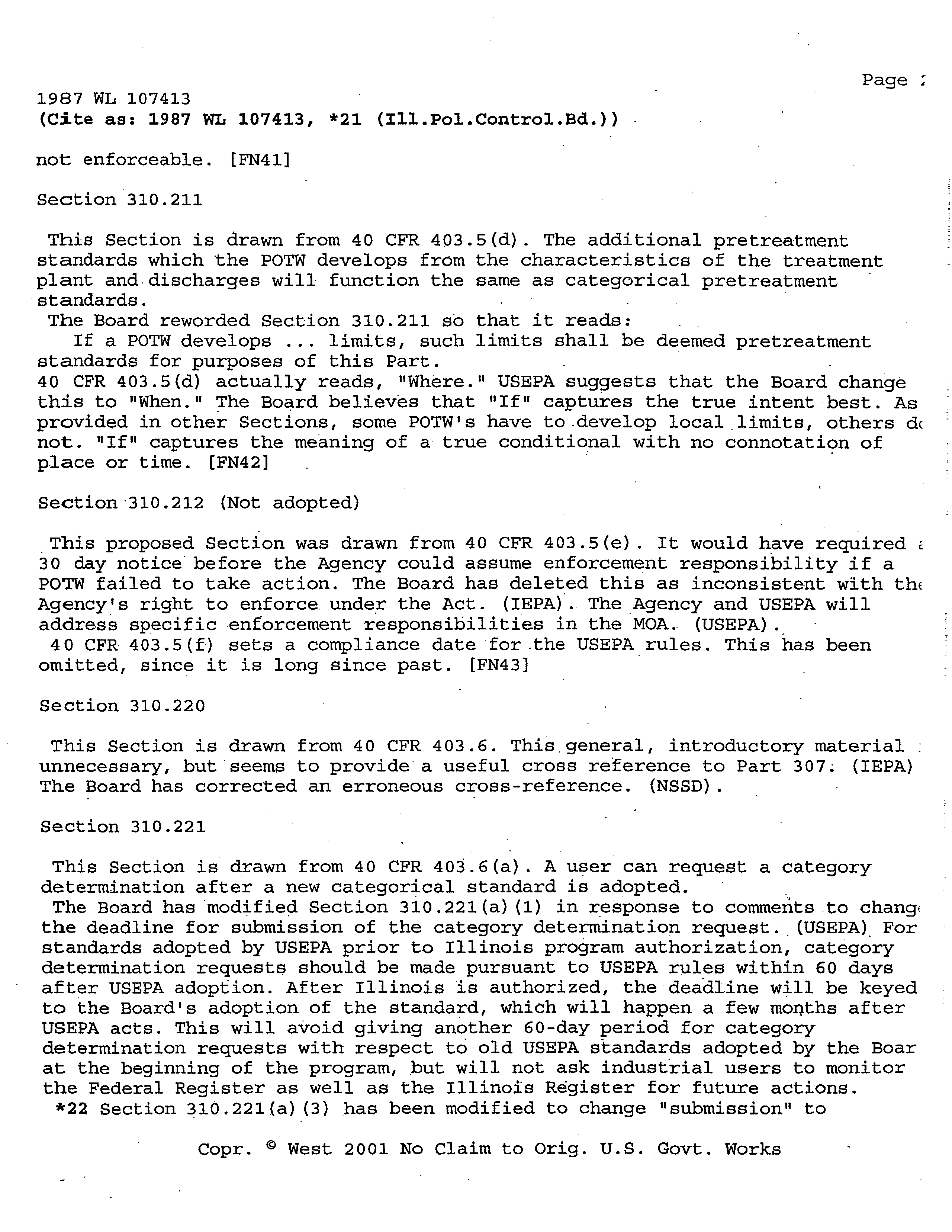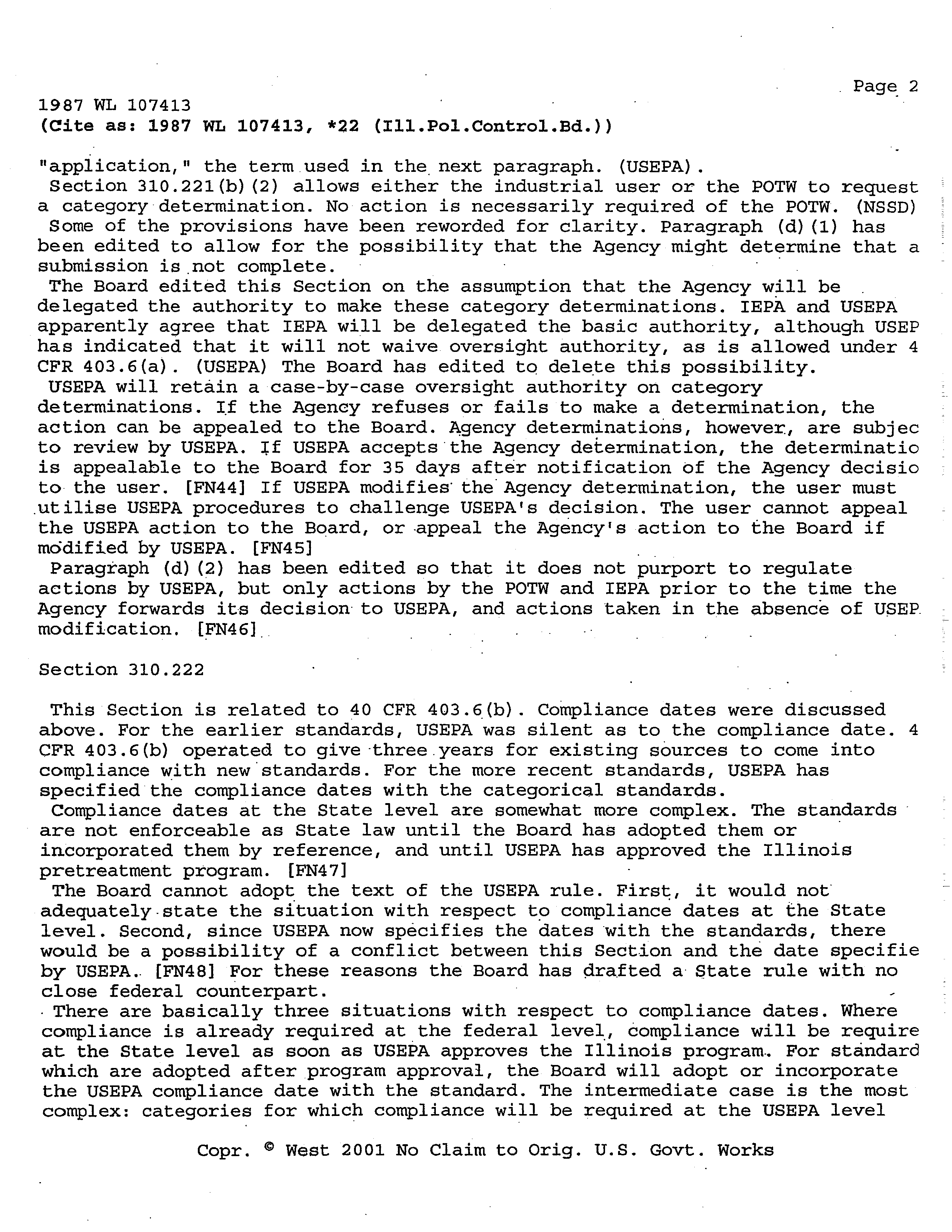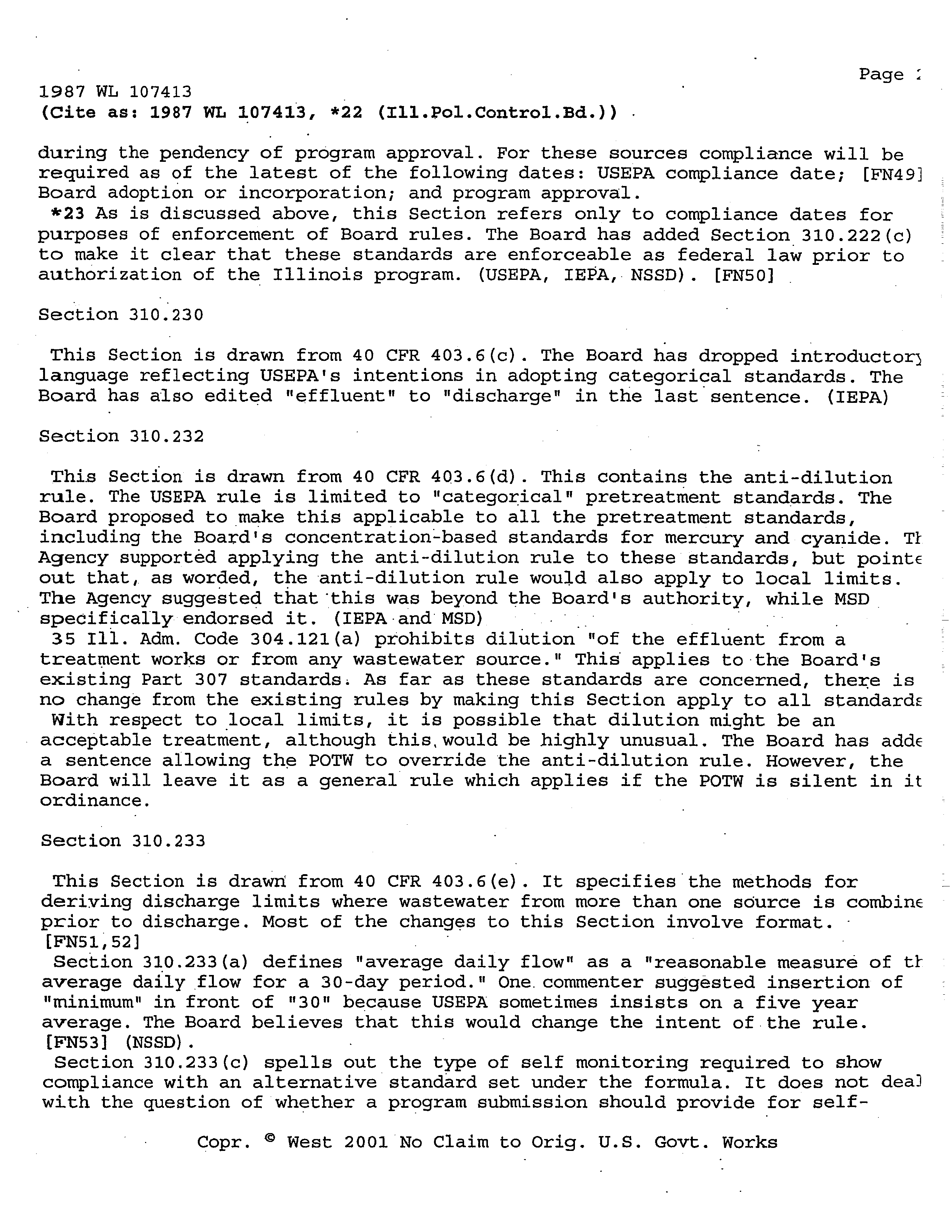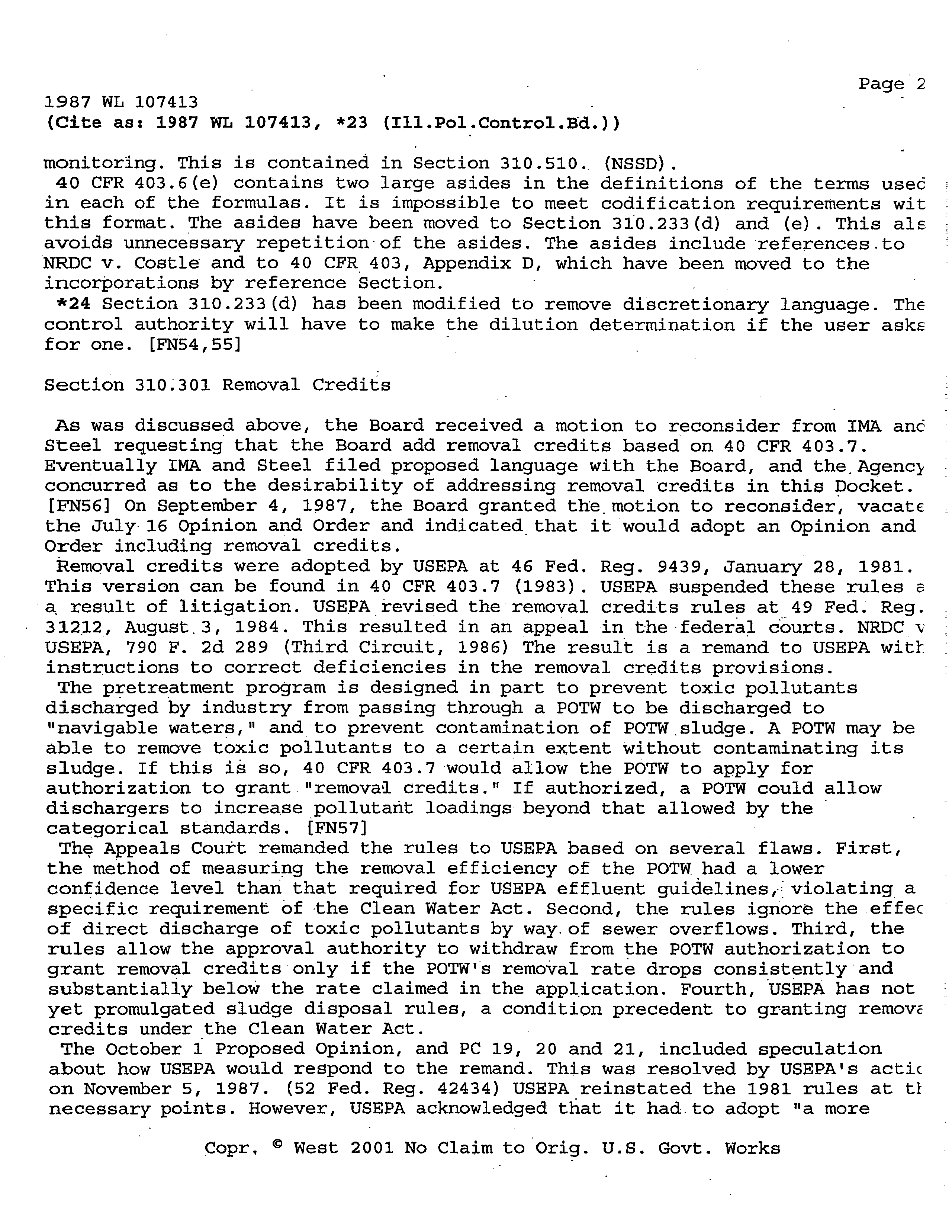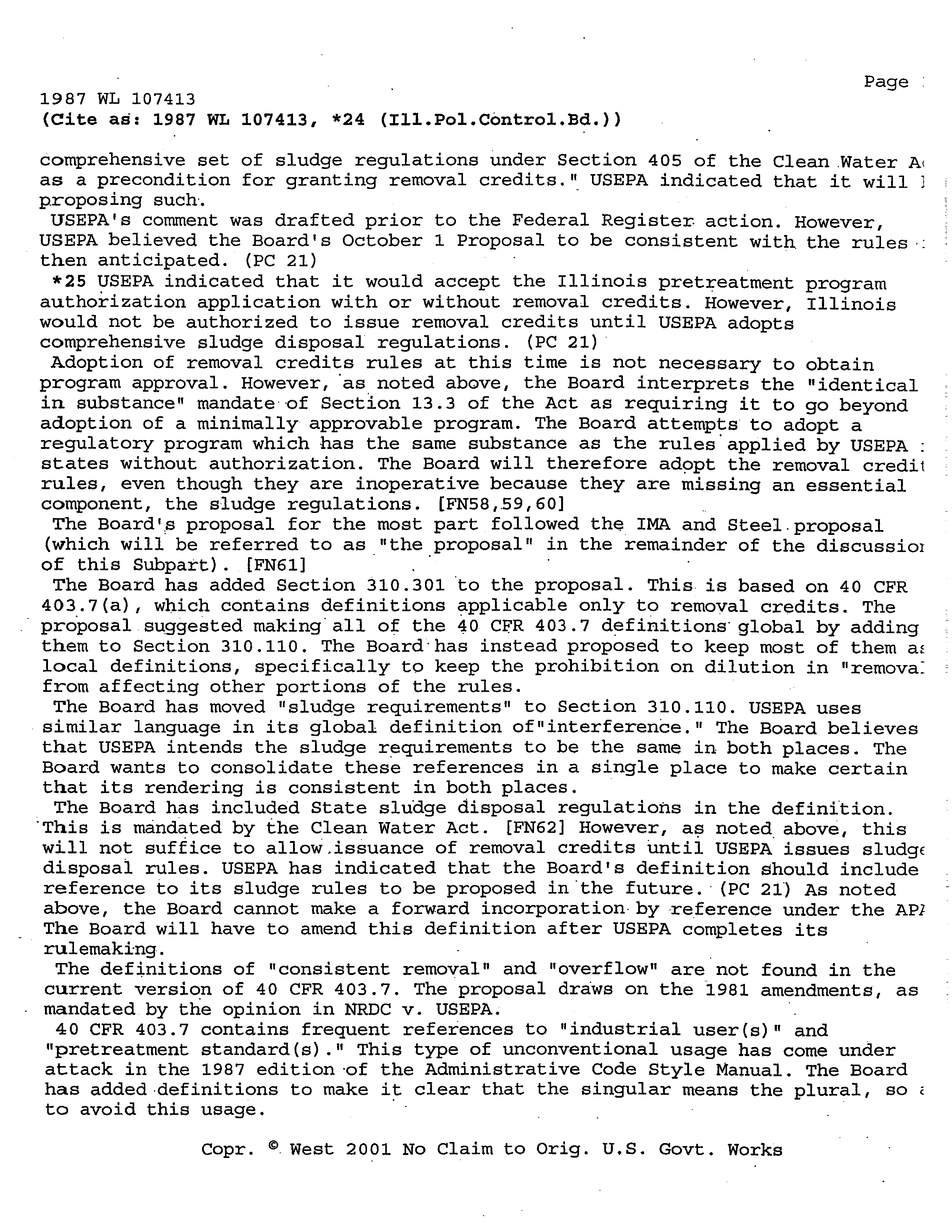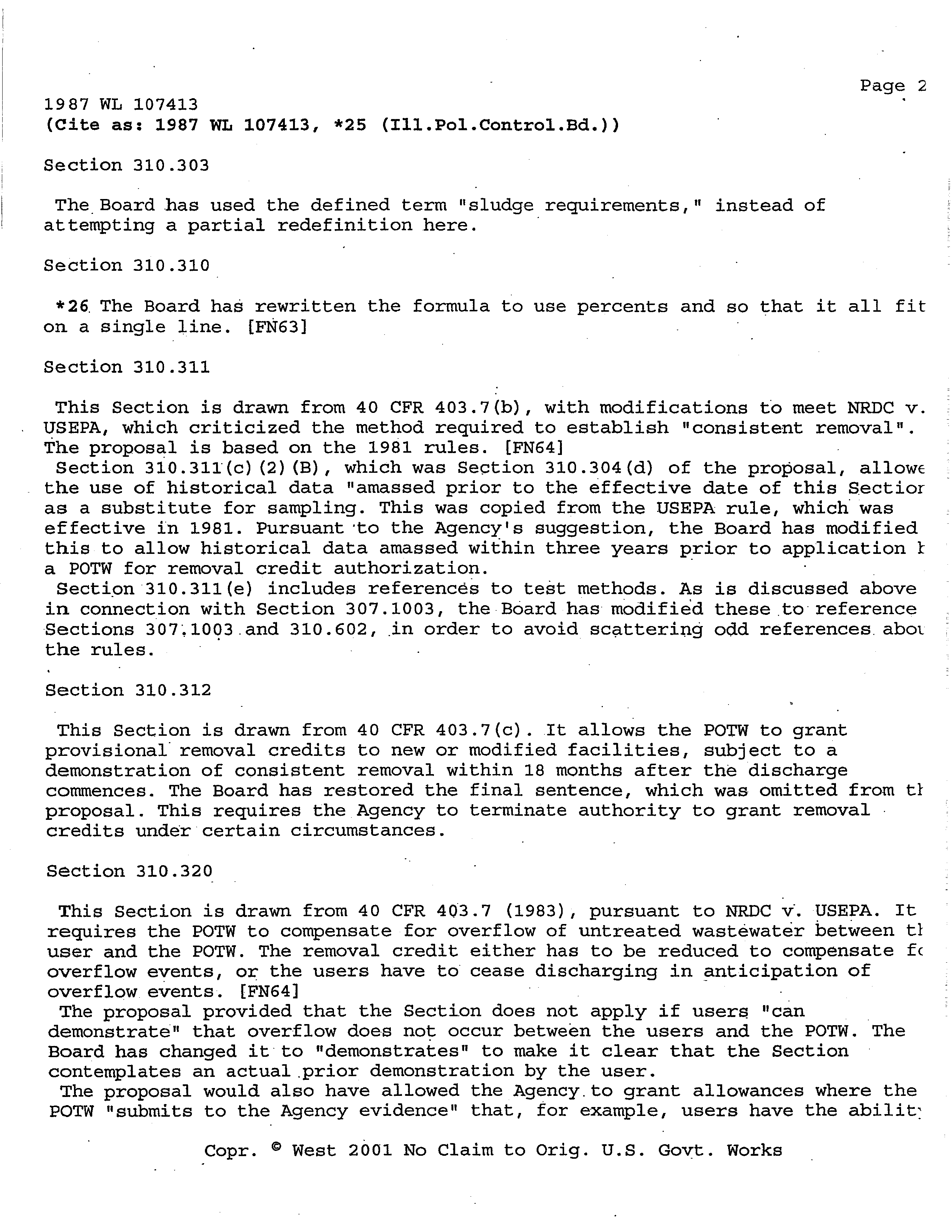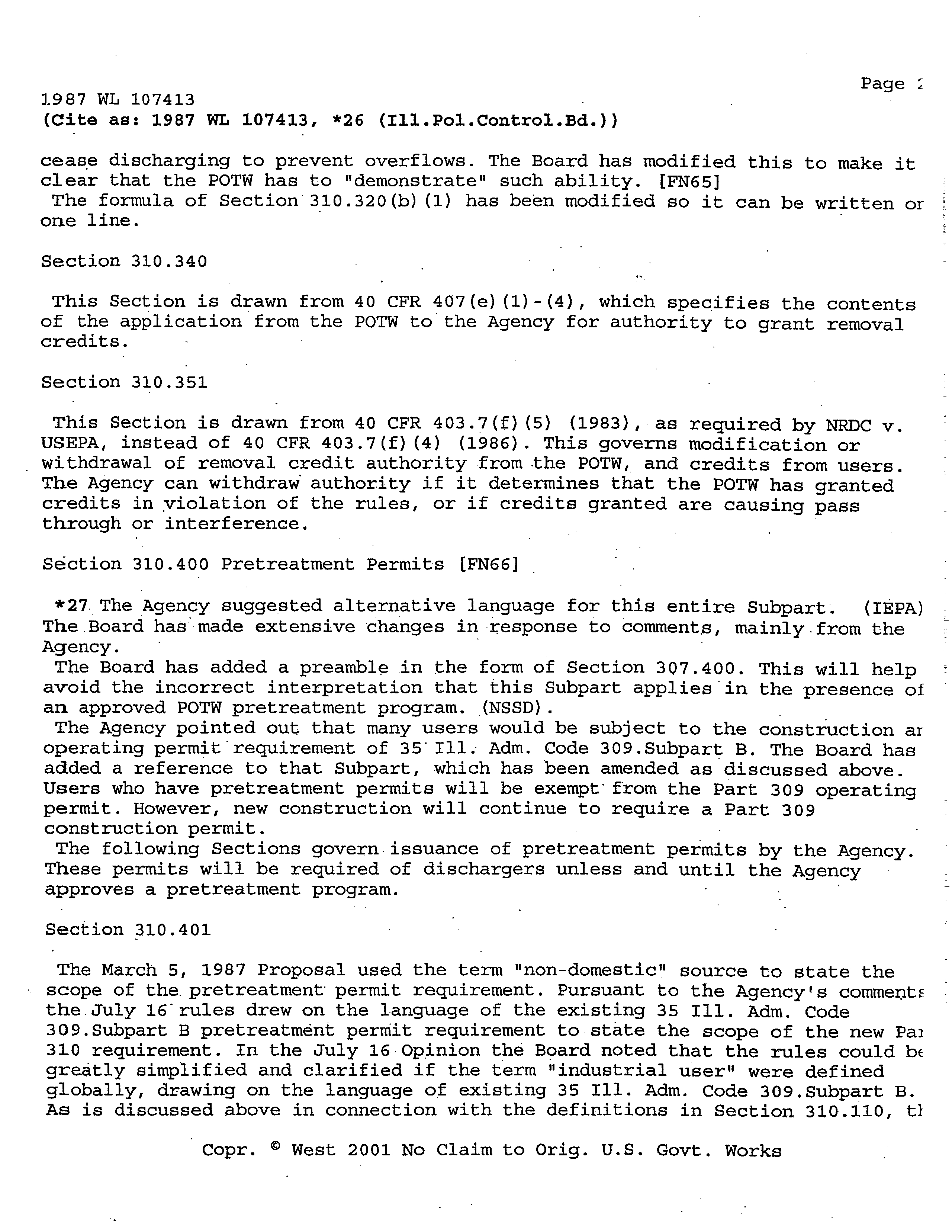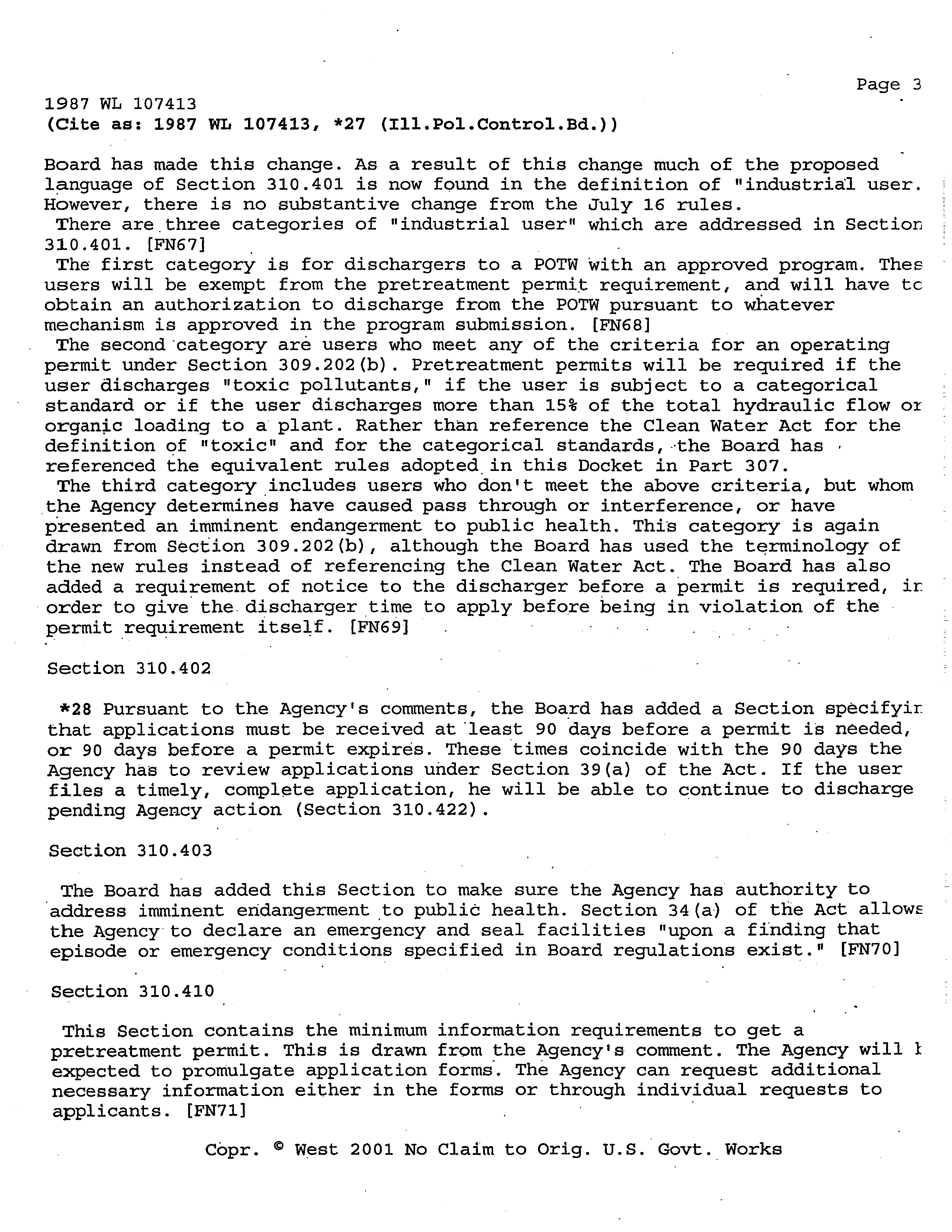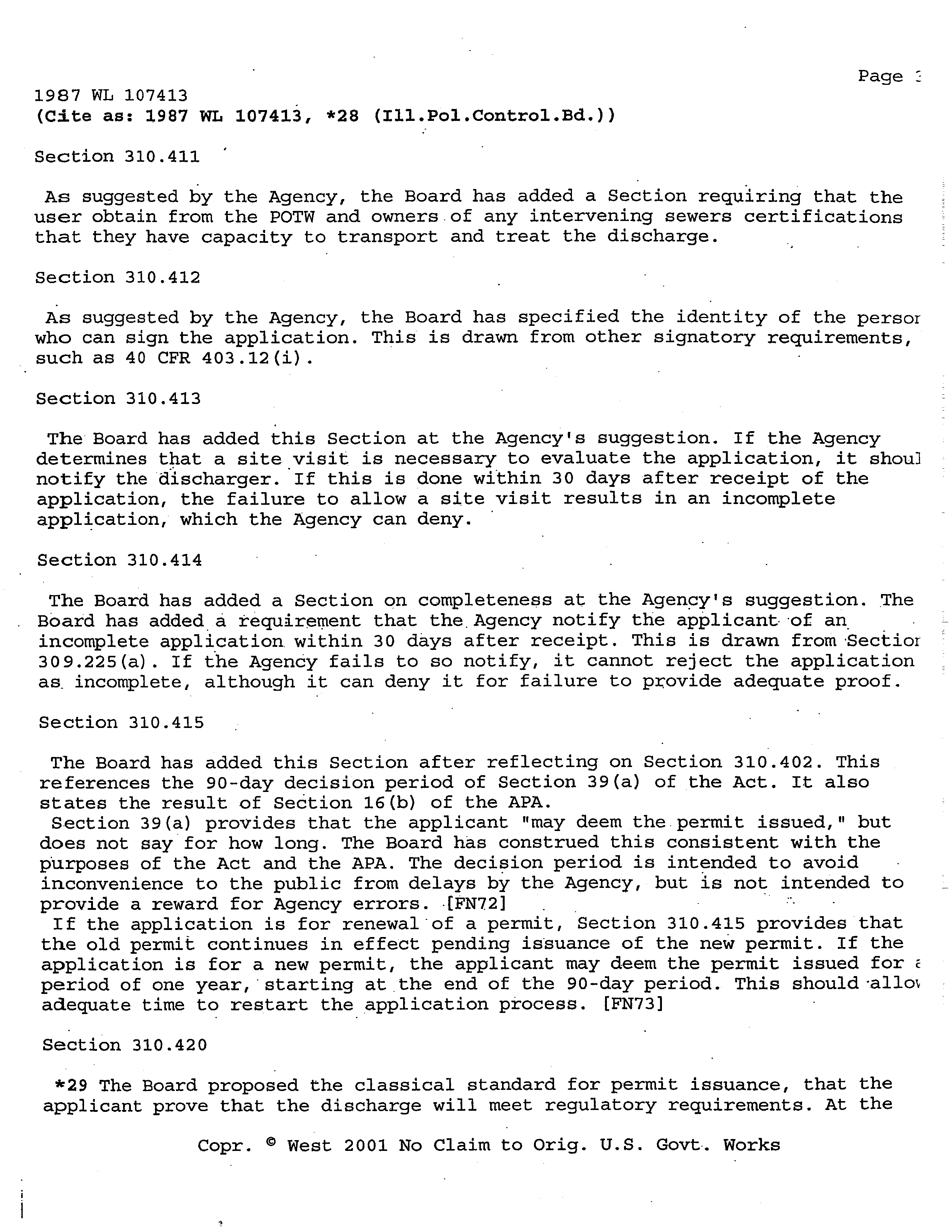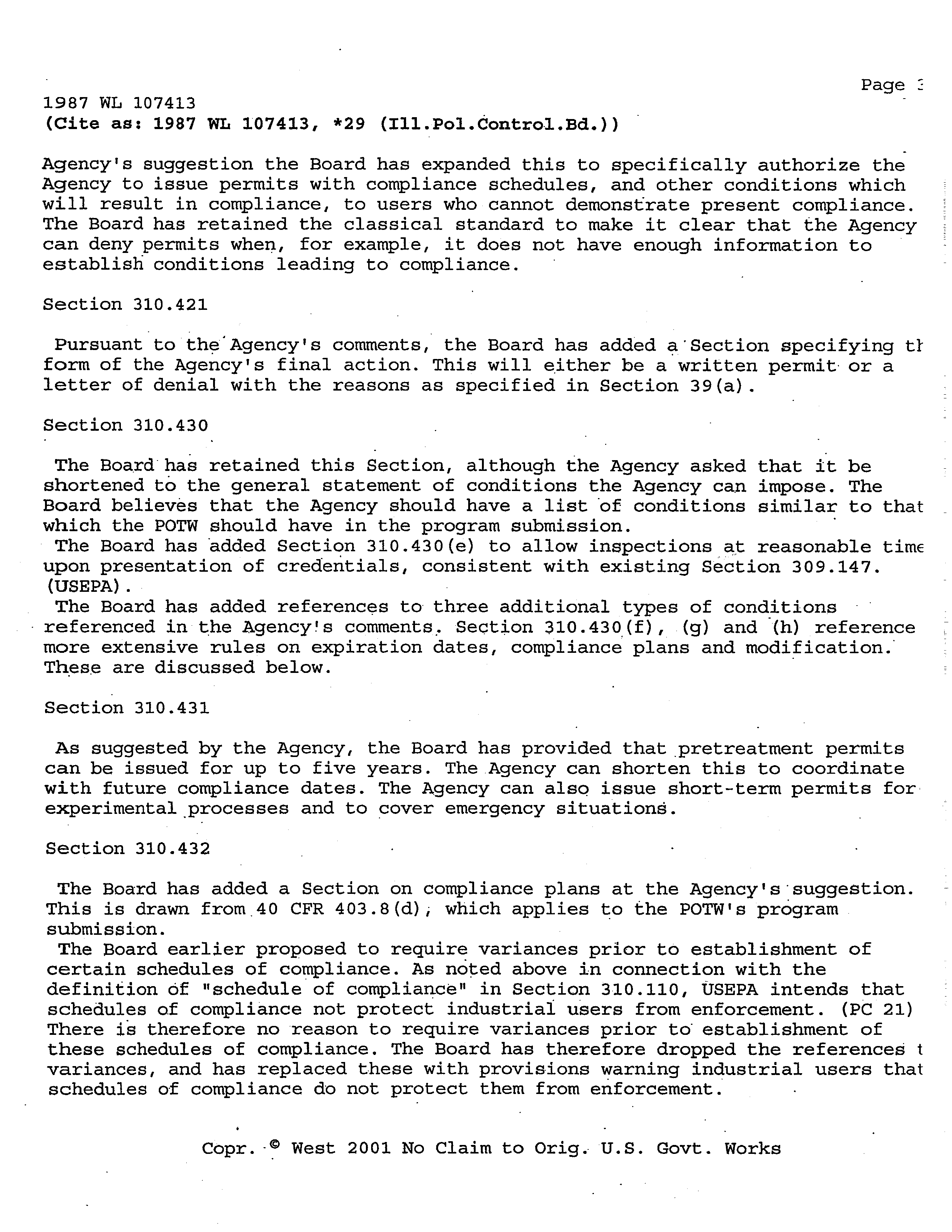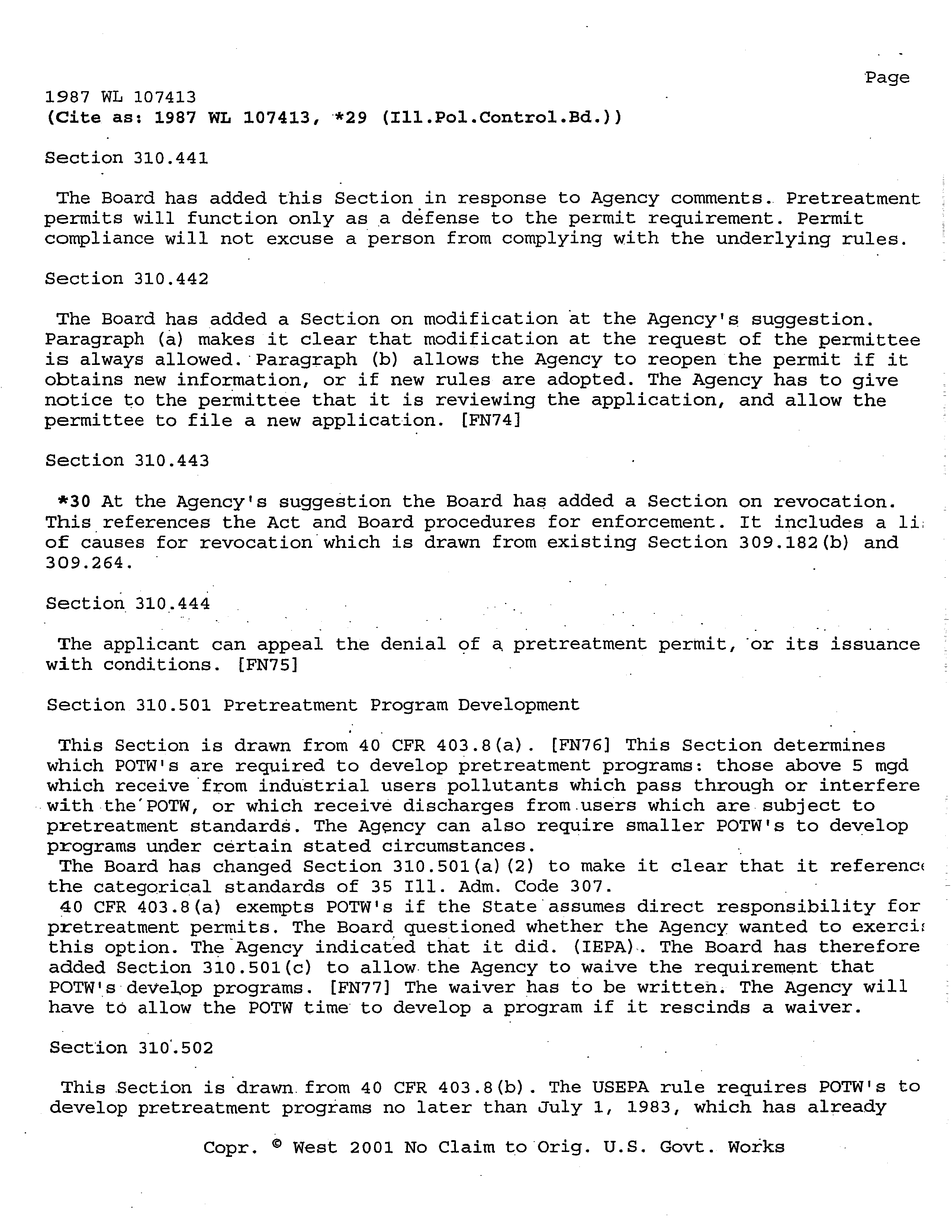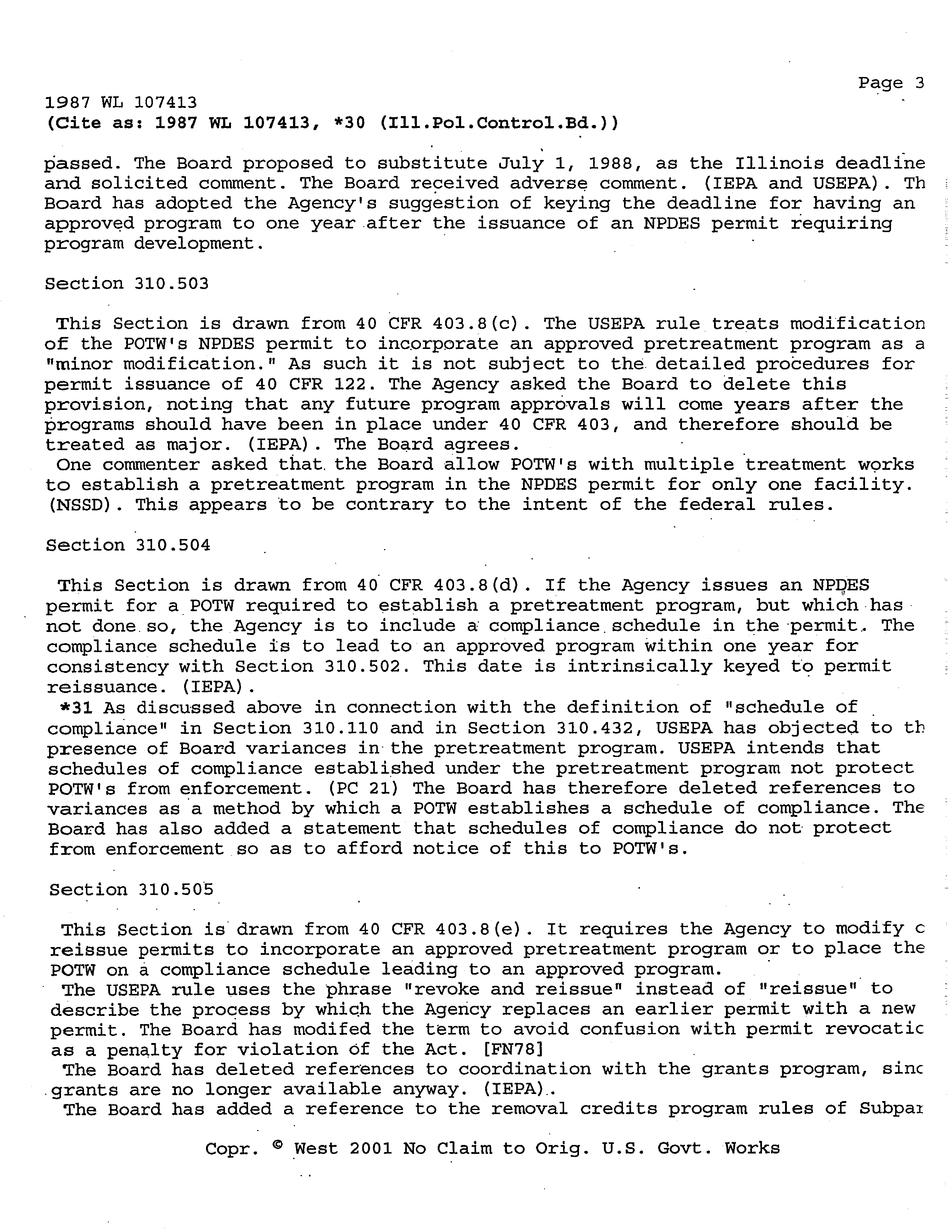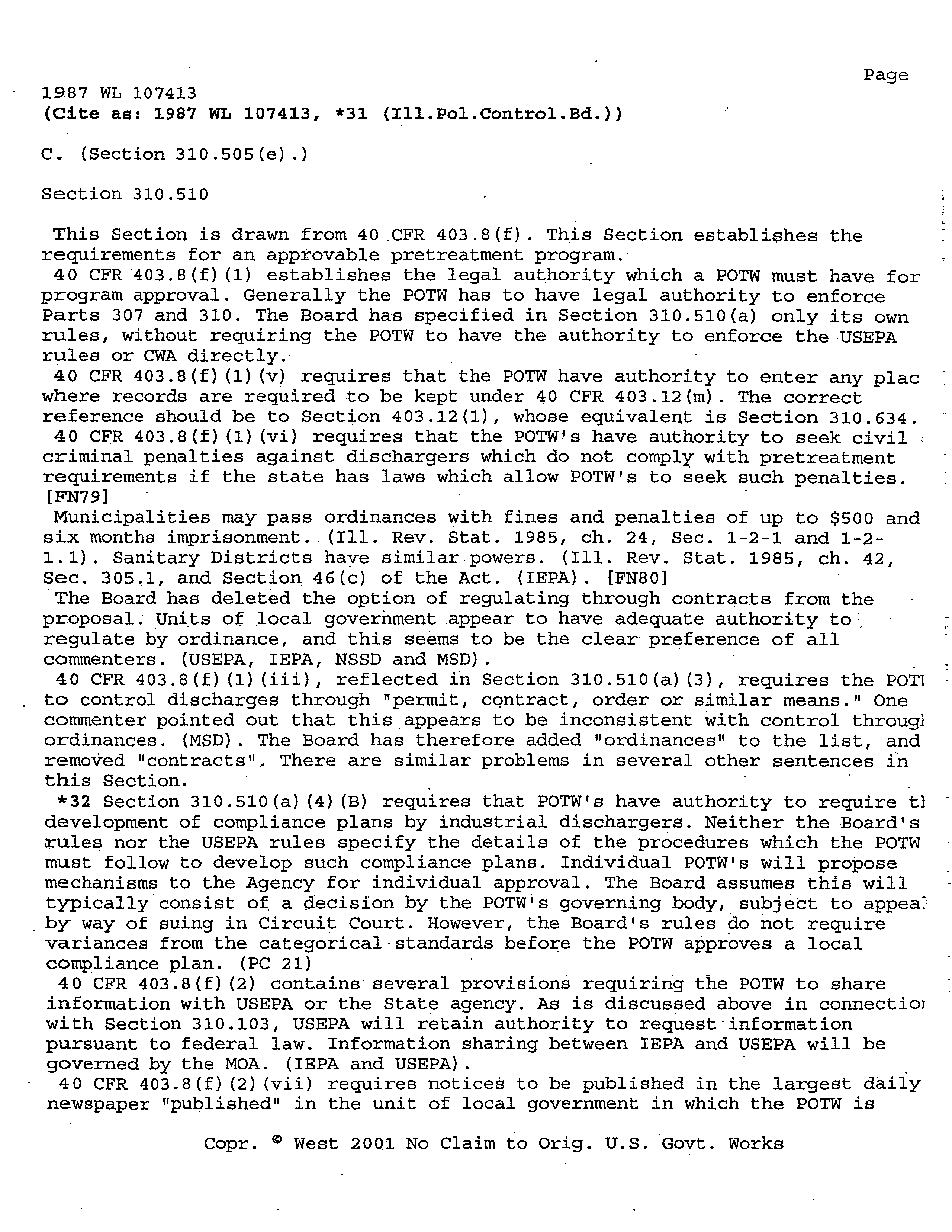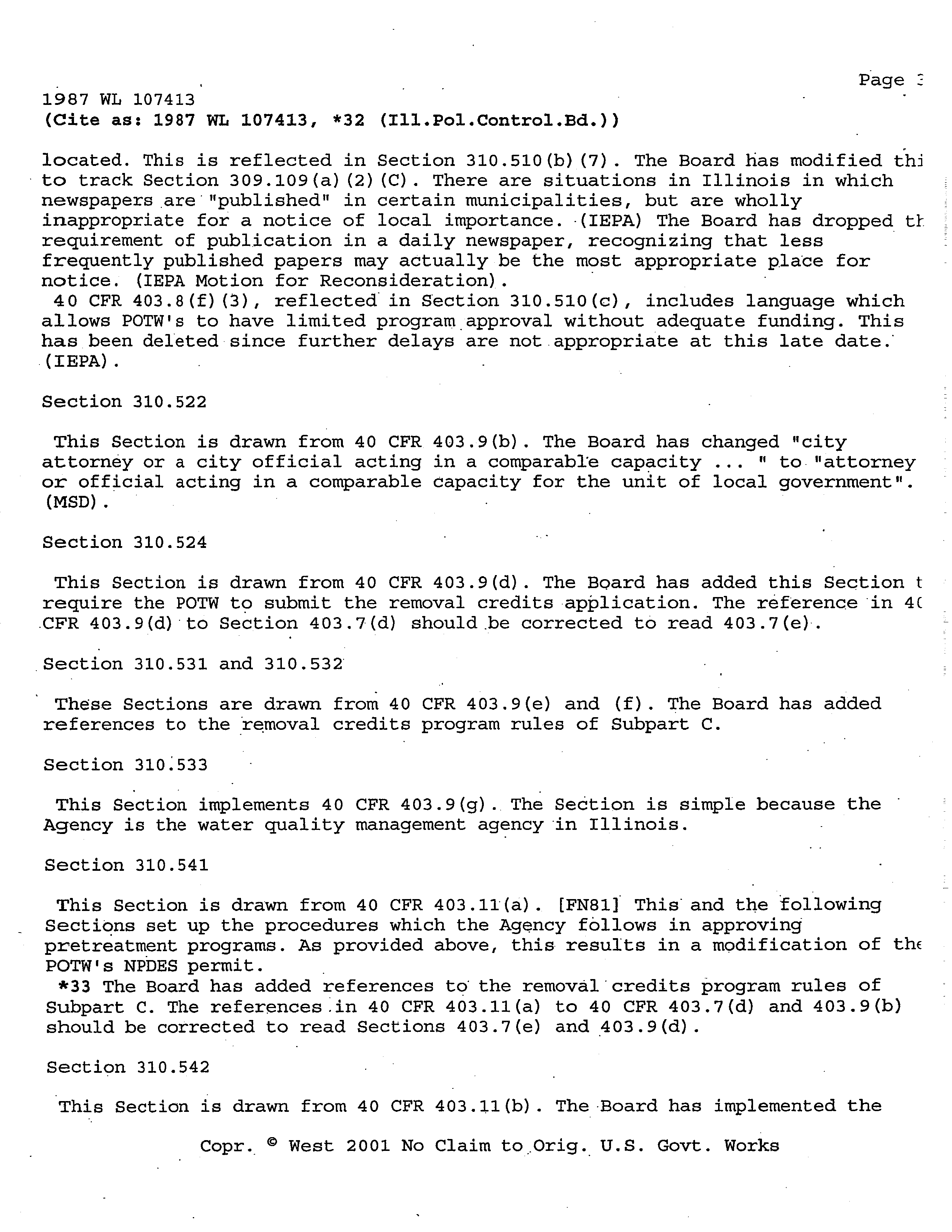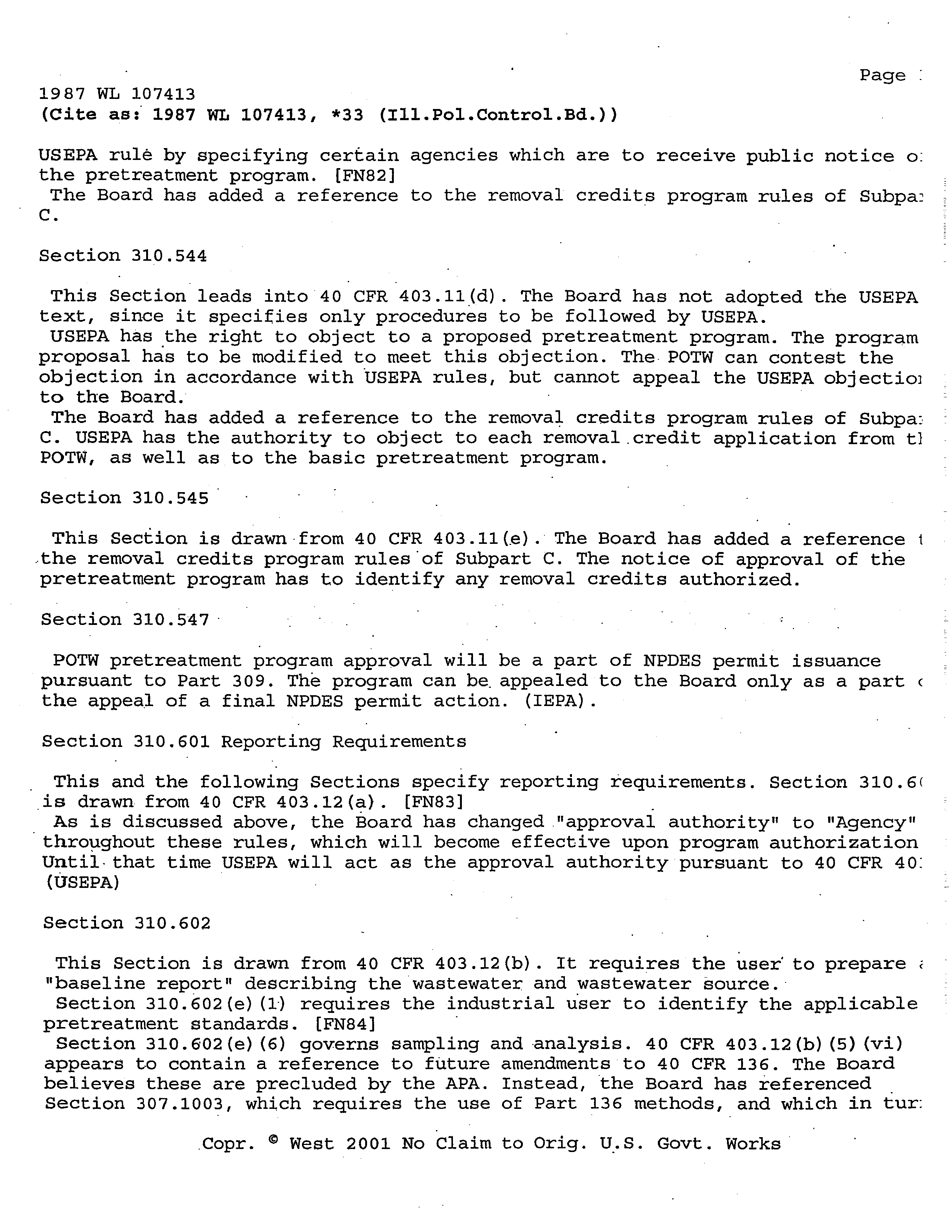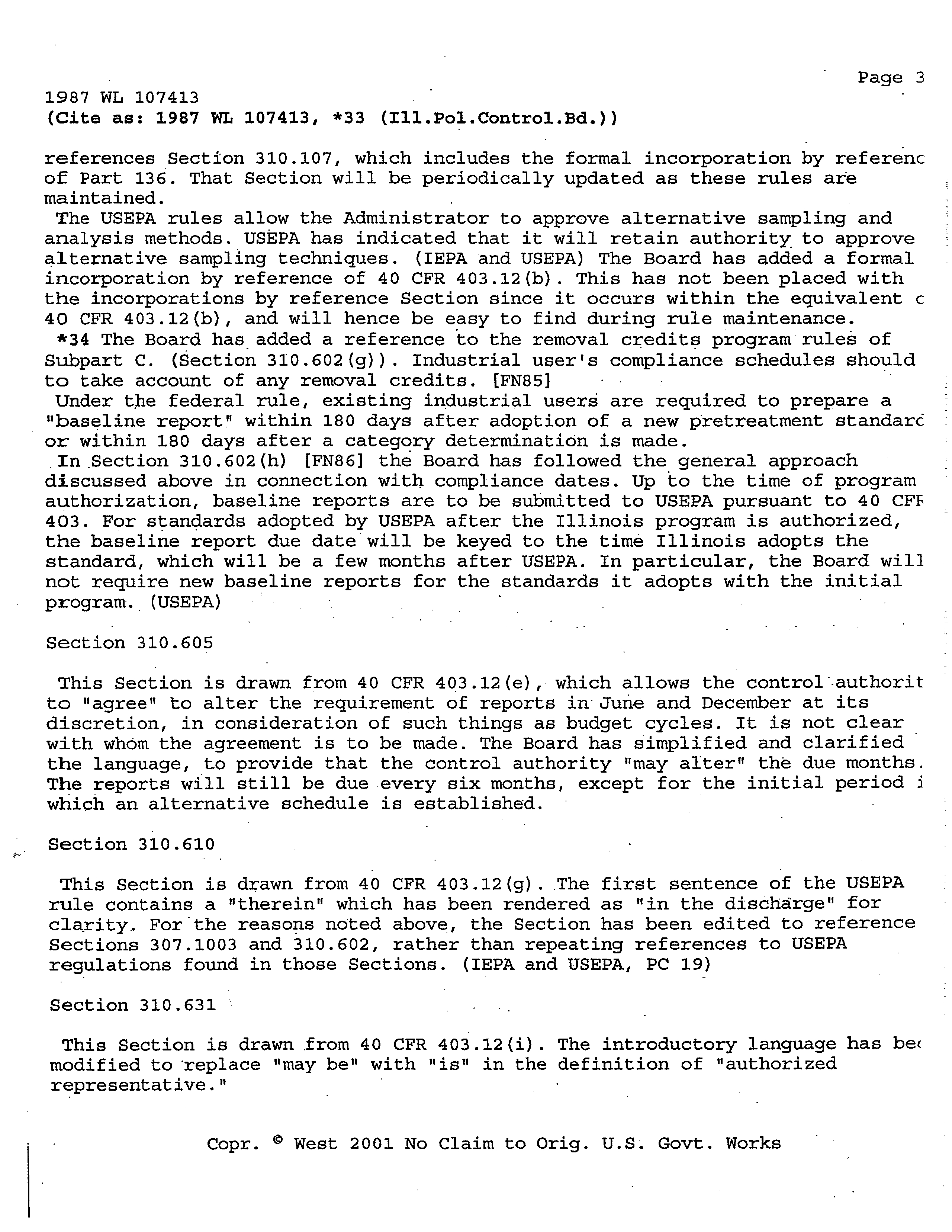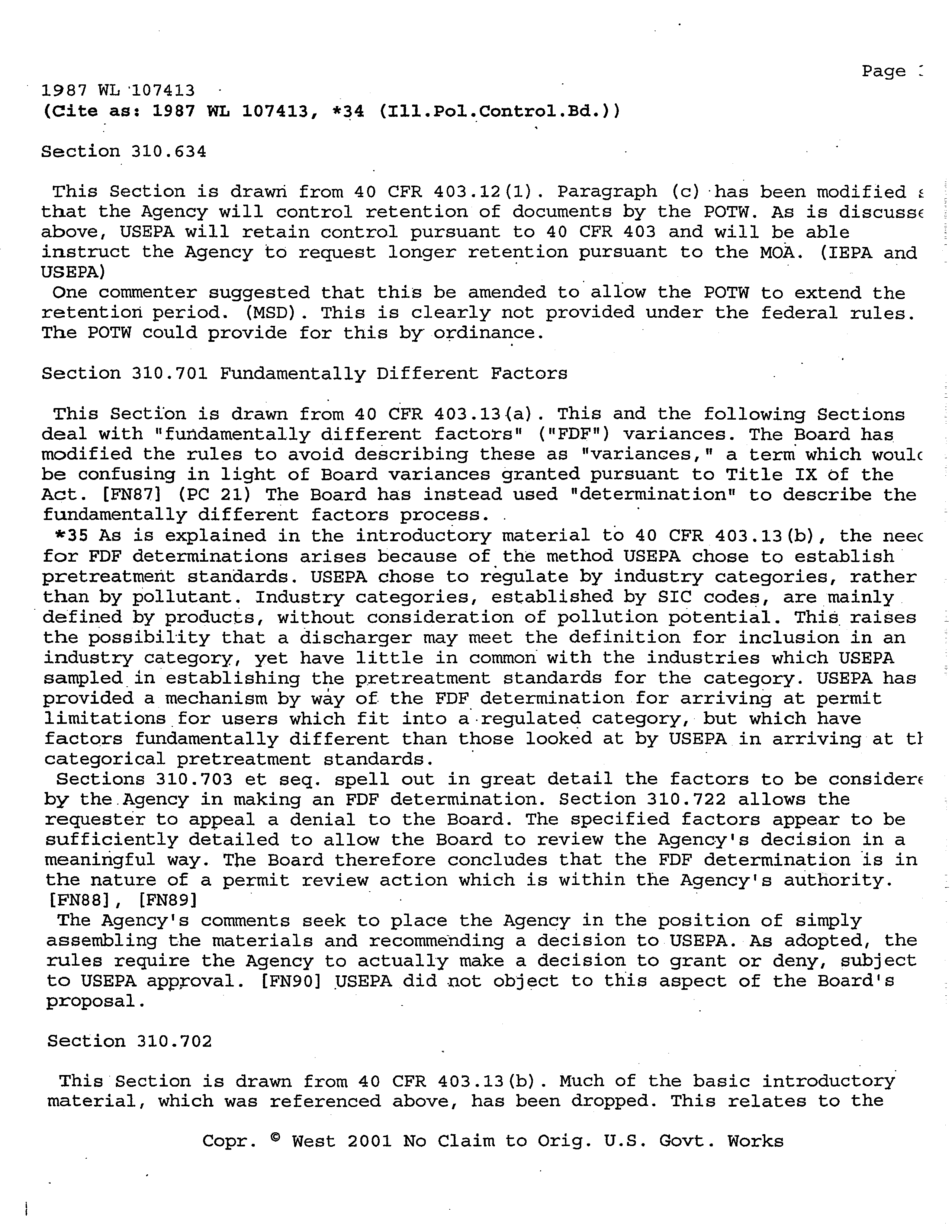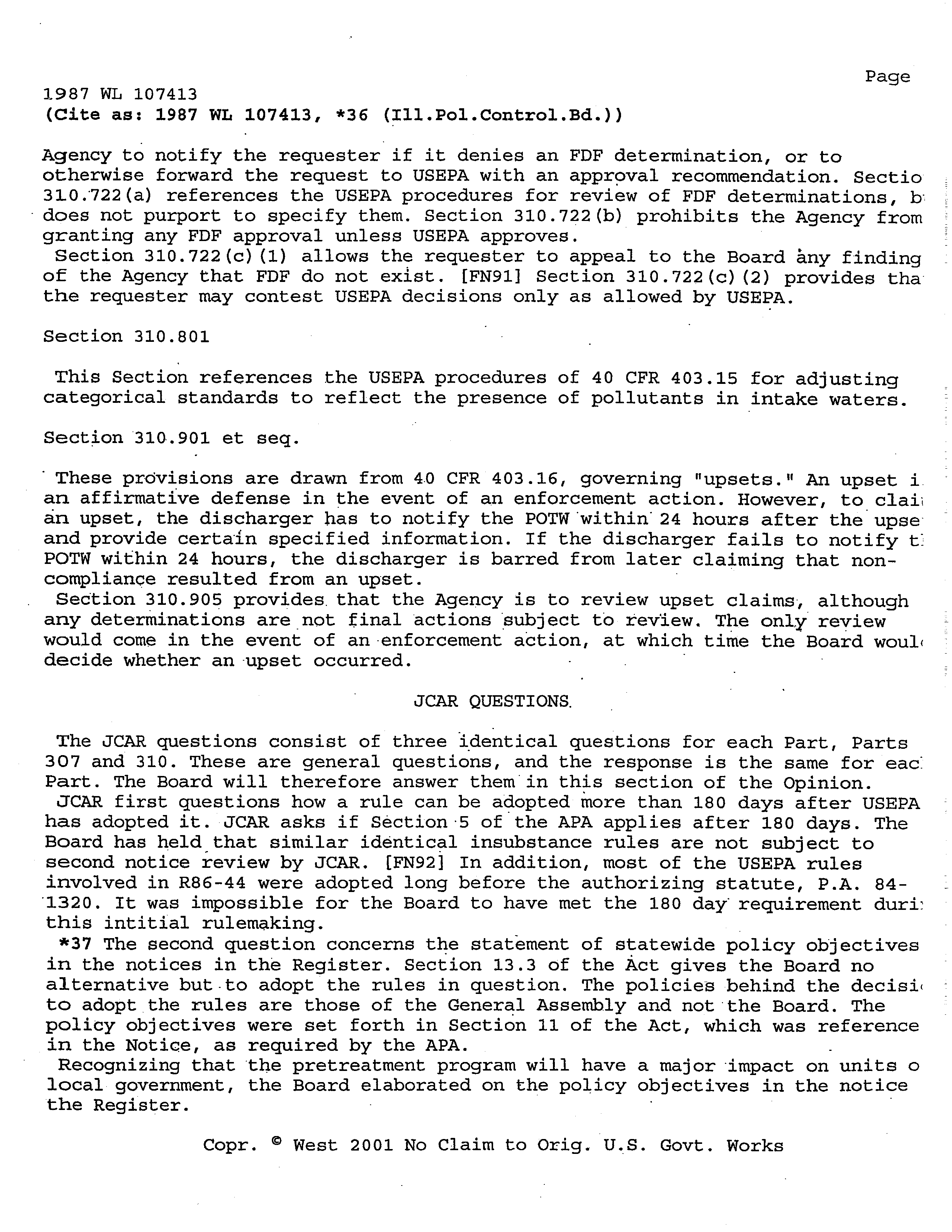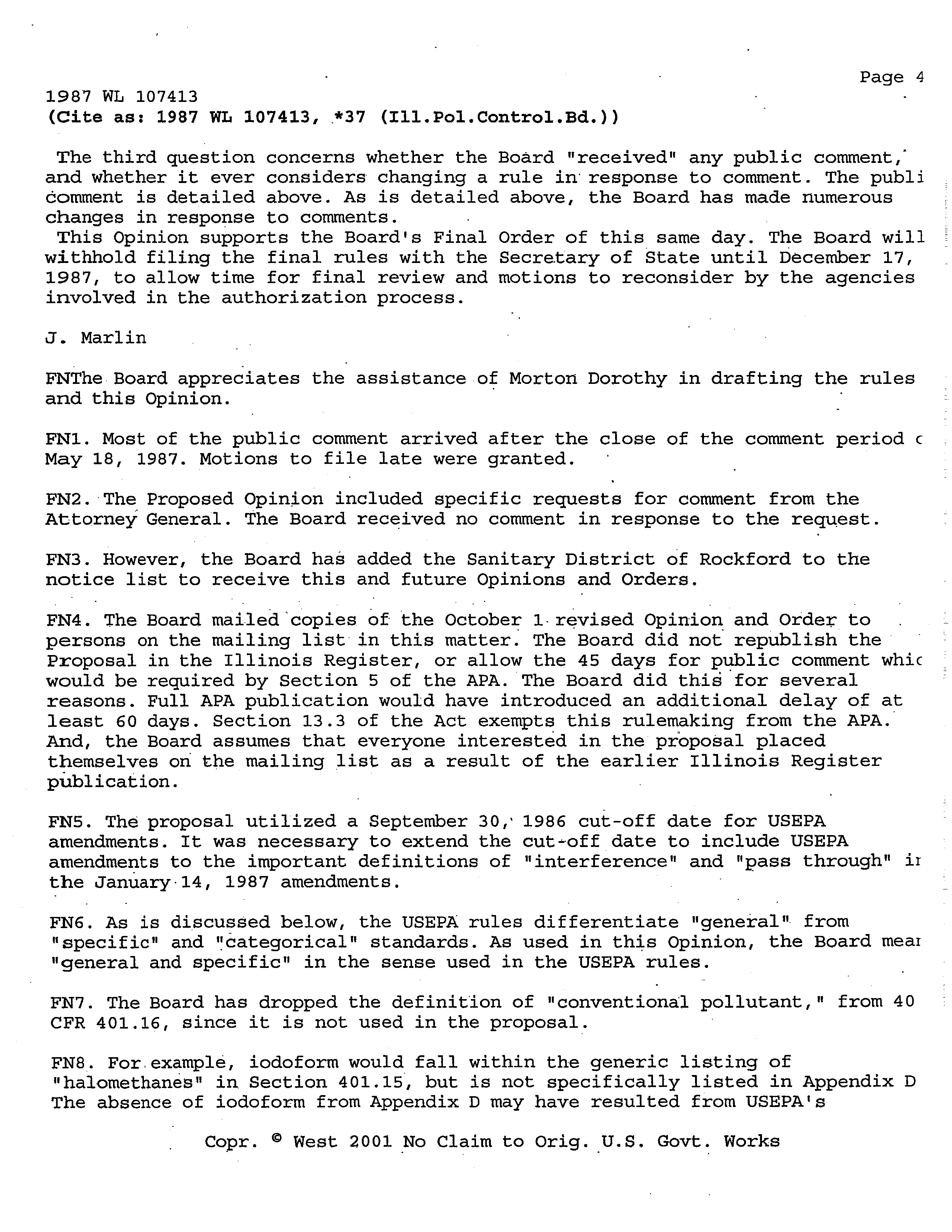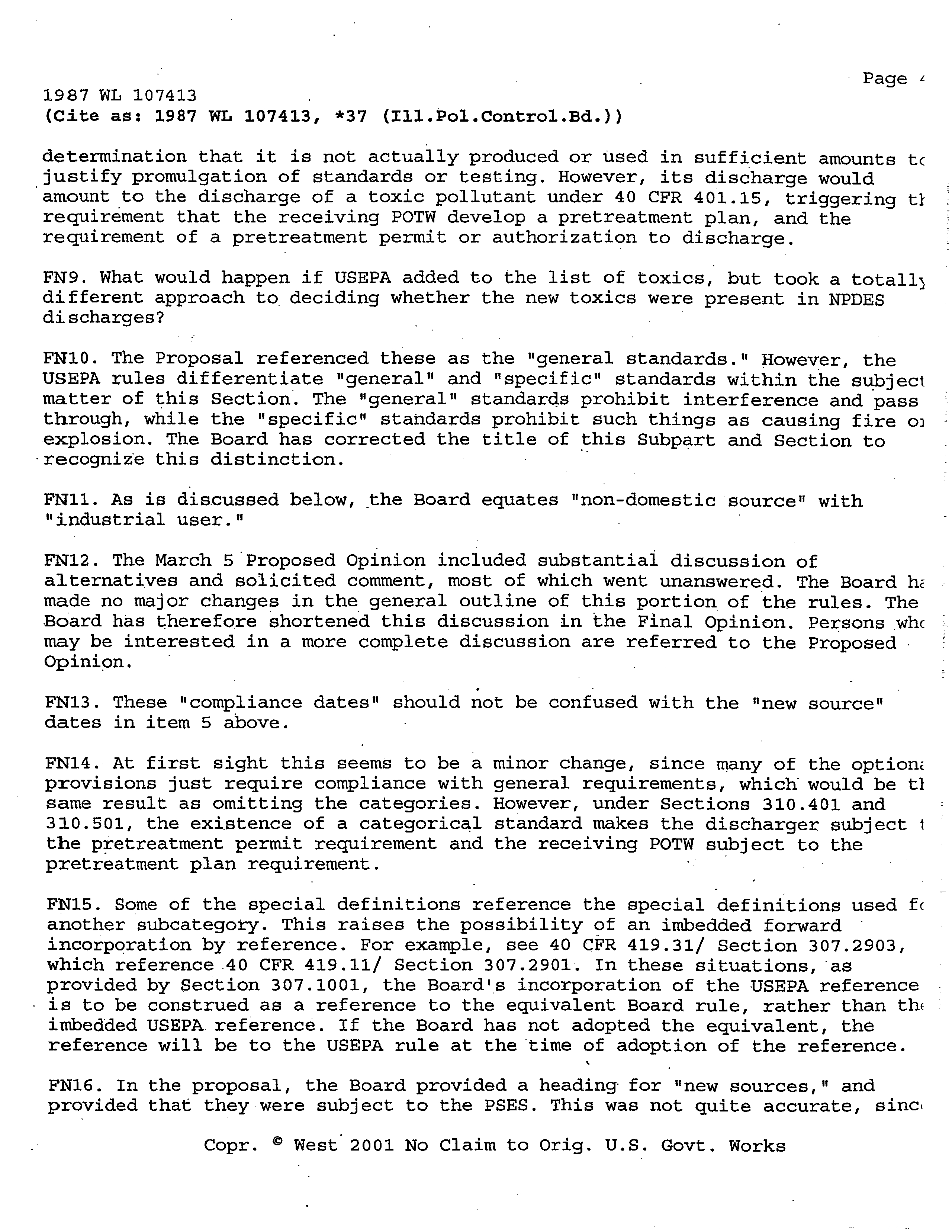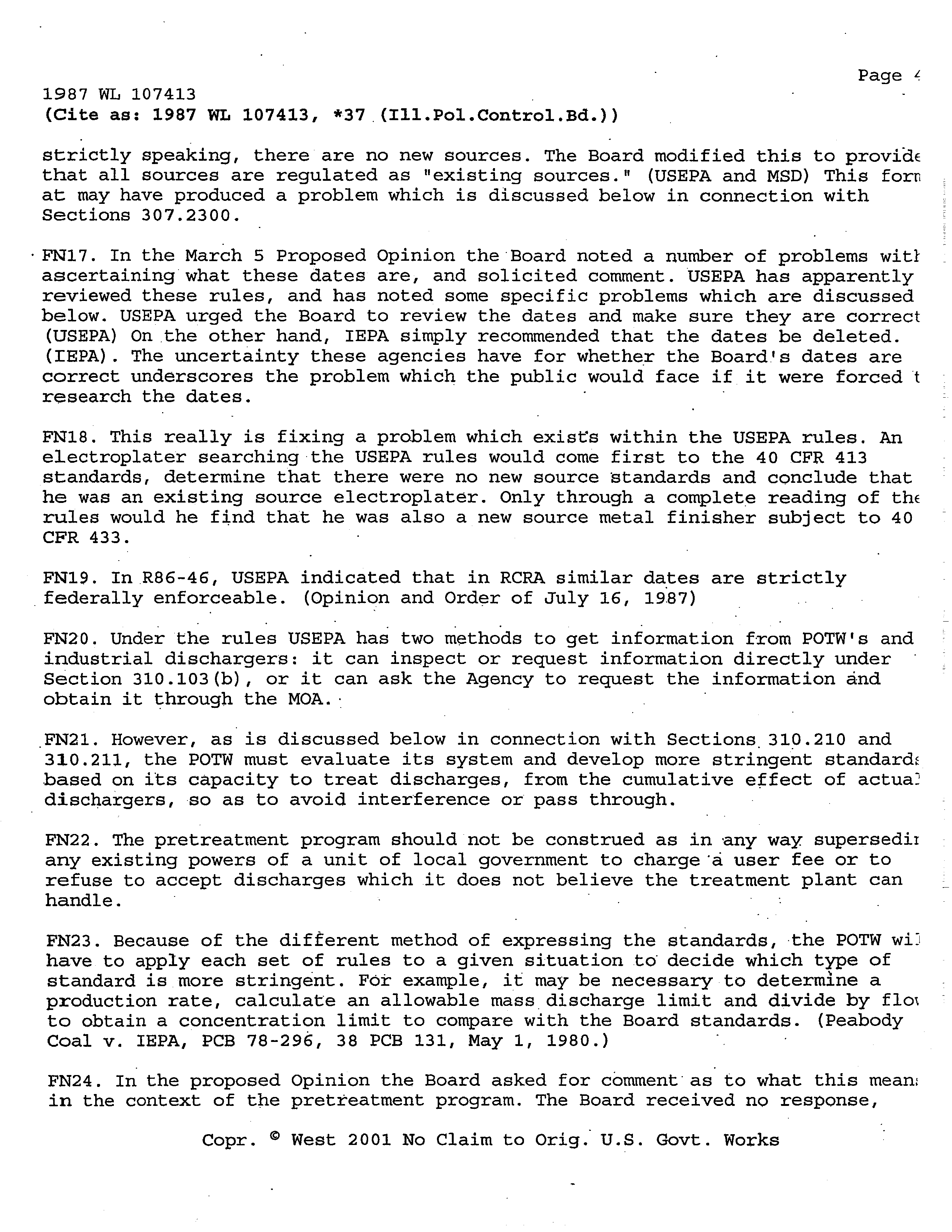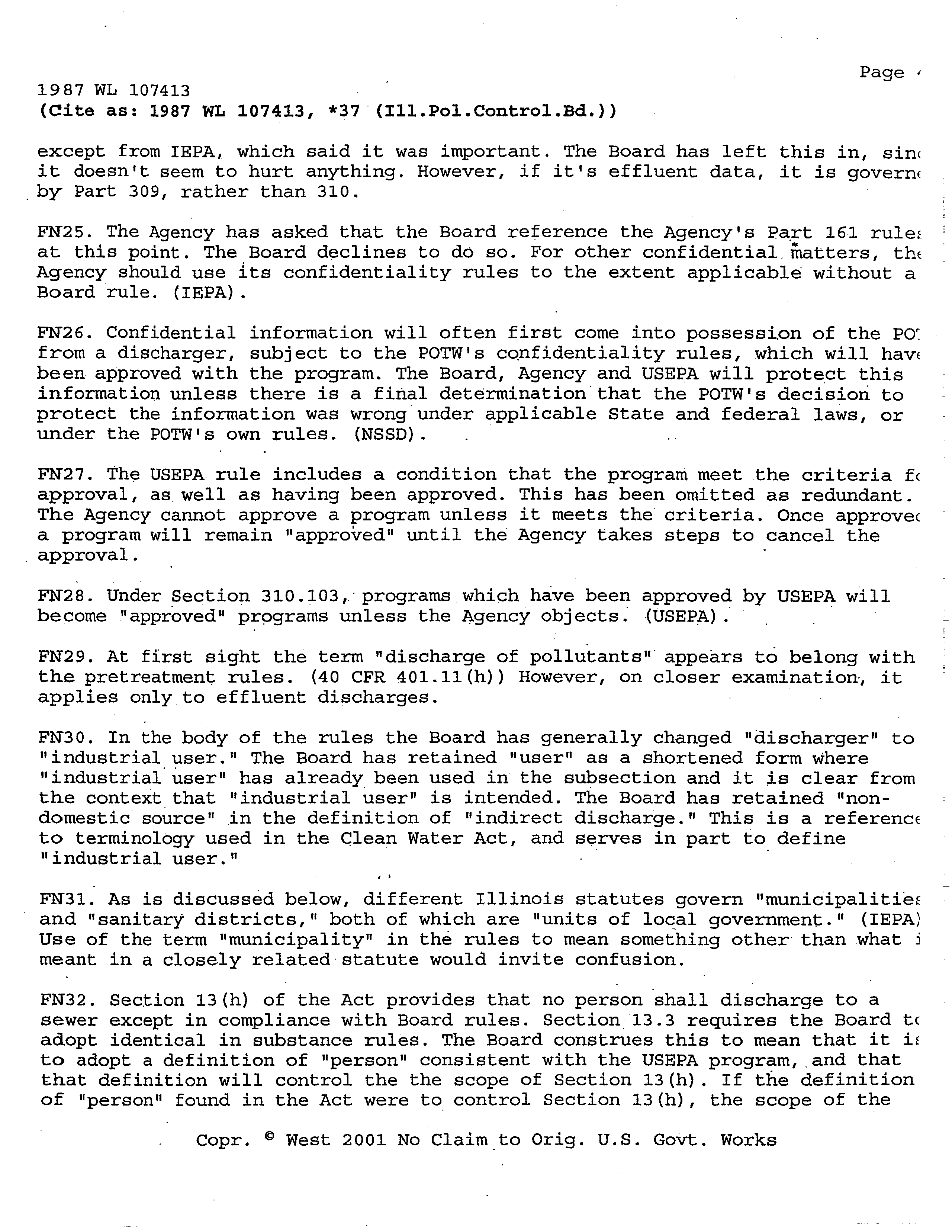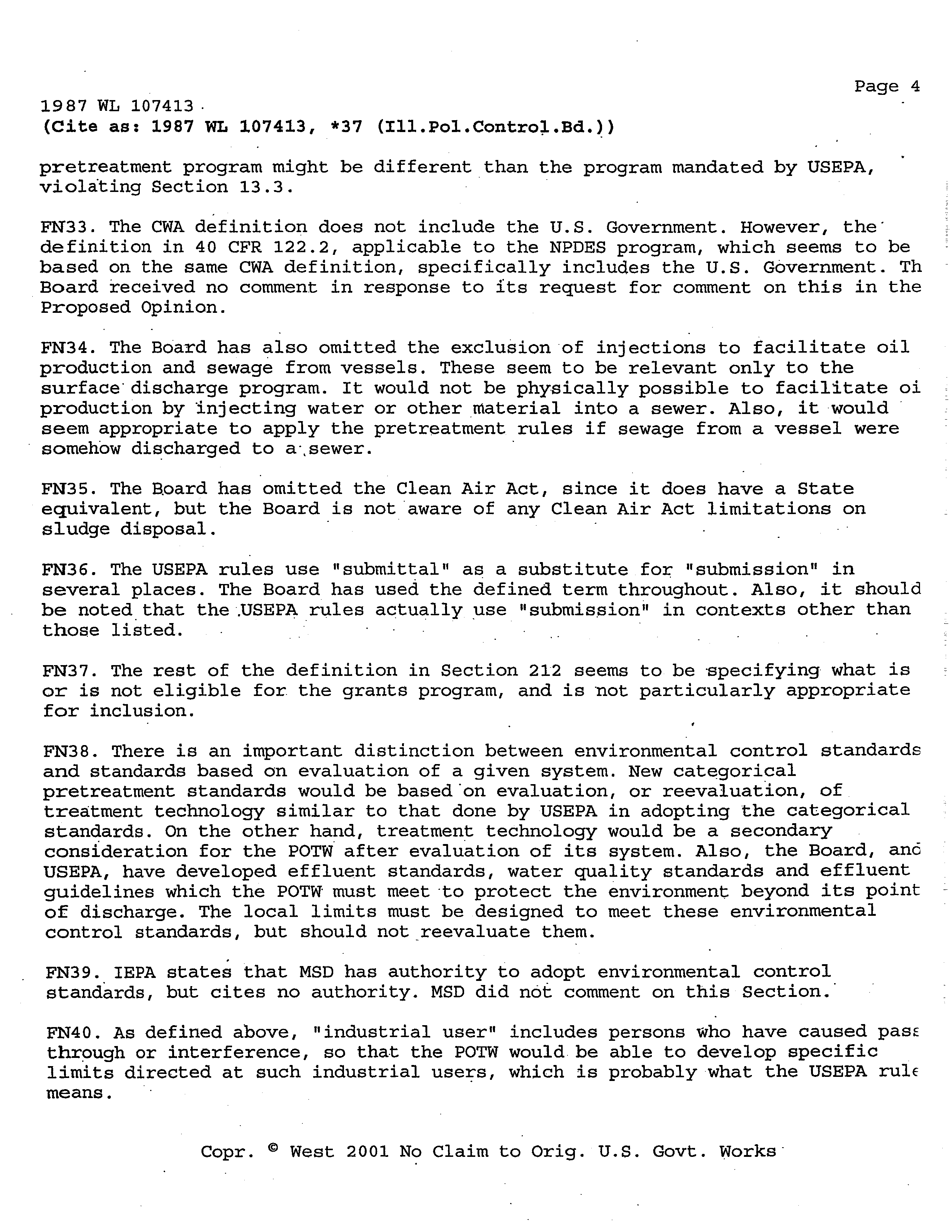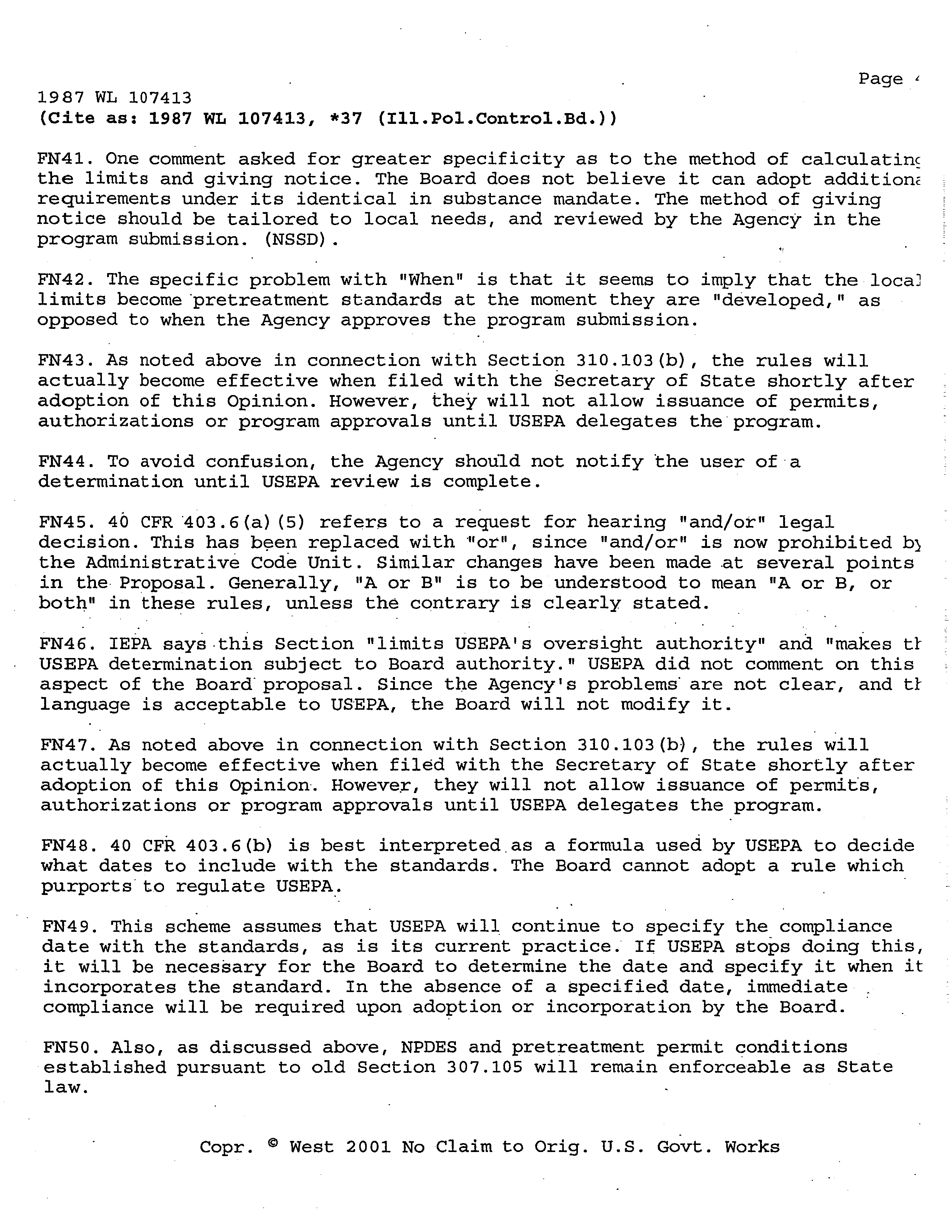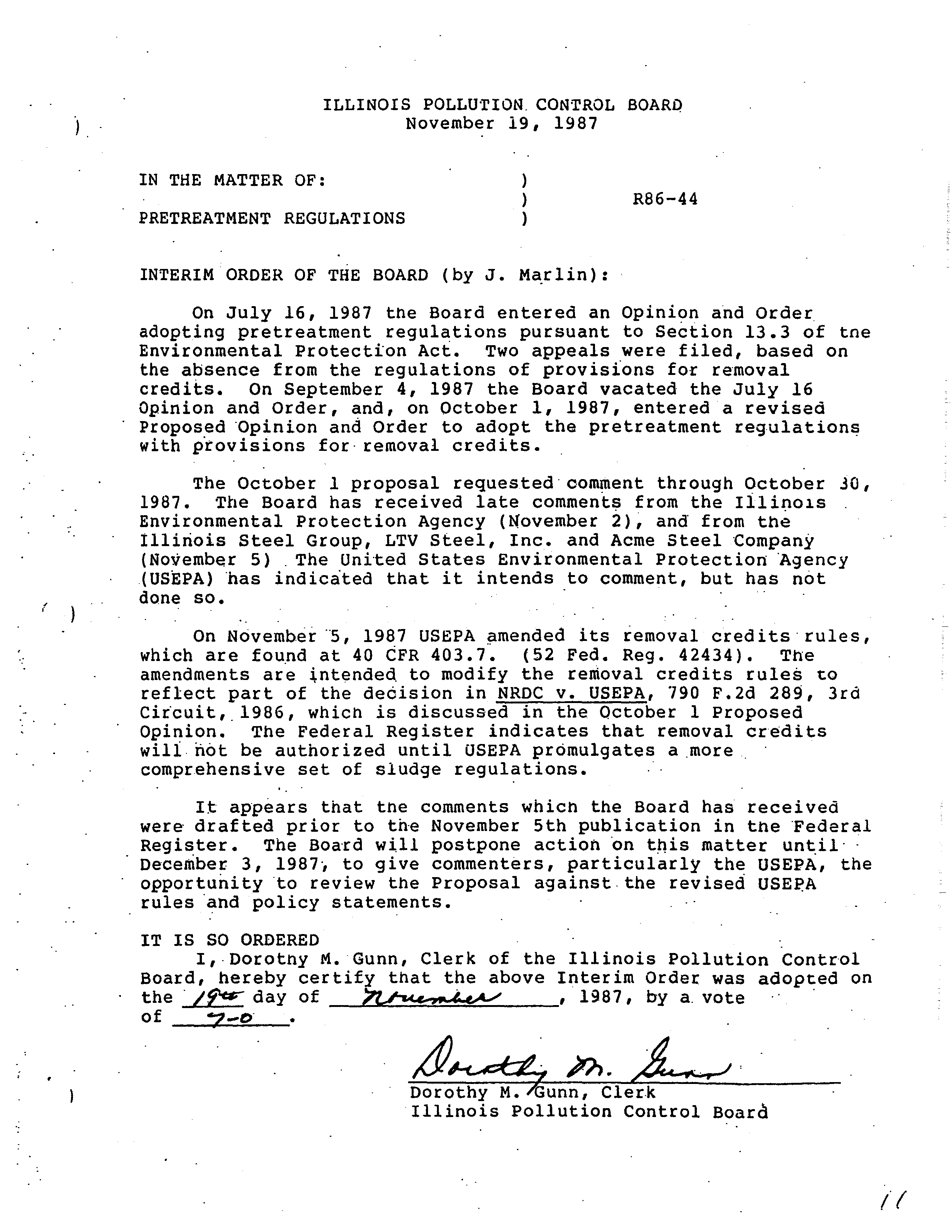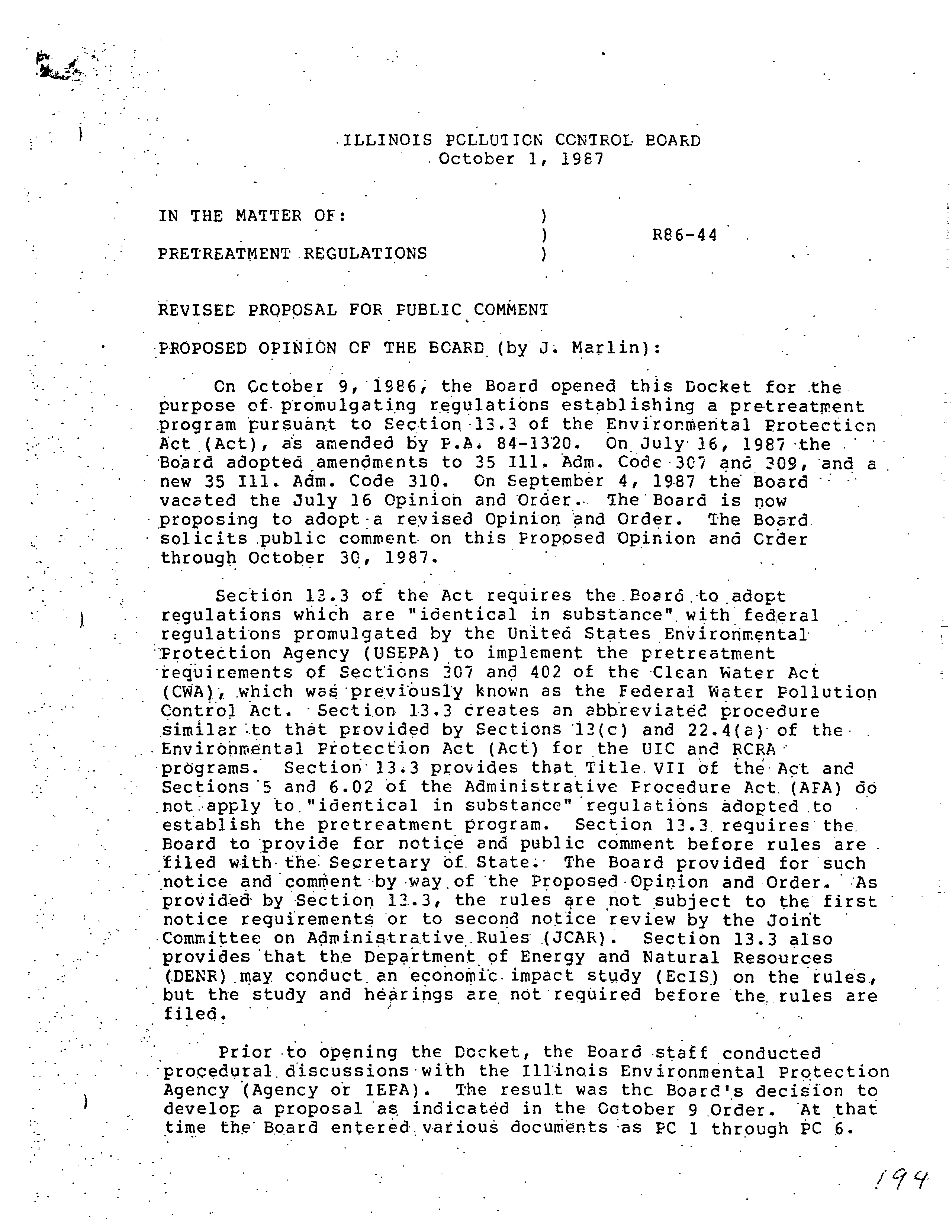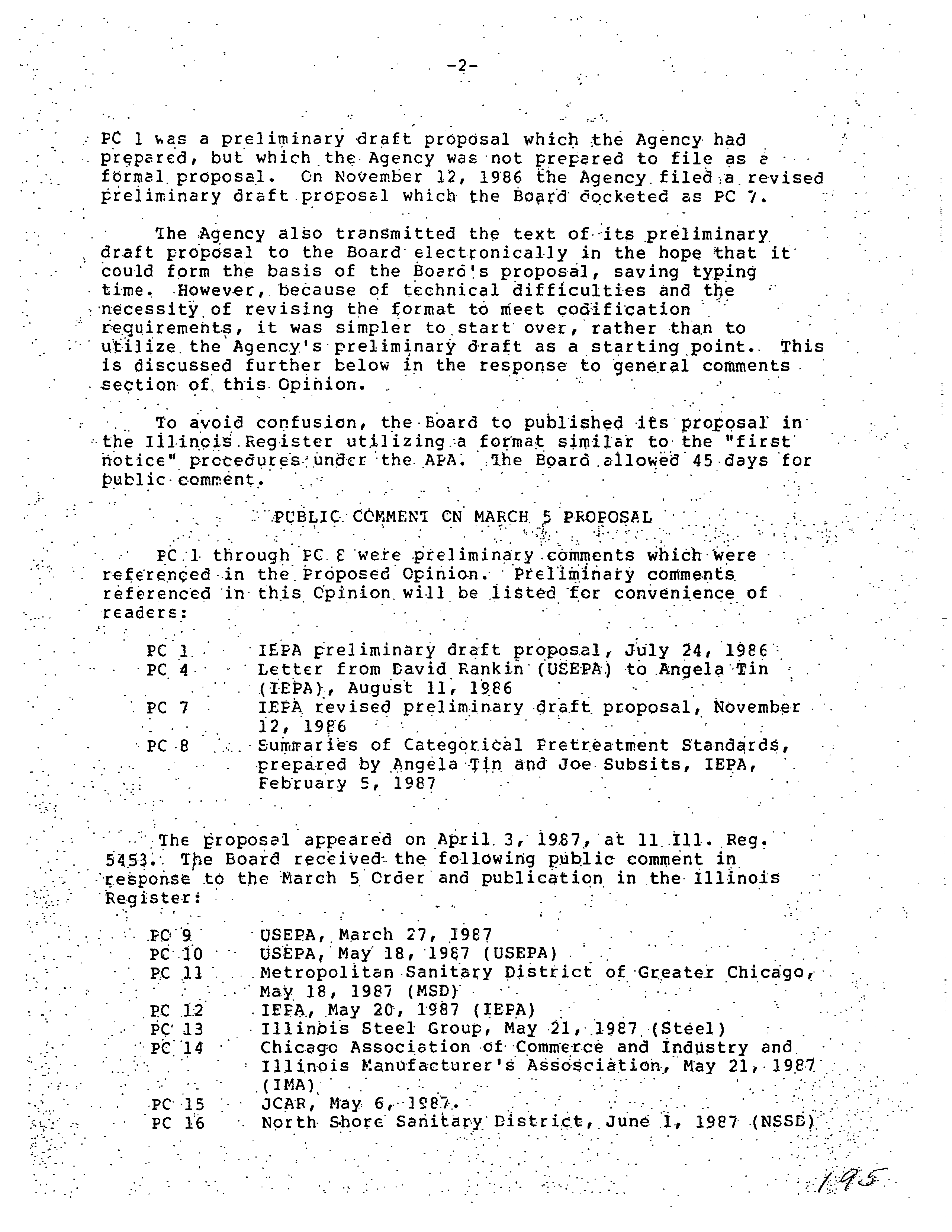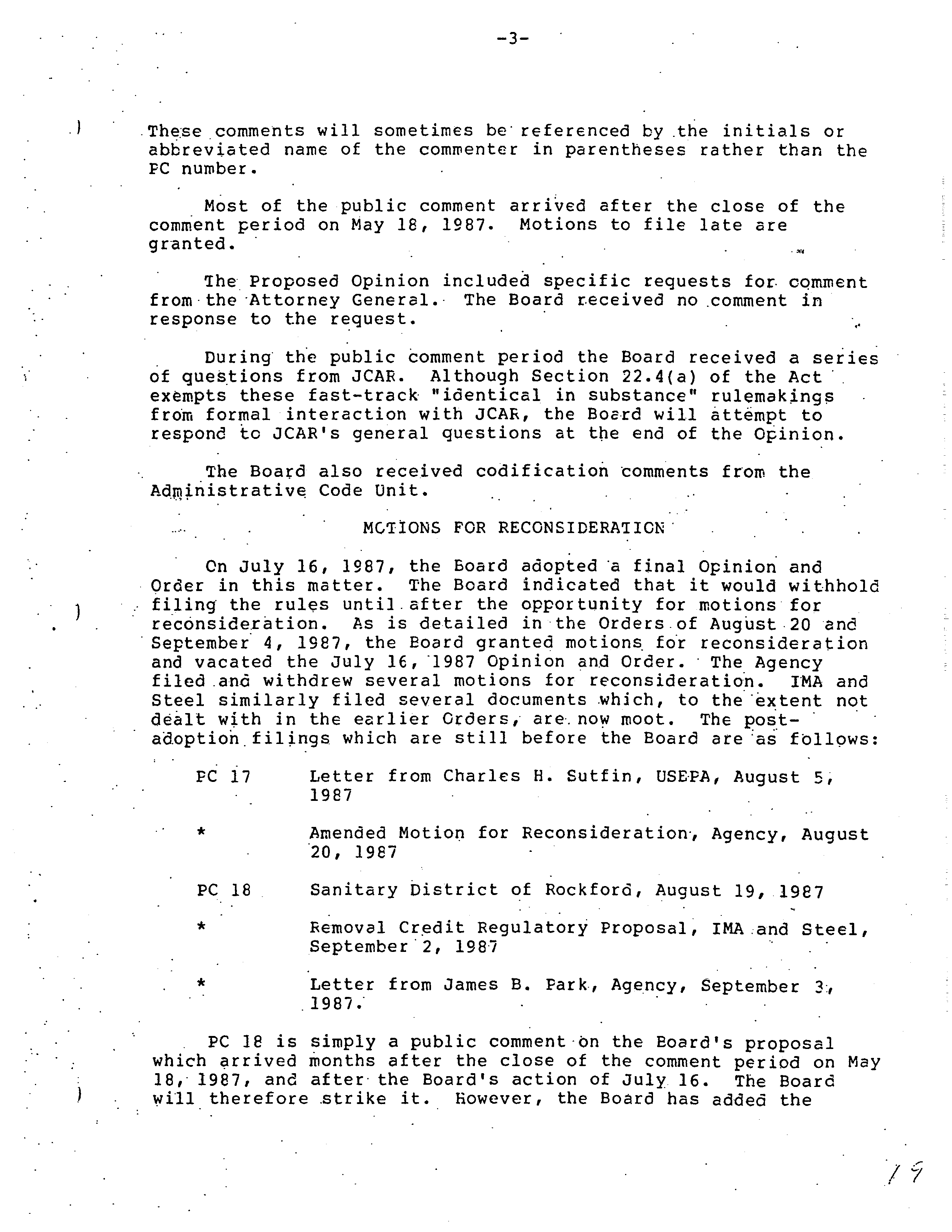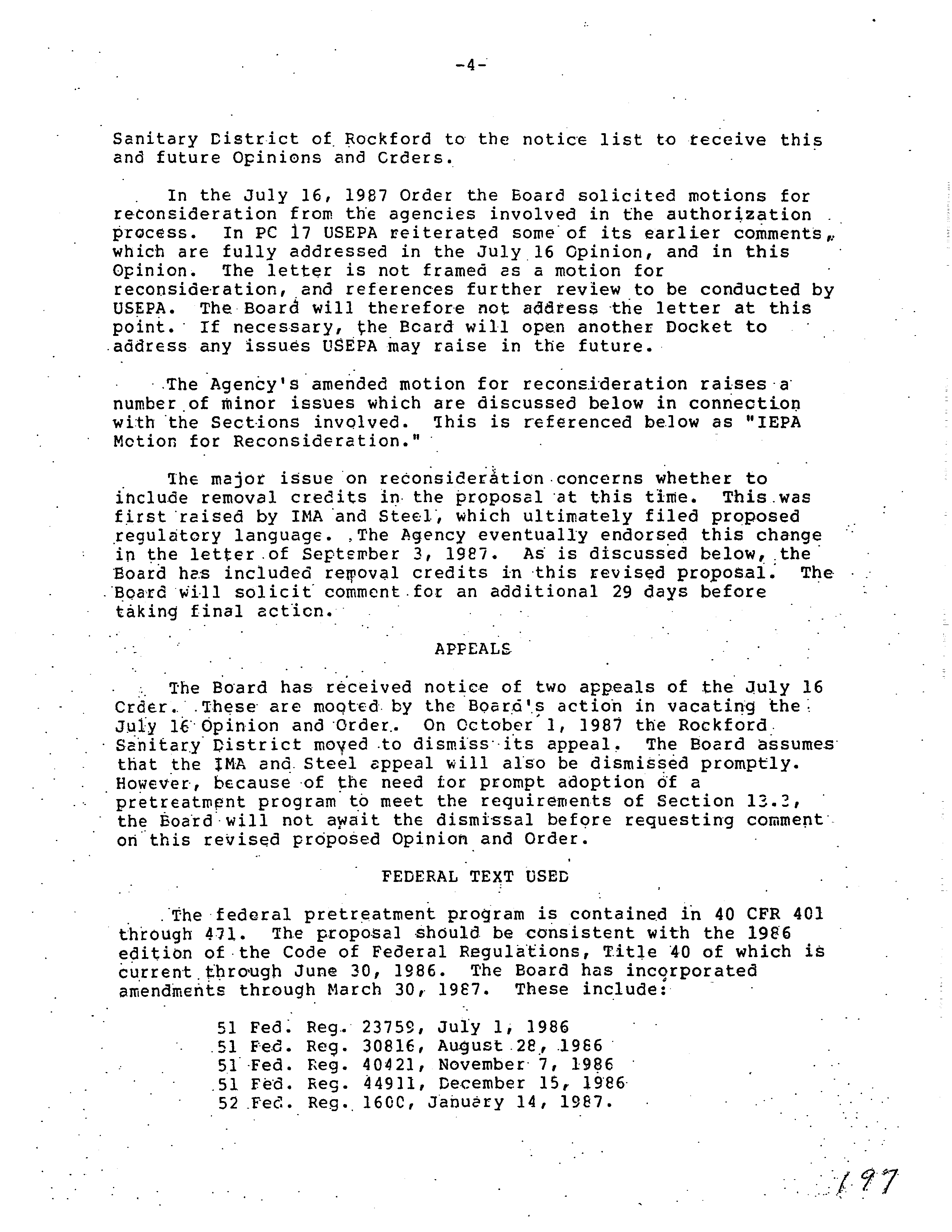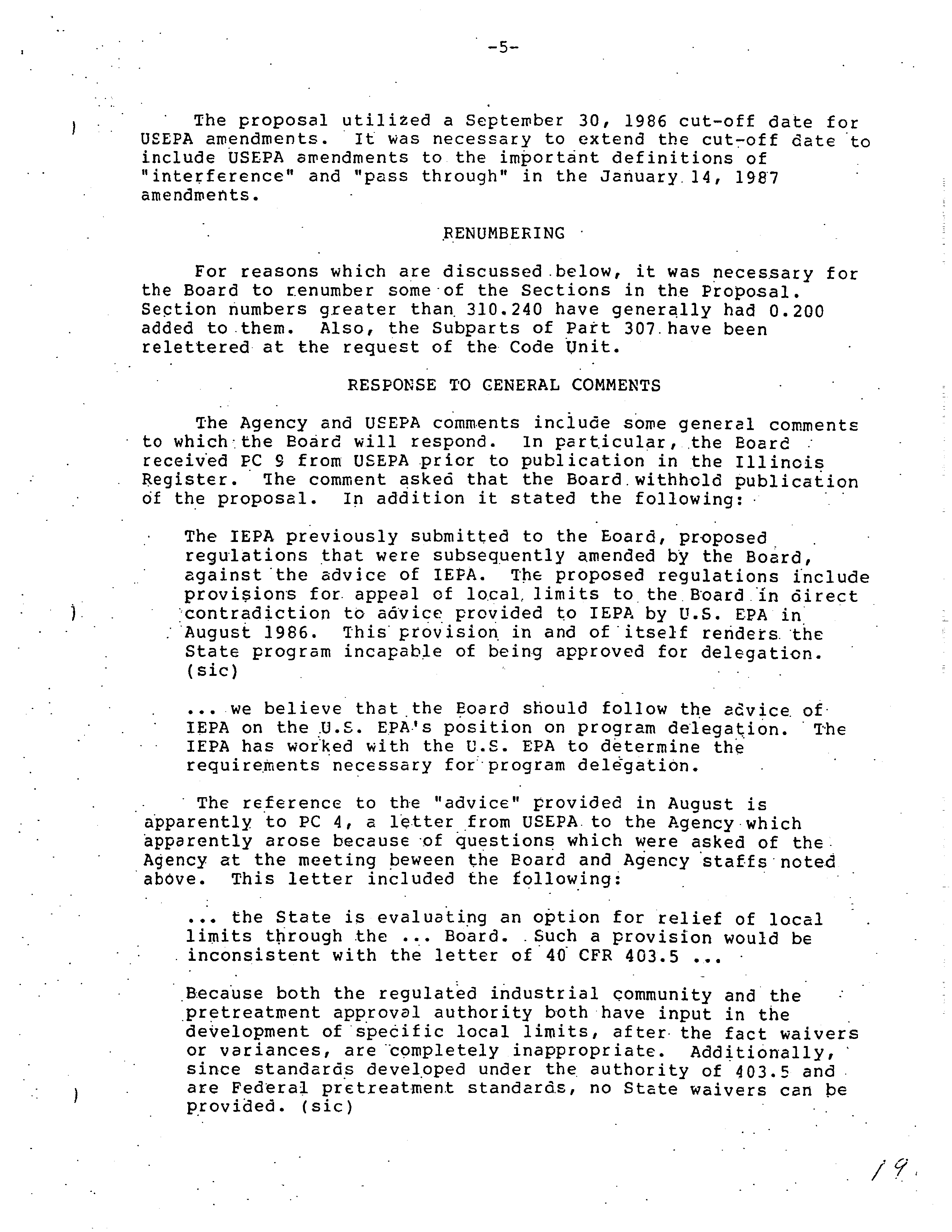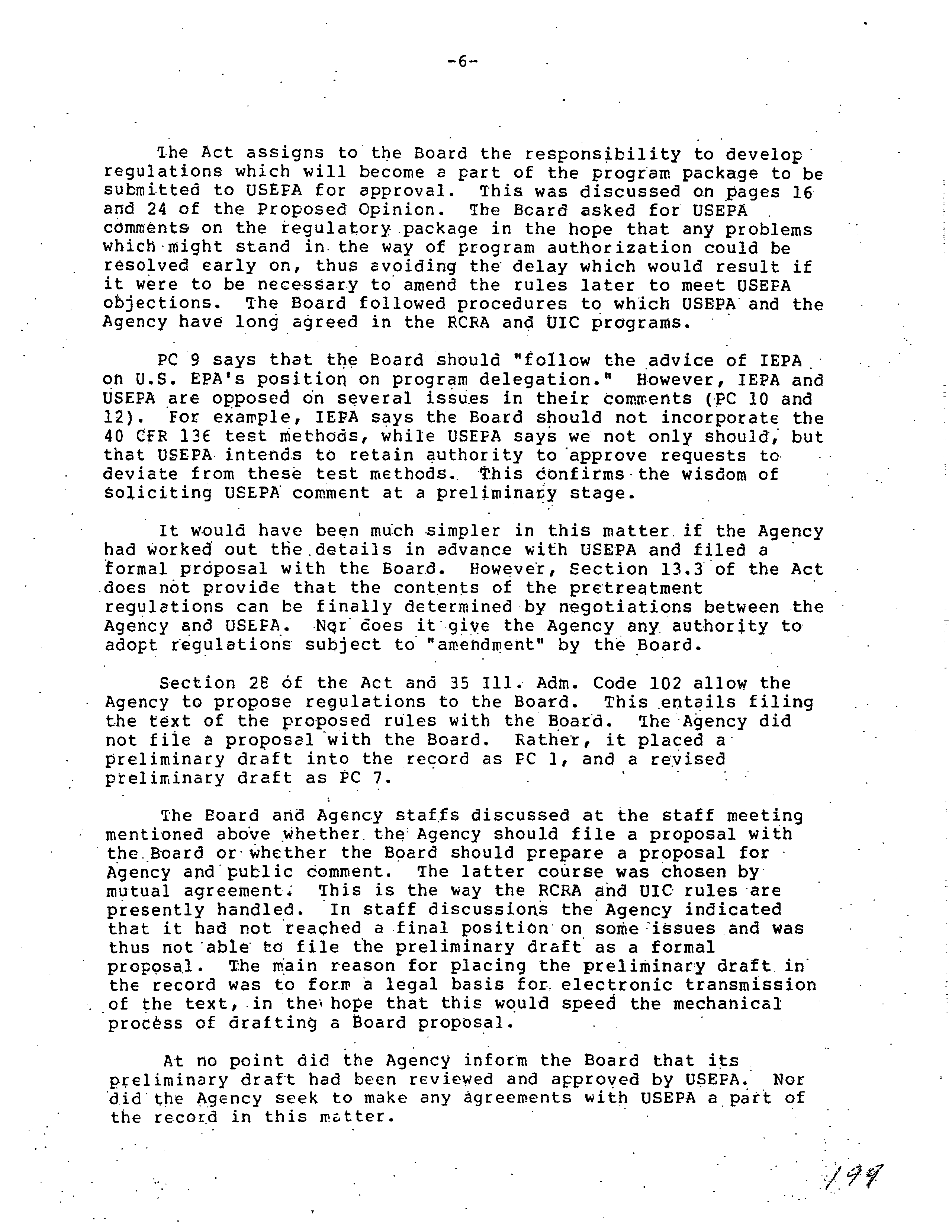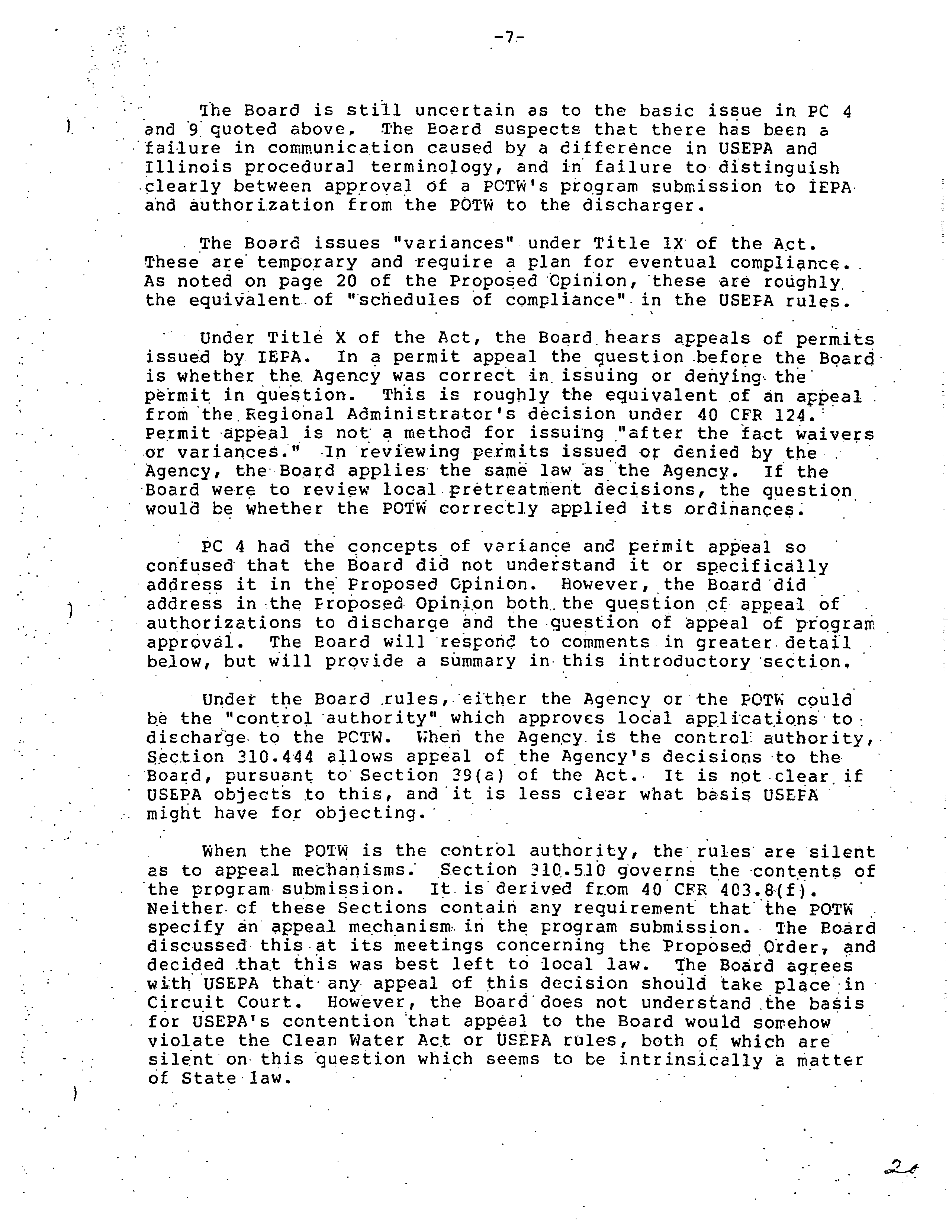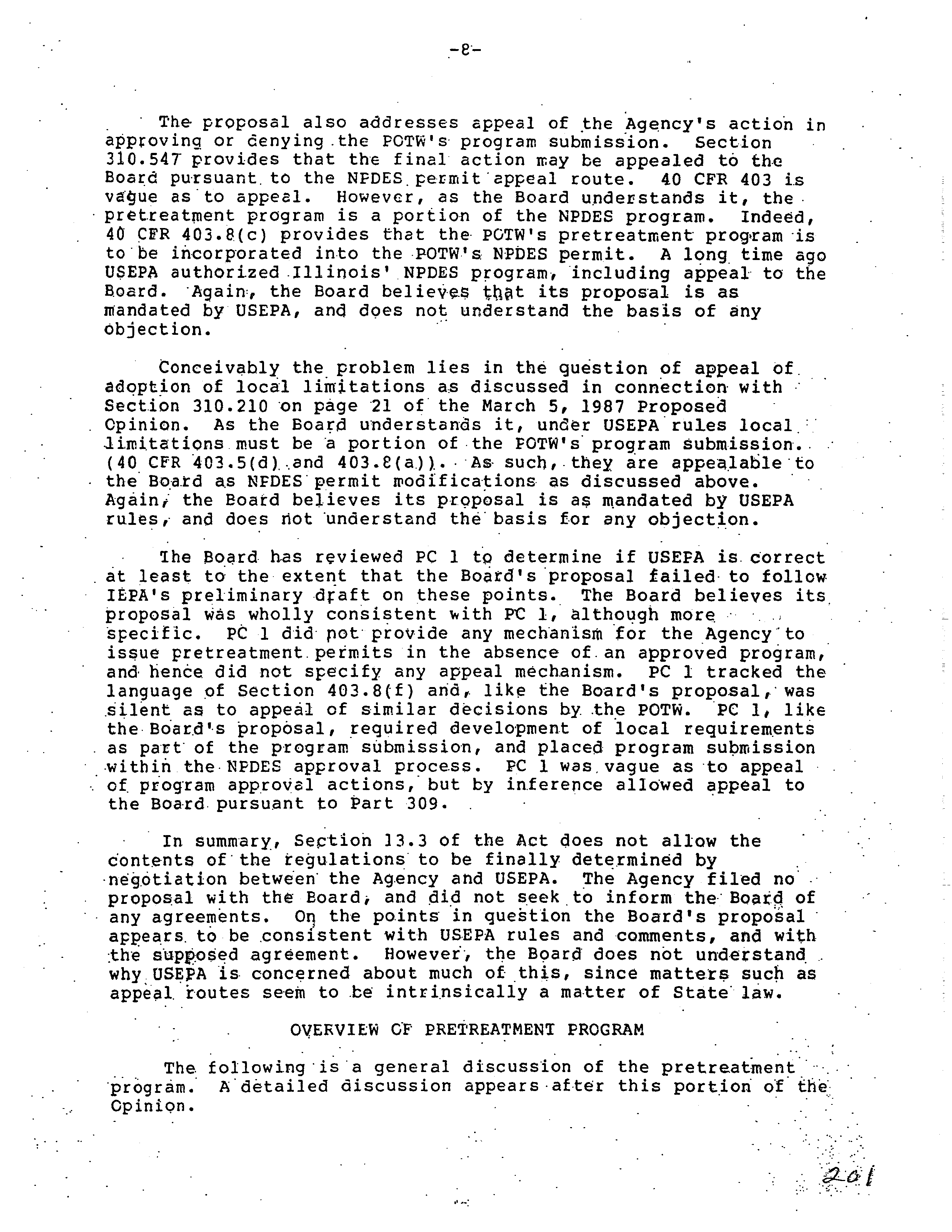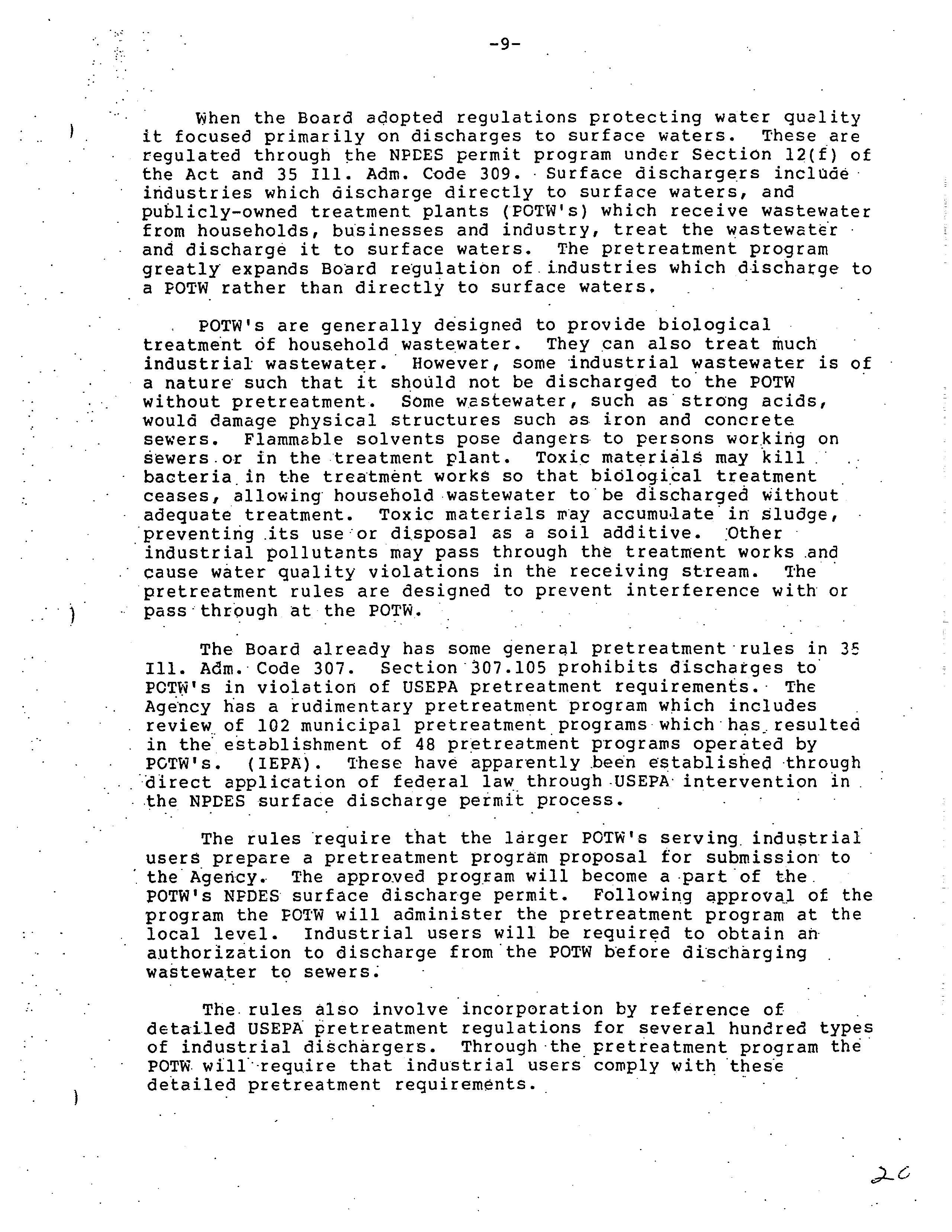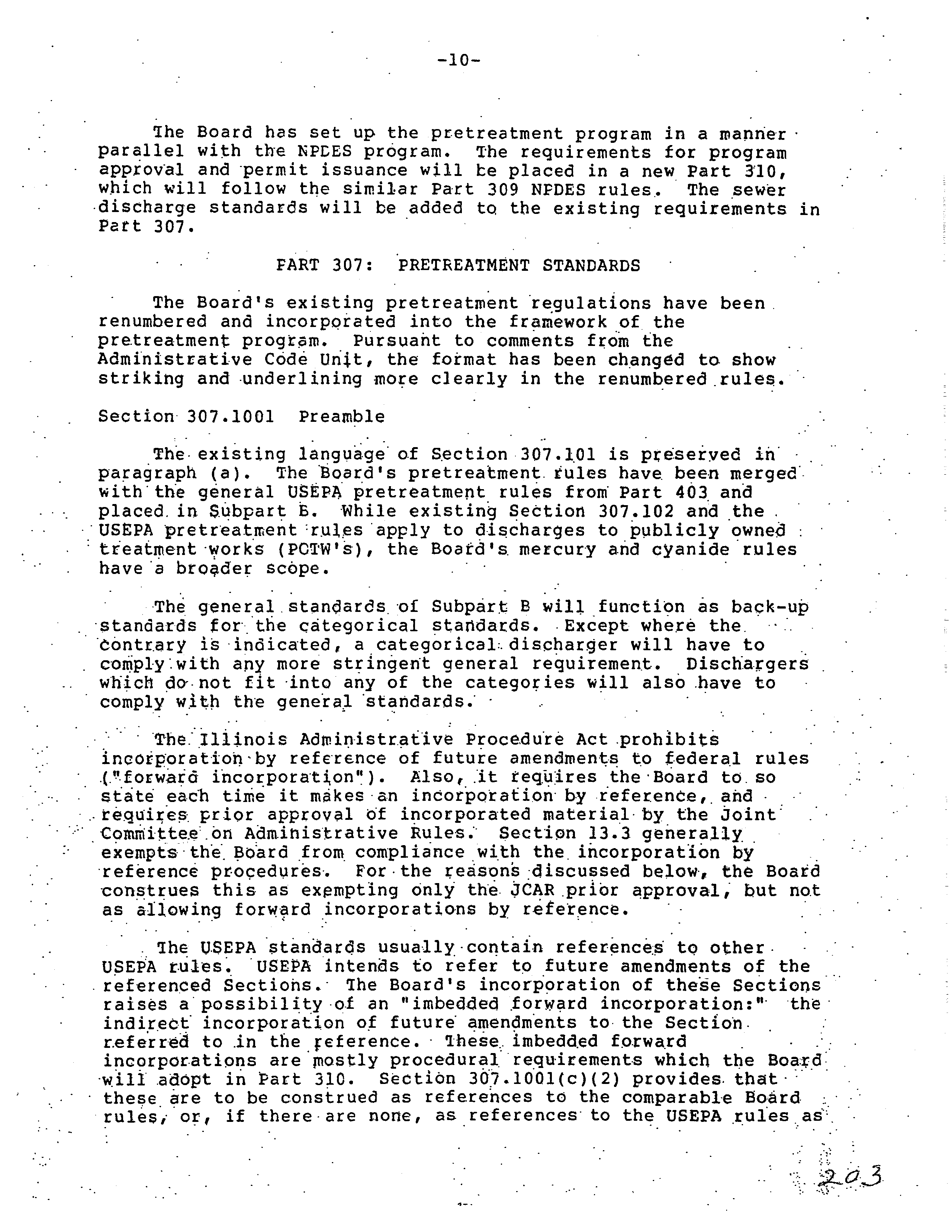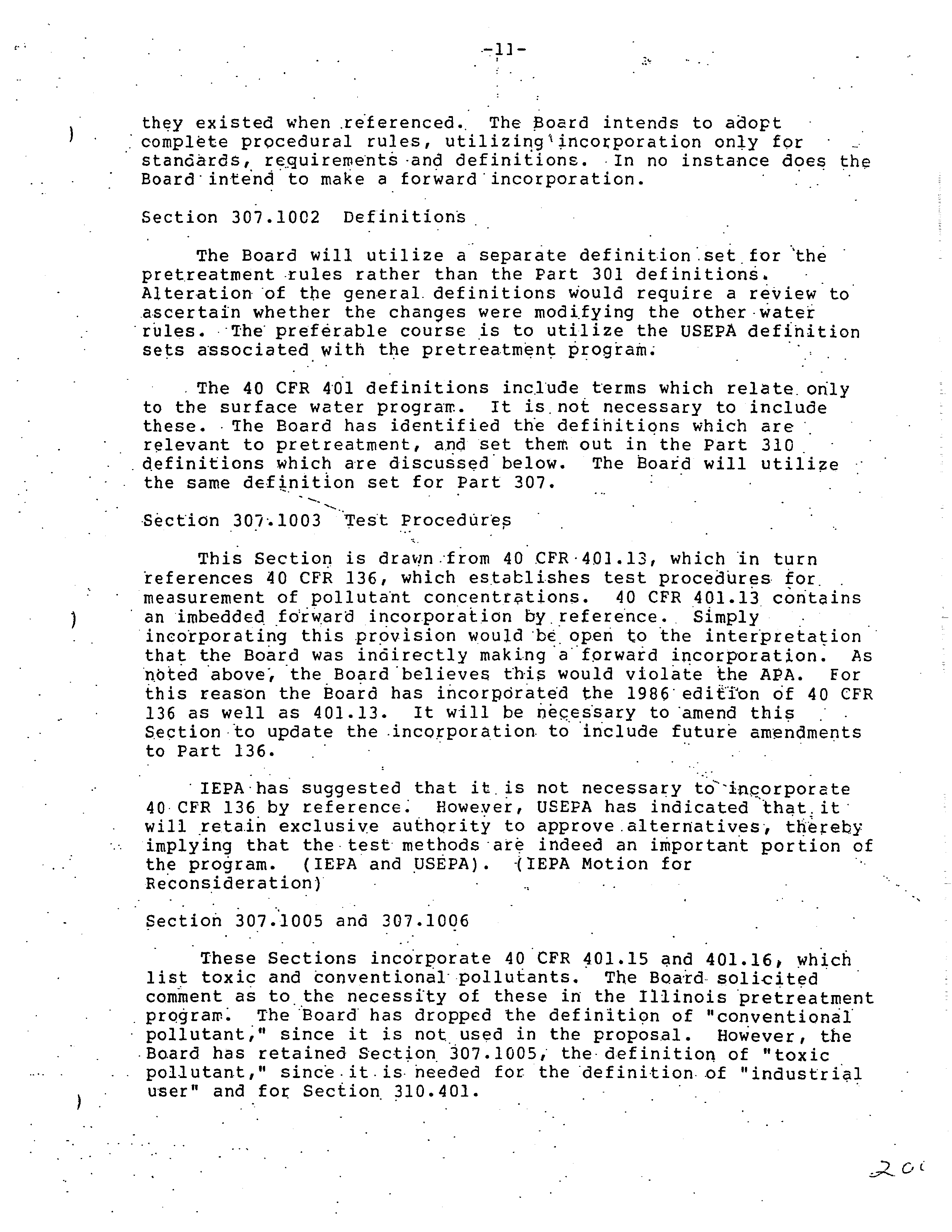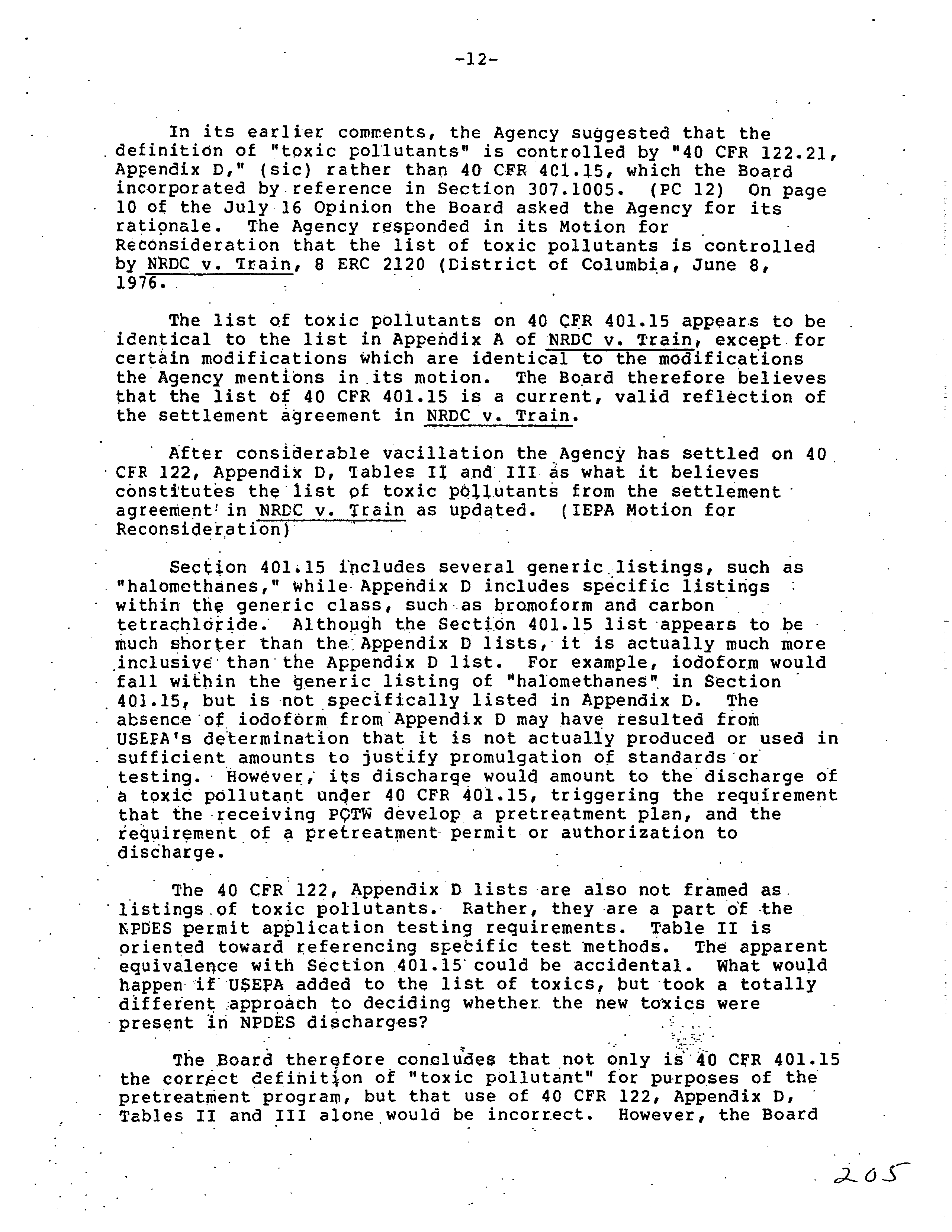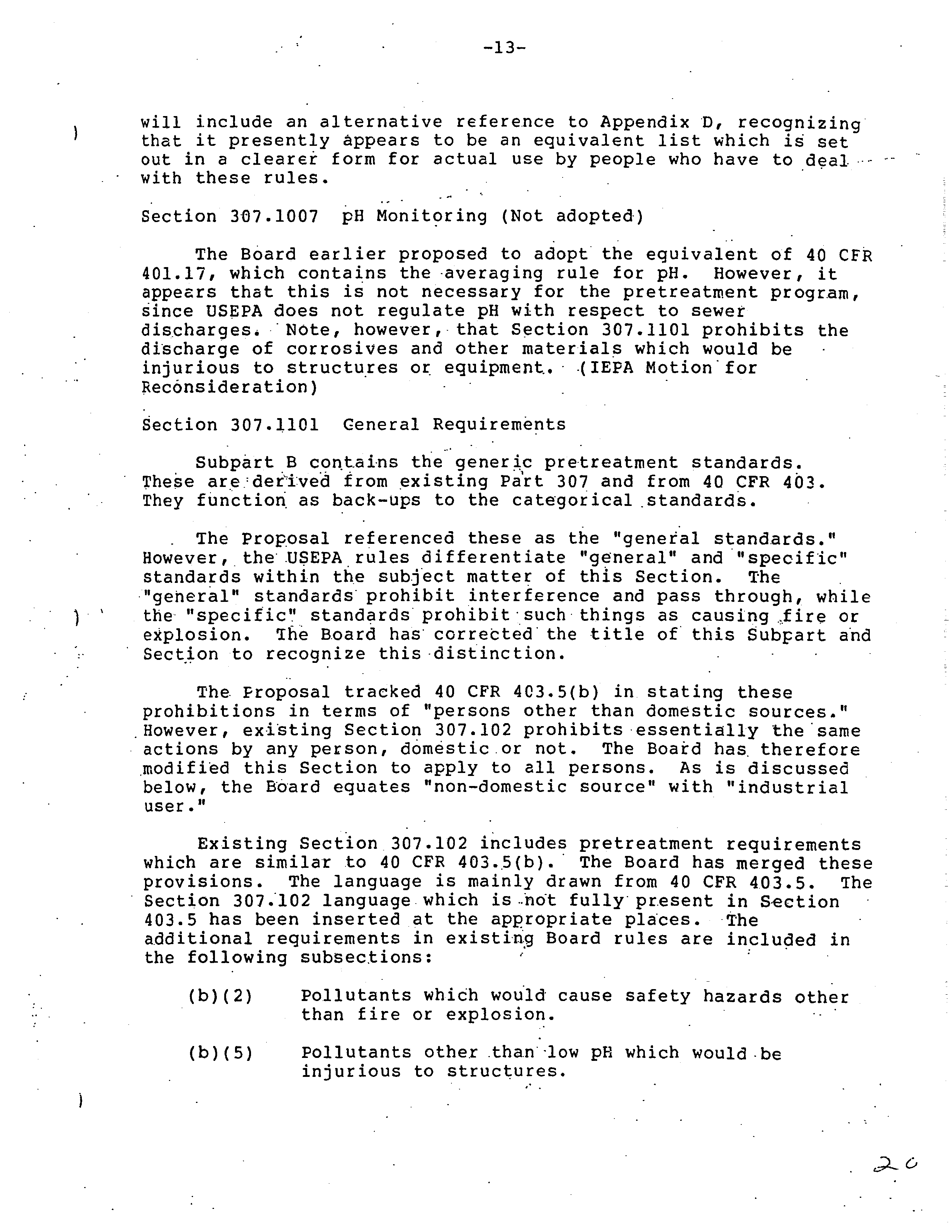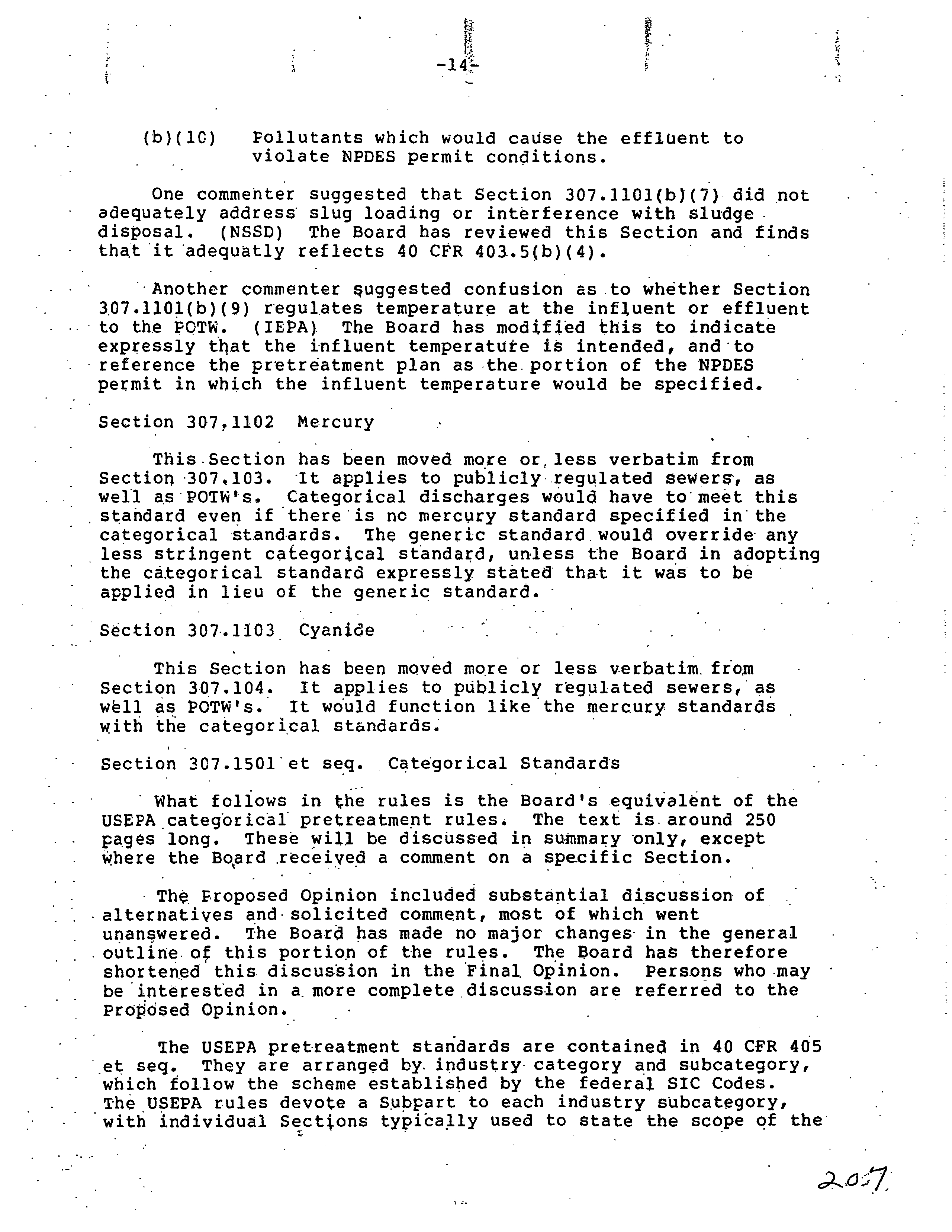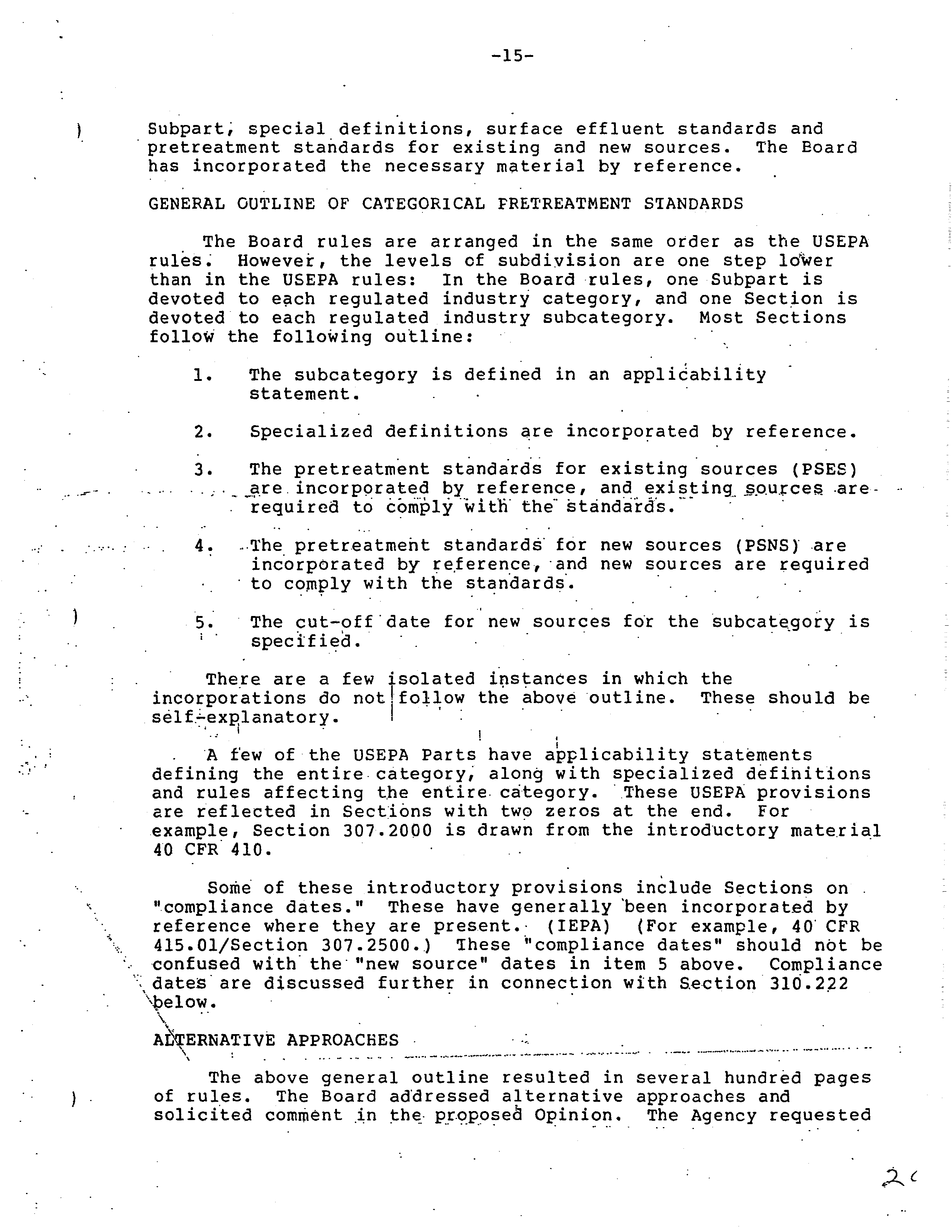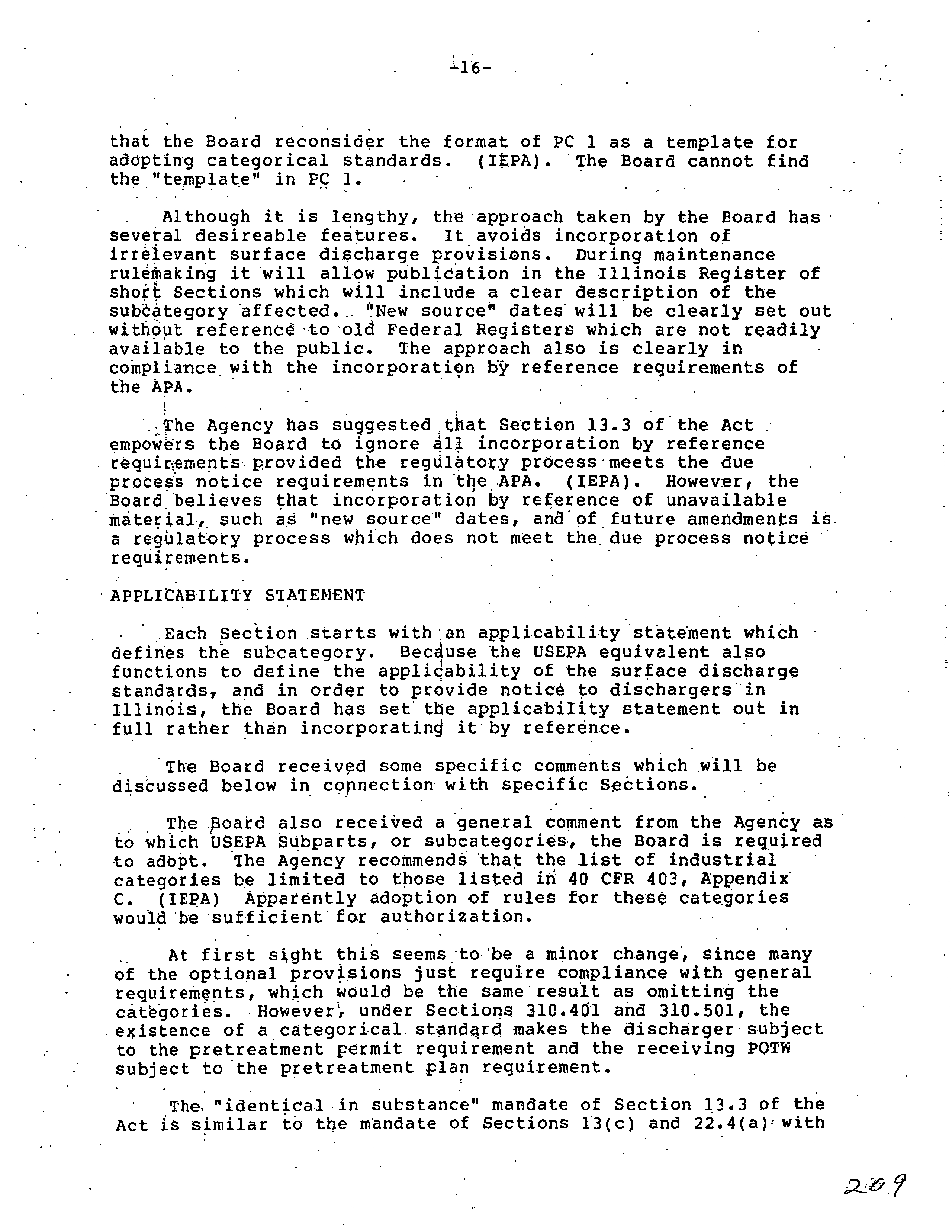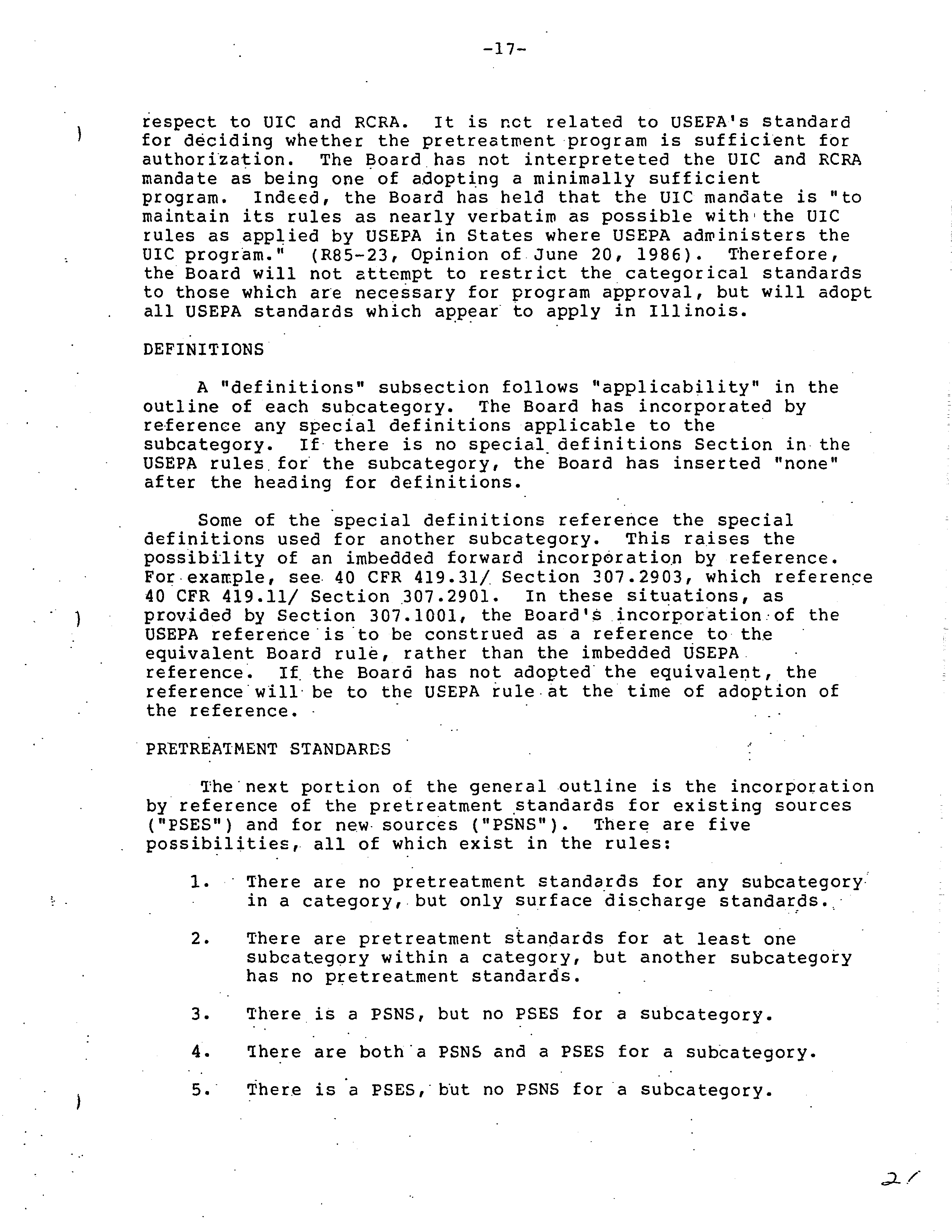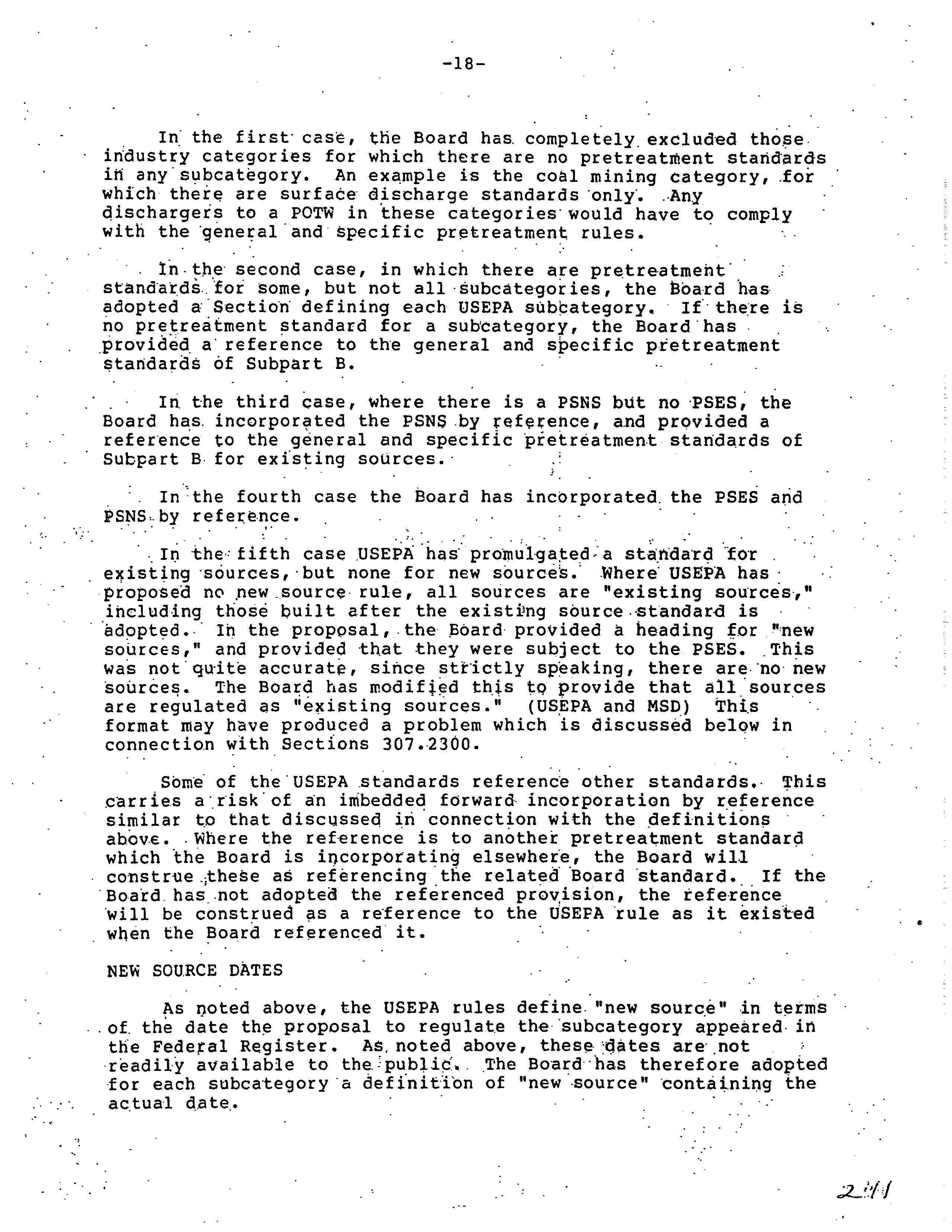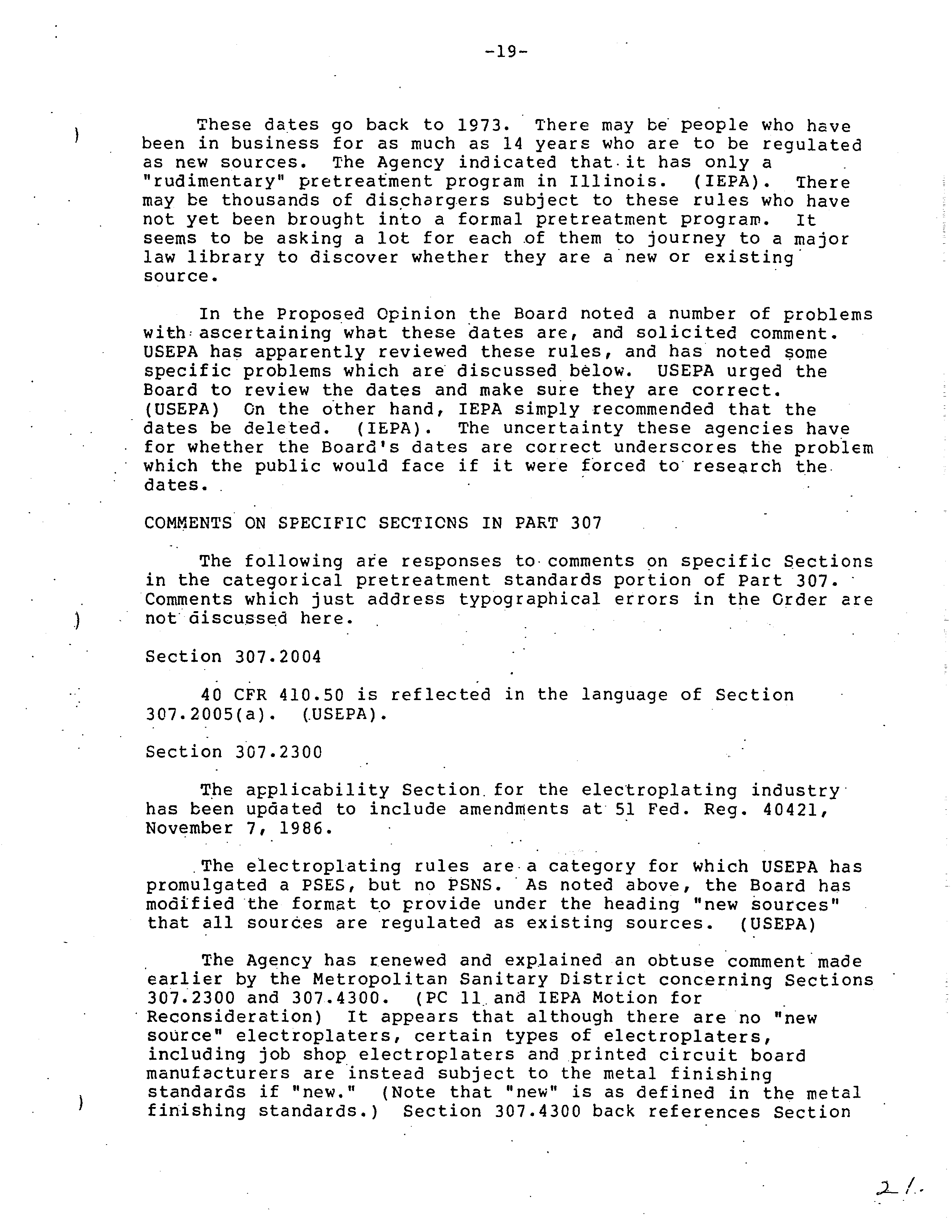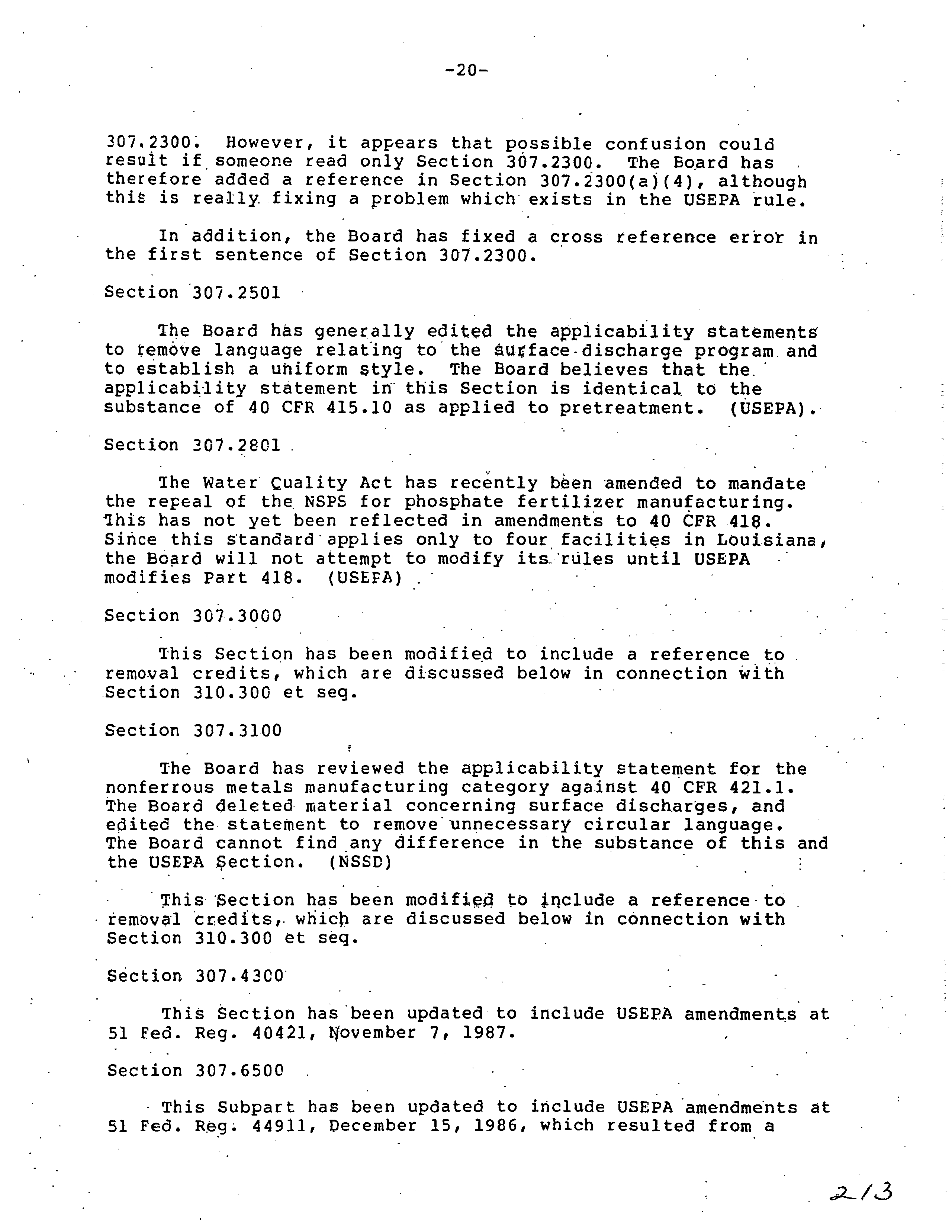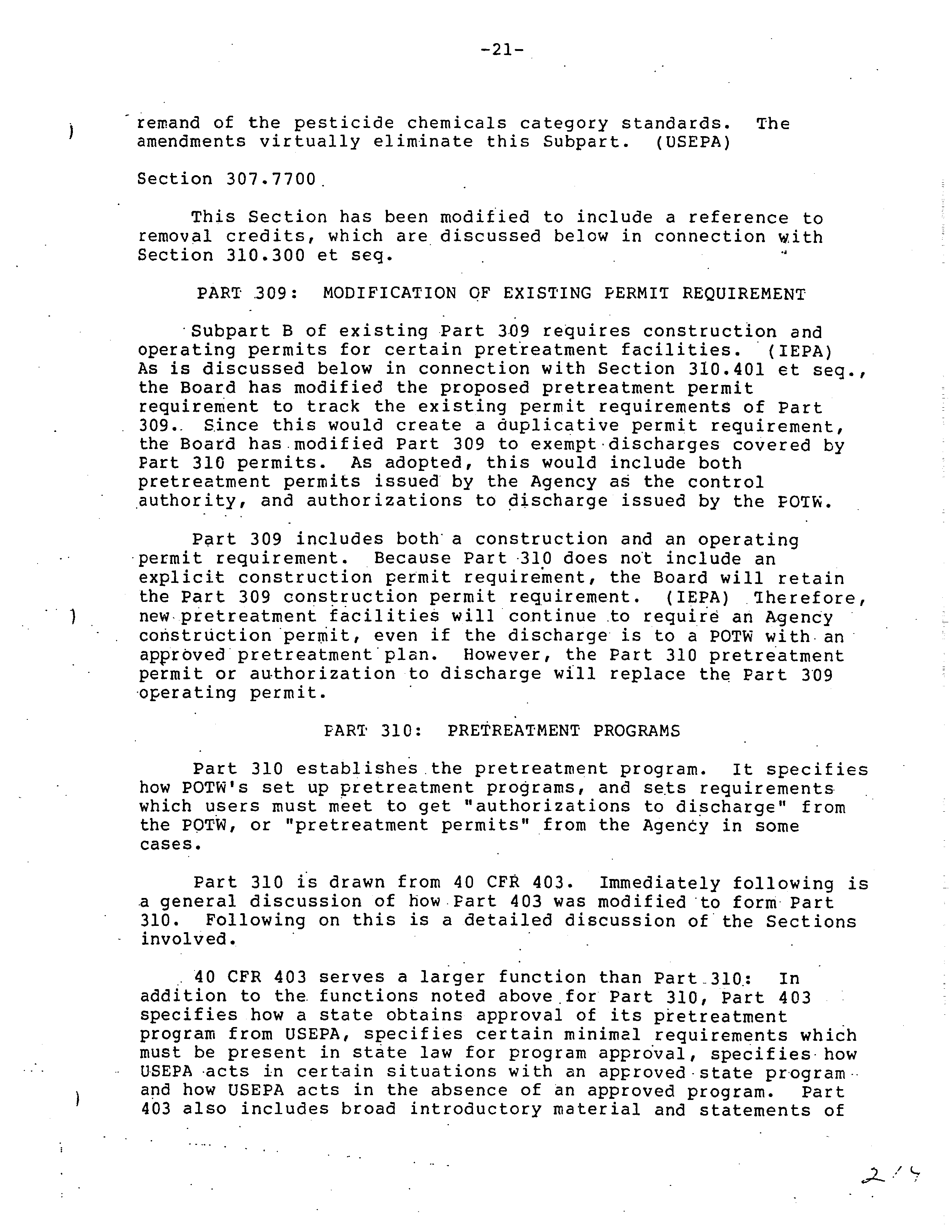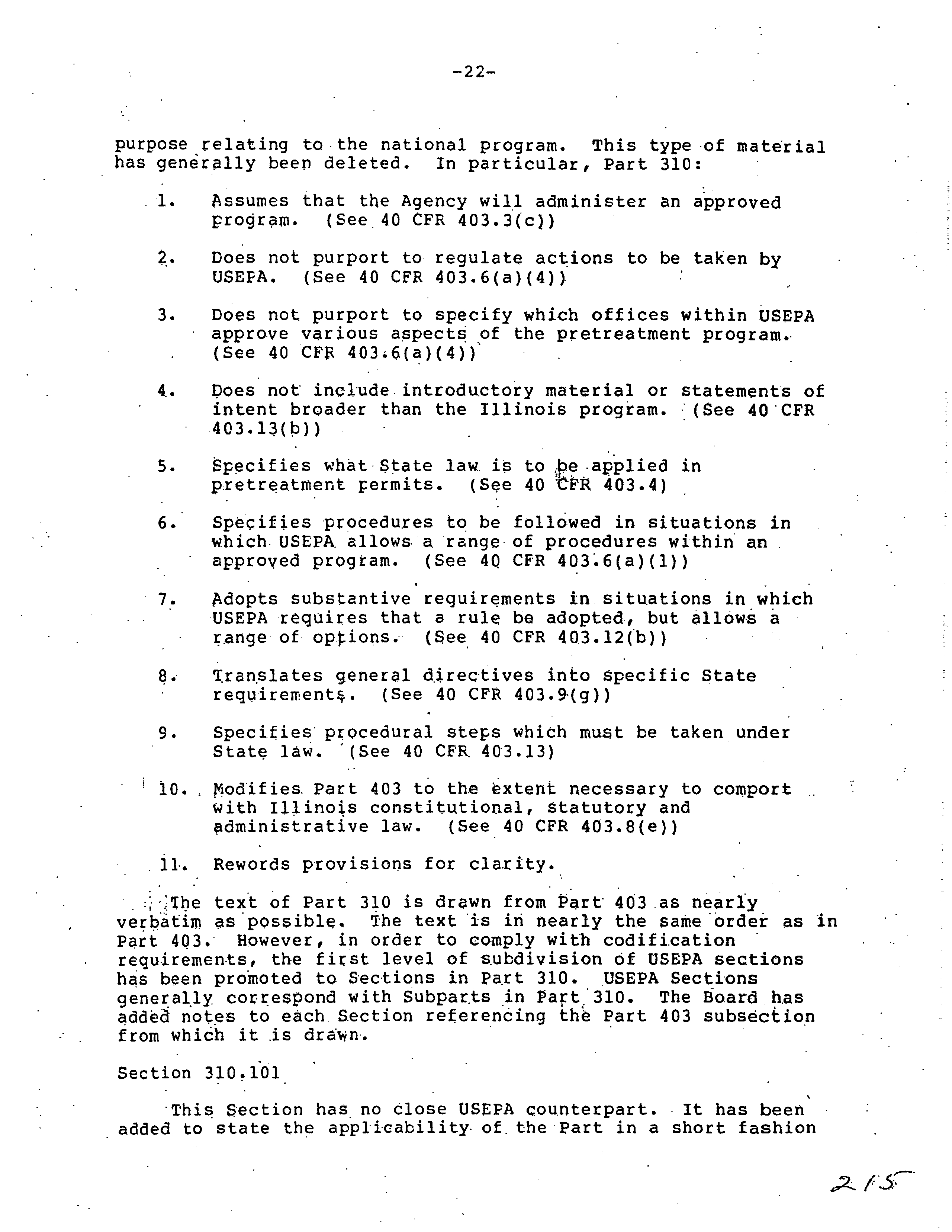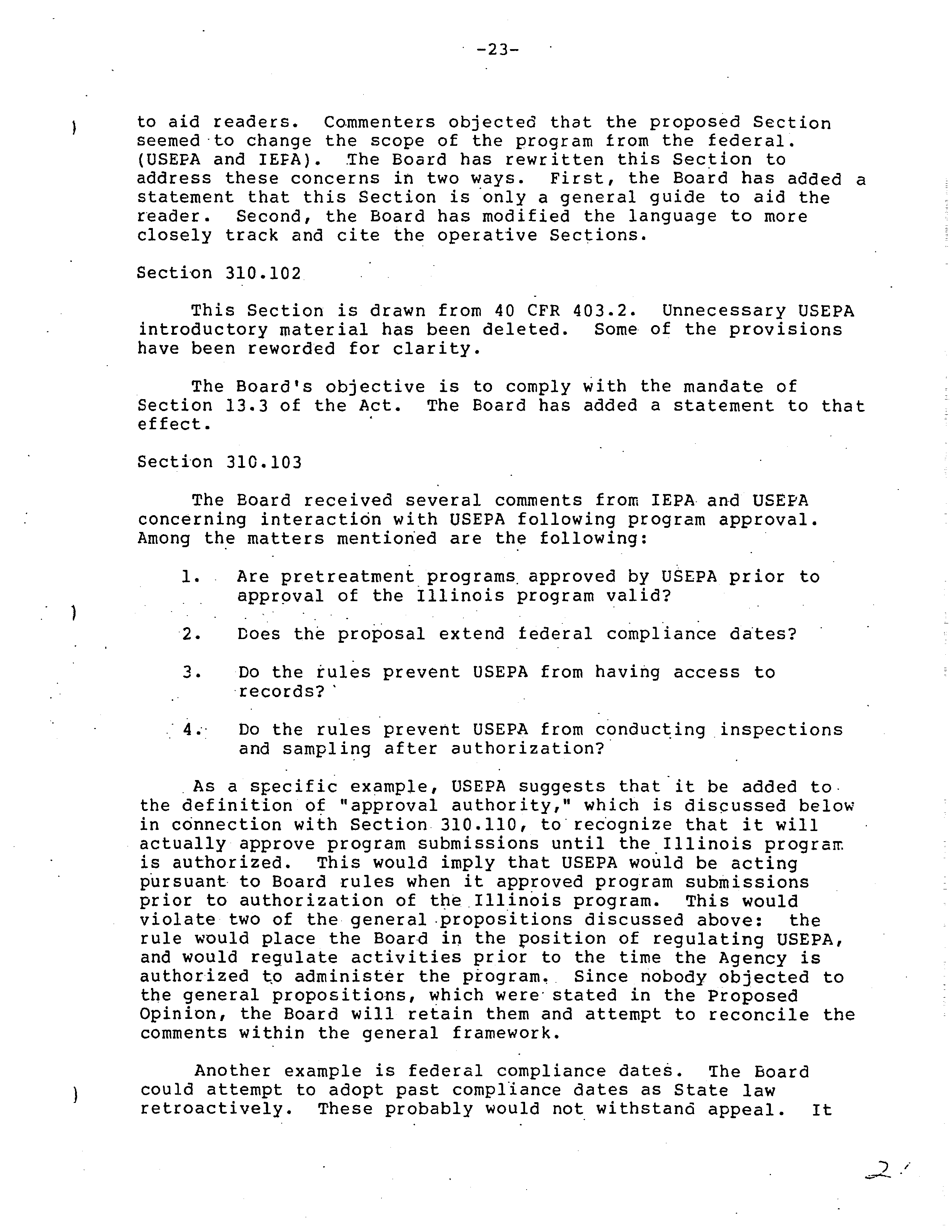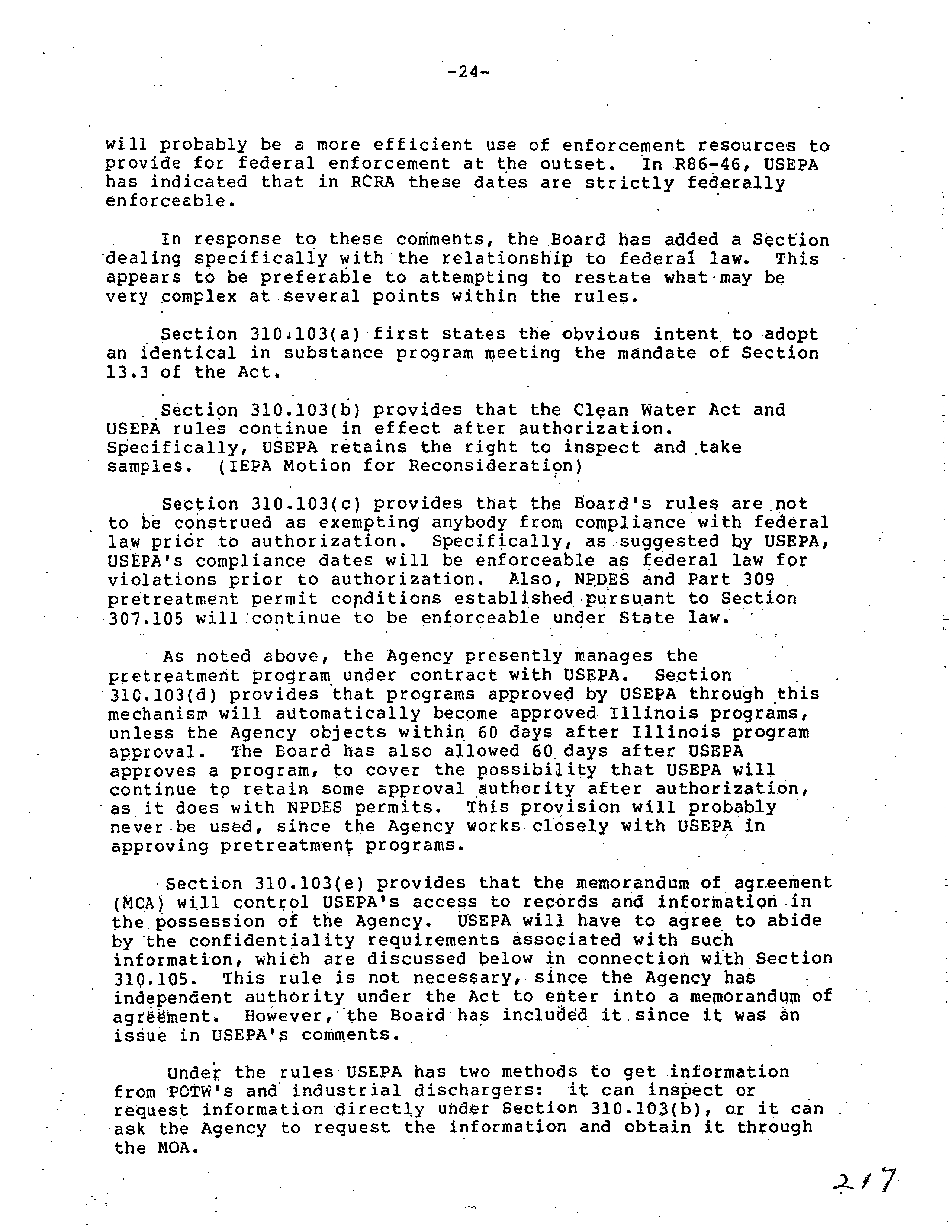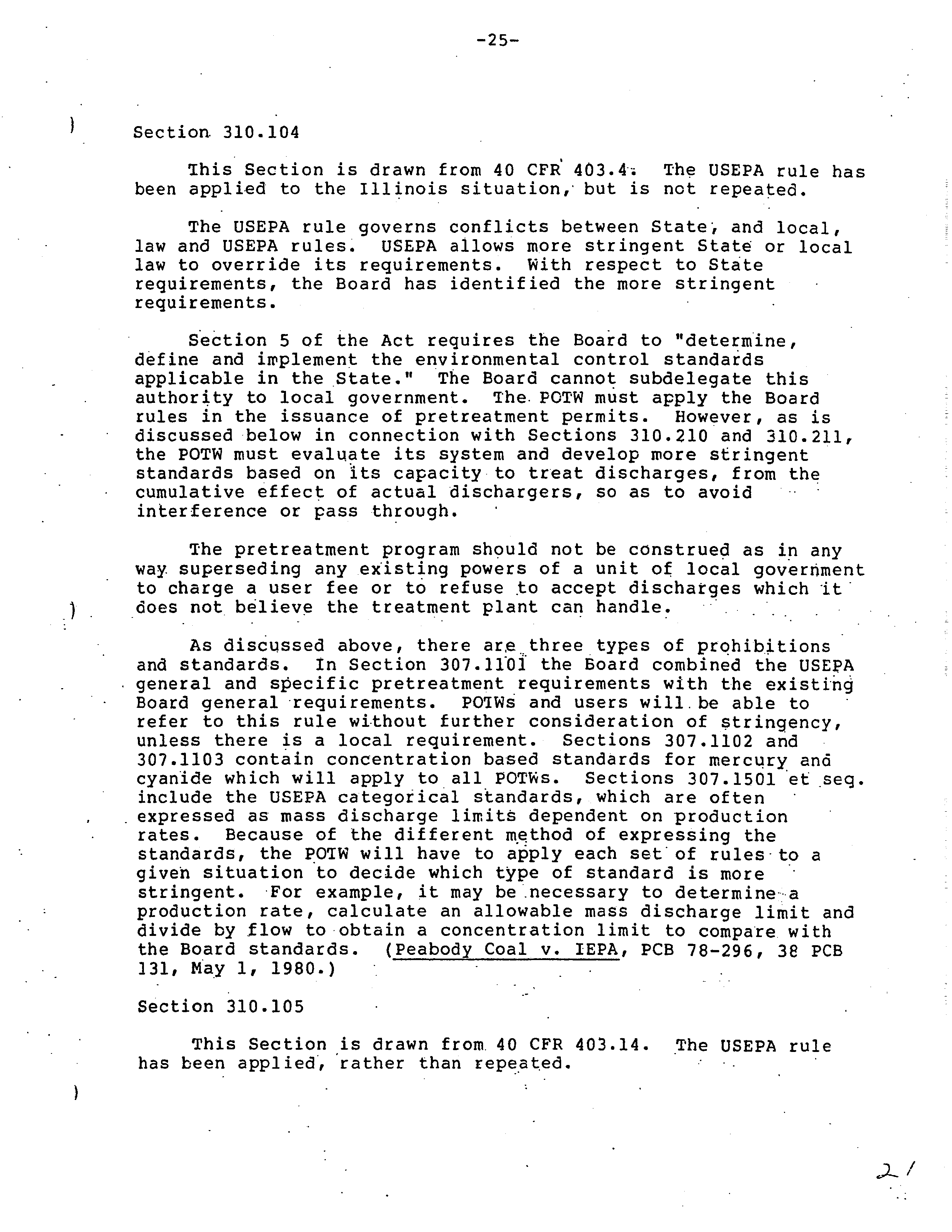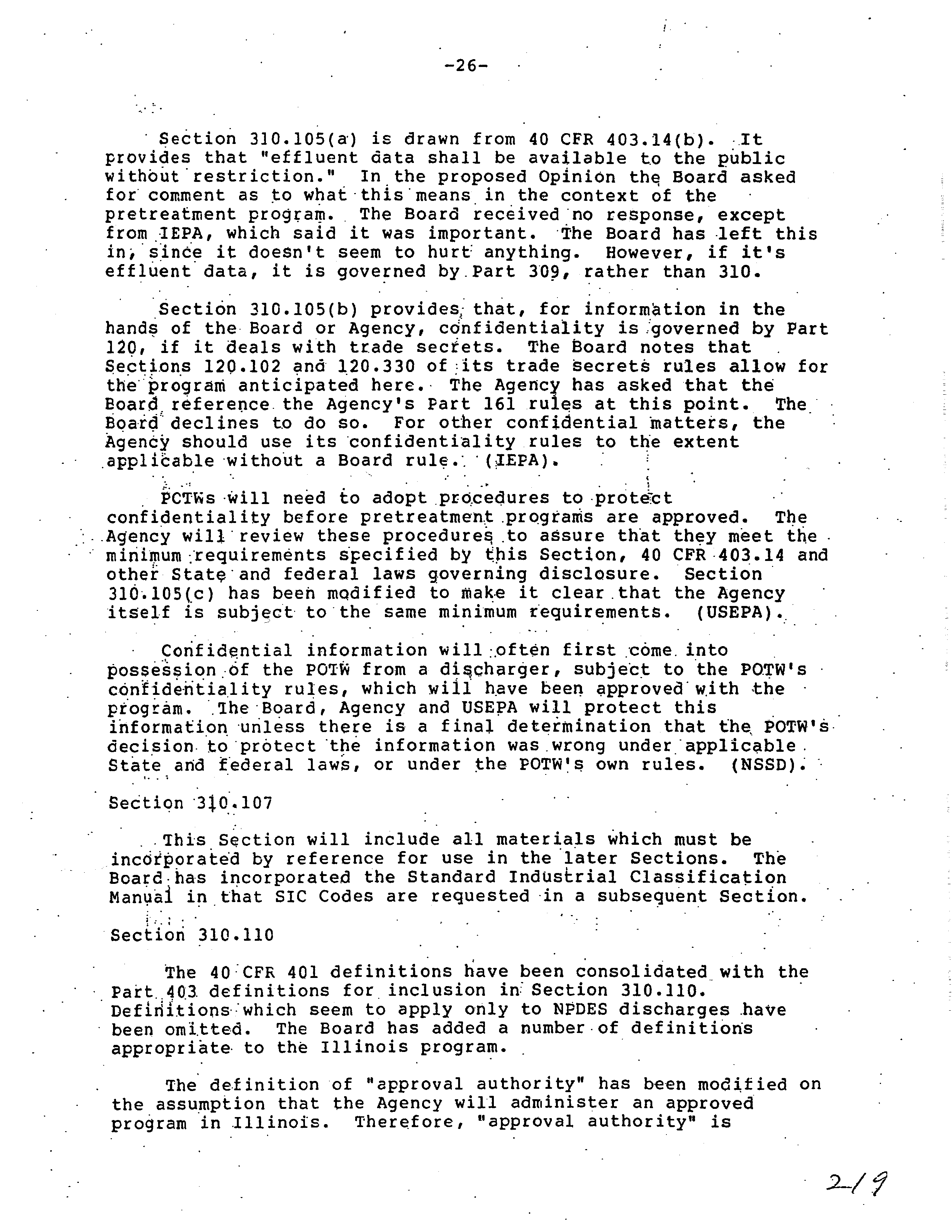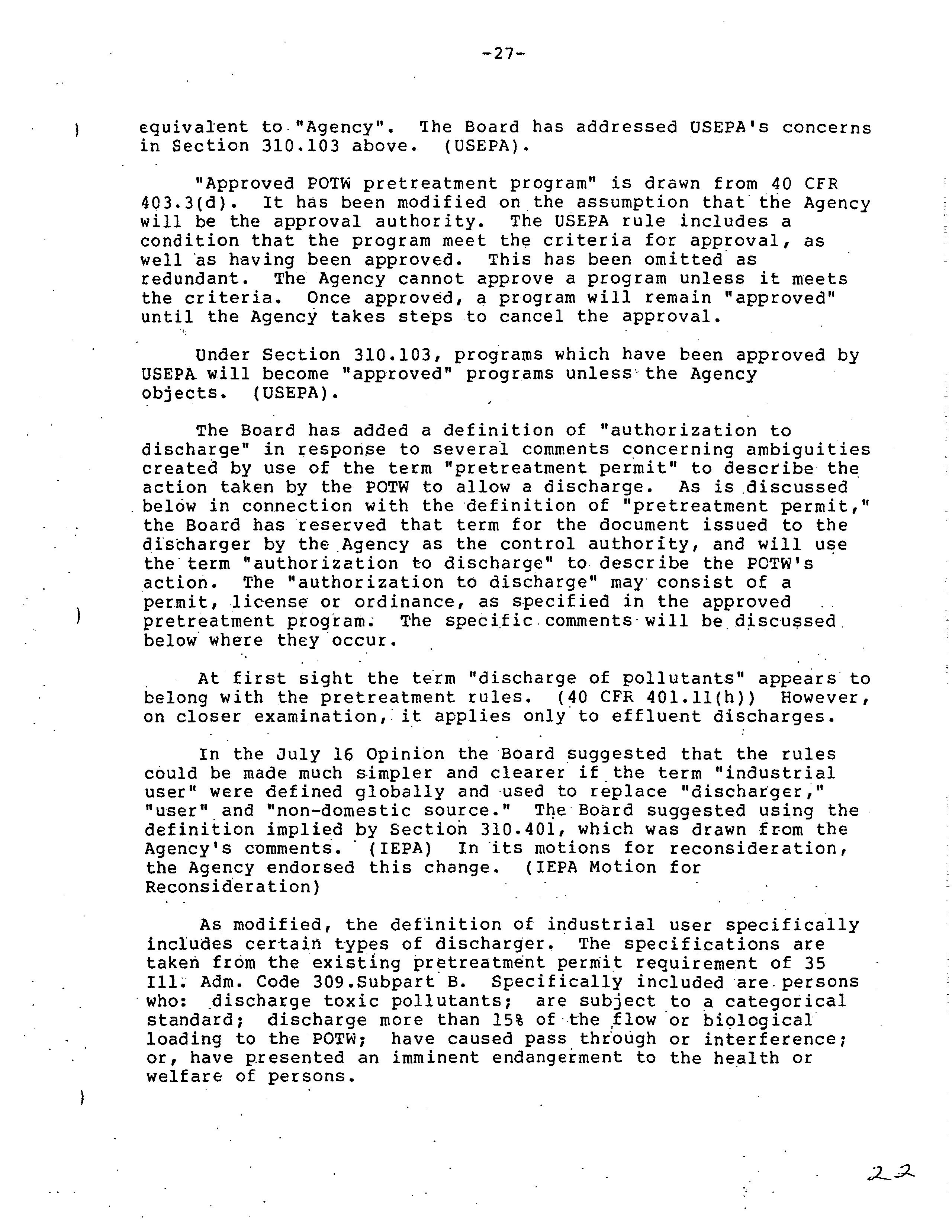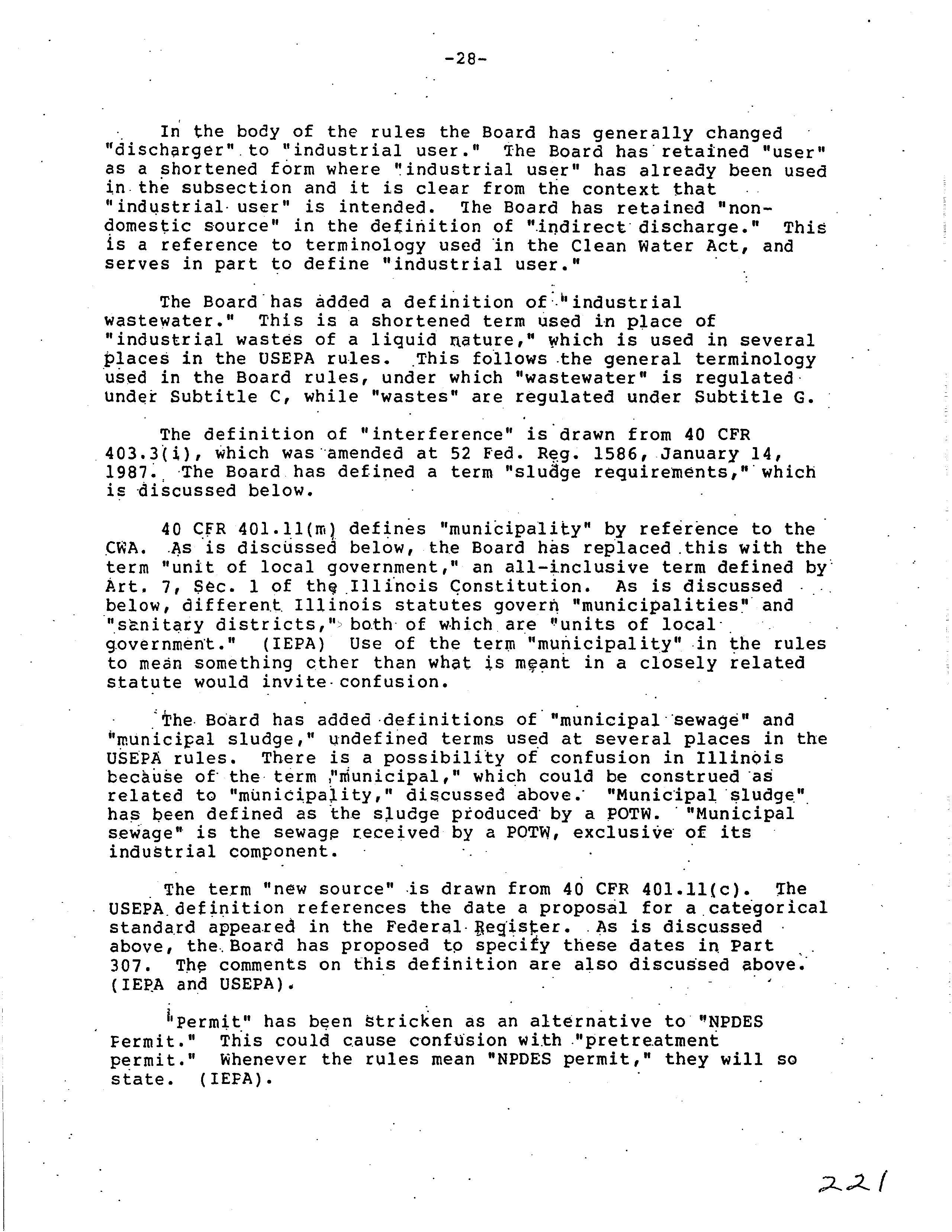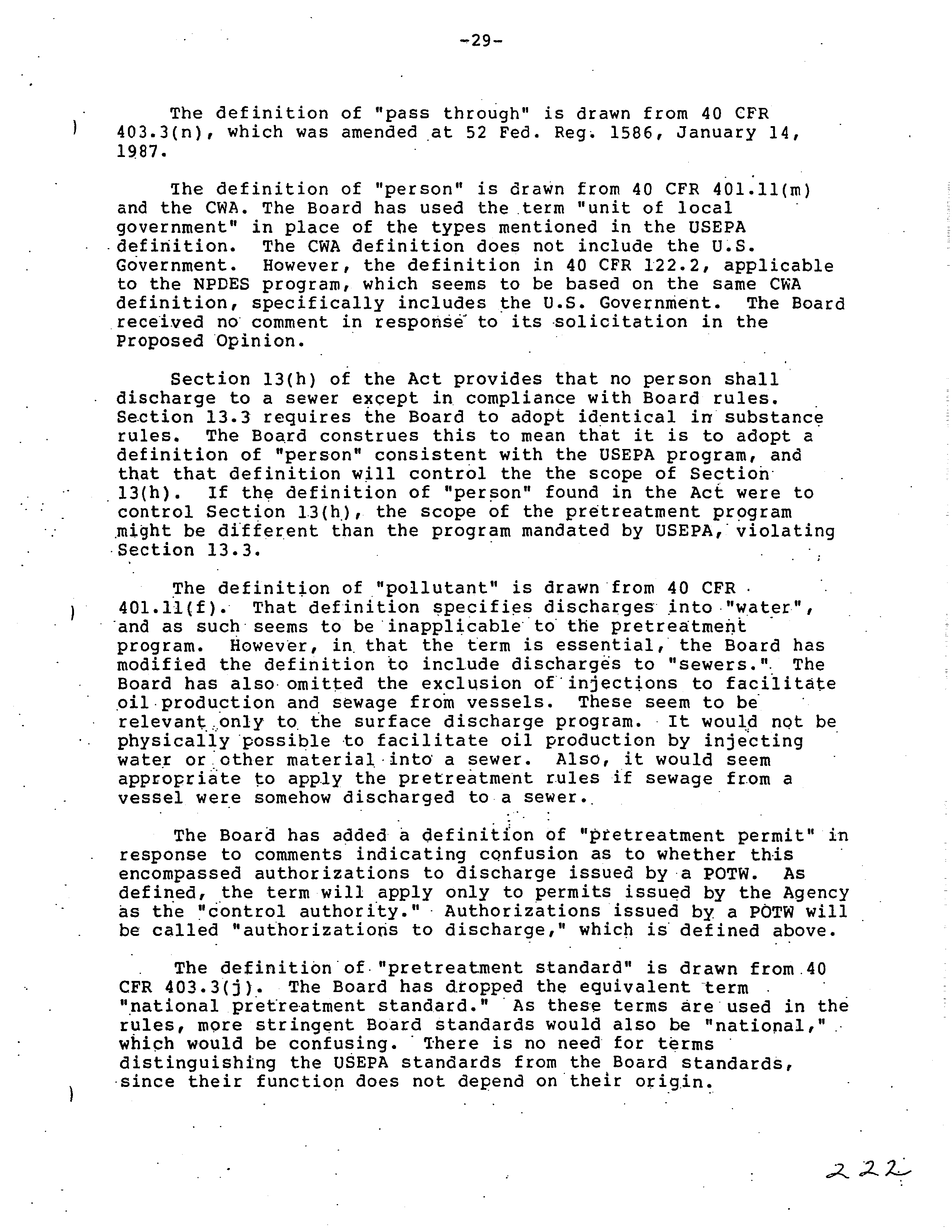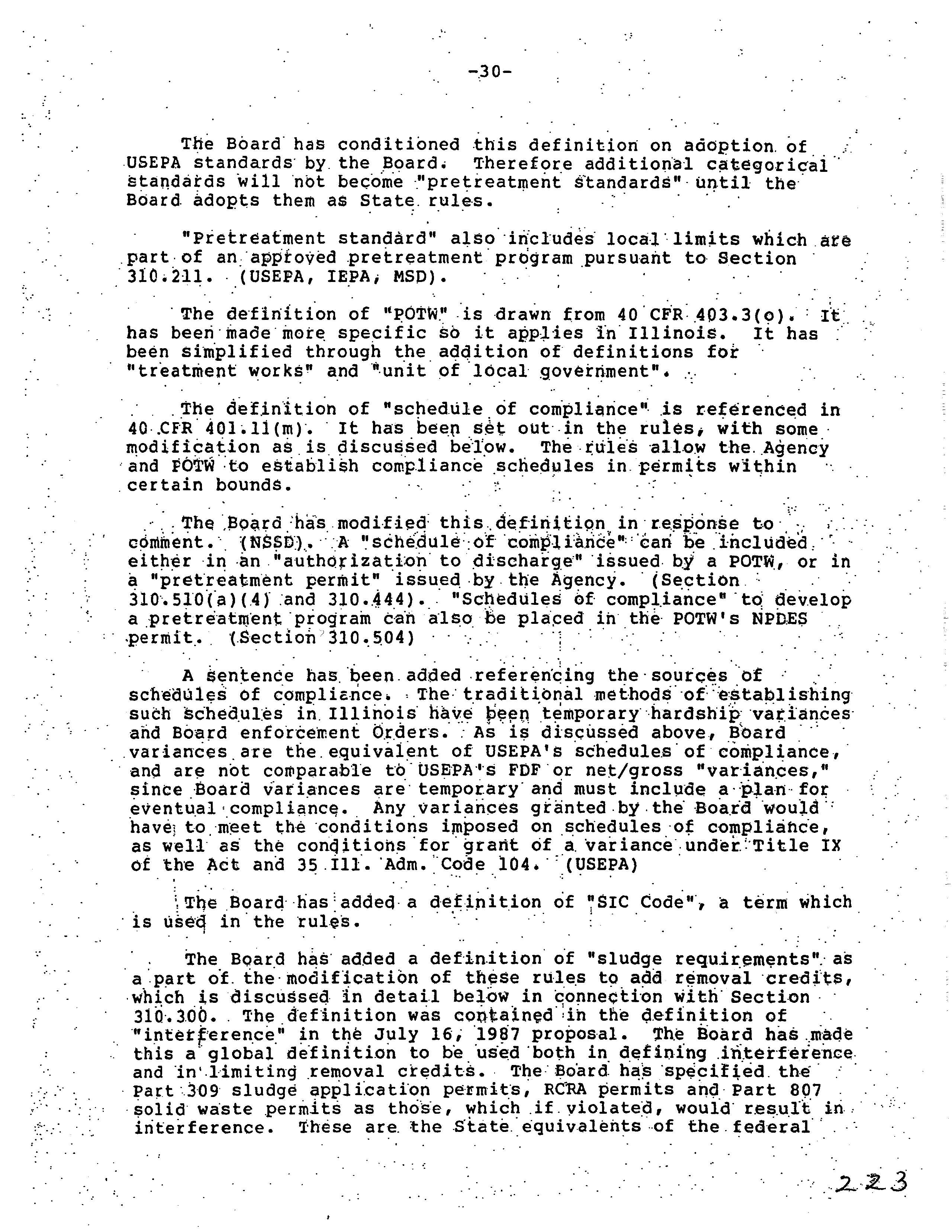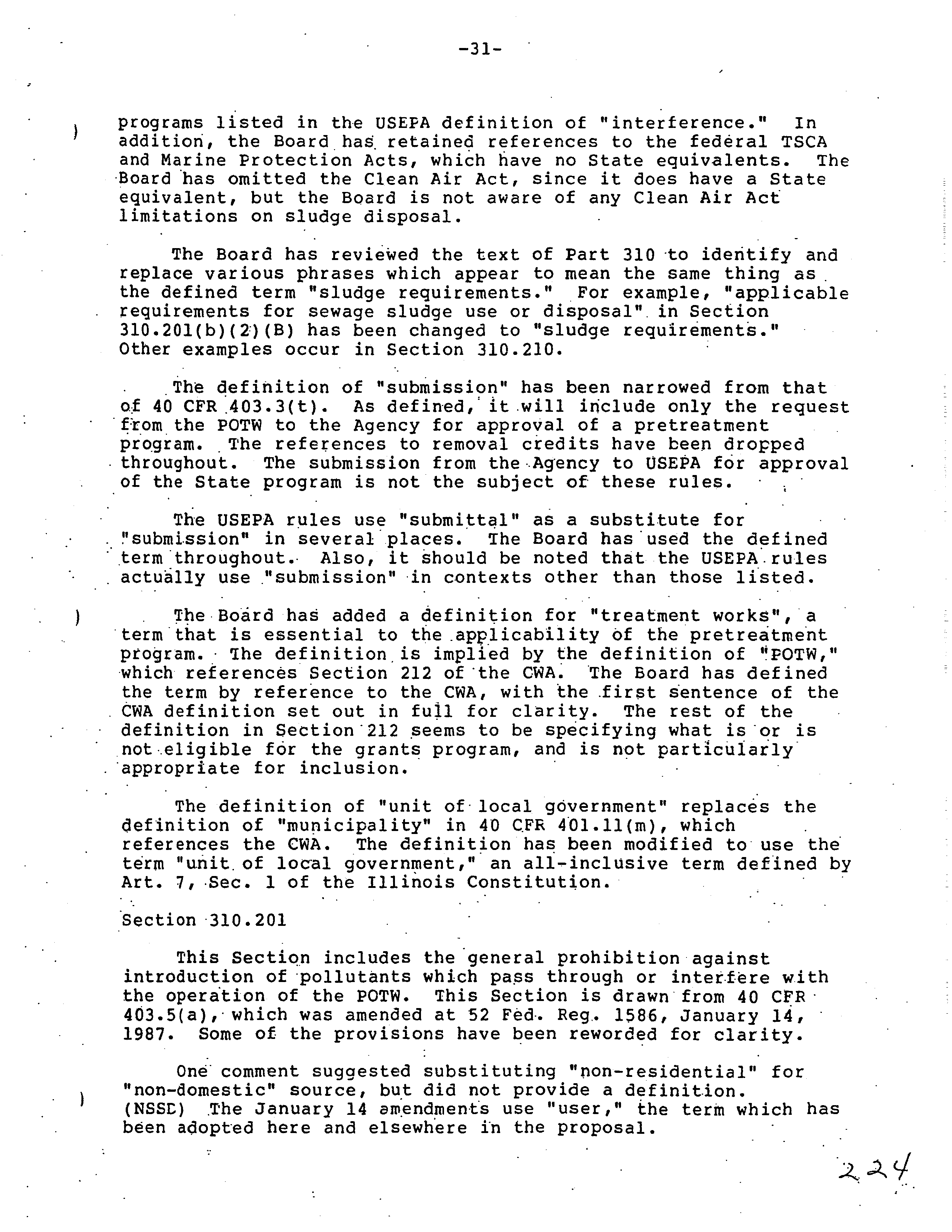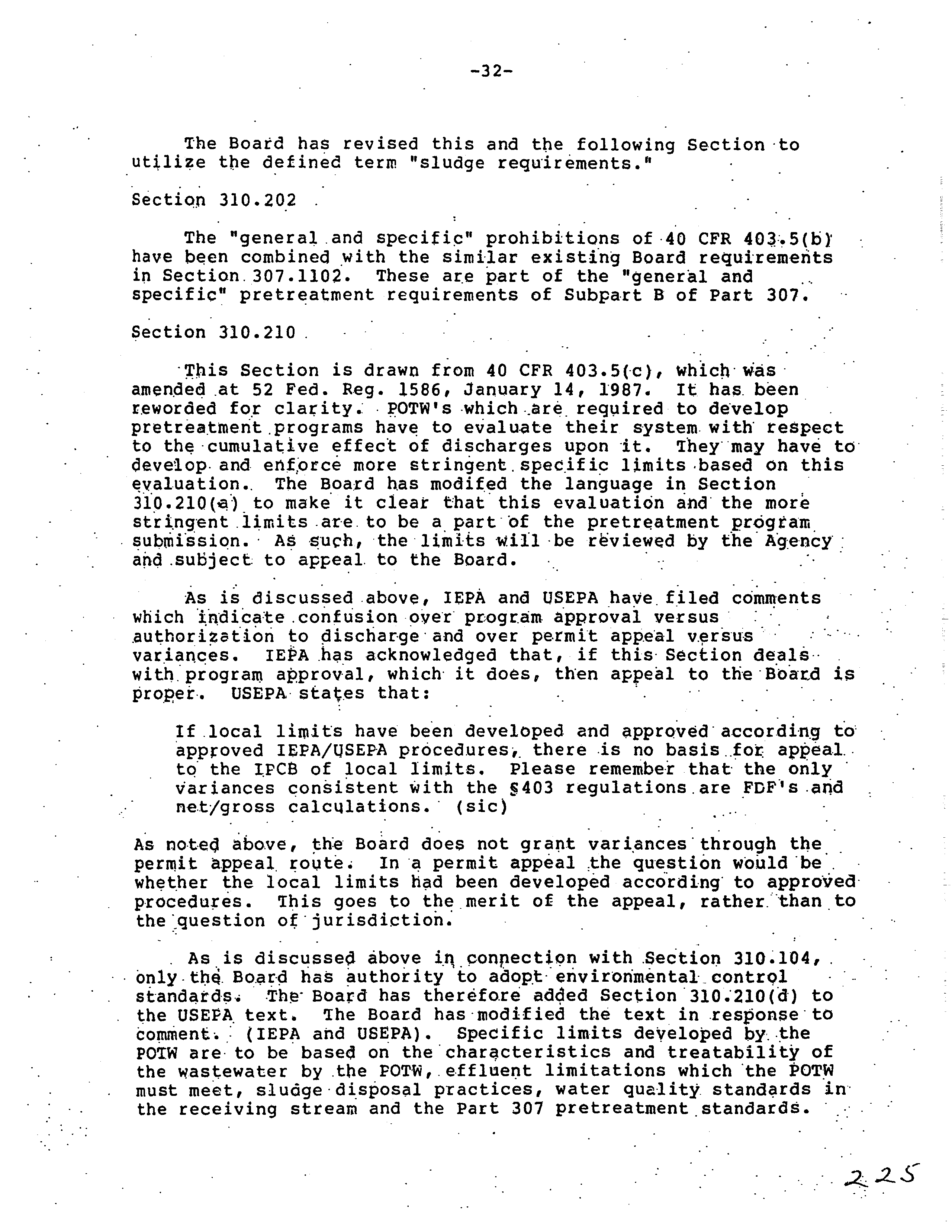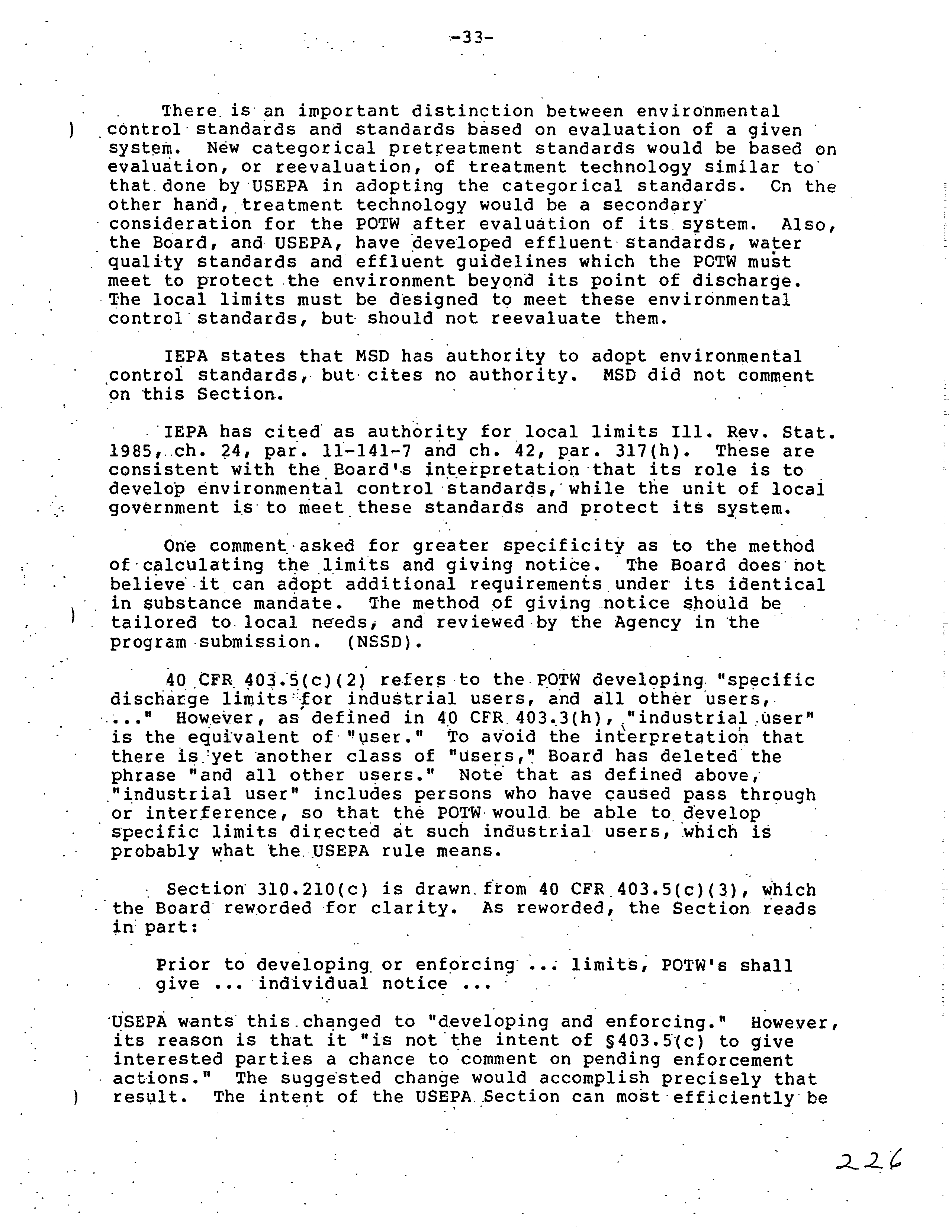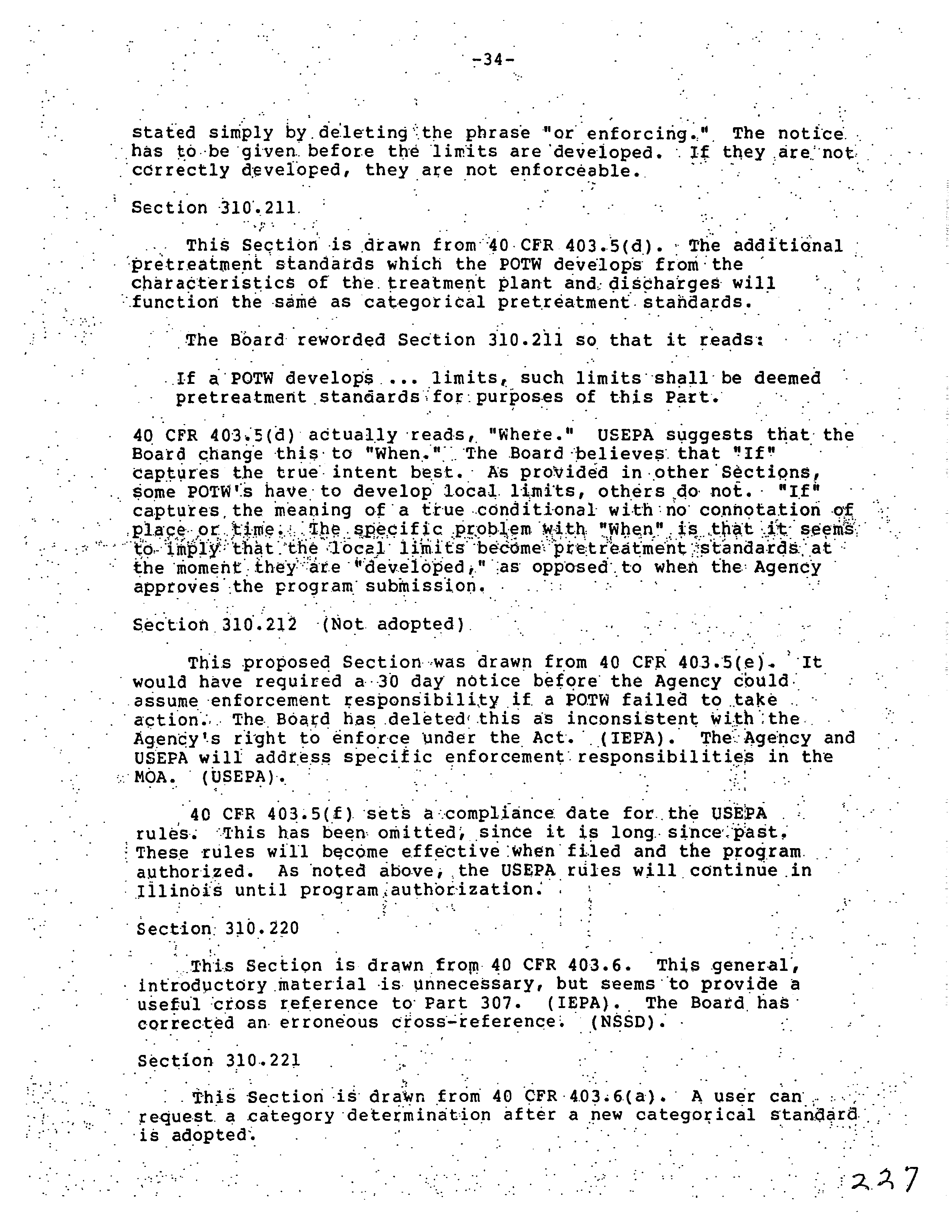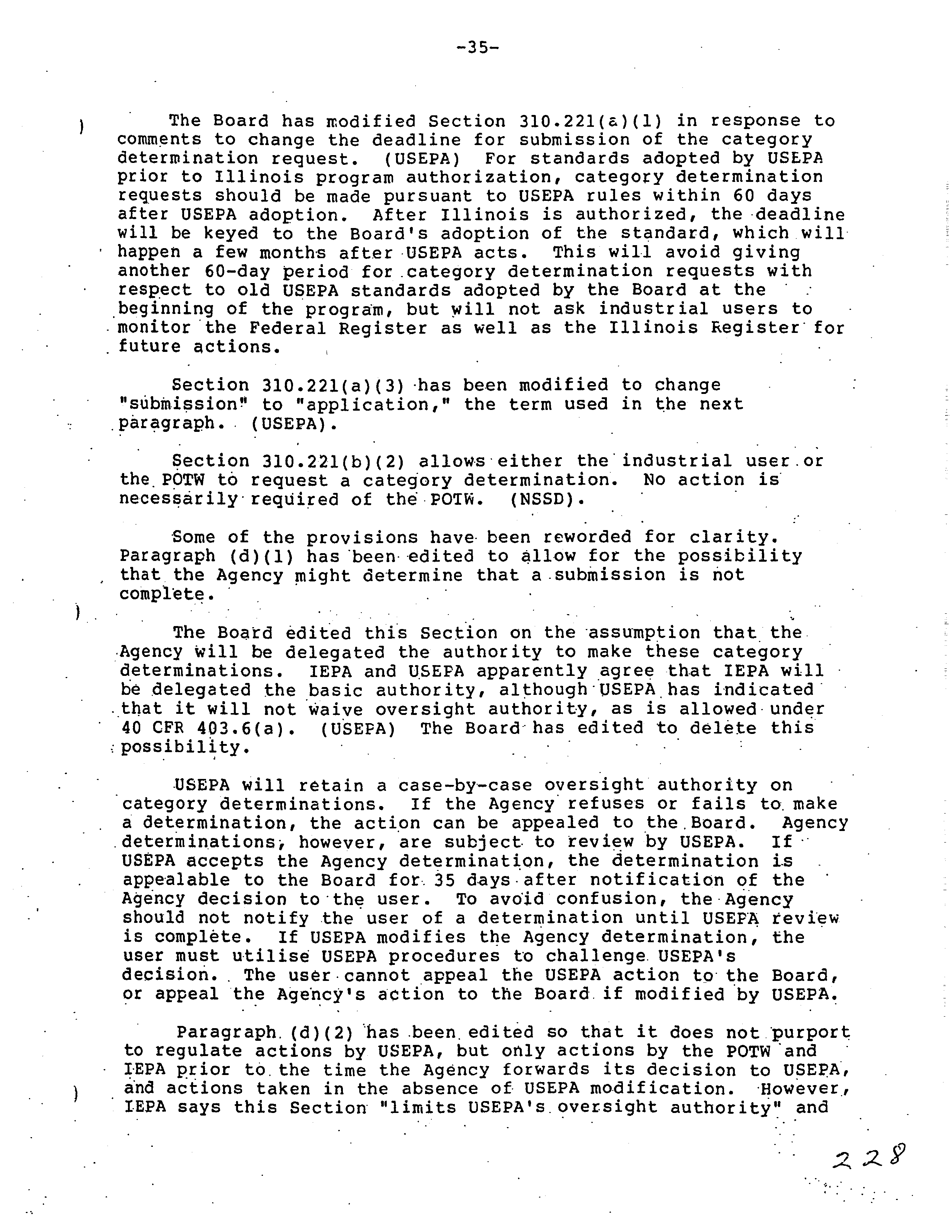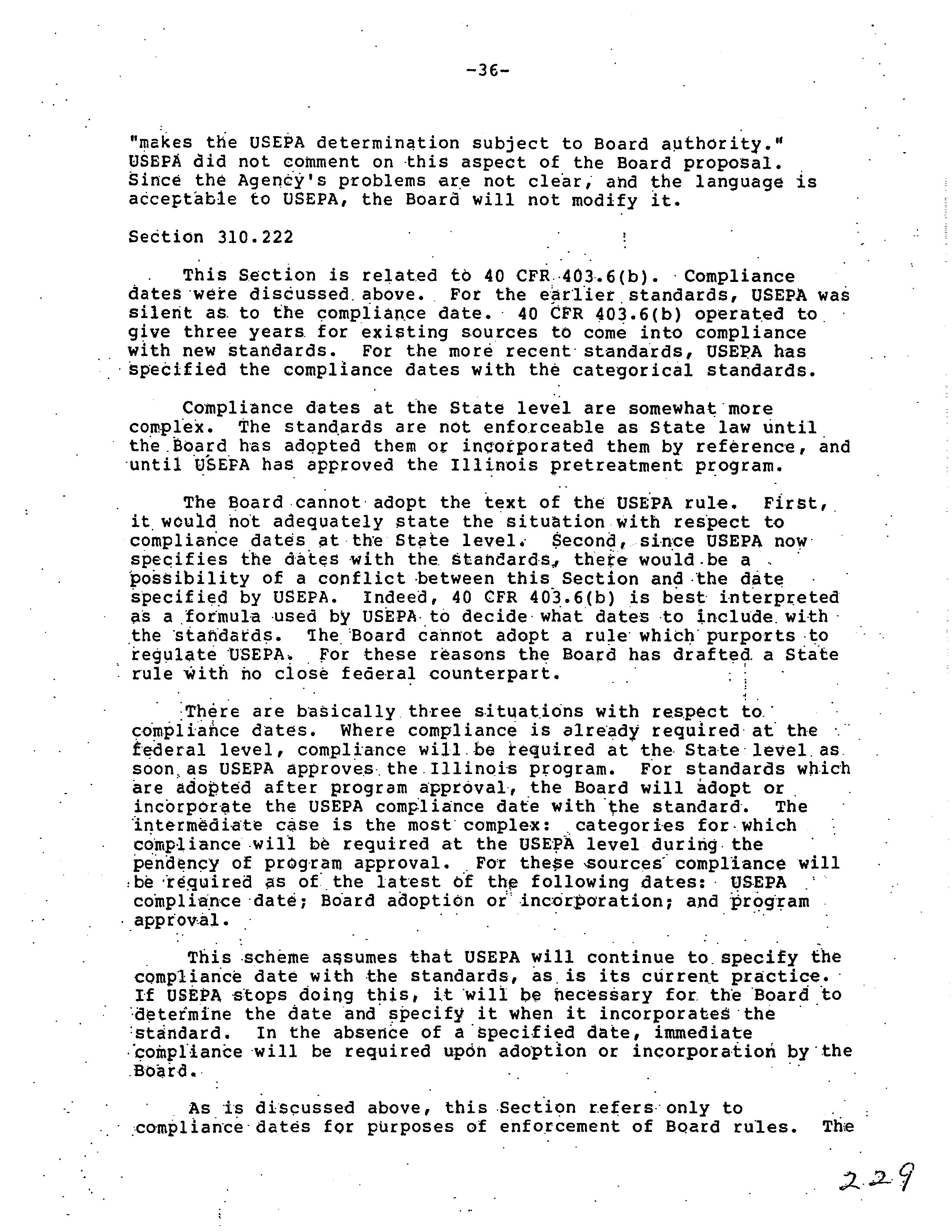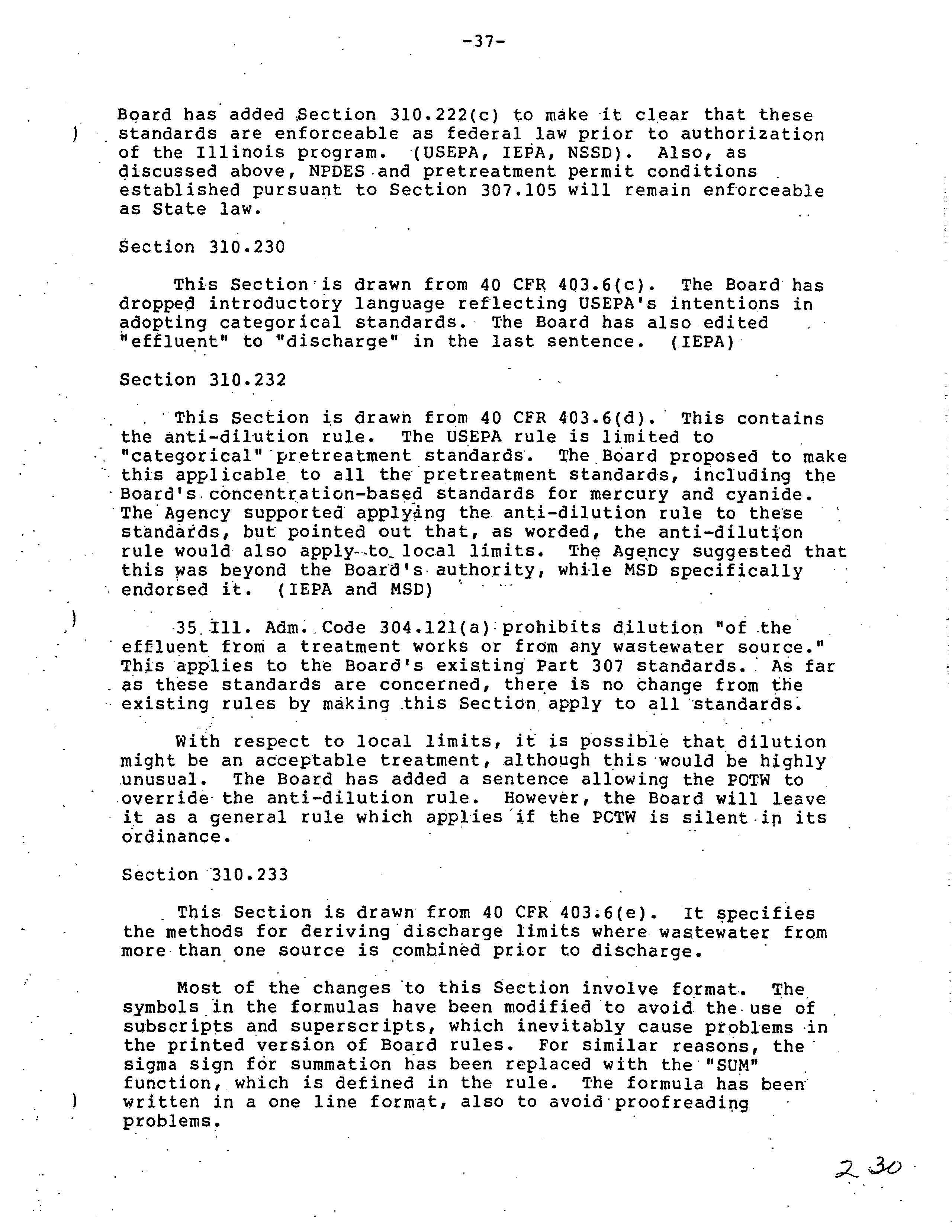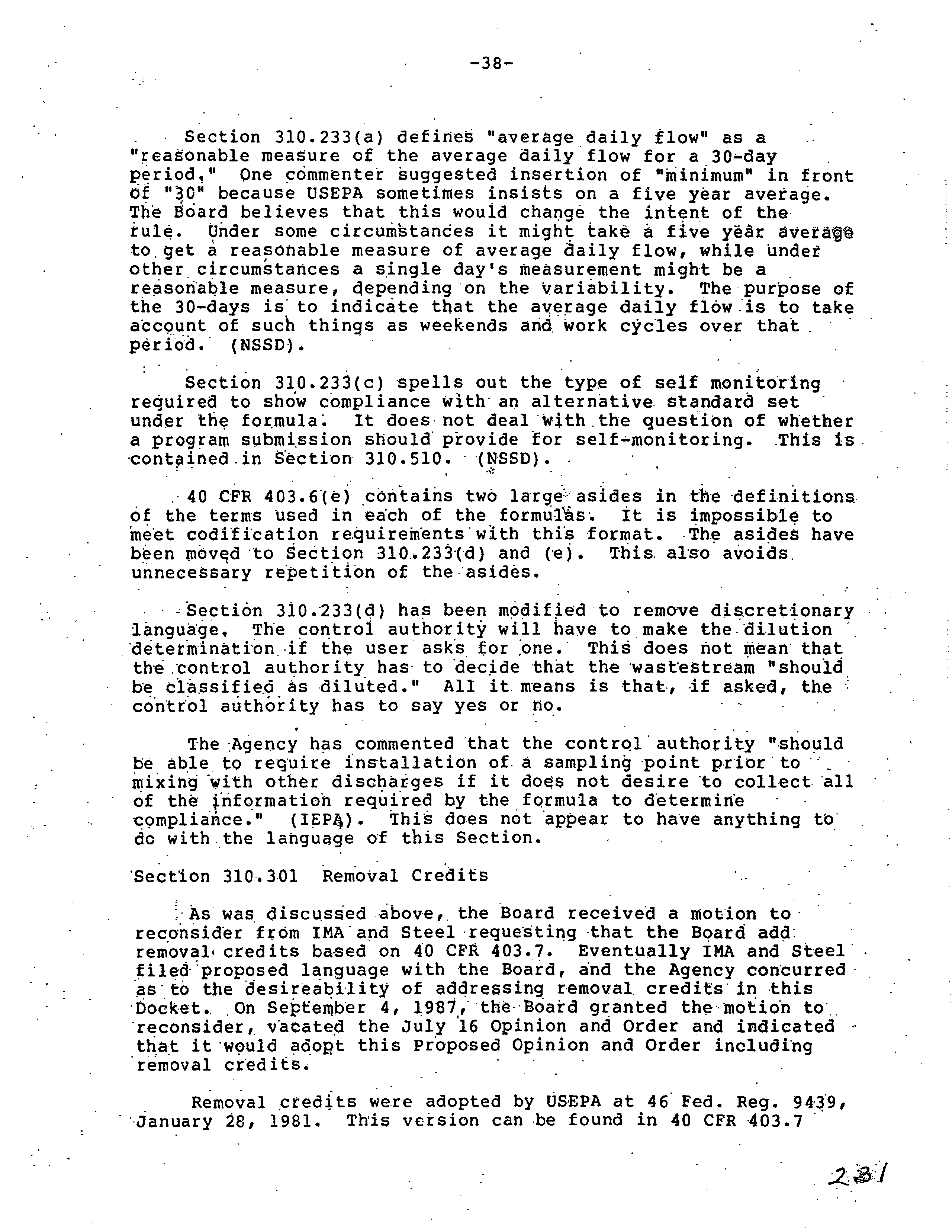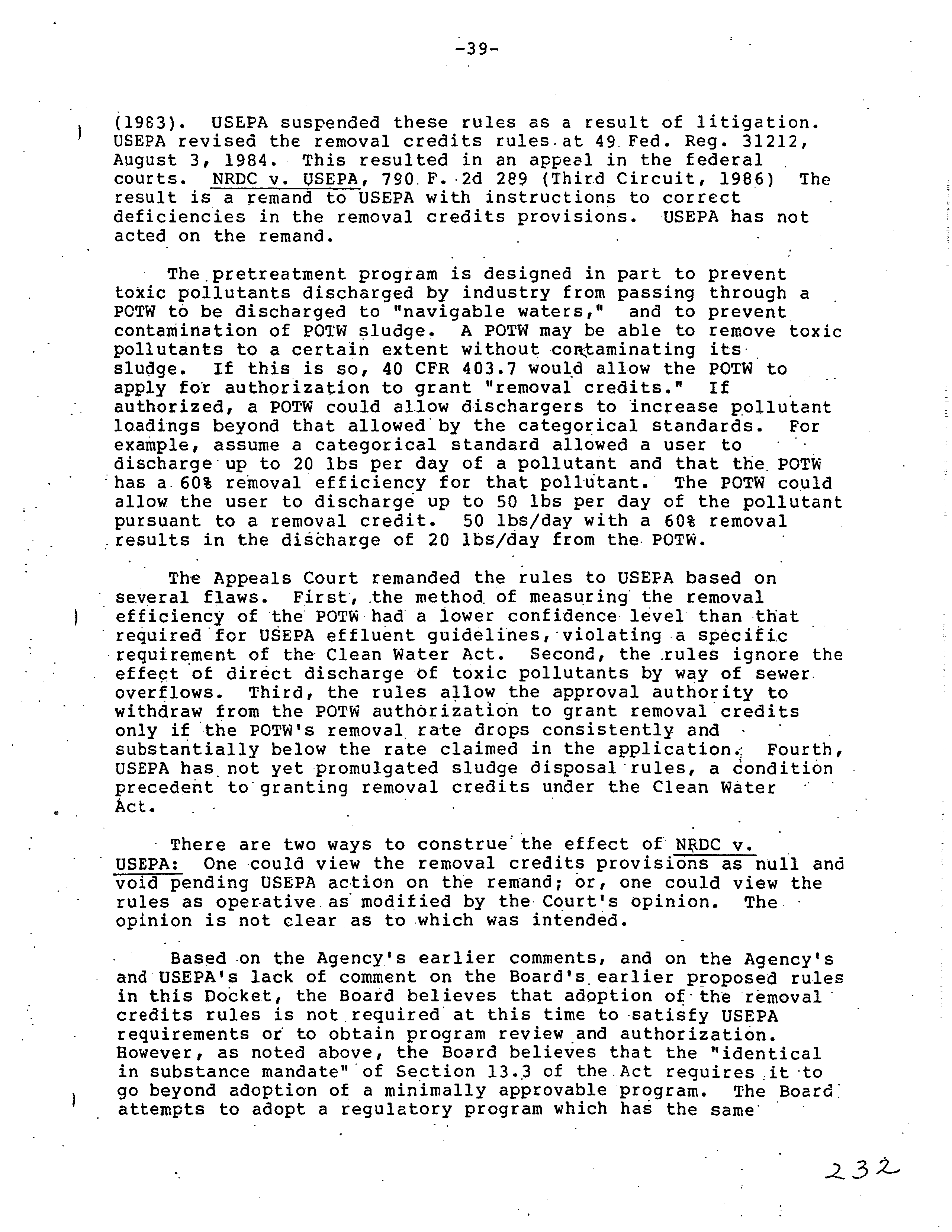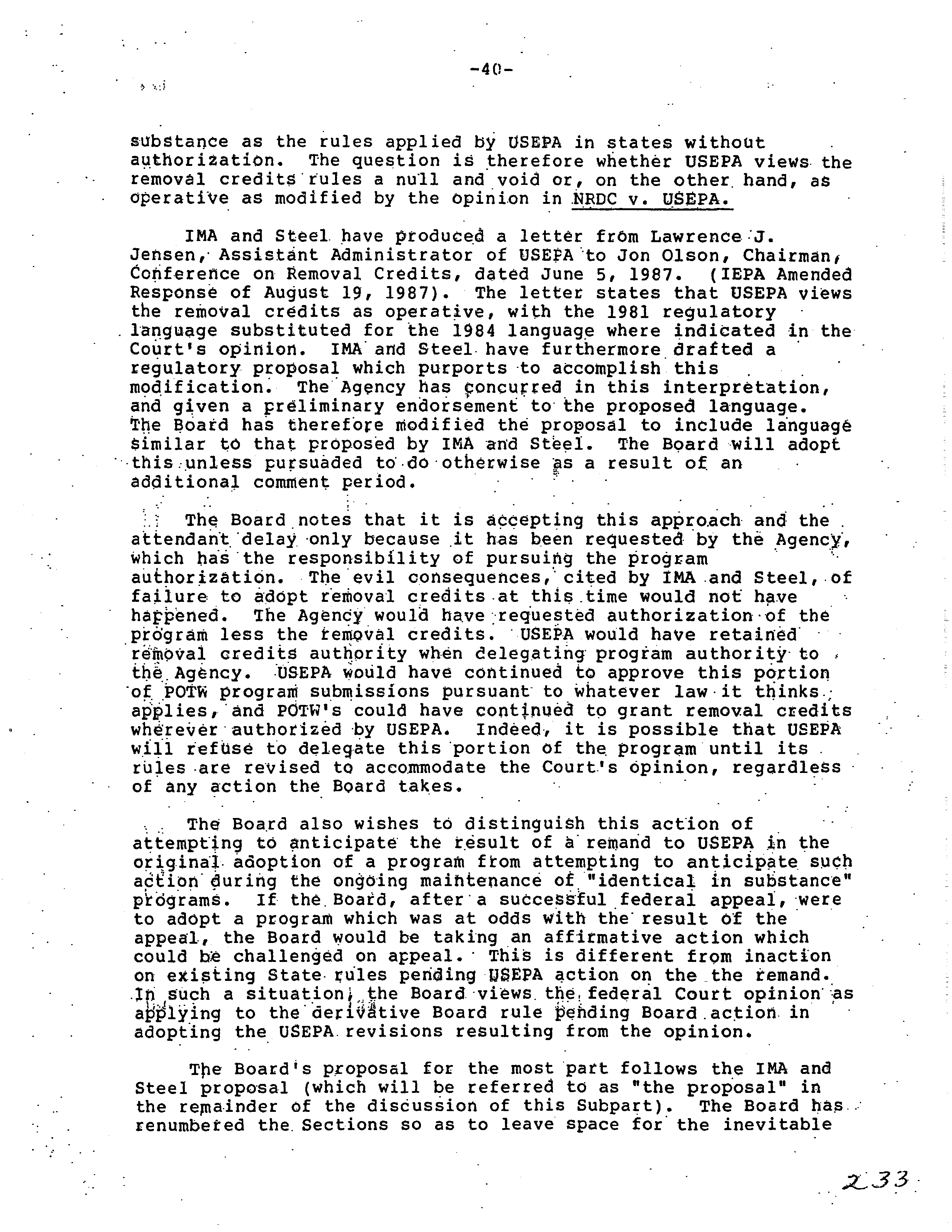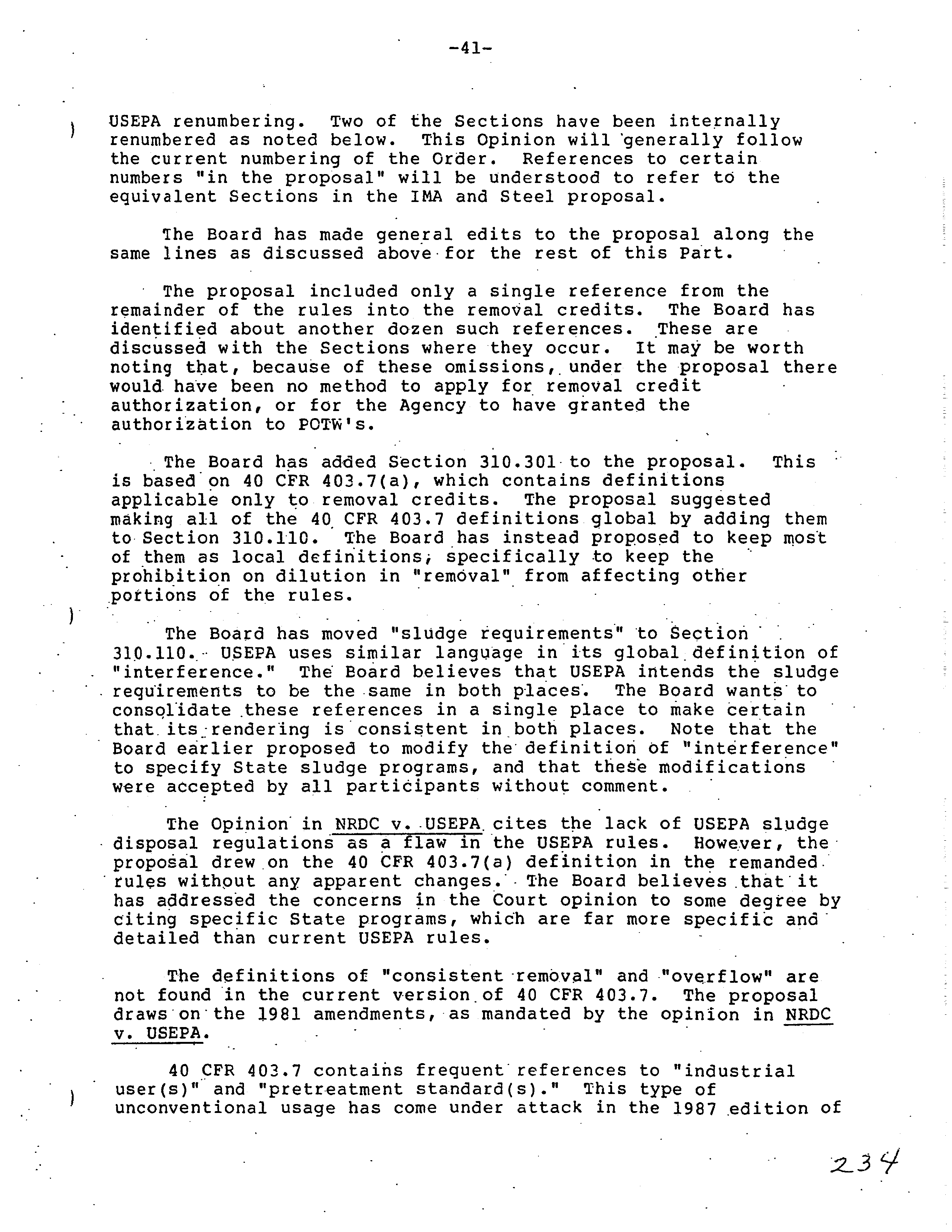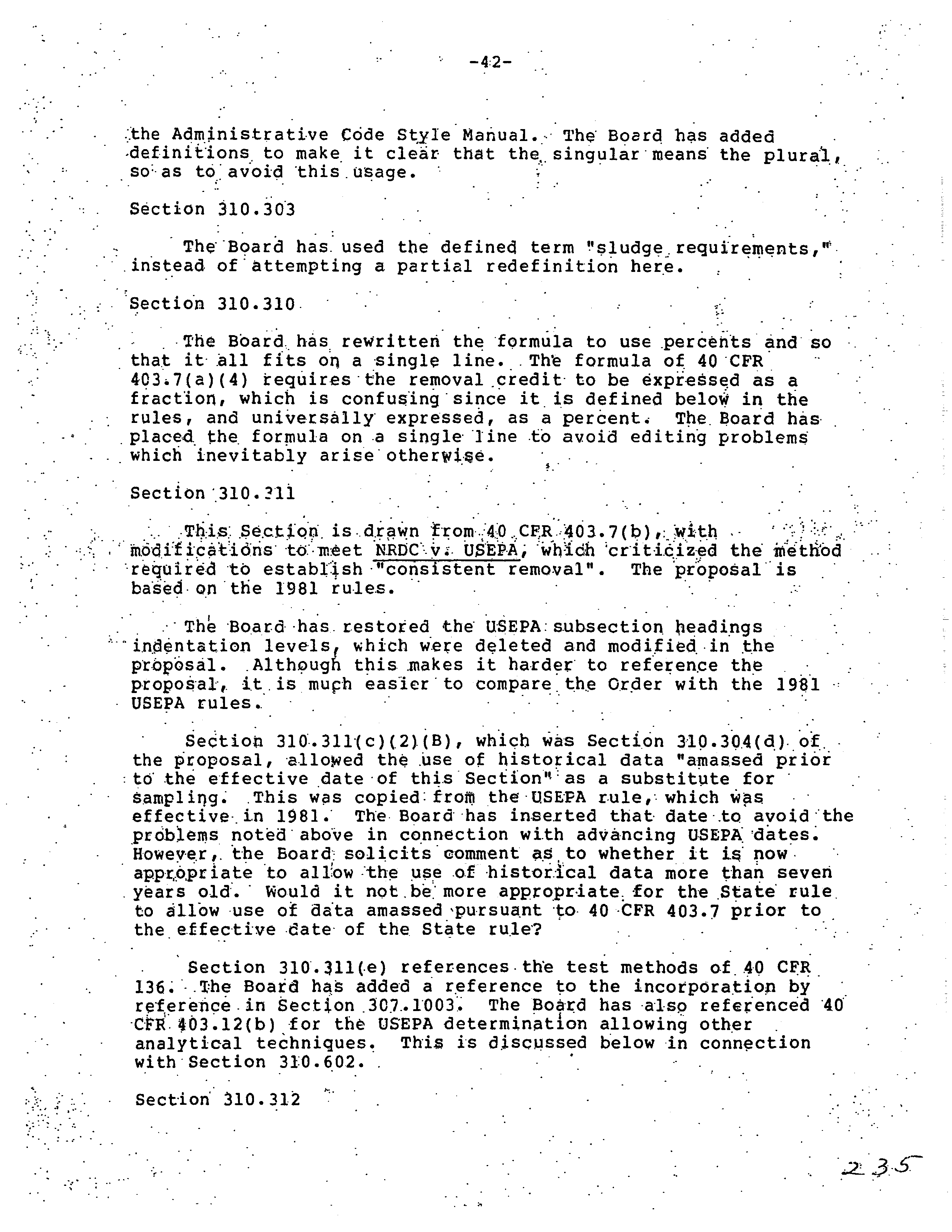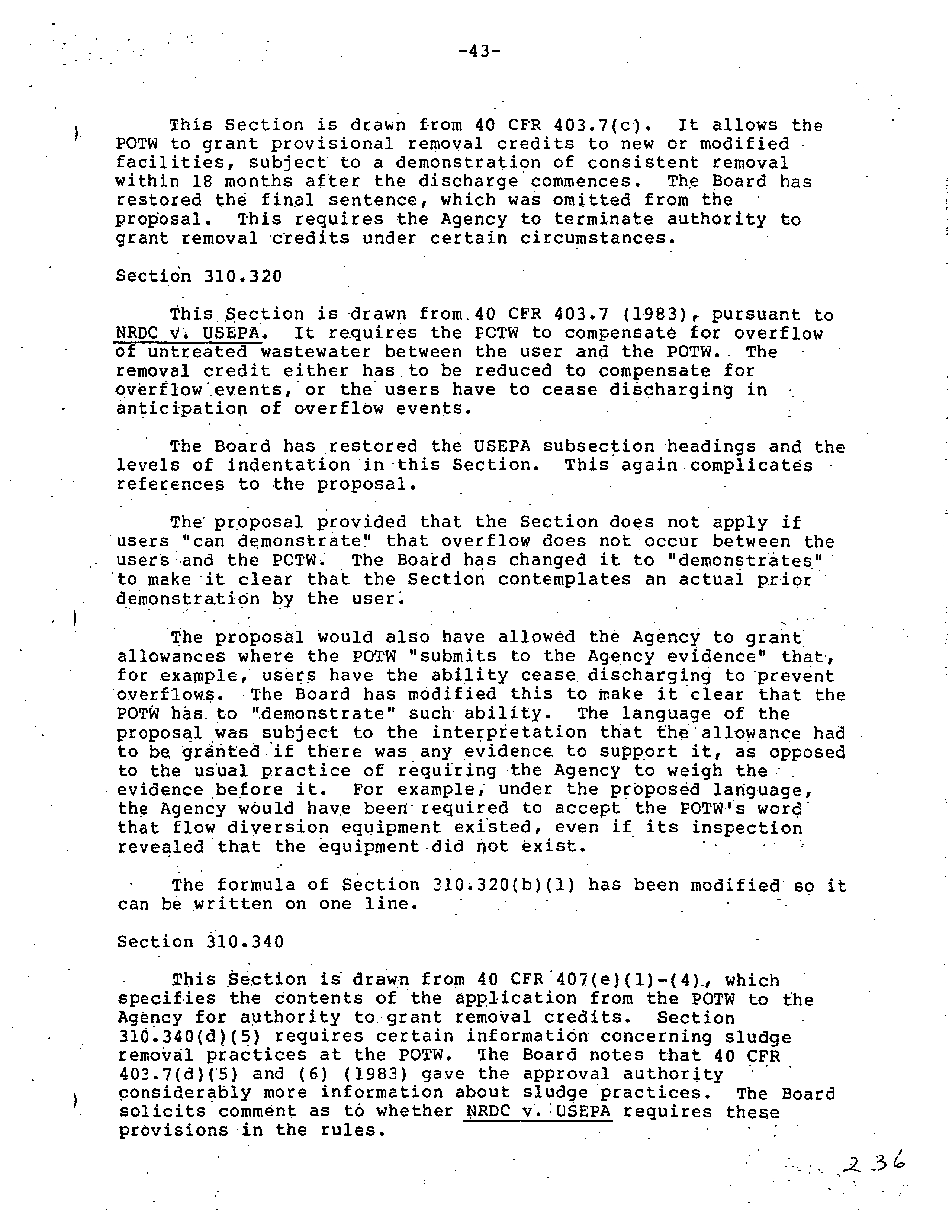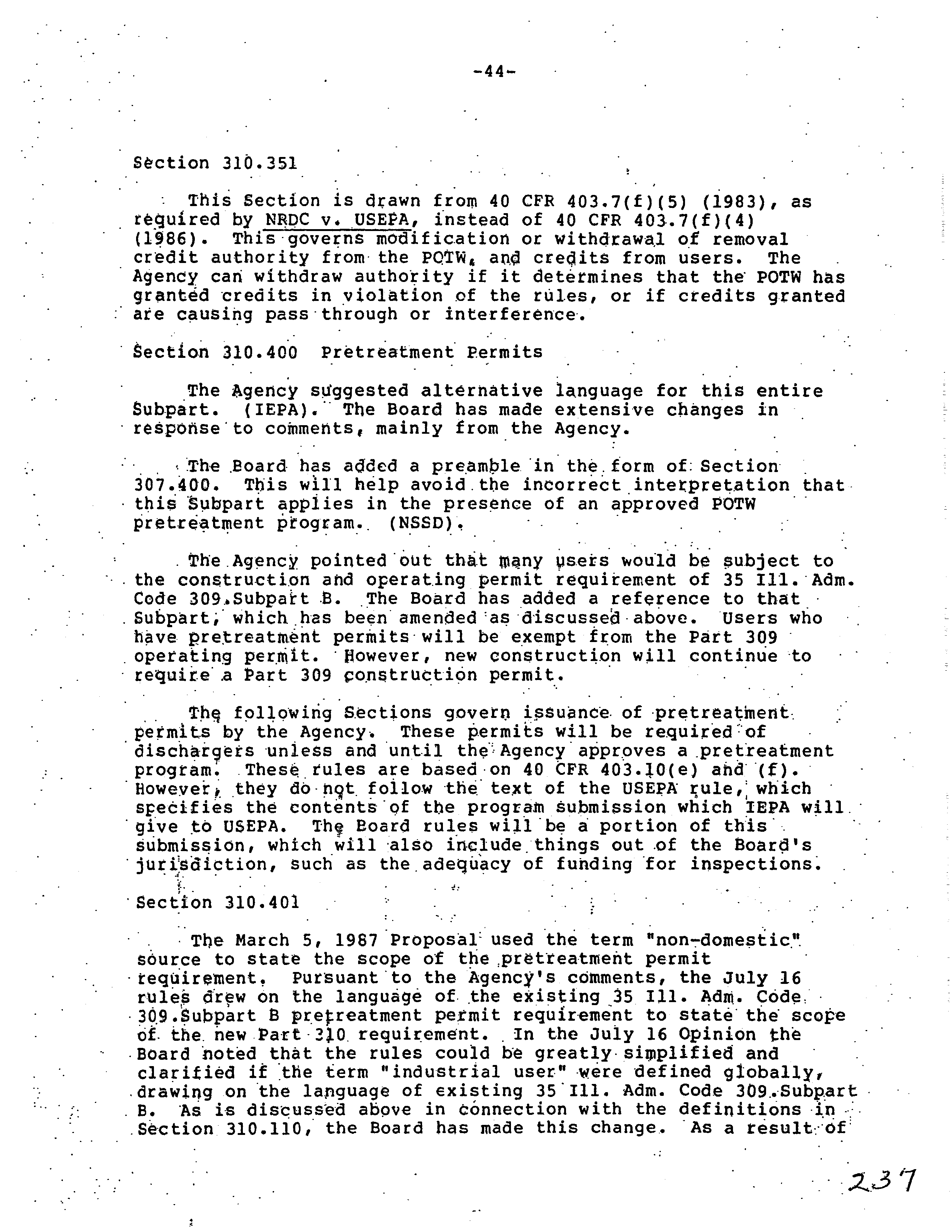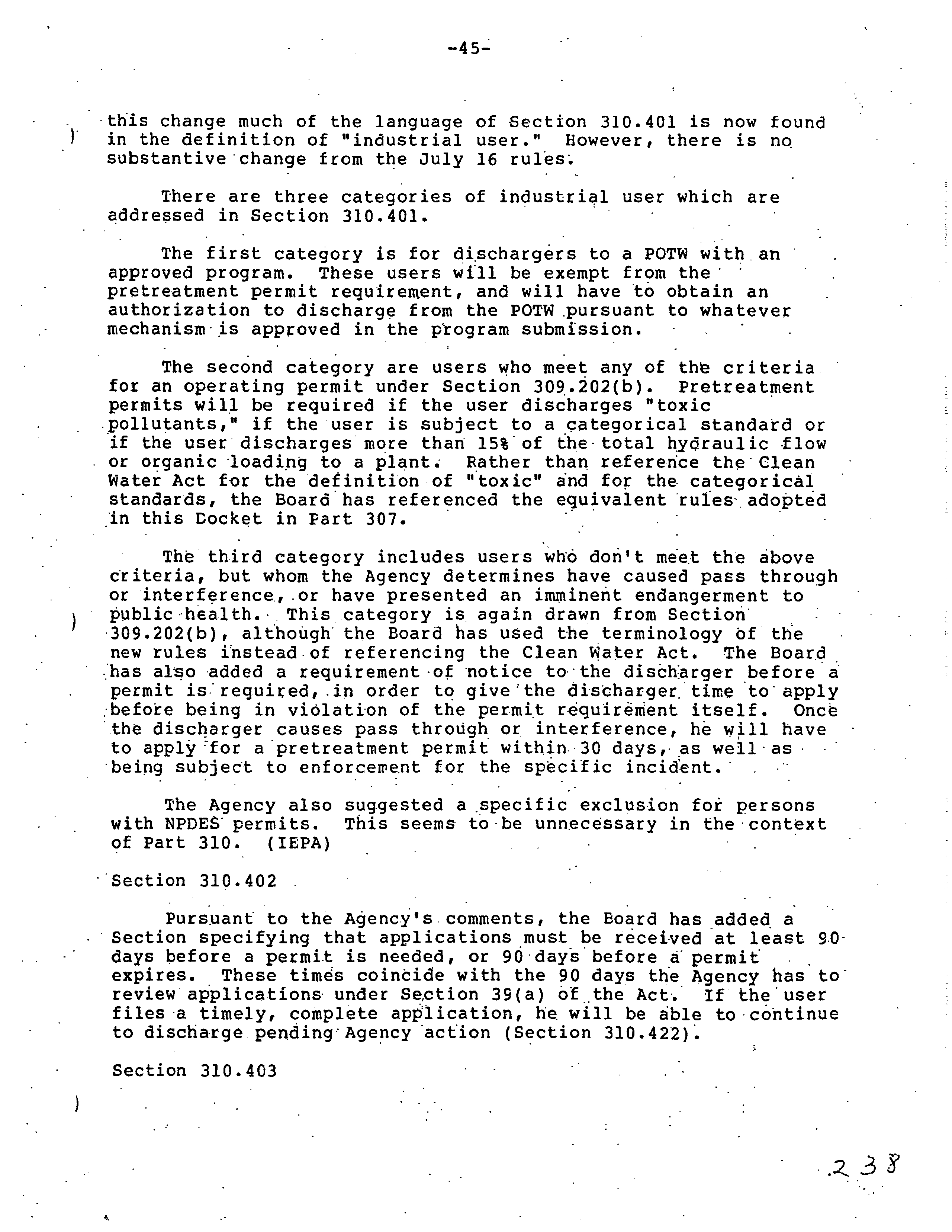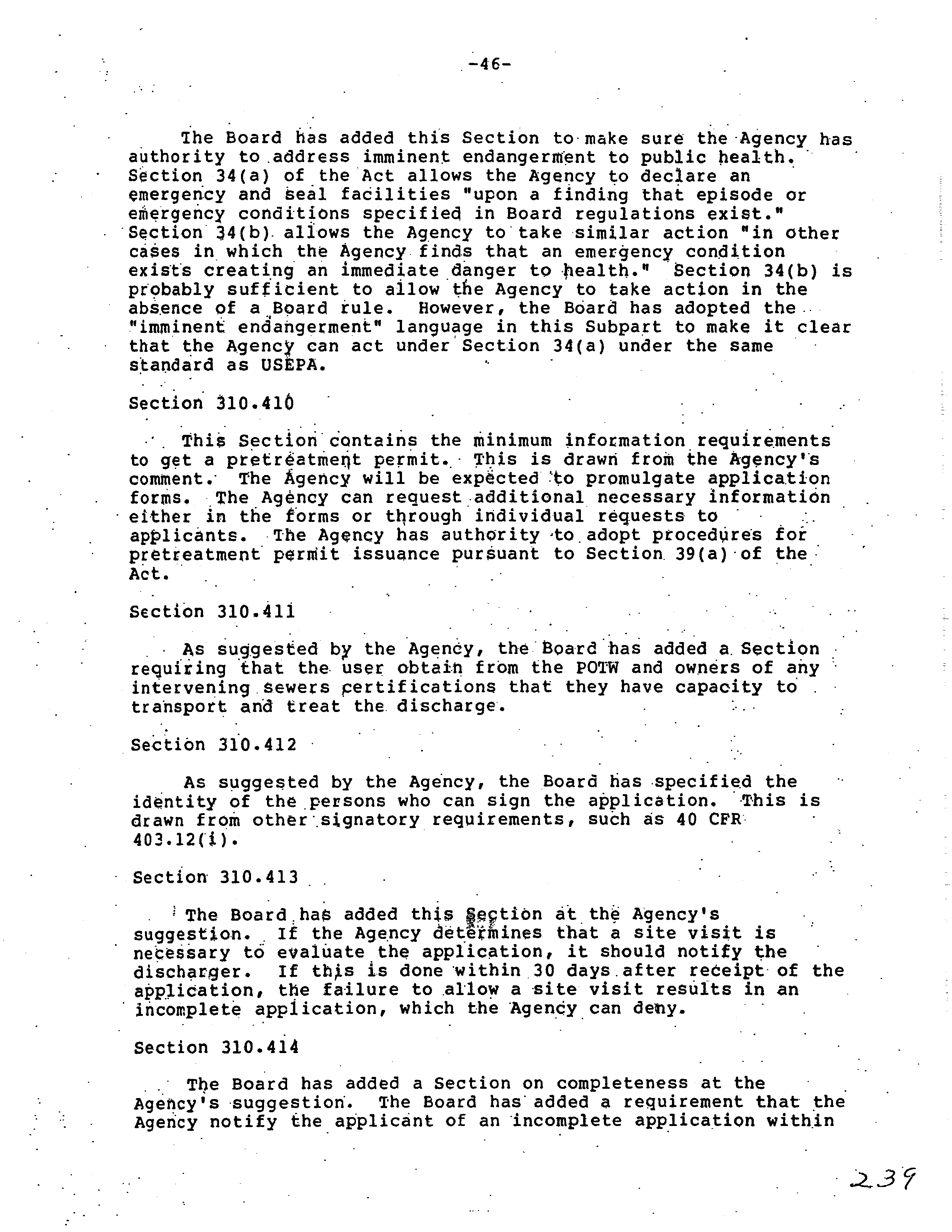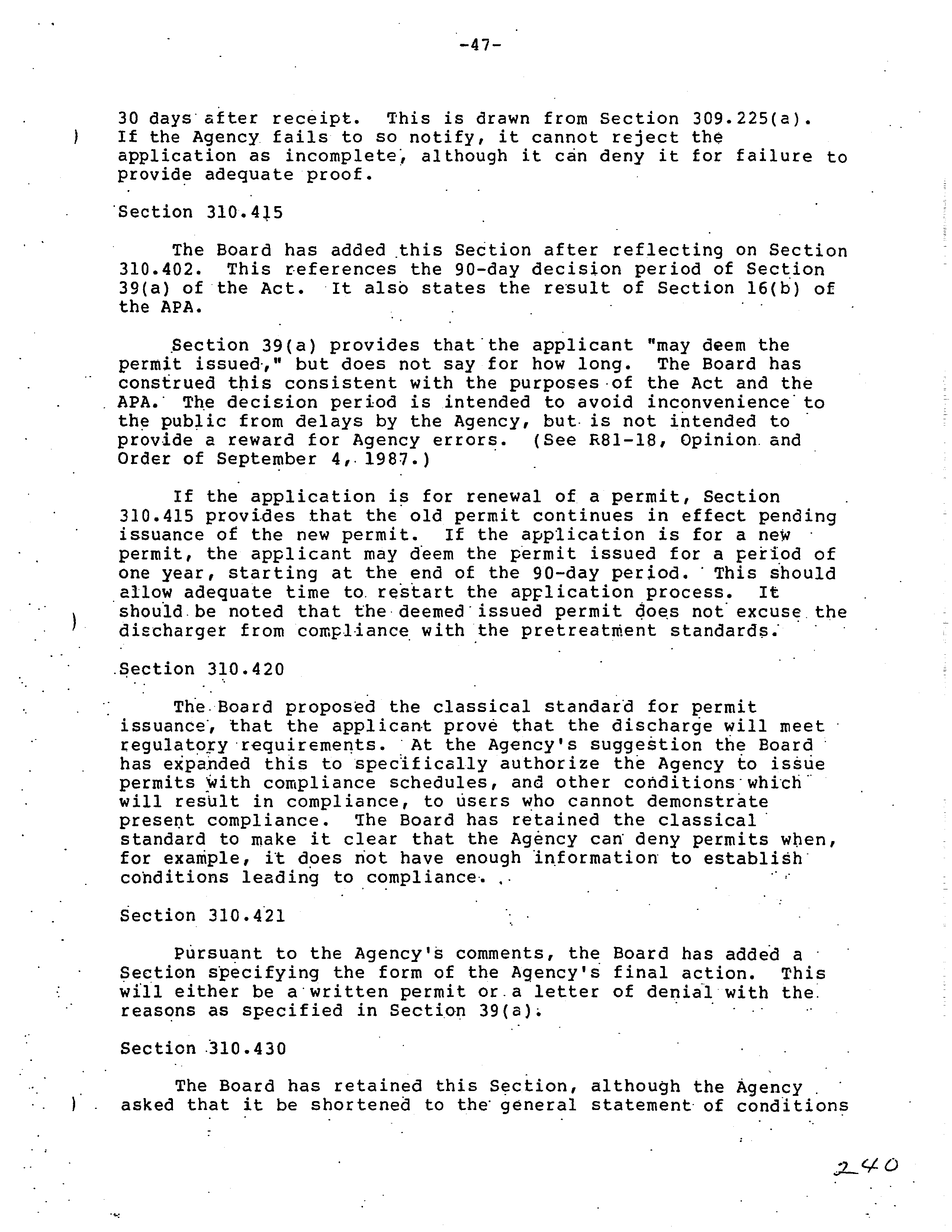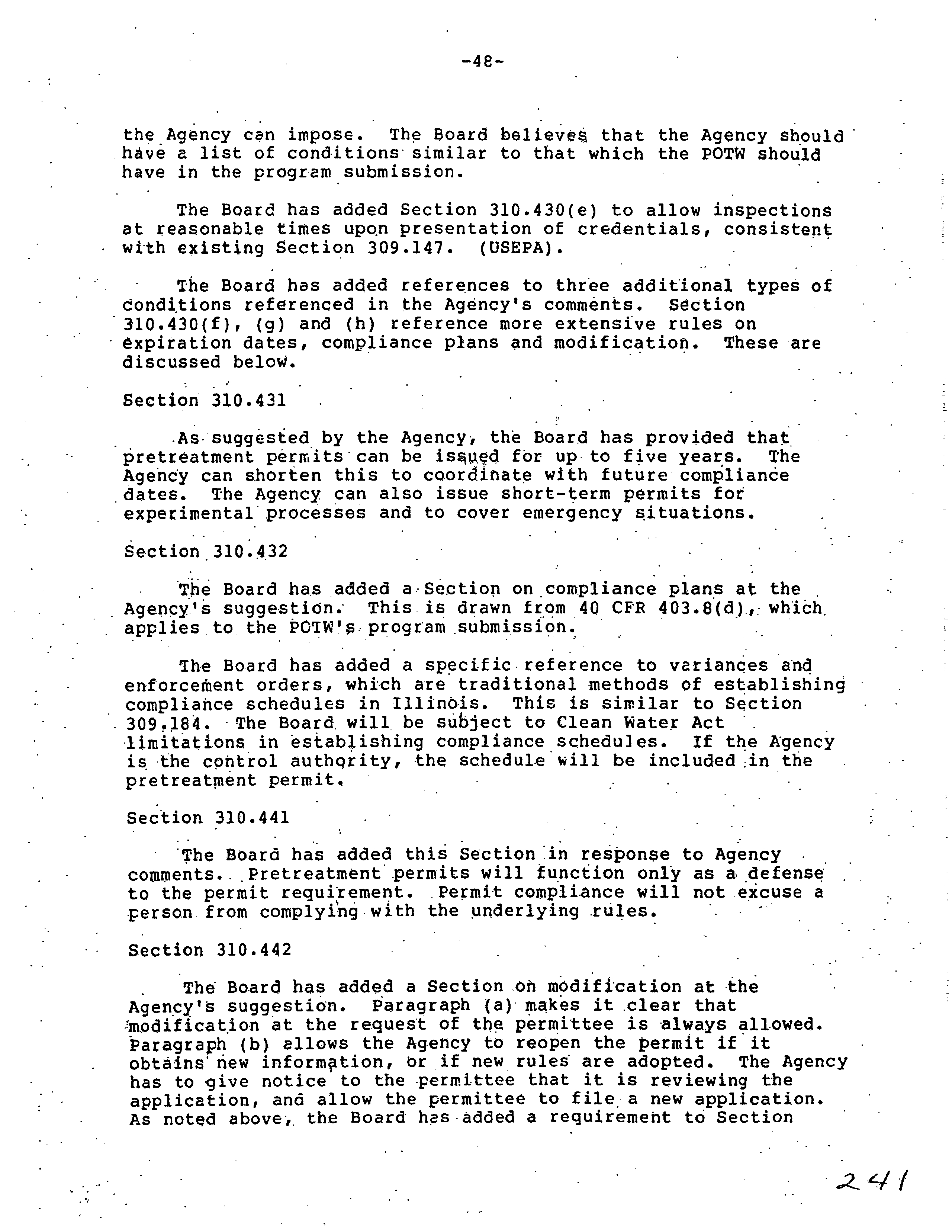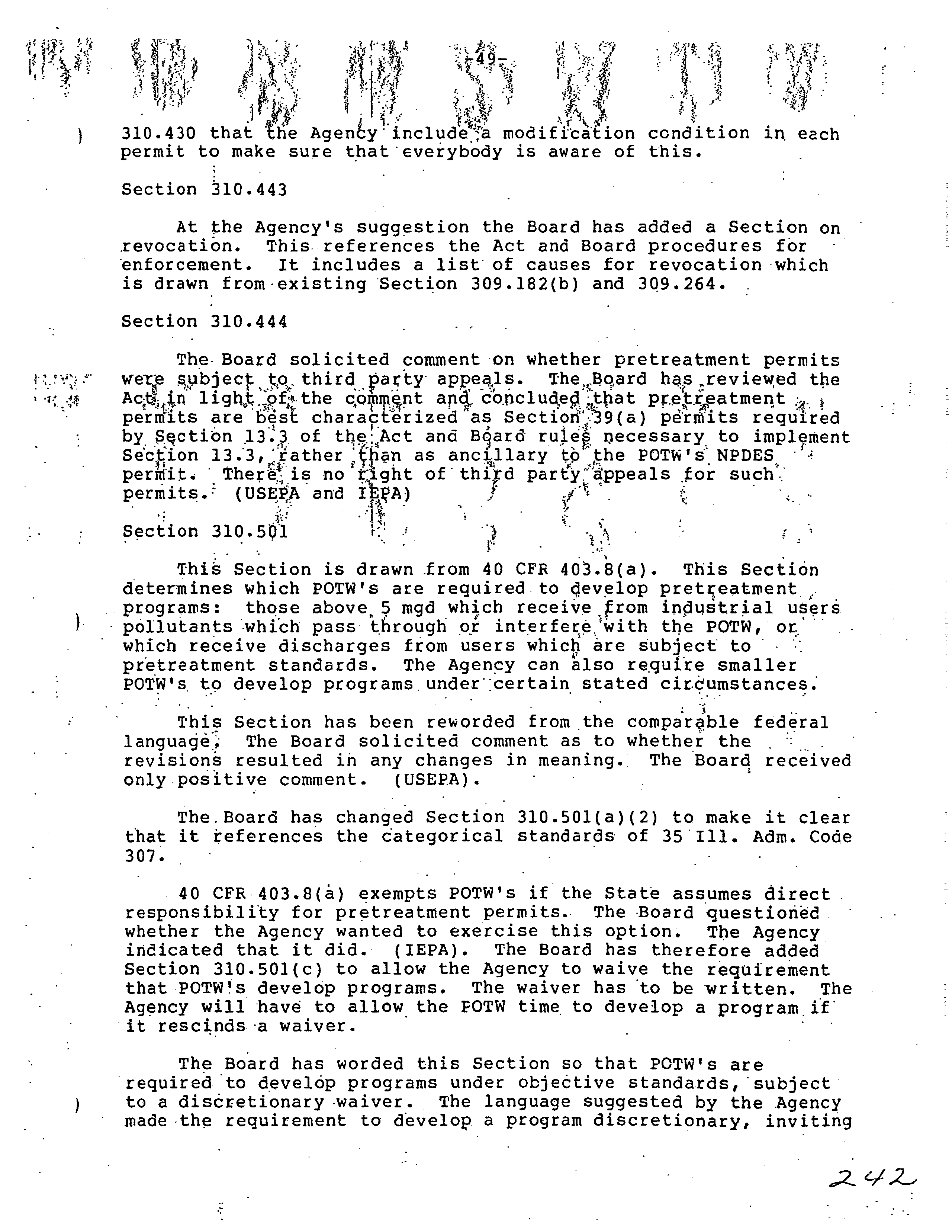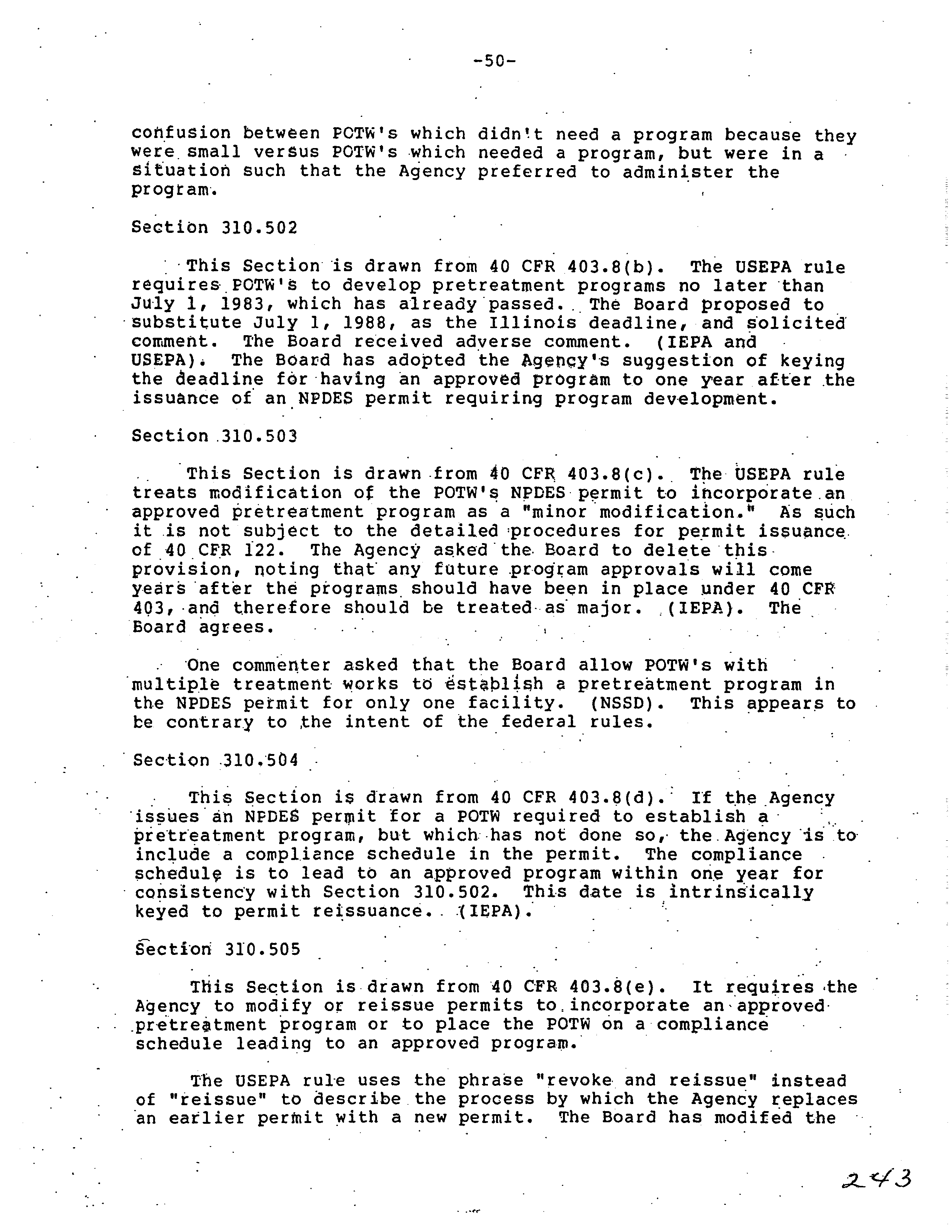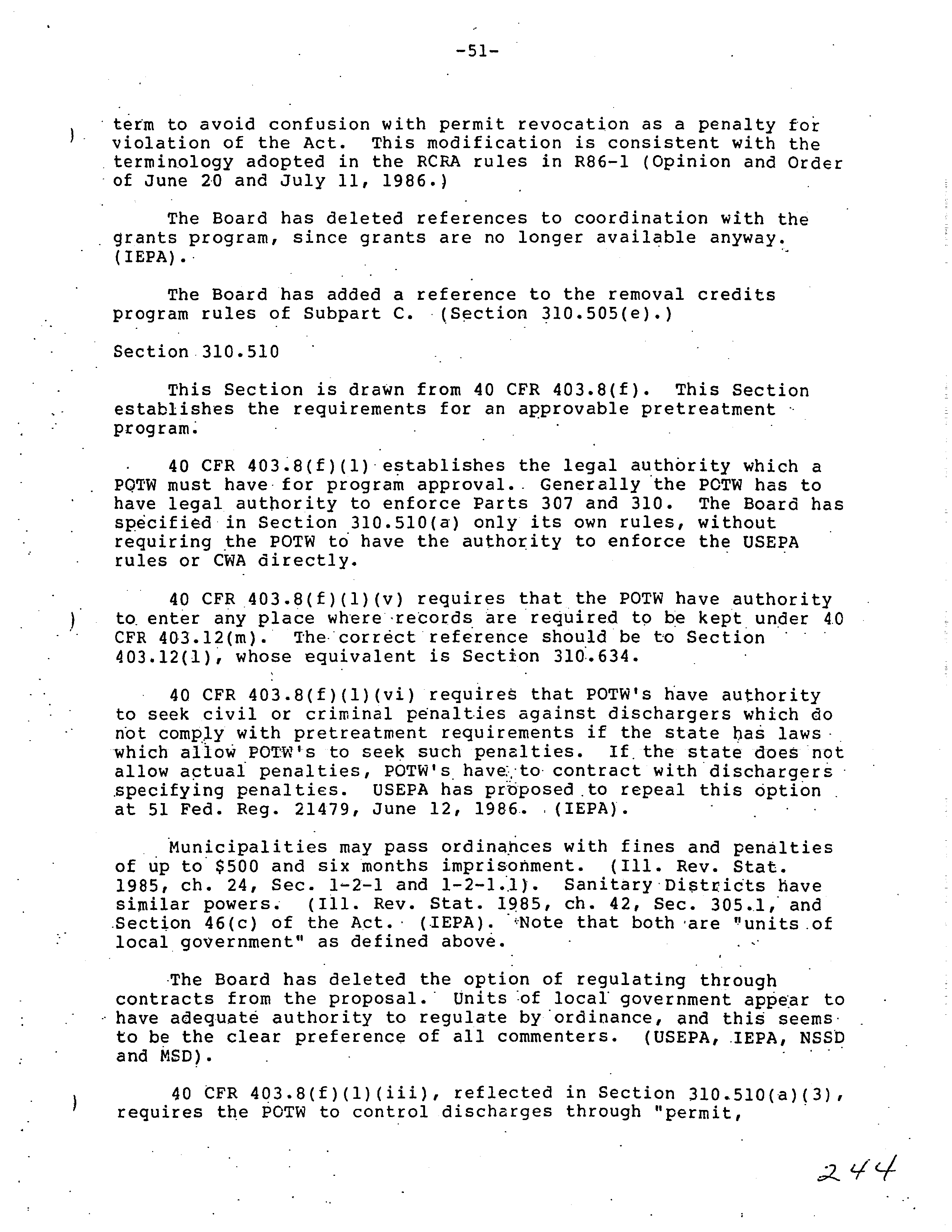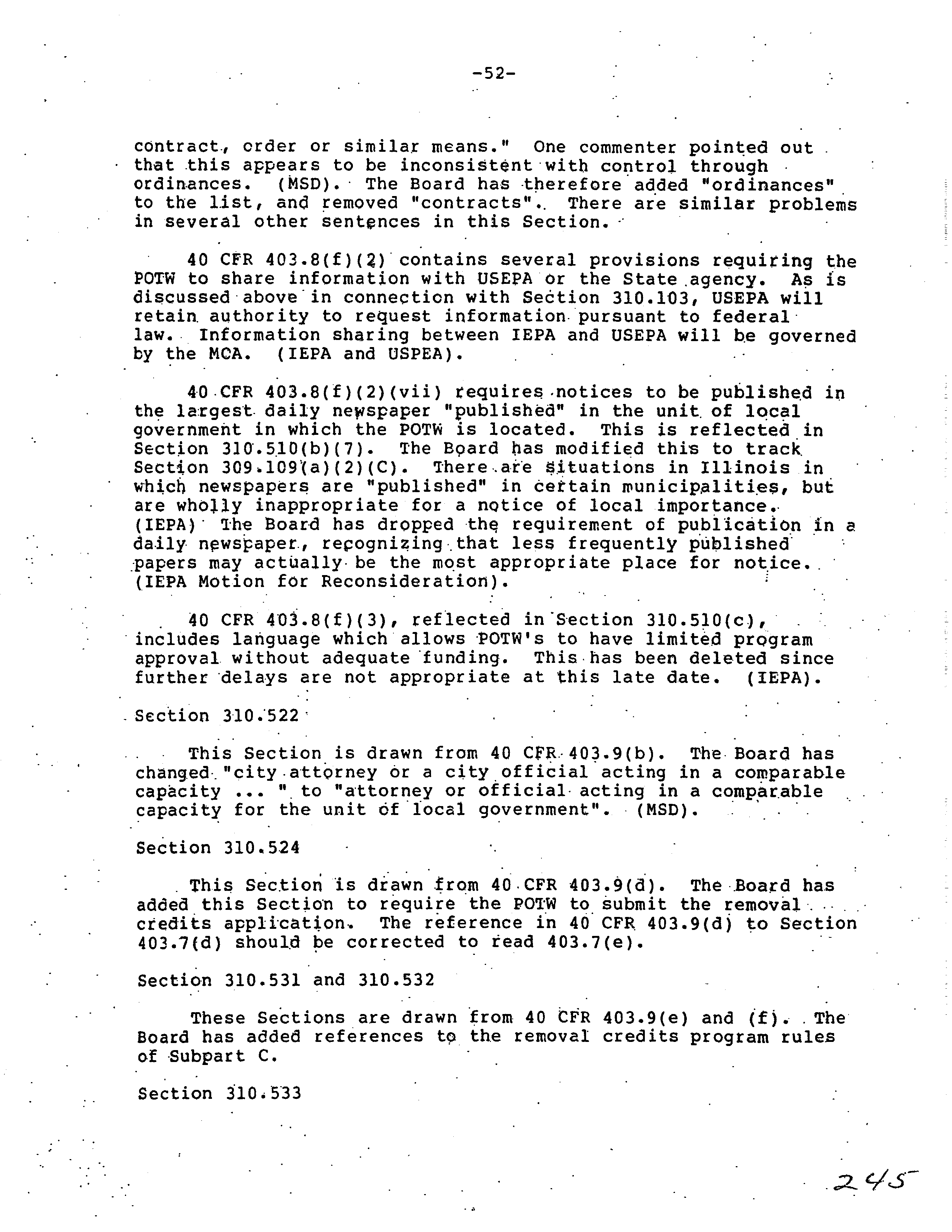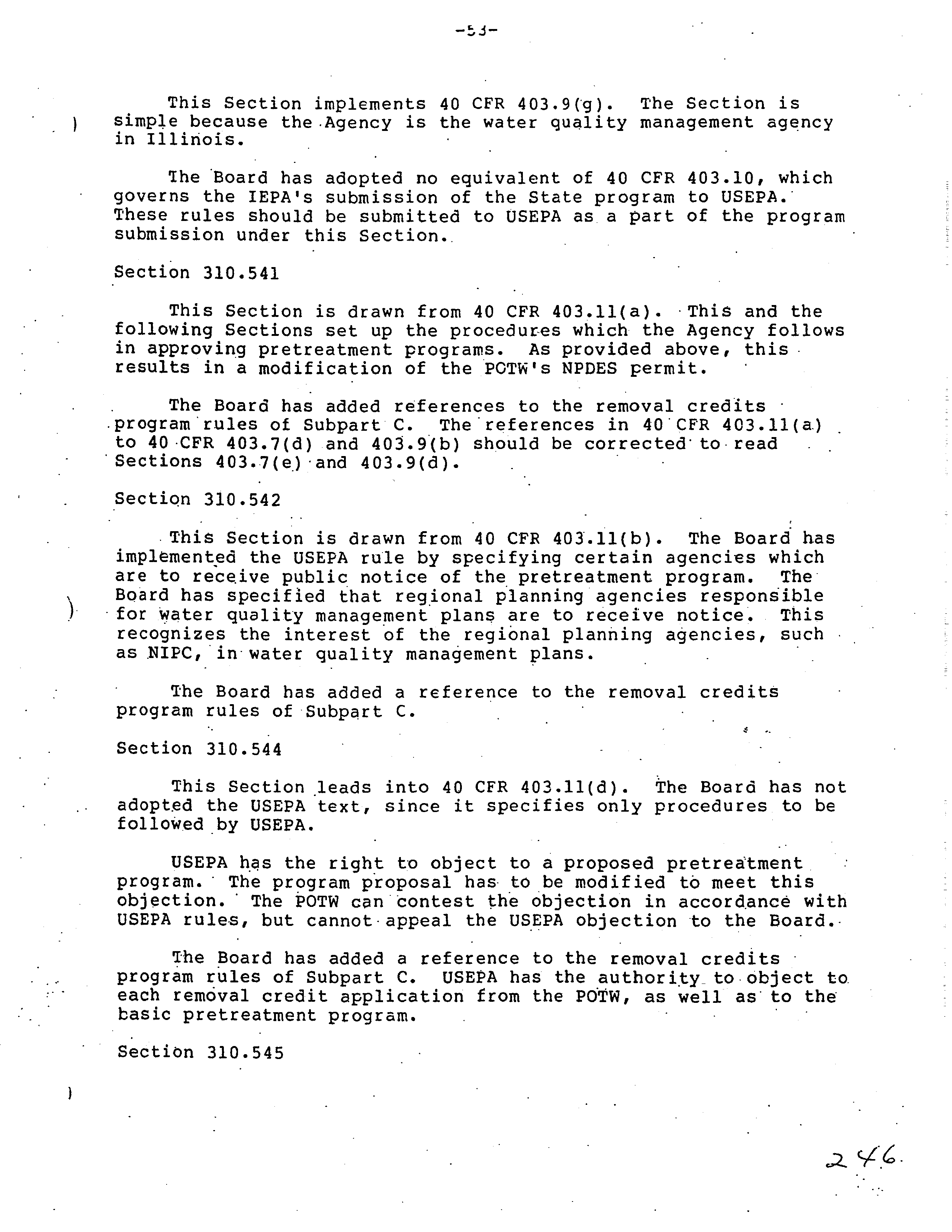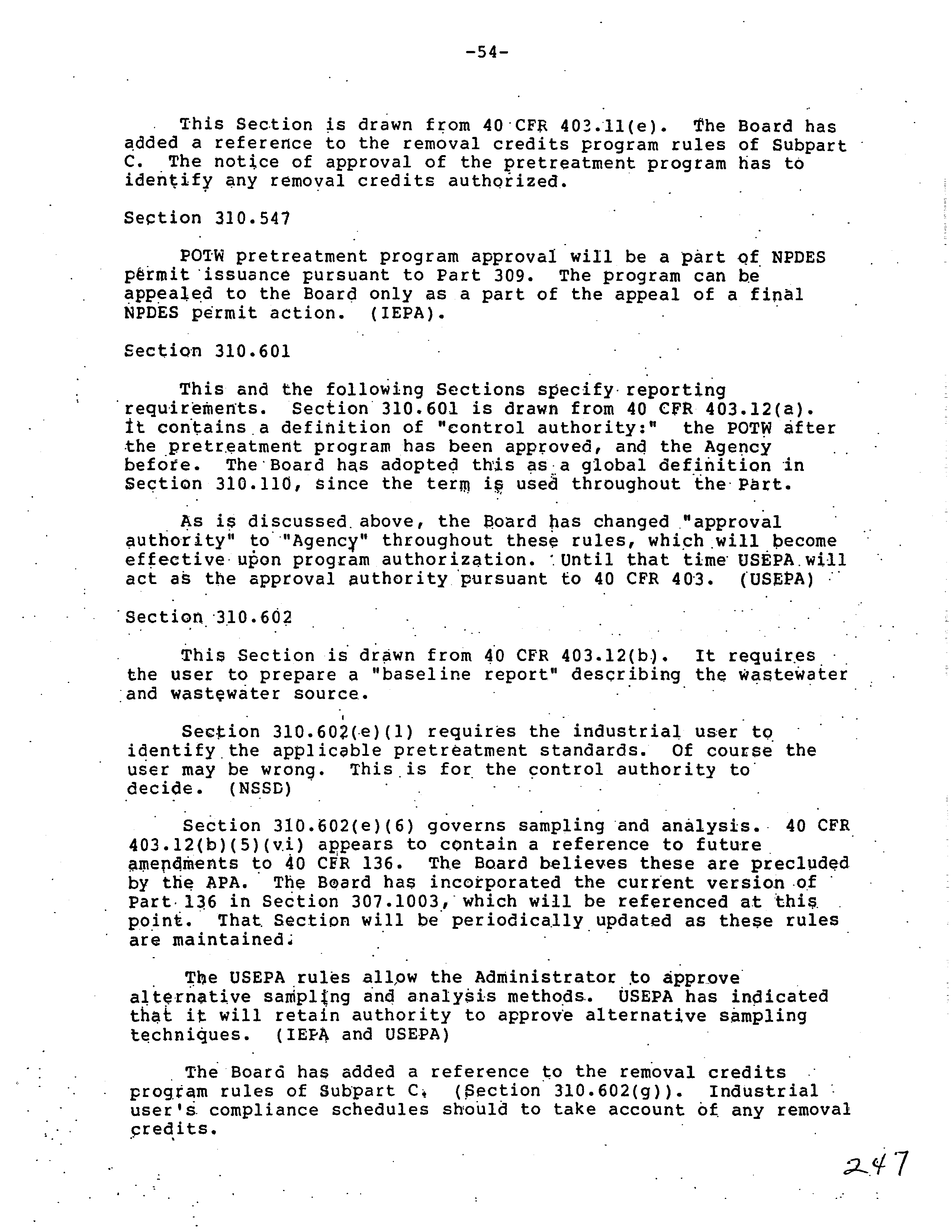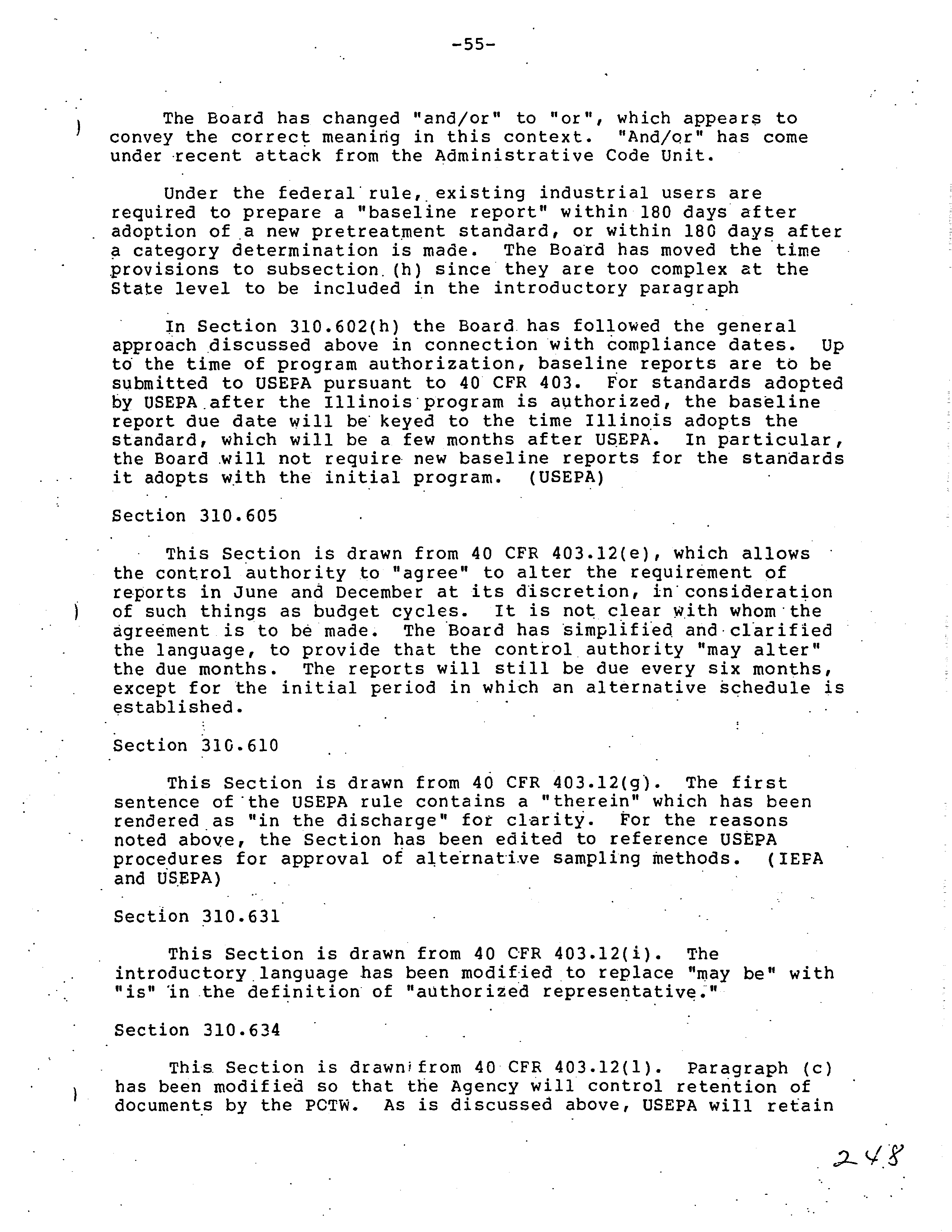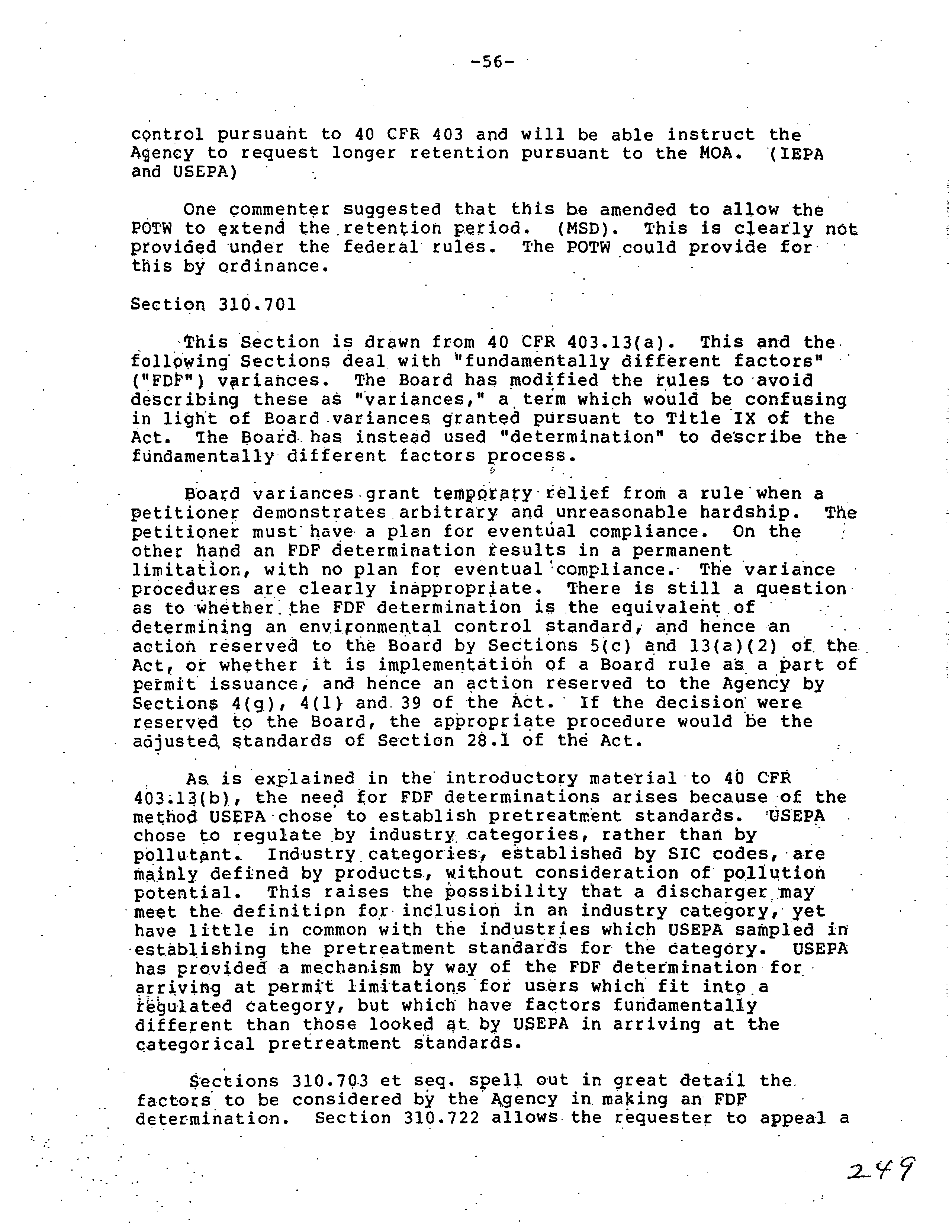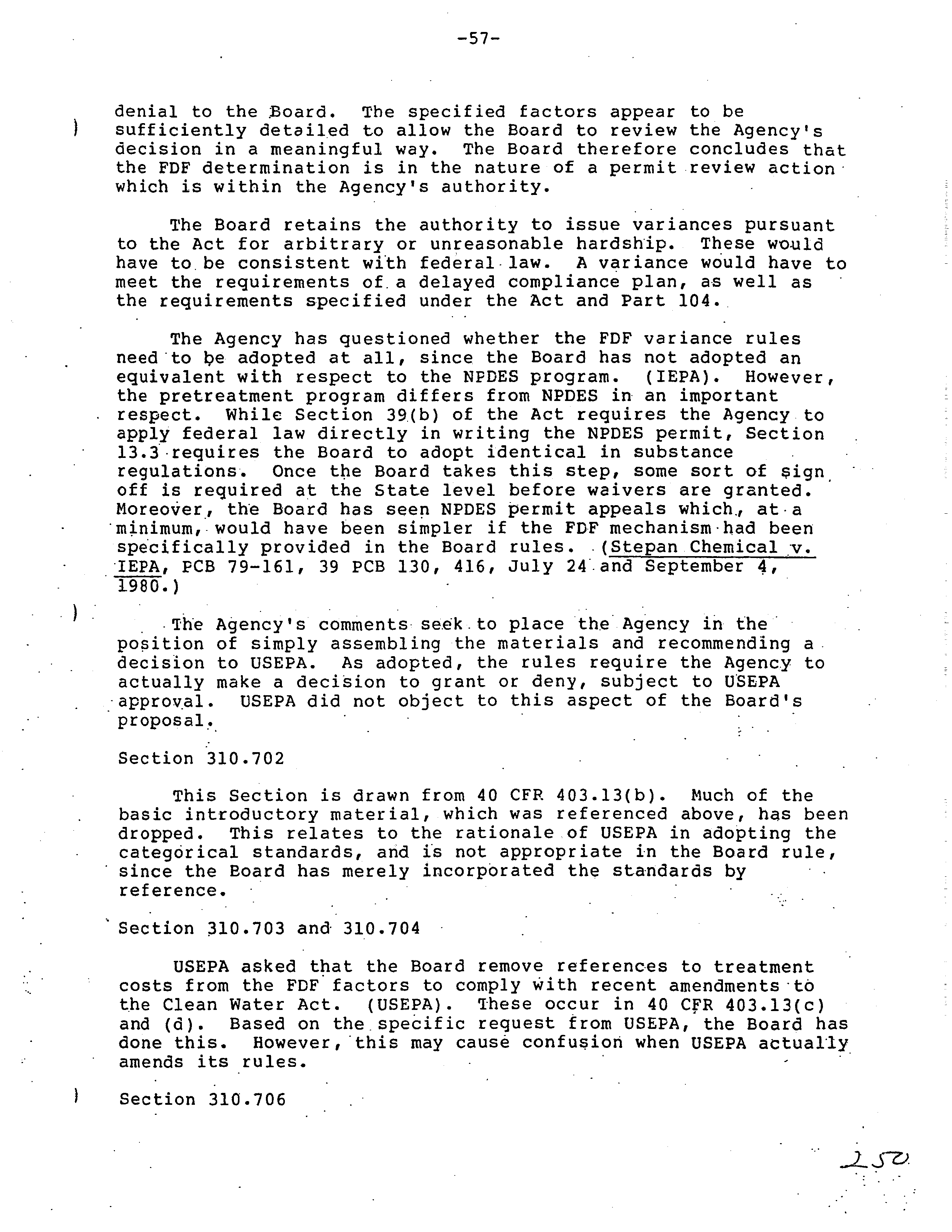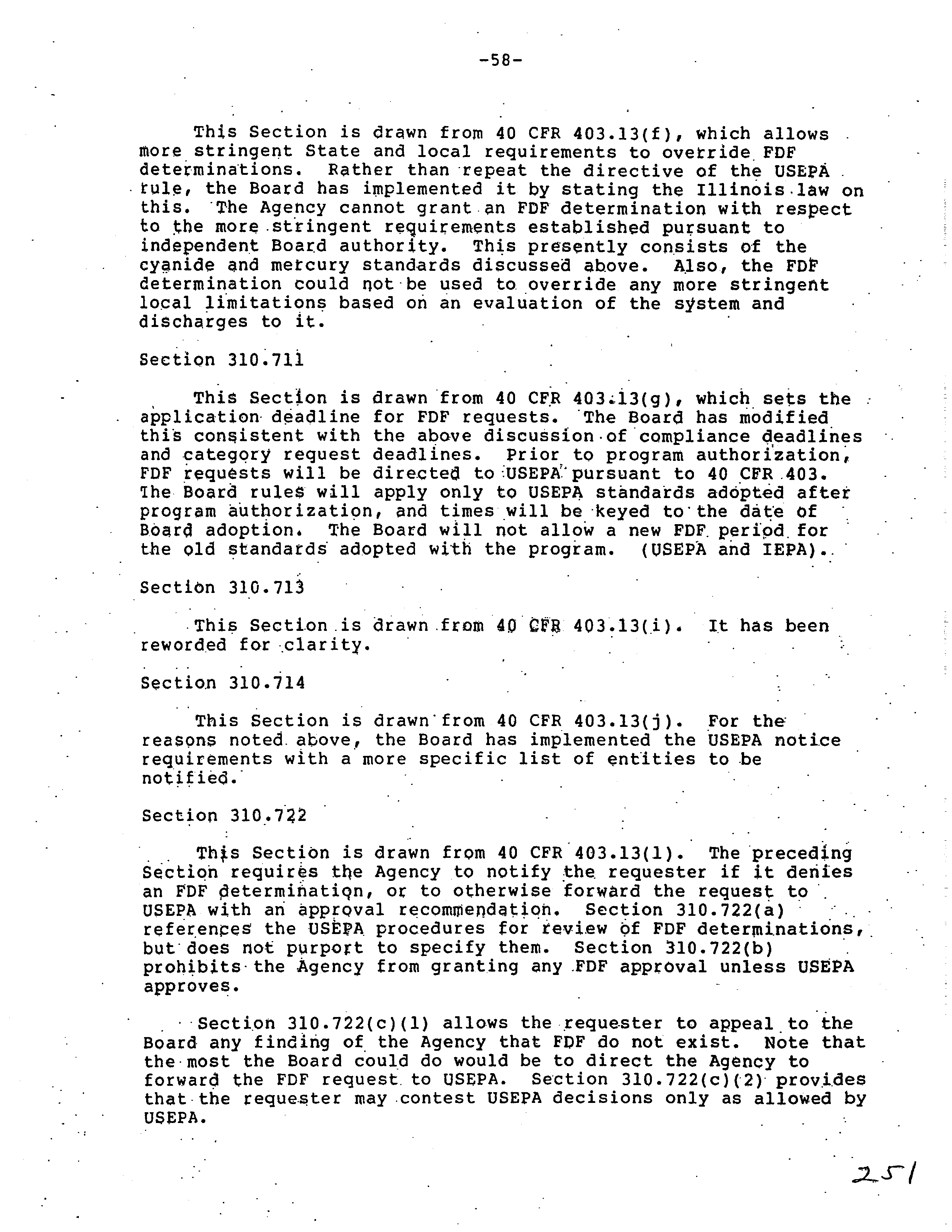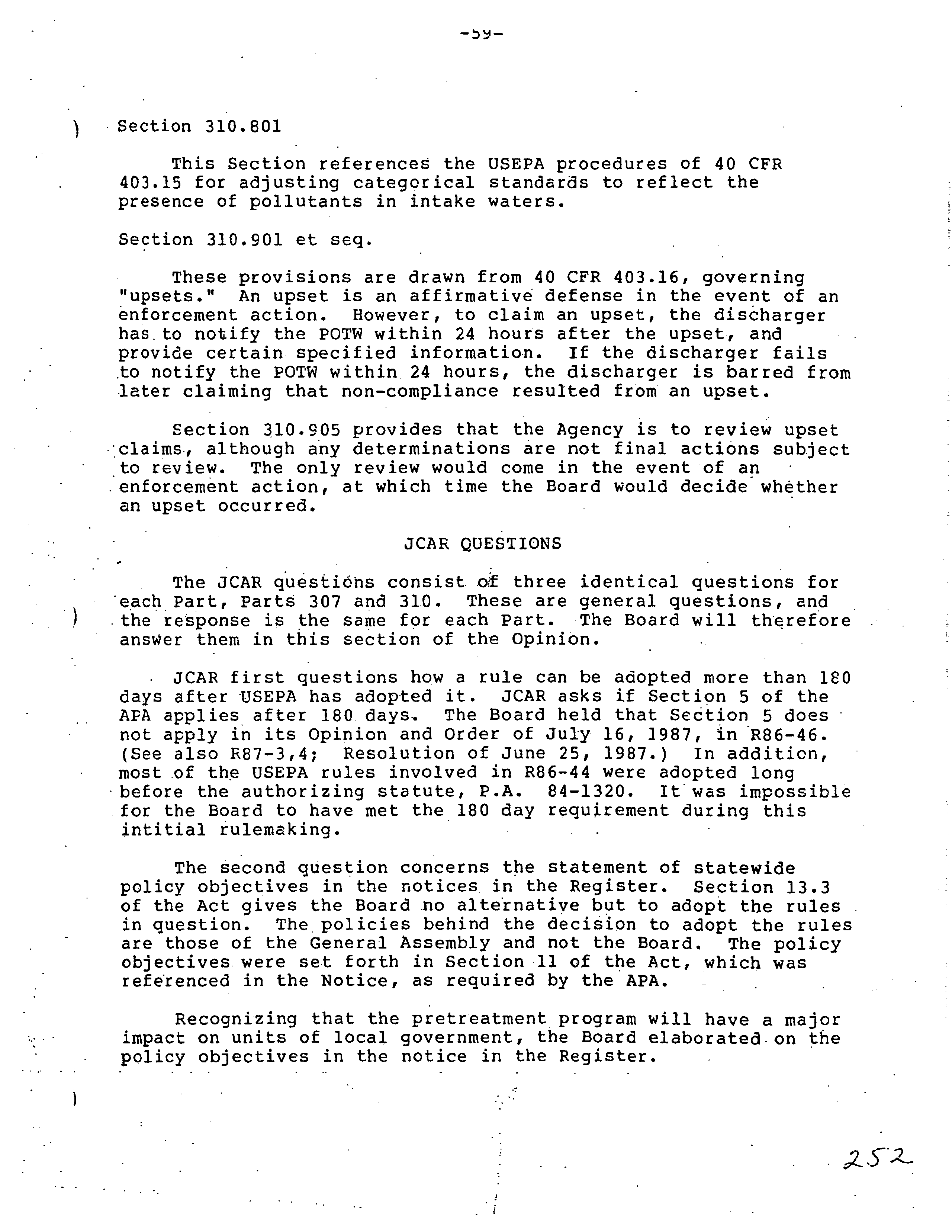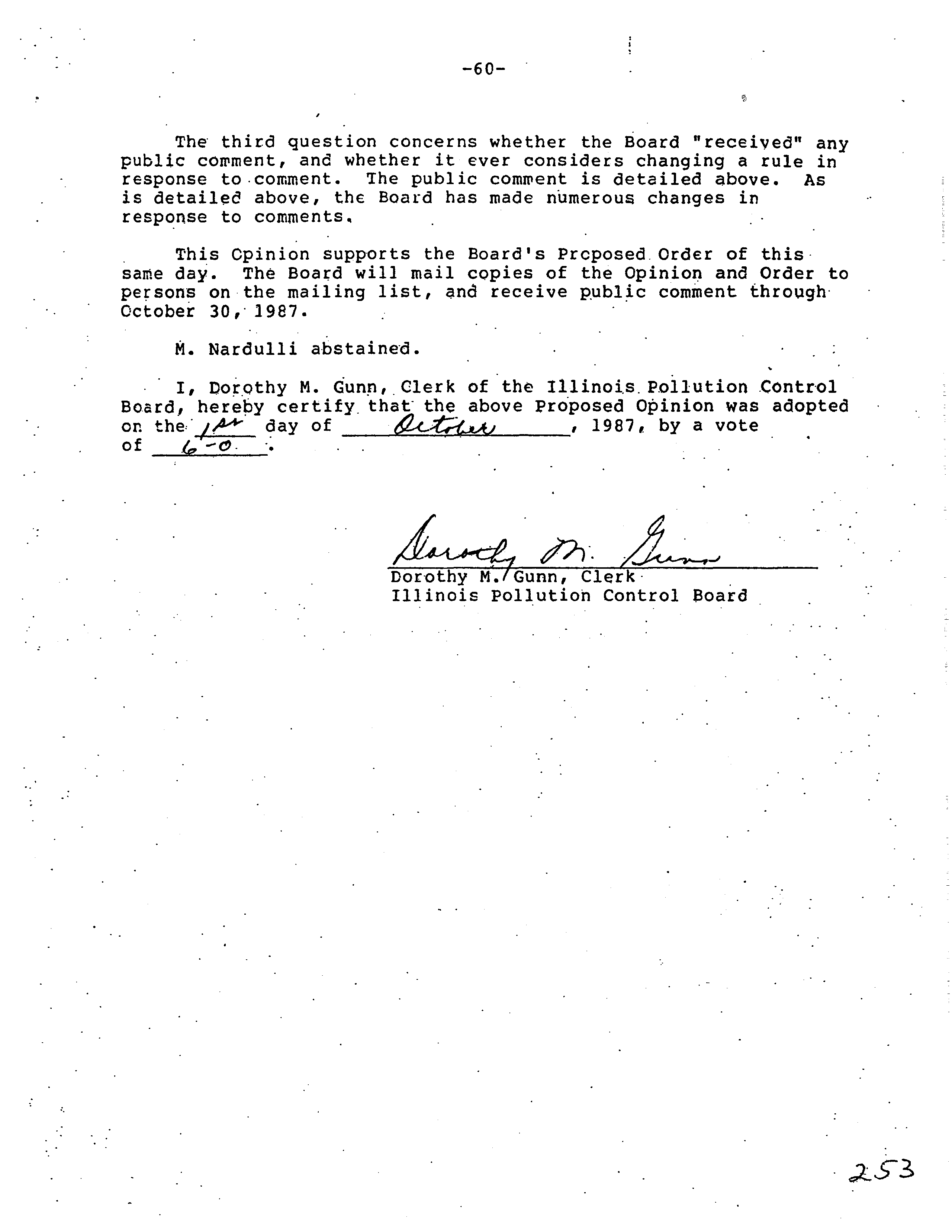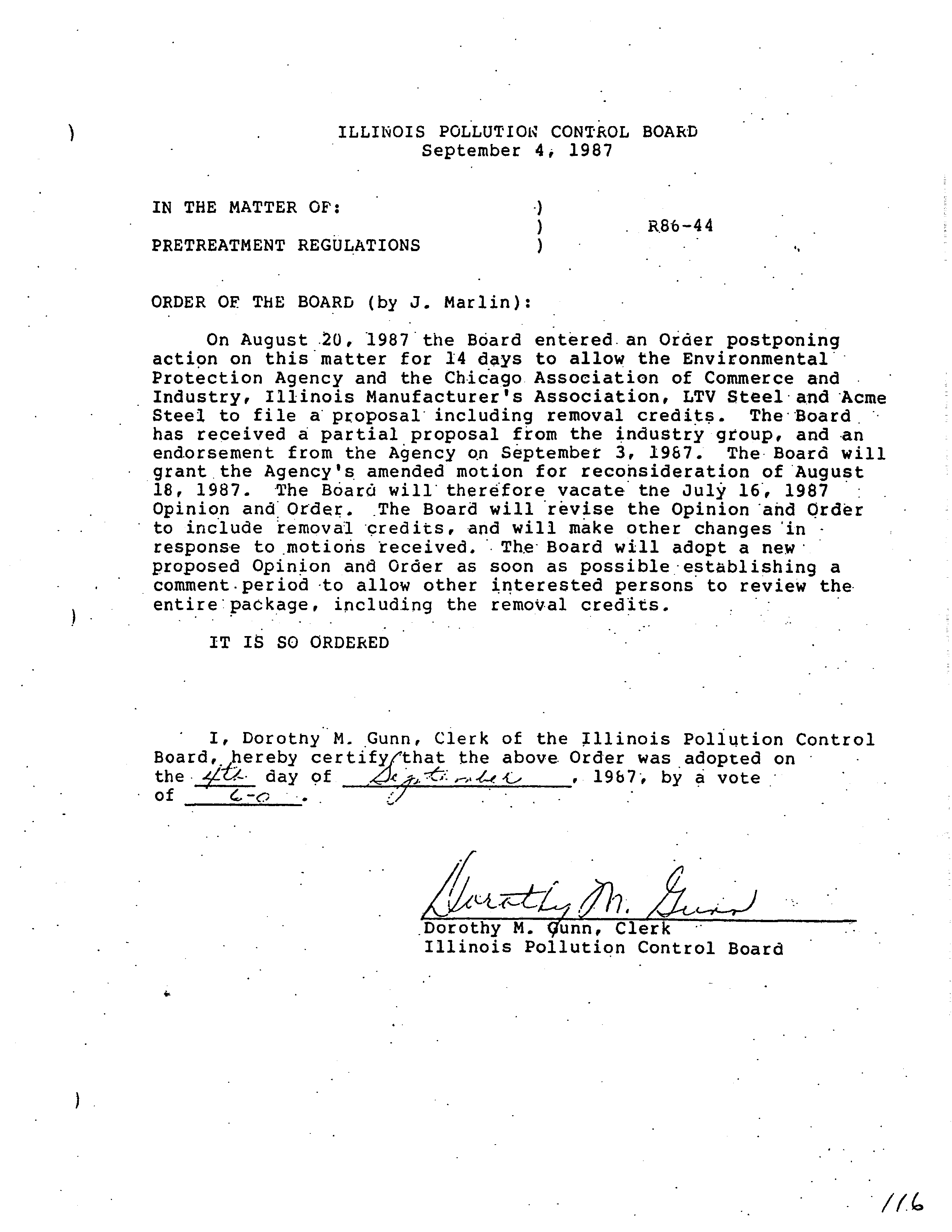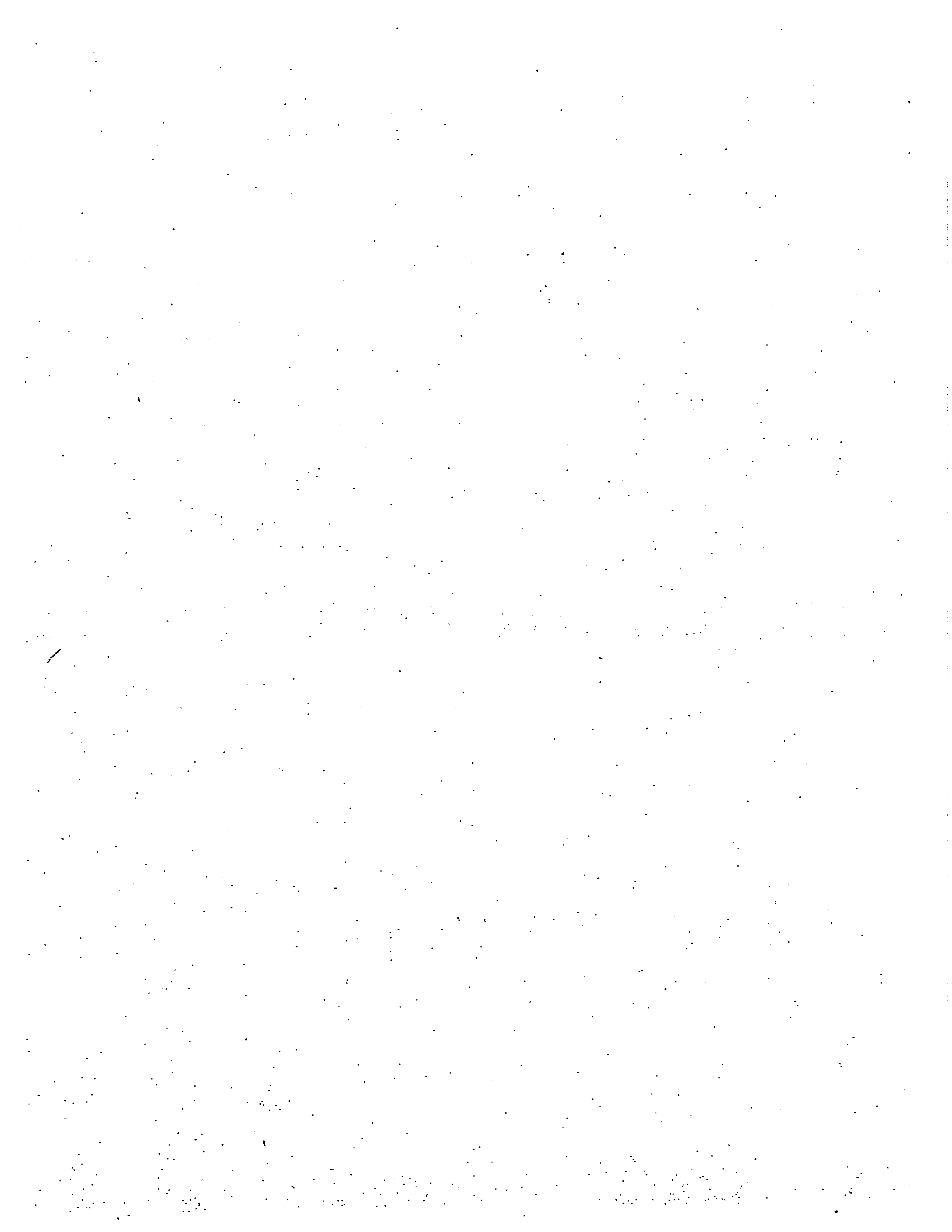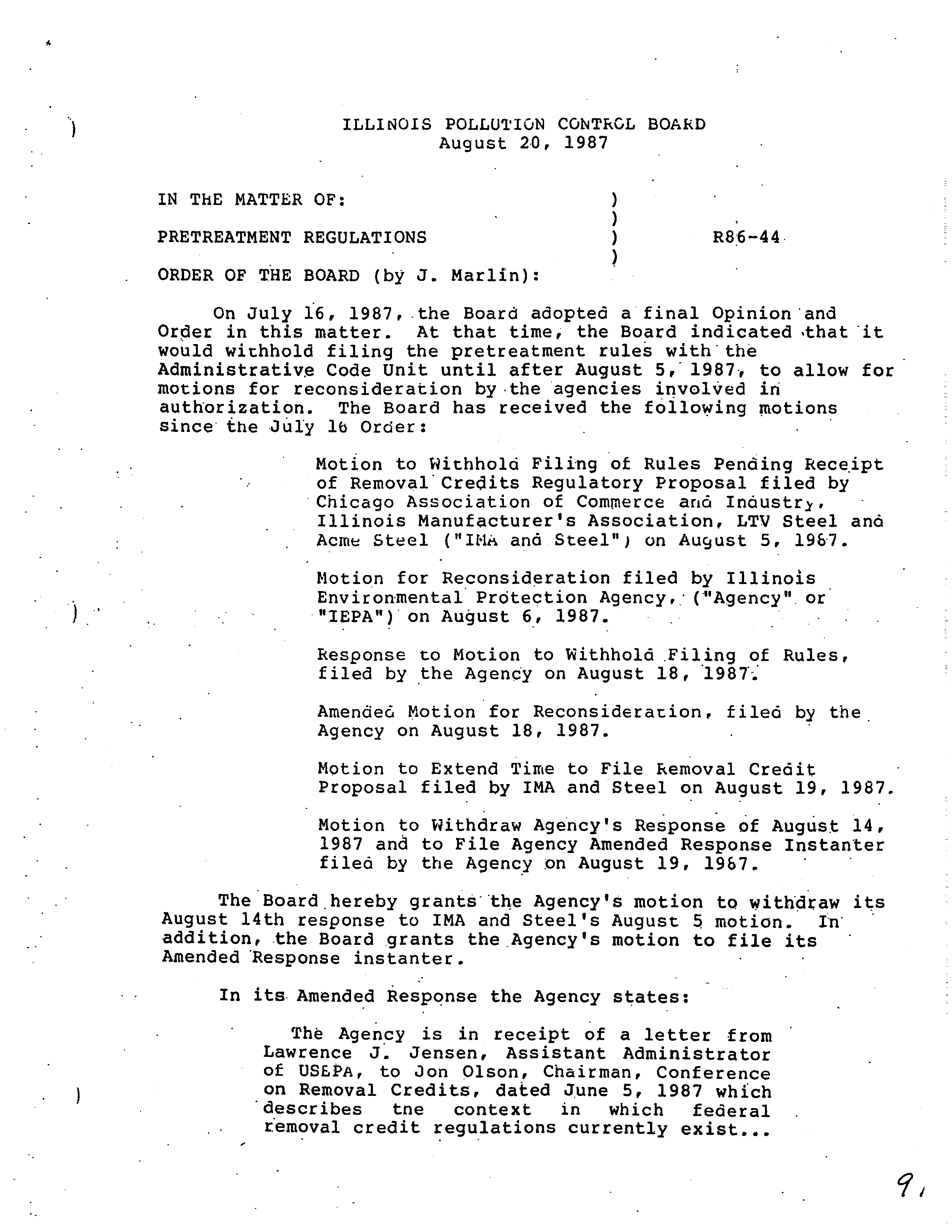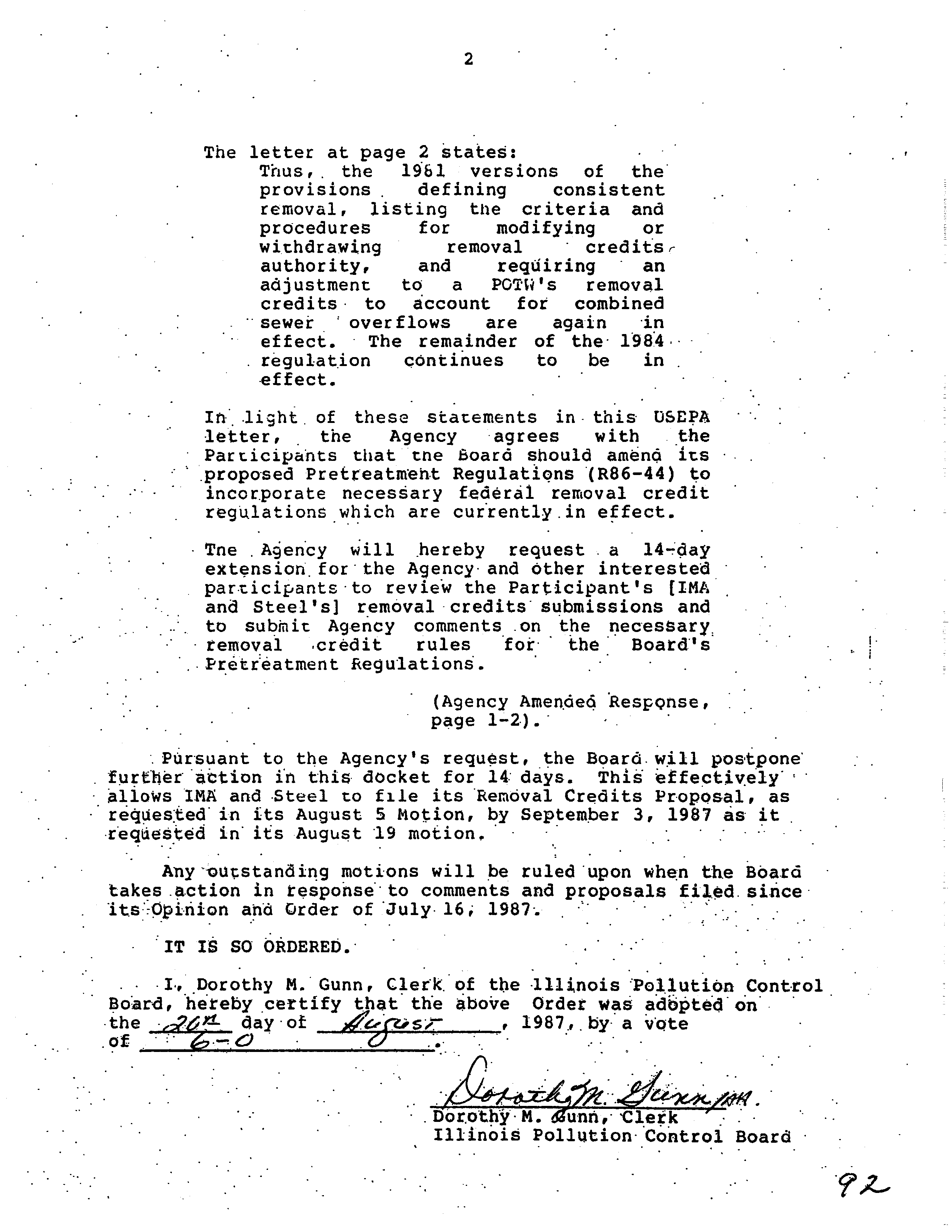Dorothy M. Gunn, Clerk
Illinois Pollution Control Board
James R. Thompson Center
100 West Randolph Street, Suite 11-500
Chicago, Illinois 60601
Michael McCambridge
Hearing Officer
James R. Thompson Center
100 West Randolph Street, Suite 11-500
Chicago, Illinois 60601
Date:
January
11, 2002
Illinois Environmental
Protection Agency
1021 North Grand Ave East
P.O. Box 19276
Springfield, IL
62794-9276
NOTICE
R
F~
~
~VE D
~J
~F~t~i:
~
R02-9
(Identical-in-Substance
Rulemaking)
Michael G.Rosenberg
Alan J. Cook
Metropolitan Water Reclamation District
100 East Erie Street
Chicago, Illinois
60611
Tom Skinner, R. A.
David A. Ullrich, D.R.A.
US Environmental Protection Agency Region V
77 West Jackson Street, Suite B-19
Chicago, Illinois 60604
ENVIRONMENTAL PROTECTION AGENCY
OF THE STATE OF ILLINOIS
By:
ConnieL. Tonsor
Associate Counsel
Special Assistant Attorney General
Division of Legal Counsel
ARDC#6186313
IN THE MATTER OF:
WASTEWATER PRETREATMENT
UPDATE,USEPA AMENDMENTS
(October 3, 2001)
BEFORE THE ILLIN(iIWUOLLUTIØNC~NTROLBOA1U)
)
)
J/3~N
1
4
2082
STATE OF ILLINOIS
Pollution Control Board
)
)
)
)
)
PLEASE TAKE NOTICE that I have today filed with the Office of the Clerk of the Pollution
Control Board the COMMENT of the Illinois Environmental Protection Agency in the abovematter, a copy of
which is herewith served upon you.
THIS FILINGIS SUBMITTED ON RECYCLED PAPER
(~
~
J~N
1
4
2110?
BEFORE THE
ILLINOIS POLLUTION CONTROL BOARD
STATE
OF
ILLINOIS
Pollution Control Board
IN
THE MATTER OF:
)
WASTE WATER PRETREATMENT
)
R02-9
UPDATE, USEPA AMENDMENTS
)
(Identical-in-Substance
(October 3, 2001)
)
Rulemaking)
)
COMMENT OF ILLINOIS ENVIRONMENTAL PROTECTION AGENCY
NOW COMES the ILLINOIS ENVIRONMENTAL PROTECTION AGENCY (“Illinois
EPA”),
by its
attorney,
Connie
L.
Tonsor,
and
hereby submits comments
in
the
above
rulemaking.
1)
The Illinois EPA appreciates the Illinois Pollution Control Board’s (“Board”) efforts to
expedite consideration of the October 3,
2001
federal
amendments to the pretreatment
program.
2)
The Illinois EPA has grave concerns thatthe Board’s process in adopting additional
requirements ofBoard approval of project XL pretreatment agreements found
in proposed
35111. Adm. Code
31 0.930 (b),1 evidences a fundamental misunderstanding of
thepr~ject
XL process in the pretreatment area.
It, in essence, appears to give the Board authorityto
review U.S. EPA pretreatment plan approval decisions; appears togo beyond the scope of
Sections 7.2 and 13.3 of the Act, 415 ILCS 5/7.2, 13.3; is not otherwise authorized by the
Act; is contrary to the regulatory scheme established by the Board in the 35 III. Adm. Code
310;
is unnecessary to implement the federally approved XL pretreatment project plans
through
the
National
Pollutant
Discharge
Elimination
System
(“NPDES”)
permitting
The language of Section 3 10.930(b) is not found in the pretreatment XL amendments adopted by the U.S. EPA at 40
CFR403.20,
66 Fed. Reg. 50334, at 50339 (October 3, 2001).
process; and may vitiate the purpose of innovative pretreatment by rendering it ineffective.
2
The
Illinois EPA strongly urges the
Board to delete proposed
Section 310.930(b) and
modify its definition of the XL agreements.
THE XL AGREEMENT
3.
A full understanding of the XL agreement is necessary to comprehend
the
Illinois
EPA’s concerns.
The agreement states on pages
3 and 23-24 that it does not
“create or
modify legal rights or obligations, is not a contract or a regulatory action, such as a permit
or a rule, and is not legally binding or enforceable against any Party.
Rather, it expresses
the plans and intentions of the
Parties without making those plans and intentions binding
requirements.
This appliesto the provisions ofthis Agreementthat concern procedural as
well as substantive matters.”
4.
On
its
face,
the
XL
agreement
is
a
proposal
for
implementing
pretreatment
requirements in an
innovative fashion.
It is not enforceable as a contract.
It is not a rule.
It does not change orpurport to change anylegal obligation-of-any-partyto-theagreement.
The Illinois EPA is, therefore, perplexed bythe Board’s conclusion that it must change the
specific agreement into
a regulation
and, thus, by some
rulemaking or regulatory relief
activity, give itthe status of law.
The agreementon its face also presumes that the-project
2The Board in its November
15,
2001, opinion and order stated that it believed the XL agreements would be ineffective
without
some
type of rulemaking specifically
allowing
for the Board’s
substantive
review of the
agreements.
It
suggested an adjusted standard, variance, site-specific rulemaking or regular rulemaking procedure. No rulemaking or
regulatory relief is needed, other than the federaldocket as adopted pursuant to Sections 7.2 and
13.3 of the Act.
The
specific agreement regarding the MWRDGC demonstrates this process. The agreement isnota change in the generally
applicable regulations.
The U.S. EPA changed the
rule of general applicability
to address XL innovative projects.
MWP.DGC
will propose a modification of
its pretreatment program.
The U.S.
EPA will approve
the
XL-based
modification based on existing regulations.
The Illinois EPAwill issue permits to the MWRDGC that include its local
programrequirements.
Finally,the Board’s adoption ofthe pass through language will fulfill the mandateofSection 13.3
of the
Act, 415
ILCS
5/13.3
(2000),
that the
Board adopt
regulations that are
identical in substance to the
federal
regulations relating to pretreatment.
may be altered to adjust to innovative methods of meeting pretreatment requirements.
It
may be changed
by the
parties at any time and
is not enforceable against any party.
“This Project is an experiment designed to test new approaches to environmental
protection and there is a degree of uncertainty regarding the environmental benefits
and costs associated with
activities to be undertaken
in this Project.
Therefore, it
may be
appropriate to amend
this Agreement at some
point
during
its duration.
Issues and amendments
may be raised by the Parties or the
Stakeholders.
This Final Project Agreement may be amended by mutual agreement of all Parties
at any time during the duration of the Project.” ~
Once the specific agreement is changed to a regulation,
it will be binding upon the
parties, have
the force of law,
and its specific terms may be used
as the
basis for third
party enforcement actions pursuant to Section
31
of the Act, 415
ILCS 5/31,
and 35
III.
Adm. Code 103.200 of the Board’s procedural regulations.
Thus, it may not be amended
absent Board action.
The Illinois
EPA does
not
believe that the
Board
intended such a
consequence from
its change of the specific Metropolitan Water Reclamation
District of
Greater Chicago (“MWRDGC”) agreement to the status of law.
5.
The Illinois EPA notes that the
Board may have thought that this addition of Board
approval of the
agreement was simply a “more stringent” requirement
than the federal
regulation.
However, although the Board may make the Illinois regulations :more:stringent
than federal regulations, the more stringent regulations must be based upon some state
3Project XL Agreement,p. 24. As noted inFootnote 2, theAgreement
does not ofitself
modify
the pretreatmentplanof
the POTW.
The modifiedpretre~atment
plan must be approved byU.S. EPA.
The modification approvalprocess follows
the existing requirements, contained inthe Board regulations at 35 III. Adm. Code 3 l0subpart K.
law requirement.
Generally, theyare not used to totally change the structure of the federal
program for which the Act requires identical-in-substance rulemaking.4
6.
The regulatory mechanism for implementing the XL based pretreatment projects,
selected by U.S. EPA pursuant to the Clean Water Act, was to change the rule ofgeneral
applicability,
specifically providing for the
approval of Publicly Owned Treatment Works’
(“POTW”) pretreatment
programs that are based upon
innovative measures.
The U.S.
EPA
met
this
goal
on
October
3,
2001
by
adopting
amendments
to 40
CFR 403.3,
concerning pretreatment plan approval for POTWs.
The Board, pursuant to Section 13.3
ofthe Act and Section 7.2 of the Act, had
a statutory obligation to adopt this amendment
through identical-in-substance rulemaking.
The addition of a Board approval requirement,
contained within proposed Section 310.309(b) which changed the agreement itself to the
status of a regulation, substantively changed the
U.S. EPA amendment of the 40 CFR .3
by negating U.S. EPA’s regulatory formatfor approval ofXL based pretreatment programs.
Such an action should not take place pursuant to Section 7.2 ofthe Act.
It is also contrary
to the directive of Section 13.3 of the Act, 415 ILCS
5/1 3.3.
7.
Since
U.S.
EPA
changed
the
rule
of
general
applicability,
the
“environmental
standard,” to encompass XL based pretreatment programs, no regulatory relief mechanism
or
further specific
Board
approval
of
the
agreement
is
necessary.
The
only
action
necessary is that the Board must adopt the federal October 3, 2001
amendments.
PRETREATMENT PROGRAM BACKGROUND
8.
An explanation of the pretreatment program ~
regulations will further illustrate the
Illinois EPA’s concerns.
See generally, 415
ILCS 5/7.2 (2000).
9.
The Illinois EPA is not the authorized entity for approval ofpretreatment programs in
the State.
(Attachment A)
POTWs
in
Illinois
have their pretreatment programs directly
approved
by U.S.
EPA.
The pretreatment program ofthe MWRDGC has been approved
by U.S.
EPA.
10.
35
III. Adm. Code 310 addresses Pretreatment Programs.
Section 31 0.103 states in
pertinent part:
“a)
The
Board
intends
that
this
Part
be
identical
in
substance
with
the
pretreatment requirements of the
Clean
Water Act
(33 USC
1251 et seq.) and
United StatesEnvironmental Protection Agency (USEPA) regulations at40 CFR401
etseq.
b)
This Partwill allow the Agencyto issue pretreatmentpermits, review POTW
pretreatment plans and authorize POTW5
to issue authorizations to discharge to
industrial users when and to the extent USEPA authorizes the
Illinois pretreatment
programpursuant to the Clean WaterAct.
Afterauthorization the requirements of
the
Clean
WaterAct and 40 CFR 401 et seq. will continue in Illinois.
Inparticular,
USEPA
will:
1)
Retain the right to request information pursuant to 40 CFR 403.8(f);
and
2)
Retain
the
right to
inspect and take samples pursuant to
40 CFR
403.12(I).
c)
Thispart shall not be construed as exempting anyperson from compliance,
prior to authorization of the
Illinois pretreatment program,
with
the pretreatment
requirements of the
Clean
Water Act,
USEPA
regulations
and NPDES permit
conditions.
d)
POTW pretreatment programs
which
have
been
apprOved
by
USEPA
pursuant to 40 CFR 403 will be deemed approved
pursuantto this Part, unless
the Agency determines thatit is necessary to modify the pretreatmentprogramto be
consistent with State law....”
11.
In Section 310.102, the Board stated the basic objective of Part 310 as fulfilling the
statutory requirement of Section 13.3 of the Act, 415 ILCS 5 13.3, that the Board adopt
regulations
that
are
identical
in
substance
to
federal
regulations
or
amendments
promulgated
by
the
U.S.
EPA
to
implement
Sections
307(b),
(c),
(d),
402(b)(8)
and
402(b)(9) of the
Federal Water Pollution Control Act, as amended.5
12.
In
R86-44,6 the Board acknowledged that the
Illinois EPA was
not the
authorized
entity for approval of the pretreatment program plans of POTWs pursuant to the 40 CFR
.3.
It
addressed
the
relationship
of
federal
and
state
law,
the
approval
of
POTWs
pretreatment programs, the requirements in 40 CFR .3 for authorization of the Illinois EPA
as the approval
authority for POTW
pretreatment plans
and the effect of modifying the
definition of “approval authority” to include U.S. EPA.
The Board noted that its language,
35
III. Adm.
Code
310.103, specifically removed any implication that the
U.S. EPA was
acting pursuant to Board rules when it approved POTW pretreatment program plans prior
to
the
Agency
becoming
the
authorized
entity for
POTW
pretreatment
program
plan
533
U.S.C. §~
1317, 1342(b)(8)
(NPDES permits to include conditions torequire the identification ofsignificant sources
introducing pollutants into a POTW); 1342(b)(9) (NPDES permit for the POTW to include insurance that any industrial
user comply with
effluent standardsfor toxic and reporting.
6
IN THE MATTER OF:
PRETREATMENT REGULATIONS (December
3,
1987) 1987 WL 107413
approval.
It also specifically acknowledged that it did not have the authority to “regulate”
the U.S.
EPA.7
13.
The Board, through
the addition of proposed
Section 310.930(b), has folded into
Part 310 both the implication of authorityto regulate the U.S. EPA and the actualityof that
regulation.
Proposed Section 310.930(b) states thatthe Board- must approve by-regulation,
Section
310.930(b)(1),
(MWRDGC),
or
by
some
other
regulatory
action,
Section
31 0.930(b)(2), an agreement that the U.S. EPA clearlydid not promulgate as a regulation.
14.
Additionally,
the
regulatory scheme of Part 310 notes that the
Illinois
EPA
is the
approval authority for POTW program plans after authorization.8
Therefore, the Agency,
without Board action,
is charged with
specifically reviewing plan submissions.
Part 310
further provides that those programs approved by the U.S. EPA shall be deemed approved
pursuant to
Part 310.
The Board’s opinion
clarifies that the Board believes that it must
review the substance of these XL agreements. (R02-9, pp.4-5).
A substantive review of
the U.S. EPA’s action in approving an XL pretreatment agreement is not authorized bythe
Act nor
is
it
authorized
by the
Board’s existing regulations
in Part 310.
Additionally,
a
‘
See R86-44
at 1987
WL 107413
*13_16; R86-44 at pp. 21-25 (October 1,
1987).
The Board initially entered a “fmal
order” adopting the pretreatment regulations on July 16,
1987.
The Board vacated this order on September4,
1987.
On
October 1, 1987 the B 1/1 1/2002oard entered a revised Proposed Opinion and-order to adopt the pretreatment program
withprovisions forremoval credits.
Prior to adoption ofthe October
1,
1987 proposedrule, the U.S. EPAamended its
removal credits rule.
On November
19,
1987, the Board postponed action on the pretreatment rules until December 3,
1987. The pretreatmentrules were subsequently adopted and became effectiveon January 13,
1988.
The explanationof
the interrelation of state and federal law in the pretreatment process containedwithin Section 310.103 was unchanged
from the proposed (October
1, 1987) opinion.
Boththe interimand the fmal opinion havebeenreferenced inthis note.
The Illinois EPA has
also not found any federal or state
statutory authority
that would permit the Board to
substantively review and approve of U.S. EPA actions in pretreatment programplan submissionsby POTWs.
The Board subsequentlyaddressed Section 310.103 inR9
1-5.
However, it noted thatpursuant to the directive
ofSection 7.2 of the Act, requirements for programapproval had notbeenplaced in Section 310.103.
8The Illinois EPAnotes for the
Board that the XL agreement is not the request for programmodification.
review
by
the
Board
of
the
Illinois
EPA’s
approval
after
authorization,
of
a
POTW
pretreatment plan would only occur in the context of a
permit appeal. ~
15.
The language of proposed Section 310.930(b) is not authorized by Sections 13.3 or
7.2 of the Act. 415 ILCS
5/1 3.3, 7.2
(2000).
Forthe reasons stated
in this comment, the
Illinois
EPA
believes
that the
Board
is
obligated to
delete the
additional
language
as
unnecessary and as beyond the statutory authority afforded
it in the Act.
Respectfully submitted,
ILLINOIS ENVIRONMENTAL PROTECTION
AGENCY
By:
c?~4t.1e~i
o(.
cS’~N~it~v
Connie
L. Tonsor
~
January11, 2002
Illinois Environmental Protection Agency
1021
North Grand Ave.
East
P.O. Box 19276
Springfield,
Illinois 62794-9276
9Until the Illinois EPAbecomes authorized as the approvalauthority for pretreatment, a strong argumentmay be made
that that the board’s action in adding Section 310.930(b) in notin effect.
STATE OF ILLINOIS
COUNTY OFSANGAMON
)
)
)
PROOF OF SERVICE
I, the undersigned, on oathstatethat! have served the attached COMMENT upon the persons to
whom it is directed, by placing a copy in an envelope addressed to:
Dorothy M. Gunn, Clerk
Illinois Pollution Control Board
James R. Thompson Center
100 West Randolph Street, Suite 11-500
Chicago, Illinois 60601
Michael MeCambridge
Hearing Officer
James R. Thompson Center
100
West Randolph Street, Suite 11-500
Chicago, Illinois 60601
Michael G. Rosenberg
Alan J. Cook
Metropolitan Water Reclamation District
100 East Erie Street
Chicago, Illinois 60611
Tom Skinner, R. A.
David A. Ullrich, D.R.A.
US Environmental
Protection Agency Region V
77 West Jackson Street, Suite B-19
Chicago, Illinois 60604
and mailing it
from Springfield, Illinois on January 11, 2002 with sufficient postage affixed first class mail.
SUESCMBI~)
AND SWORN TO’~3EFOREME
this
1th
day ofJanuary,
2002.
N
TAR~7~ELIC
±
OFFICIAL
SEAL
±
TONI I
LEIGH
~
NOTARY
PUBLIC,
STATE
OF
ILLINOIS
f
MY
COMMISSION
EXPIRES
9.20.20058
THIS FILING IS SUBMITTED
ON RECYCLED PAPER.
Attachment A
,~t4J
~T4y~,
UNITED STATES ENVIRONMENTAL
PROTECTION
AGENCY
-
-
0
-
REGION
5
w
77 WEST JACKSON BOULEVARD
÷,.
J
CHICAGO, IL
60604-3590
REPLY TO THE ATTENTION OF:
*06
22
tat?
WN-16J
Thonias McSwiggin, Manager
i?
Permits Section
Division ofWater Pollution Control
Illinois Environmental Protection Agency
AUG
2
F
1997.
2200 Churchill Road
~
Springfield, IL
62794-9276
°
~
~
~41
‘~I
Dear Mr. McSwiggin:
Enclosed are the comments from the United States
Environmental Protection Agency
(USEPA), Region
5
on your April 8, 1997, submittal for Pretreatment Authority.
These
comments were developed by my staffin coordinationwith our Enforcement apd Compliance
Assistance Branch, Office of Regional Counsel and Headquarters Pretreatment Section.
As you will see, these comments primarily seek clarification ofvarious aspects ofprogram
implementation, particularly with respect to issuance ofIndustrial User (Hi) permits, and
functional responsibilities for carrying out programmatic activities.
A numberof comments on
the State’s pretreatment regulations have also beenprovided.
While these comments identify the
needto revise certain regulatory provisions before final approval can be granted, we arehopeful
that these revisions can be readily addressed by the Illinois Pollution Control Board as we work
through the remaining issues identified andproceed toward approval ofthe State program.
Should it become necessary, we are willing .to explore options for- some form ofinterim or
conditional approval pending resolution ofthese regulatory issues.
We are encouraged by the State’s renewed efforts to seek approval for implementationof this
important Clean Water Actprogram, and look forward to working closely with you to complete
thisprocess.
After reviewing thesecomments, please contact me, or Matt Gluckman at
(312)
886-6089 to discuss the next steps.
-
Sincerely yours,
EugeneI. Chaiken, Chief
-
NPDES Support and Technical Assistance Branch
Enclosure
cc: Elaine Brenner, 4203
Recycled/Recyclabte.Prlnted
with Vegetable Oil Based Inks on 100
ReâycIed
Paper
(40
Postconsumer)
illinois Application for Pretreatment Authority
Comments on April 8, 1997 Submittal
(Updated August 4,
1997)
Outline ofComments:
Section I: Introduction and Summary
-
Section II: Program Outline
and Implementation Plan
-
Section ifi:
Organization
~
Section IV: Funding and Staffing
~
~
~
Section
V:
Attorney General’s Statement
Section VI: Modified Memorandum ofAgreement
AUG
2
F
1997
Recommendations forAdditional Attachments
~rvl,~.;:r;.,
~,,..
Statutory Provisions
0ui~
~41tt41
Regulatory Provisions
Section I: Introduction and Summary
State Pretreatment Permit System (p. 5).
The differences between Operating Permits
(309.204) and Pretreatment Permits (310.401) remain unclear.
Specifically, which provisions
provide theunderlying authorityfor the “Pretreatment” Permits discussed on pages
10-11?
Market Trading (p.
5-6).
How does the State foresee these concepts affecting delegation?
Section II:
ProEram Outline and Implementation Plan
List ofPOTWs required to implement pretreatment programs (p.7).
Attachment 4 needs to
be updated. -Aurora Sanitary District
is now Fox Metro Water Reclamation District; Robinson
has been approved, and O’fallon and others have been required.
Inventory of
C1TJs
tnbutary to POTWs without pretreatment progrims.
Regional staff
has
reviewed the referenced inventory, and identified certain facilities that are not CIUs.
This
narrowed list will be provided ifit has not been provided previously.
Operating Permit applications (p. 10).
The program description indicates that the requirements
for operating permit applications requires most ofthe same information as Baseline Monitoring
Reports, and will be used as BMRs as appropriate.
While the “catchall provision” in the
Operating Permit Application requirements, section309.221(b) appears to provide the authority
to require all necessary information forBMRs, it is recommended that that provision be revised to
reference 403.12(b) or to reflectthe specific
infonnation necessary
for BMRs.
Issuance of Pretreatment Permits (p. 10).
The end ofthe first full
paragraph
says that
Pretreatment Permits will be required for all
SIUs.
This does not appear to be fully consistent
with section 3 10.401, which limits those needing such permits to those notified by the Agency
that they have caused pass through or interference, or that their discharge poses an imminent
endangerment
to the health or welfare ofpersons.
This gets back to the question ofwhether
section 309.204 or 310.401
is the basis for issuance ofthese permits.
The second paragraph refers to compliance monitoring procedures.
Please identify the specific
NPDES
procedures being referenced,
and indicate if they are being updated.
The last sentence
on this page refers to incorporation ofcompliance schedules into 113 permits
following delegation.
Where such schedules are needed prior to final approval, theRegion is
willing to provide
iVs assistance.
-
Status ofBMRs (p. 11).
The statementthat
all BMRs are overdue is overly broad, as certain
CIIJs have been reporting
to
the Region as required.
Alist ofsuch facilities can be provided if
necessary.
In addition, BMRs for Pesticide Formulating Packaging and Repackagingfacilities
were due July 7,
1997.
Sampling and Inspection of CIIJs outside o
approved pretreatment programs (p.12).
While
the specific annual commitments for inspection and sampling ofthese us
will be addressed
through the performance partnership agreement process, wewould strongly recommnend some
form of contact with each CIIJ at least once a year.
Sampling ofInflueñts, effluents and sludge to verify removal rates and sludge requirements
(p. 14).
The discussion should clarify that this information, along with POTW information, may
be used as a basis for modification or withdrawl ofremoval
credits during the permit term.
•
AnnualReport Form (p. 15).
Please indicatethe nature ofadditional refinements that
are being
made to the Annual Report form.
-
~
~
47~’,P
Procedures for response to pretreatment violations (p. 17).
Please identify the specific
procedures
being referenced, and whether they are being updated.
Also, this section should
address èntryofPretreatment Program Enforcement Tracking System (PPETS) and Water
Enforcement National Database (WEND-B) data elements into PCS.
Section III: OrEanization
-
At
various points the program description discusses howvarious activities to implement the
pretreatment program will be carried out.
It is not clear from the description, however, which
Section orunit within theBureau ofWater will havethe primary responsibility for ensuring the
various activities are performed.
This identification offunctions would be especially useful in
light ofthe Agency’s apparent intention to not have a designated primary contact, or Pretreatment
Coordinator, and would assist both U.S. EPA and the regulated community in knowing which
part ofthe Agency to contact on a specific matter.
Particularly useful would be the identificaton
-
of the Section(s) or Unit(s) responsible for the following:
•
Industrial User Permits
•
Tracking compliance with
113 permits,
including review ofreports,
inspections and
sampling,
enforcement
•
Technical assistance, in particular for category determinations,
interpretations of
regulatory requirements, local limits development, technical issues associated with
industrial discharges, adjustment ofpretreatment standards (i.e. removal credits, net
credits and
FDFs)
-
•
Review and follow-up on Annual Reports
•
Review and approval ofprogram modifications
Section IV: Funding and Staffing
-.
En light ofthe static resources discussed in this Section, how does the State foresee managing the
increased workload involved in managing thepretreatment program, particularly with regard to
113 permitting, review oflocal limits revisions and other program modifications,
113 oversight and.
technical assistance?
-
Section V: Attorney General’s
Statement
-
A signed version ofthe Attorney General’s statement will be necessary prior to public noticing of
U.S.EPA proposed approval ofthe State’s Program.
Section VI: Modification to Memorandum ofAgreement
General comments.
References in the MOA to Pretreatment Standards should be revised where
appropriate to
also refer to Pretreatment Requirements (e.g: reporting requirements).
Commitments
on pages
23
and 25 to
approve and deny POTW programs should be revised to
include modifications to such programs.
•
Incorporating.POTW Pretreatment Program Conditions (p. 24).
This
section states that
U.S.
EPA approval is not required for additions and deletions to the list ofPOTWs required to
•
have programs.
In contrast, MOM with other States in the Region provide that POTWs will not
be deleted without U.S. EPA’s
approval.
While it shouldn’t be necessary for the Region to
•
affirmatively respond to such changes, notice and opportunity to respond should be provided.
Such prior notification is
all the more important in light ofRegion’s deèmphasis on real-time
review ofNPDES permits.
•
-
-
Removal
Credits
(p. 26).
This sectionprovides for State review ofapplications and forwarding
to U.S. EPAfor approval.
Under40 CFR 403.7, the State, as the Approval Authority, would
approve authorizations for removal credits, and forward to U.S.
EPA for review.
Net Credits (p. 27).
This section indicates the state will forward iIet credit requests to U.S.
EPA
for approval.
40 CFR 403.15 has been revised so that Control Authorities (either the POTW or
State) would approve such requests, not the Region.
Recommendations for Additional Attachments
•
BMR or Pretreatment Permit application form
•
-
113 permit format for CIUs
•
Narrowed list ofCIUs to be issued Pretreatment Permits,
and if available, the JEPA’s plan
for permit issuance
•
Pretreatment follow-up inspection checklist
•
Sample NPDES permit language where new POTWPretreatment Program will be
•
required (where newprograms are required, phased approachused in the past will not be
utilized)
•
Definitions ofterms used in
enforcement schematic
•
Organizational chart with primary responsibilities with respect to pretreatment,
indicating
•
organi2ational leads forvarious program activities.
•
Regulatory Provisions
•
•
-
•
•
General comments.
The following comments
are based on review ofthe March
1995 version of
•
-
Title
35:
Environmental Protection,
Subtitle C: Water Pollution,
Chapter I: Pollution Control
Board.
It
appears that in some cases, subsequent revisions may have been made which could
•
address these comments; later versions ofthe regulations, however, were not available for review.
While the comments are significant, we are hopeful that
they can be readily addressed by the
IPCB’s regulatory revision process while we work through any other outstanding issues and
proceed toward approval ofthe State program.
Should it become necessary, we are willing to
explore options for some form ofinterim or conditional approval pending resolution ofthese
regulatory issues.
Specific comments.
-
•
310.110 Definitions.
Pretreatment Standard.
This definition includes local limits pursuant to 310.211 which are part
of an approved pretreatment program.
While
section 310.211 includes local limits developed by
POTWs without pretreatment programs, the reference to approved programs should be deleted,
as once any POTW has adopted local limits pursuant to
3 10.210, they are Pretreatment
Standards.
-
-
--
310.211 Category Determination Requests.
The timeframe for, filing such requests should
bçgin whenthe Federal Standards become effective, not when adopted by the IPCB.
310.222 Compliance date for categorical standards.
This provisiàn establishes different dates
for compliance with categorical standards based on adoption ofthe standards by the IPCB, once
U.S. EPA has given approval ofthe State’s program.
National Categorical Pretreatment
Standards
are
self-implementing standards,
and
compliance
deadlines cannot be extended by the
State.
This
provision should be revised to simply reference the compliance date in the Federal
Register publication for the categorical standard.
-
310.232 Dilution prohibition.
The last phrase ofthis provision, that POTW’s may allow
dilution to
meet local limits established by 3109.210, must be deleted.
The dilution prohibition
applies to all Pretreatment Standards, including local limits.
Clarification ofterms in
this
case is
useul.d, as determining compliance with local limits after cominglingofdilute wastestreams (e.g.
sanitary
wastestreams) is appropriate, whereas addingwater, say with a hose, to comply with
standards would be considered prohibited dilution.
310.303 Conditions for Authorization to Grant Removal Credits.
Subpart d of
this
provision
has
nOtbeenupdated to incorporate the Federal sludge requirements,
including the pollutants for
which
POTWs may
obtain
authorization to grant removal credits.
310.401 Pretreatment Permits.
The two criteria for the Agency to require sucha permit put the
burden on
it to show that a user has caused pass throughor interference or poses an
imminent
threat to health or
welfare.
While
it is our understanding that section
309.204 would at least in
part provide the authority for permit issuance, this provision does not appear to provide the
• authority
to issue Pretreatment Permits to any SIU,
or even to
any
CRY,
unless the above criteria
can
be met.
-
310.410 Application.
While subpart (a)(8) provides adequate authority to require all
BMR
•
information required under 403.12(b), it is recommended that this provision be revised to either
incorporate 403.12(b) by reference or specify
all information
required by that provision, including
sampling
data
on the
effluent,
and
informationin sUpport of applicable categorical standards.
3 10.413 Site Visit.
This provision requires that IEPA notify a user prior to conducting a sitevisit
to evaluate a Pretreatment Permit application.
Such a requirement unnecessarily liniits the
Agency’s authority to inspect lUs,
and
should be deleted.
310.430 Conditions.
Similar
to the comment re 310.410, the
authority
to include necessary
• provisions in Pretreatment Permits seems adequate, but it is recommended that this provision be
revised to specify that such permits will include
sampling
locations, various notification
requirements, transferability requirements,
and
penalties available fornoncomplIance.
-
310.521 Program Approval and 310.522 Contents ofProgram SubmissiOn.
Both sections
should be revised to reference the POTW’s enforcement response plan and
siu
list as part ofthe
program to be approved.
310,602 Baseline Monitoring Reports.
Subpart (h)(2)(A) states that
BMR.s
for existing
lUs
must be
submitted within
180 days ofadoption by
the Board (or
final
category determination) for
standards adopted after delegation.
As
discussed above, the reporting requirements for
categorical users are self-implementing, and cannot be extended by a State.
This provision should
be revised to incorporate the general timeframes specified in 403.12(b).
310.634 Recordkeeping Requirements- Hazardous waste notification.
The address provided
for notification to U.S. EPA Region
5
needs to be updated to our current address.
310.711
FDF Application Deadline.
Under subpart (b)(2), FDFs must be submitted
within 180
•
•
days ofincorporation ofcategorical
standards by the IPCB,
once the state program is delegated.
As in the comment above, this would improperly extend the Federal date for requesting FDFs,
and
would be inconsistent with EPA’s criteria for approving these variances.
310.801 Net/Gross Calculations.
As a result ofthe
PIRT revisions to the General Pretreatment
regulations, the authorityto grant intake
credits was shiftedto Control Authorities; retention of
the old reference to the Approval Authority has caused delays in at least one
JU obtaining such
credits frOm the MWRDGC.
-
310.920 Modification of POTW Pretreatment Programs.
Language from 403.18 regarding
nonsubstantial program modifications is not included in theIPCB regulations, and
should be
revisedto do so.
In addition, please note that revisions to 403.18 were finalized on July
17,
1997.
Page
Citation
Search Result
Rank 17 of 20
Database
1987 WL 107413
ILENV—ADMII
(Cite as: 1987 WL 107413
(Ill.Pol.Control.Bd.))
Illinois Pollution Control Board
State of Illinois
*1 IN THE MATTER OF: PRETREATMENT REGULATIONS
R86-44.
December
3,
1987
FINAL ORDER. ADOPTED RULES
OPINION OF THE BOARD
On
October 9,
1986,
the Board opened this Docket for the purpose of
promulgating
regulations
establishing
a
pretreatment
program
pursuant
to
Sectioi
13.3 of the Environmental Protection Act
(Act), as amended by P.A. 84- 1320. On
March
5,
1987 the Board proposed, and on July 16,
1987 adopted, amendments to 3~
Ill.
Adm.
Code
307
and
309,
and
a
new
35
Ill.
Adm..
Code 310. On September 4,
1987 the Board vacated the July 16 Opinion and Order. On October
1,
1987 the
Board adopted a revised
Proposed
Opinion
and
Order,
requesting
public
comment
through
October
30,
1987.
As
is
discussed
below,
the
comment
period
is
over,
anc
the
Board
is
now
adopting
this
revised
Opinion
and
accompanying
Order.
Section 13.3 of the Act requires the Board to adopt regulations which are
“identical in substance” with federal regulations promulgated by the United
States Environmental Protection
Agency
(USEPA) to implement the pretreatment
requirements of Sections 307 and 402 of the Clean Water Act
(CWA), which was
previously known as the Federal Water Pollution Control Act. Section 13.3
creates an abbreviated procedure similar to that provided by Sections 13(c)
and
22.4(a)
of the Environmental Protection Act
(Act)
for the UIC and RCRA programs
Section 13.3 provides that Title VII of the Act and Sections
5 and 6.02 of the
Adinin
strative
Procedure
Act
(APA)
do not
apply
to “identical in substance”
regulations adopted to
establish
the
pretreatment program. Section 13.3 require~
the
Board
to
provide
for
notice
and
public
comment
before
rules
are
filed
with
the
Secretary
of
State.
The
Board
provided
for
such
notice
and
comment
byway
o~
the
Proposed
Opinion
and
Order.
As
provided
by
Section
13.3,
the rules are not
subject to the first notice requirementsor to second notice review by the Joint
Committee on Administrative Rules
(JCAR). Section 13.3 also provides that the
Department
of
Energy
and
Natural
Resources
(DENR)
may
conduct
an
economic
impact
study
(EcIS)
on the rules,
but the study and hearings are not required before
the rules are filed.
-
To avoid confusion,
the Board published its proposal of March
5,
1987 in the
Illinois Register utilizing a format similar to the “first notice” procedures
under
the
APA.
The
Board allowed 45 days for public comment.
PUBLIC
COMMENT
ON
MARCH
5
PROPOSAL
PC
1 through PC
8 were preliminary comments which were referenced in the
Proposed
Opinion.
Preliminary
comments
referenced
in
this
Opinion will be liste
Copr.
‘~
West
2001 No Claim to Orig. U.S.
Govt.
Works
•
Page
1987
WL
107413
(Cite
as:
1987
WL
107413,
*1
(X11.Pol.Control.Bd.))
for
convenience
of
readers:
PC 1 Illinois Environmental Protection Agency
(IEPA) preliminary draft
proposal, July 24,
1986
PC
4 -Letter from David Rankin
(USEPA)
to Angela Tin
(IEPA), August 11,
1986
PC
7 IEPA revised preliminary draft proposal, November 12,
1986
PC 8 Summaries of Categorical Pretreatment
Standards,
prepared
by
Angela
Tin
and Joe Subsits, IEPA,
February 5,
1-987
*2 The March
5,
1987 proposal appeared on April
3,
1987,
at 11
Ill.
Reg.
5453.
The Board received the following public comment in response to the March
5 Orde~
and publication, in the
Illinois
Register:
FN1,2
PC
9 USEPA, March 27,
1987
PC
10
USEPA,
May
18,
1987
(USEPA)
PC
11
Metropolitan
Sanitary District of Greater Chicago, May 18,
1987
(MSD)
PC 12 IEPA, May 20,
1987
(IEPA)
PC 13 Illinois Steel Group, May 21, 1987
(Steel)
PC 14 Chicago Association of Commerce and Industry and Illinois
Manufacturer’s Association, May 21,
1987
(IMA)
PC 15
JCAR,
May 6,
1987.
PC 16 North Shore Sanitary District, June 1,
1987
(NSSD)
These
comments
will
sometimes
be
referenced
by
the
initials
or
abbreviated
name
of
the
commenter
in
parentheses
rather
than
the
PC
number.
During
‘the
public
comment
period
the
Board
received
a
series
of
questions
from
JCAR.
Although
Section
22.4(a)
of
the
Act
exempts
these
fast-track
“identical
ii
substance8 rulemakings from formal interaction with JCAR,
the Board will attempi
to respond to JCAR’s general questions at the end of the Opinion.
The Board also received codification comments from the Administrative Code
Unit.
-
•
MOTIONS FOR RECONSIDERATION
On July 16,
1987,
the
Board
adopted
a final Opinion and Order in this -matter.
The
Board
indicated
that
it
would
withhold
filing
the
rules
until
after
the
opportunity for motions for reconsideration. As is detailed in the Orders
of
August
20
and
September
4,
1987,
the
Board
granted
motions for reconsideration
and vacated the July 16,
1987 Opinion and Order. The Agency filed and withdrew
several
motions
for reconsideration.
IMA
and Steel similarly filed several
documents which,
to the extent not dealt with in the earlier Orders, are now
moot.
The
post-adoption
filings
relatIng
to the vacated July 16 Order which are
discussed in this Opinion are as follows:
PC
17
Letter from Charles H.
Sutfin, USEPA, August
5,
1987
*
Amended Motion for Reconsideration, Agency,
August 20,
1987
PC
18
Sanitary
District
of
Rockford,
August
19,
1987
-
*
Removal Credit Regulatory Proposal,
IMA
and
Steel,
September
2,
1987
*
Letter
from
James
B.
Park,
Agency,
September
3,
1987.
PC
18
was
simply
a
public
comment-
on
the
Board’s
proposal
which
arrived
months
after the close of the comment period on May 18,
1987, and after the Board’s
action of July 16. The Board therefore struck it.
(FN3
In the July 16,
1987 Order
the
Board
solicited
motions
for
reconsideration
fro’
Copr.
©
,West 2001
No
Claim
to
Orig.
U.S.
Govt.
Works
Page
1987 ML
107413
(Cite-as:
1987
WL
107413,
*2
(I11.Pol.Control.Bd.))
the agencies involved in the authorization process. In PC
17
USEPA
reiterated
some
of
its earlier comments, which are fully addressed in the-July 16 Opinion
and
in
this
Opinion.
The
letter-
is
not
framed
as
a
motion
for
reconsideration,
and references further review to be conducted by USEPA. The Board therefOre di~
not address the letter.
If necessary,
the Board will open another Docket to
address any issues USEPA may raise in the future.
The Agency’s amended motion for reconsideration raised a number of minor issu
which are discussed below in connection with the Sections
involved.,
This
is
referenced below as “IEPA Motion forReconsideration.”
*3 The major issue on reconsideration concerned whether to include removal
credits
in
the
proposal.
This
was first raised by
IMA.
and Steel, which
ultimately filed proposed regulatory language. The Agency eventually endorsed-
this change in the letter of September 3,
1987. As is
discussed
below,
the
Boa:
included
removal
credits
in
the
revised
proposal.
The
Board
solicited
addition~
comment
for
before
taking
final
action.
-
APPEALS
The
Board
has
received
notice
of
two
appeals
of
the
July
16
Order.
These
are
mooted
by
the
Board’s
action
in- vacating
the
July
16
Opinion
and
Order.
On
October
1,
1987
the
Rockford
Sanitary
District
moved
to
dismiss
its
appeal.
Th
Board assumes that the
IMA.
and
Steel
appeal
will
also
be
dismissed
promptly.
However,
because
of
the
need
for
prompt
adoption
of
a
pretreatment
program
to
meet
the
requirements
of
Section
13.3,-the
Board
will
not
await,
the
dismissal
before adopting this revised Opinion and Order.
PUBLIC
COMMENT
ON
REVISED
-PROPOSAL
The Board requested public comment through October 30 on the’ revised
Opinion
and Order adopted October
1,
1987.
FN4J
The Board received the following pubi:
comment:
.
-
PC 19 IEPA, November 2,
1987.
PC
20
Illinois
Steel
Group,
LTV Steel Company,
Inc., and Acme Steel Company
November
5,
1987
PC 21 USEPA, November 19,
1987
All
of
‘the
comments
were
filed
significantly
late.
However,
on
November
19,.
1987
the
Board
extended the comment period to afford everyone an opportunity
t
review
their
comment’s
in
light
of
USEPA’s
amendments
which
appeared
at
52
Fed.
Reg.
42434, November 5,
1987, and which related to removal credits,
the major
issue at this stage of this proceeding which is discussed below in connection
with
Section
310.300
et
seq~.
-
.
-
-
-
FEDERAL
TEXT
USED
The federal pretreatment program is contained in 40 CFR 401 through 471. The
proposal should be consistent with the 1986 edition of the Code of ‘Federal
Regulations,
Title
40
of
which is current through June 30,
1986.
The Board has
incorporated amendments through March 30,
1987.
FN5
These ‘include:
Copr.
©
West
2001
No
Claim
tO
Orig.
U.S.
Govt.
Works
-
Page
1987 ML 107413
-
(Cite
as: 1987 WL 107413,
*3
(Ill.Pol.Control.Bd.))
51
Fed.
Reg.
23759,
July
1,
1986
-.
-
51 Fed. Reg.
30816, August 28,
1986
51
Fed.
Reg.
40421,
November
7,
1986
51
Fed.
Reg.
44911,
December
15,
1986
52
Fed.
Reg.
1600,
January
14,
1987.
The Board intends to update the rules in a new docket to be opened as soon as
possible after these rules are adopted. The Board will not attempt to play keep
up
with
USEPA
in
this
Docket, which involves a large volume ‘of paper leading to
original
adoption
of
the
program.
The
Board’s
long
experience
with
the
RCRA.
and
UIC
programs
has
taught
that
it
would
be
a
futile
effort•
to
try
to
keep
up.
By
the
time
the
Board
completed the process of revising the proposal to accomodate
new amendments, USEPA would be ready with another set.
(PC 19)
-
RESPONSE
TO
GENERAL
COMMENTS.
The Agency and USEPA comments on the March
5,
1987 Order include some general
comments to which the Board responded in the October. 1 revised Proposed Opinion
and
earlier
Opinions.
Of
special
note
was
PC
9 from USEPA.
The’ Board believes
that PC 21 was intended to replace this earlier comment which was, obscured by a
major
misunderstanding
of
the
March
5 Proposal. The Board will include only a
summary
in
this
Final
Opinion.
To
the
extent
this
may
still
be
relevant,
interested
persons
are
referred
to
the
October
1
revised
Proposed
Opinion.
*4
In
summary,
Section 13.3-of the Act does not allow the contents of the
regulations,
to
be
finally
determined
by
negotiation
between
the
Agency.and
USEPA. The Agency filed no proposal with the Board, and did not seek to inform
the Board of any agreements. On the points ‘in question the Board’s proposal
appears to be consistent with USEPA rules and comments, and with the supposed
agreement.
However,
the
Board
does
not
understand
why
USEPA
is
concerned about
much of this,
since matters such as appeal routes seem to be intrinsically a
matter
of
State
law.
OVERVIEW
OF
PRETREATMENT
PROGRAM
The
following
is
a
general
discussion
of
the pretreatment program. A detailed
discussion appears after this portion of the Opinion.
-
When the Board adopted regulations protecting water quality it focused
primarily
on
discharges
to
surface
waters.
These
‘are
regulated
through
the
NPDE
permit pr9gram under Section
12(f)
of
the
Act
and
35
Ill.
Adm.
Code~309.
Surfac
dischargers include industries which’discharge directly to surface waters, and
publicly-owned
treatment
plants
(POTW’s) which receive wastewater from
households, businesses and ‘industry, treat the wastewater and discharge it to
surface
waters.
The pretreatment program greatly expands Board regulation of
industries which discharge to a POTW rather than directly to surface waters.
POTW’s are generally designed to provide biological treatment of household
wastewater.
They
can also treat much industrial wastewater. However~some
industrial
wastewater
is
of
a
nature
such
that
it
should
not
be
discharged
to
the
POTW
without
pretreatment.
Some
wastewater, such as strong acids, would
damage physical structures such as iron and concrete sewers. Flammable solvents
Copr.
©
West
2001
No
Claim
to
Orig.
U.S.
Govt.
Works
Page
1987 WL
107413
(Cite
as:
1987
WL
107413,
*4
(I11.Pol.Contro..Bd.))
-
pose
dangers
to
persons
working
on
sewers
or
in
the treatment plant.
Toxic
-
materials may kill bacteria in the treatment works so that biological treatment
ceases,
allowing
household
wastewater
to
be
discharged
without
adequate
treatment.
Toxic
materials
may
accumulate
in
sludge,
preventing its use or
disposal as a soil additive. Other industrial pollutants may pass through the
treatment works and cause
water
quality
violations
in
the
receiving
stream.
Th?
pretreatment rules are designed, to prevent interference with or pass through
at
the,
POTW.
The Board already has some general pretreatment rules in 35 Ill. Adm. Code 30~
Section 307.105 prohibits discharges
toPOTW’s
in violation of USEPA
pretreatment requirements. The Agency has a rudimentary pretreatment program
which includes
review
of
102
municipal
pretreatment.programs
which
has
resulte
in the establishment of 48 pretreatment programs operated by POTW’s.
(IEPA).
These have apparently been established through direct application of federal l~
through USEPA intervention in the NPDES surface discharge permit process.
The rules require that the larger POTW’s serving industrial users prepare a
pretreatment program proposal for submission to the Agency. The approved ‘progrc
will become a part of the POTW’s-NPDES surface discharge permit. Following
approval of the program the POTW will administer the pretreatment program at
ti
local level.
Industrial users will be required to obtain an authorization to
discharge from the POTW before discharging wastewater to sewers.
*5 The rules also involve incorporation by reference of detailed USEPA
pretreatment regulations for several hundred
types
of industrial dischargers.
• Through the pretreatment program ,the POTW will require that industrial users
comply with these detailed pretreatment requirements.
-
The Board has set up the pretreatment program in a manner parallel with the
NPDES program. The requirements for program approval and permit issuance will
I
placed in a new Part 310, which will follow the similar Part 309 NPDES rules.
The sewer discharge standards will be added to the existing requirements in Pa:
307.
PART 307: PRETREATMENT SThNDARDS
-
The Board’s existing pretreatment regu’lations have been renumbered and
incorporated into the framework of the pretreatment program.
Section 307.1001 Preamble
-
The ‘existing language of Section 307.101 is preserved in paragraph
(a). The
Board’s pretreatment rules have -been merged with the general USEPA pretreatmenl
rules from Part 403 and placed in Subpart B. -While existing Section 307.102 an
the USEPA pretreatment rules -apply to discharges to publicly owned treatment
works
(POTW’s),
the Board’s mercury and cyanide rules have a broader scope.
The general
FN6J
standards of Subpart B will function as back-up standards
f
the categorical standards.
Except where the contrary is indicated,
‘a categoric
discharger will have to comply with any more stringent general requirement.
Dischargers which do not
fit into any of the categories will also have to comp
with the general standards.
-
Copr.
©
West 2001 No Claim to
Orig.
U.S.’ Govt. Works
Page
1987
WL
107413
(Cite as:
1987
WL
107413,
*5
(I11.Pol.Coñtrol.Bd.))
The Illinois Administrative Procedure Act prohibits incorporation by referenc?
of future amendments to federal rules
(“forward incorporation”).
Also,
it
requires
the
Board
to
so
state each time it makes an incorporation by reference
and requires prior approval of incorporated material by the ‘Joint Committee, on
Administrative Rules.
Section 13.3 generally exempts the Board from compliance
with the ‘incorporation by reference procedures. For the reasons ‘discussed be1o~’
the Board construes this as exempting only the
JCAR
prior approval, but not as
allowing forward incorporations by reference.
The USEPA standards usually contain references to other USEPA rules. USEPA
intends to refer to future amendments of the referenced Sections. The Board’s
incorporation of these Sections raises a possibility of an “imbedded forward
incorporation:” the indirect incorporation, of, future amendments to the Section
referred
to
in
the
reference. These imbedded forward incorporations are’mostly
procedural requirements which the Board will adopt in Part 310. Section
307.1001(c) (2) provides that these are to be construed as references to the
comparable Board rules,
or,
if there are none, as references to the USEPA ruleE
as they existed when referenced.
The Board intends to adopt complete proceduraa
rules, utilizing incorporation only for standards,
requirements and definitionE
In no instance does the-Board intend to make a forward incorporation.
Section 307.1002 Definitions
‘
-
*6 The Board will utilize a separate definition set for the -pretreatment ruleE
rather than the Part 301 definitions.. Alteration. of the general definitions
would require a review to ascertain whether the changes were modifying the oth?
water rules. The preferable course’ is to utilize the USEPA definition sets
associated with the pretreatment program.
•
-
The 40 CFR 401 definitions include terms which relate only to the surface watc
program.
It is not necessary’ to include these. The Board has identified the
definitions which are relevant to pretreatment, and set them out in the Part
31
definitions which are discussed below. The Board will utilize the same
definition set for Part 307.
Section 307.1003 Test Procedures
This Section is drawn from 40 CFR 401.13, which in turn references 40 CFR 136,
which establishes test procedures for measurement of pollutant concentrations.
40 CFR 401.13’ contains an imbedded forward incorporation by reference. ‘Simply
incorporating this provision would be open to the interpretation that the Boarc
was- indirectly making a forward incorporation. As noted above,
the Board
believes this would violate the APA. For this reason the Board has incorporatec
by rêference40 CFR 136.
-
-
IEPA has suggested that it is not necessary to incorporate 40 CFR 136 by
reference. However, USEPA has indicated that it will retain exclusive authorit~
to approve alternatives, thereby im~lyingthat the test methods are indeed an
important portion of the program.
(IEPA and USEPA).
(IEPA Motion for
Reconsideration)
IEPA has asked that the Board update t-he incorporation by reference of 40 CFR
Copr.
©
West 2001 No Claim to Orig. U.S. Govt. Works
Page
1987 WL 107413,
(Cite
as:
1987
WL
107413,
*6
(I11.Pol.Control.Bd))
136, to include a September 3,
1987 amendment. The Board has advanced the
incorporation to include the’ 1987 edition of the Code of Federal Regulations,
which includes amendments through June 30,
1987,
but declines to further advan(
the date at this time for the reasons noted above. The Board will instead open
new Docket to include recent amendments.
(PC 19)
IEPA has correctly pointed out that it would be difficult to maintain the
references to Part 136 in the Proposal. Most of the Sections in Part 307,
‘and
some of Part ‘310,
reference federal rules in the order they appear in the CFR,
so
it will be easy to update them in future rulemakings. However,
there are a
few references, mainly to Part 136, which could only be found after extensive
searching.
The Board has therefore reviewed the incorporations by reference an
consolidated the odd ones in Section 310.107.
(PC 19)
As finally adopted,
Section 307.1003 paraphrases 40 CFR 401.13, referencing
4
CFR 136, which is now incorporated by reference in Section 310.107. All
references to 40 CFR 136 have been changed to Section 307.1003. Section
310.602(e) (6) now incorporates by reference the USEPA procedure for adjusting
analytical methods
(40 CFR 403.12(b)). All other references to Section 403.12(1
have been changed to reference Section 310.602.
Section’ 307.1005
This incorporates 40 CFR 401.15 which lists toxic pollutants. The Board
solicited comment as to the necessity of this in the Illinoi-s pretreatment
program. The Board has retained Sect-ion 307.1005, the-definition of “toxic
pollutant,” since it
is needed for the definition of “industrial user” and for
Section 310.401.
(FN7
‘
.
‘
-
*7 In its earlier comments, the Agency suggested that the definition of
“tox.
pollutants” is controlled by “40 CFR 122.21, Appendix D,”
(sic)
rather than 40
CFR 401.15, which the Board incorporated by reference in Section 307.1005.
(PC
12) On page 10 of the July 16 Opinion the Board asked the Agency for its
rationale. The Agency responded in its Motion for Reconsideration that the us
of toxic pollutants is controlled by NRDC v. Train,
8 ERC 2120
(District of
Columbia, June 8,
1976.
The list of toxic pollutants’ on 40 CFR 401.15 appears to be identical to the’
list in Appendix A of NRDC v. Train,
except for certain modifications which ar
identical to the modifications the Agency mentions in its motion.
T.he Board
therefore believes that the list of 40 CFR 401.15 is a current, valid reflecti
of the settlement agreement in
NRDC
v. Train.
‘
After considerable vacillation the Agency has settled on 40 CFR 122, Appendix
D,
Tables II and III as what it believe’s constitutes the
list
of toxic
pollutants from the settlement agreement in NRDC v. Train as updated.
(IEPA
MOtion for Reconsideration)
-
Section 401.15 includes several generic listings, such as “halomethanes,” whi
Appendix D includes specific listings within the generic class,
such as
bromoform and carbon tetrachloride. Although the Section 401.15 list appears t
be much shorter than the Appendix D lists, it is actually much more inclusive
than the Appendix’D list.
FN8
The 40 CFR 122, Appendix D lists are also not framed as listings of toxic
Copr.
©
West
2001 No Claim to Orig. U.S. ,Govt. Works
Page
1987 WL 107413
(Cite as:
1987 ML 107413,
*7
(I11.Pol.Control.Bd.))
pollutants.
Rather, they are a part of the NPDES permit application testing
-
requirements. Table II
is oriented toward referencing specific test methods. Th
apparent equivalence with Section 401.15 could be accidental.
FN9
The Board therefore concludes that not only is 40 CFR 401.15 the correct
definition of “toxic pollutant”
for purposes’ of the pretreatment -program, but
that use of 40 CFR 122, Appendix D,
Tables II and III alone would be incorrect.
However, the Board will include an alternative reference to Appendix D,
recognizing that it presently appears to be’an equivalent list which is set out
in a clearer form for actual use by people who have to deal with these rules.
Due to a clerical error, the revised Proposed Order did not conform with the
discussion’in the Opinion.
The Board has corrected this. Also,
for the same
reasons as discussed in cOnnection with the references to 40 CFR 136, the odd
reference to 40 CFR 122 has been moved -to Section 310.107.
(PC 19)
Section 307.1007 pH Monitoring
(Not adopted)
The Board earlier proposed to adopt the equivalent of 40 CFR 401.17, which
contains the averaging rule for pH. However, -it appears that this is not
necesàary for the pretreatment program, since USEPA does not regulate pH with
the categorical standards. Note, however, that Section 307.1101 prohibits the
discharge of corrosives and other materials which would be injurious to
structures or equipment.
(IEPA Motion
for Reconsideration)
Section 307.1101 General and SpecificRequirements’~FNlO
*8 Subpart B contains the generic pretreatment standards. These are derived
from existing Part 307 and from 40 CFR 403.
They function as back-ups to the
categorical standards.
-
The• Proposal tracked 40 CFR 403.5(b)
in stating these prohibitions in terms of
“persons other than domestic sources.” However, existing.Section 307.102
prohibits essentially the same actions by any person, domestic or not.
FN11
The Board has therefore modified this Section to apply to all persons.
Existing Section 307.102 includes pretreatment requirements which are similar
to 40 CFR 403.5 (b). The Board has merged these provisions.
The language
‘
is
mainly drawn from 40 CFR 403.5. The Section 307.102 language which
is’ not fully
present in Section 403.5 has been inserted at the appropriate places. The
additional requirements in existing Board rules are included in the following
subsections:
‘
(b) (2), Pollutants which would cause safety -hazards other than fire or
-
explosion.
•
(b) (5) Pollutants other than low pH which would be injurious to structures.
(b) (10) Pollutants which would cause the effluent toviolate NPDES permit
conditions.~
‘
‘
One commenter suggested .that Section 307.1101(b) (7) did not adequately addresE
slug ‘loading or interference with sludge disposal.’
(NSSD)
The Board has review?
this Section and finds that it adequately reflects 40 CFR 403.5(b) (4).
Another commenter ~uggested confusion as to whether Section 307.1101(b) (9)
regulates temperature at the influent or effluent to the POTW.
(IEPA)
The Boarc
Copr.
©
West 2001 No Claim toOrig. U.S. Govt. Works
Page
1987
WL
107413
.
-
(Cite
as:
1987
ML
107413,,
*8
(I.1.Pol.Control.Bd.))
has modified this to indicate, expressly that the iñfluent temperature is
intended, and to reference the pretreatment plan as the portion of the NPDES
permit
in
which
the
influent
temperature
would
be
specified.
Section
307.1102
Mercury
,
-
This Section has been moved more or less verbatim from Section 307.103.
It
applies to publicly regulated sewers,
as well as~POTW’s.Categorical discharger
would have to’meet this standard even if there is no mercury standard specifie
in the categorical standards. .The generic standard would override any less
stringent categorical standard, unless the Board in adopting the categorical
standard expressly stated’ that it was to be applied in lieu of the generic
standard.
-
Section 307.1103 Cyanide
This Section has been moved more or less verbatim from Section 307.104; It
applies to publicly regulated sewers,
as well as POTW’s.
It would function likE
the mercury standards with the categorical standards.
-Section 307.1501 et’-seq. Categorical Standards
-
What follows in the rules is the Board’s equivalent of the USEPA categorical
pretreatment rules.- ,The text is around 250 pages long. These will be discussed
in summary’ only, except where the Board received
a
comment
on
a
specific
Section.
(FN12
.
-
-
The USEPA pretreatment standards are contained in 40 CFR 405 et seq. They are
arranged by industry category and subcategory, which follow the scheme
established by the federal SIC Codes.
The USEPA rules devote a Subpart to each
industry subcategory, with individual Sections typically used to state the scoi
of the Subpart, special definitions, surface effluent standards and pretreatmel
standards for existing and new sources. The Board has incorporated the necessai
material by reference.
-
-
GENERAL OUTLINE OF CATEGORICAL PRETREATMENT SThNDARDS
-
*9 The Board rules are arranged in the sameorder as the USEPA rules. However1
the levels-of subdivision are one step lower than in the USEPA rules: In the
Board rules,
one- Subpart is devoted to each regulated industry category~and or
Section is devoted to each regulated industry subcategory. Most Sections follo’~’
the following outline:
-
1.
The subcategory is defined in an applicability statement.
-
2.
Specialized definitions are incorporated by reference.
•
-
3.
The pretreatment standards for existing sources
(PSES)
are incorporated
1
reference,
and existing sources are required to comply with the standards.
4
•
The pretreatment standards for new sources’ (PSNS) are incorporated by
reference,
and’new sources are required to comply with the standards.
5. The cut-off date for new sources for the subcategory is specified.
Copr.
©
West
2001
No
Claim to Orig. U.S. Govt. Works
-
Page
1987 ML 107413
-
(Cite
as:
1987
ML 107413,
*9
(I11.Pol.Control.Bd.))
-
There are a few isolated
instances
in
which
the
incorporations
do not follow
the above outline. These should be self-explanatory.
A few of the USEPA Parts have applicability statements defining the entire
category, along with specialized definitions and rules affecting the entire
category. These USEPA provisions are reflected-in Sections with two zeros -at U
end. For example, Section 307.200.0 is drawn from the introductory material 40
CFR 410.
Some of these introductory provisions include Sections on “compliance dates.”
FNI3
These, have -generally been incorporated by reference where they are
present.
(IEPA)
(For example,
40 CFR 415.01/Section 307.2500.)
Compliance date~
are discussed further in connection with Section 3-10.222 below.
ALTERNATIVE APPROACHES
The above general outline resulted in several hundred pages of rules. The Boa:
addressed alternative approaches and solicited comment in the proposed Opinion.
The Agency requested that the Board reconsider the -format of PC 1 ‘as a templat
for adopting categorical standards.
(IEPA). The Board cannot find the “templat
inPCl.
.
Although it is lengthy,
the approach taken by the Board has several desirable
features.
It avoids incorporation of irrelevant surface .discharge provisions.
During maintenance rulemaking it will allow publication in the Illinois Regist
-of short Sections which will include a clear description of, the subcategory
affect-ed.
“New source” dates will
b,e clearly set out without’ reference to
old
Federal Registers which are not readily ,available to the public. The approach
also is clearly in compliance with the incorporation by reference requirements
of the APA.
‘
The Agency has suggested that Section 13.3 of the Act empowers’ the Board, to
ignore all incorporation by reference requirements provided the regulatory
process meets the due process notice requirements- in ,the APA.
(IEPA). Howeve’r,
the Board believes that incorporation by reference of unavailable material, su
as “new source” dates, and of future amendments is a regulatory process which
does not meet the due process notice requirements.
-
APPLICABILITY STATEMENT
.
-
*10 Each Section starts with an applicability statement which defines the’
subcategory. Because the USEPA equivalent also functions to define the
applicability of the surface discharge standards,
and in order to provide noti
to dischargers in Illinois, the Board has set the applicability statement out
full rather than incorporating it by reference.
,
The Board received some specific comments which will be discussed, below in
cOnnection with specific Sections.
The Board also received a general comment from the Agency as to which USEPA
Subparts, or subcategories, the Board’is required to adopt.
The Agency
-
recommends that the list of industrial categories be limited to those listed
.i:
40 CFR 403, Appendix C.
(TEPA) Apparently adoption of rules for these categori
would be sufficient for authorization.
FN14
Copr.
©
West
2001
No
Claim
to
Orig.
U.S.
Govt.
Works
Page
1987 WL 107413
(Cite
as: 1987 WL 107413,
*10
(I11.Pol.Control.Bd.))
The
“identical
in
substance”
mandate
of
Section
13.3 ‘of the Act
is similar to
the mandate of Sections 13(c)
and 22.4(a) with respect to UIC and
RCRA~
It
is
not
related
to
USEPA’s
standard
for
deciding
whether
the
pretreatment
program
sufficient
for
authorization.
The
Board
has
not
interpreteted
the
UIC
and
RCRA
mandate
as
being
one
of
adopting
a
minimally
sufficient program.
Indeed, the
Board has held that the UIC mandate is “to maintain its rules as nearly verbat
as possible with the UIC rules as applied by USEPA in States where USEPA
administers the’UIC program.”
(R85-23, Opinion of-June 20, 1986). Therefore,
tI
Board will not attempt to restrict the categorical standards to those which ar
necessary for program approval, but will adopt all-USEPA standards which appea
to
apply
in
Illinois.
DEFINITIONS
-
-
A
“definitions” subsection follows “applicability”
in the outline of each
subcategory. The Board has incorporated by reference any special definitions
applicable
to
the
subcategory.
If
there Is no special definitions Section in t
USEPA rules for the subcategory,
the Board has inserted “none” after the headi:
for
definitions.
FN15
-
PRETREATMENT
STANDARDS
The
next
portion
of.
the
general
outline
is
-
the
incorporation
by. reference
of
the pretreatment standards for existing sources
(“PSES”) and for ,new sources
(“PSNS”).
There
are
five
possibilities,
all
of
which
exist
in
the
rules:
1.
There
are
no pretreatment standards for any subcategory in a category, b~
only
surface
discharge
standards.
-2.
There are pretreatment standards for at least one subcategory within a
category, but another subcategory has no-pretreatment standards.
3.
There
is
a
PSNS, but no PSES for a subcategory.
-
4.
There
are
both
a
PSNS and a PSES for a subcategory.
5.
There
is
a
PSES,
but
no
PSNS
for
a
subcategory.
In
the
first
case,
the
Board
has
completely
excluded
those
industry
categorie~
for
which
there
are
no
pretreatment
standards
in
any
subcategory.
An
example
1:
the
coal
mining
category,
for
which
there
are
surf aàe
discharge
standards
only
Any
dischargers to a POTW
in
these -categories would have to comply with the
general and specific pretreatment, rules.
*11 In the second case,- in which there are pretreatment standards”for some, b~
not all subcategories, the Board has adopted a Section defining each USEPA
subcategory.
If. there
is no pretreatment standard for a subcategory,
the Board
has provided a reference to the general and specific pretreatment standards of
Subpart
B.
-
‘
-
In the third case, where there is a PSNS’ but no PSES, the Board has
incorporated the PSNS by reference,
and provided a reference to the general an
specific’pretreatment standards of Subpart B for existing sources.
In the fourth case the Board has incorporated the PSES and PSNS by reference.
In the fifth case USEPA has promulgated a standard for existing sources, but
none for new sources. Where USEPA has proposed no new source rule, all sources
Copr.
©
West
2001
No
Claim
to Orig.
-
U.S. Govt. Works
-
.
Pagel
1987 WL 107413
-
(Cite as: 1987 ML
107413,
*11
(Ill.Pol.Control.Bd.))
are “existing sources,” including those built ,after the existing source standar
is
adopted.
In
this
case
the
Board
rule provides that all sources are regulated
as existing sources.
FN16
Some
of
the
USEPA
standards
reference
other
standards.
This carries a risk of
an
imbedded
forward incorporation by reference similar to that discussed in
connection with the definitions above. Where the reference is to another
pretreatment standard which the Board is incorporating elsewhere,
the Board wil
construe
these
as
referencing
the
related
Board
standard.
If
the
Board
has
not
adopted the referenced provision,
the reference will be construed as a referenc
to
the
USEPA
rule
as
it
existed when the Board referenced it.
NEW
SOURCE
DATES
.
USEPA
rules
define
“new
source”
in
terms
of
the
date
the proposal to regulate
the subcategory appeared in the Federal Register. These dates are not readily
available to the public. The Board has therefore adopted for each subcategory a
definition of “new source” containing the actual date.
FN17J
-
These
dates
go
back,to
1973.
There
may
be
people who have been in business for
as much as 14 years who are to be regulated as new sources.
The Agency indicate
that it has only a “rudimentary” pretreatment program in Illinois.
(IEPA). Ther
may be thousands of dischargers subject to these rules who have not yet been
brought into a formal pretreatment program.
It seems to be asking a lot for eac
of them to journey to a major law library to
find
back
issues
of
the
Federal
Register to, discover whether they are a new or existing source..
‘‘
‘,
-
COMMENTS ON SPECIFIC SECTIONS IN PART 307
The following are responses to comments on specific Sections in the categorica
pretreatment standards portion of Part 307. Comments which just address
typographical errors in the Order are not discussed here.
Section
307.2004
40
CFR
410.50
is
reflected
in
the language of Section 307.20’OS(a).
(USEPA).
Section
307.2300
-
.
‘
-
-
The applicability Section for the electroplating industry has been updated to
include
amendments
at
51 Fed. Reg. 40421, November 7,
1986.
The electroplating rules are a category for which USEPA has promulgated a PSES
but
no
-
PSNS.
The
Board’ s generic approach, which is discussed above,
of stating
-
that all sources are regulated as existing sources appears to be mis-leading.
(P
10,
11,
IEPA Amended Motion for Reconsideration, PC 19 and 21) In fact certain
electropiaters are regulated as new source metal finishers if they are “new”
as
defined in the metal finishing rules, the new source date for whic,h is August
31,
1982. IEPA and USEPA have offered specific regulatory language to fix this
problem.
(PC
19
and
21) This is rejected,
in part because both suggestions
misuse
the
term
“new”.
The
Board
has
fixed
this
problem
by
stating
for
each
Copr.
©
West
2001 No: Claim to Orig. U.S. ‘Govt. Works
Page
1987 WL 107413
(Cite
as:
1987
ML
107413,
*11
(I11.Pol.Control.Bd.))
electroplating subcategory that “Sources the construction of which commenced
after August 31,
1982 are subject to-Subpart BH.”
FN18J
Section
307.2501
-
*12 The Board ‘has
generally
edited
the
applicability
statements
to
remove
language relating to the surface discharge program and to establish a uniform
style. The Board believes that the applicability statement in this Section is
identical
to
the
substance
of
40
CFR
415.10
as
applied
to’pretreatment.
(USEPA
Section
307.2801
The
Water
Quality
Act
has
recently
been
amended
to
mandate
the
repeal
of
the
NSPS for phosphat,e fertilizer manufacturing. This has not yet been reflected
i:
atnendments
to
40
CFR
418.
Since
this
standard applies only to four facilities
Louisiana,
the
Board
will
not
attempt
to
modify
its
rules
until
USEPA
modifies
Part 418.
(USEPA)
Section 307.3000
-
-.
This Section has been modified to include a reference to removal credits, whi
are
discussed
below
in connection with Section 310.300 et seq.
-Section 307.3100
-
‘-
‘
-
‘
.
.
-
The Board has reviewed the applicability statement for the nonferrous metals
manufacturing category against 40 CFR 421.1. The Board deleted material
concerning surface discharges,
and edited the statement to remove unnecessary
circular language. The Board cannot find any-difference in the substance of th
and the USEPA Section.
(NSSD)
This Section has been modified to include a reference to removal credits, whi
are discussed below in connection with,, Section 310.300 et seq.
Section
307.4300
‘
-
This Section has been updated to include USEPA amendments at
5.
Fed. Reg.
40421,
November
7,
1987.
Section
307.6500
This
subpart
has been updated to include USEPA amendments at 51 Fed. Reg.
44911,
December
15,
1986, which resulted from a remand of the pesticide
chemicals ‘category standards. The amendments virtually eliminate this Subpart.
(USEPA)
‘
‘
-
Section
307.7700
-
-
This Section has been modified to include a reference to removal credits, whi
Copr.
©
West 2001 No’ Claim to Orig. U.S. Govt. Works
PageJ
1987
WL
107413
‘
.
-
(Cite
as:
1987
ML
107413,
*12
(I1l.Pol.Control.Bd.))
are discussed below in connection with Section 310.300 et seq.
-
-
PART
309:
MODIFICATION
OF
EXISTING
PERMIT
REQUIREMENT
Subpart
B of existing Part 309 requires construction
and
operating
permits
foi
certain
pretreatment
facilities.
(IEPA)
As
is discussed below in connection wit
Section
310.401,
et
seq.,
the
Board
has
modified
the proposed pretreatment permi
requirement
to
track
the
existing
permit
requirements
of
Part
309.
Since
this
would create a duplicative permit requirement, the Board has modified Part 309
to
exempt
discharges
covered
by
Part
310
permits.
As
adopted,
this
would
incluc
both
pretreatment
permits
issued
by
the
Agency
as
the
control
authority,
and
authorizations to discharge issued by the POTW.
-
Part 309 includes both a construction and an operating permit requirement.
Because
Part
310
does
not
include
an
explicit
cOnstruction permit requirement,
the
Board
will
retain
the
Part
309
construction
permit
requirement.
(IEPA)
Therefore,
new pretreatment facilities will continue to require an Agency
construction permit, even if
the
discharge
is
to
a
POTW
with
an approved
pretreatment plan. However, the Part 310 pretreatment permit or authorization
t
discharge will replace the Part 309 operating permit.
PART
310: PRETREATMENT PROGRAMS
*13
Part
310
establishes
the
pretreatment
program.
It
specifies how
POTW’s
set
up pretreatment programs,,
and sets, requirements. which users-must meet to’get
“authorizations to discharge” from the POTW, or “pretreatment permits” from thc
Agency in some cases.
-.
Part 310 is drawn from 40 CFR 403.
Immediately following is a general
discussion
of how Part 403 was modified to form Part 310. Following on this Is
detailed discussion of the Sections involved.
-
40 CFR 403 serves a larger function than Part 310: In addition to the functior
noted
above
for Part 310,
Part 403 specifies how a state obtains approval of
it
pretreatment
program
from
USEPA,
specifies
certain
minimal
requirements
which
must be present in state law for program approval, specifies how
USEPA
acts
in
certain situations with an approved state program and how USEPA acts in the
absence of an approved program.
Part 403 also includes broad introductory
material and statements of purpose relating to the national program. This type
of material has generally been deleted. In particular,
Part 310:
1.
Assumes
that
the
Agency
will
administer
an
approved program.
(See 40 CFR
403.3(c))
‘
.
-
2.
Does
not
purport
to
regulate
actions
to
be
taken
by
USEPA.
(See
40
CFR
403.6(a)
(4))
.
-
‘
-
-
3.
Does not purport to specify which offices within USEPA approve various
aspects, of the pretreatment program.
(See 40 CFR 403.6(a) (4))
-
-
4.
Does
not
include
introductory
material
or
statements
of
intent
broader
than
the
Illinois
program.
(See
40
CFR 403.13(b))
5.
Specifies
what
State
law
is
to
be
applied
in
pretreatment
permits.
(See
CFR
403.4)
6. Specifies procedures to be followed’ in situations in which USEPA allows
Copr.
©
West 2001 No Claim to Orig. U.S. Govt. Works
Page
-
1987
ML
107413
(Cite
as:
1987
WL
107413,
*13
(I11.Pol.Control.Bd.))
range of procedures within an approved program.
(See 40 CFR 403.6(a) (1))
7. Adopts substantive requirements in situations in which USEPA requires th~
a rule be adopted, but allows a range of options.
(see 40 CFR 403.12(b)).
8.
Translates
general
directives
into
specific State requirements.
(See 40
CFR
403.9(g))
-
‘
-
9.
Specifies
procedural
steps
which
must
be
taken
under
State
law.
(See
40
CFR
403.13)
10. Modifies Part 403 to the
extent
necessary
to
comport
with
Illinois
constitutional,
statutory
and
administrative
law.
(See
40
CFR
403.8(e))
11’.
Rewords
provisions
for
clarity.
-The text of. Part 310 is drawn from Part 403 as nearly verbatim as possible. T~
text
is
in
nearly
the
same
order
as
in
Part
403.
Howev~r,
in
order
to
domply
with
codification
requirements,
the
first
level
of subdivision of USEPA sectio:
has been promoted to Sections in Part
310.
USEPA
Sections
generally
correspond
with
Subparts
in Part 310. The Board has added
notes
to each Section referenci:
the
Part
403
subsection
from
which
it
is
drawn.
Section 310.101
This Section has no close USEPA counterpart.
It has been added to state the
applicability
of
the
Part
in
a
short
fashion
to
aid
readers.
Commenters
object
that the proposed’Section seemed to change the scope ‘of the, program from the
federal.
(USEPA
and
IEPA).
The
Board
has
rewritten this $ection to address the~
concerns
iii
two
ways.
First,
the,
Board
has
added
a
statement
that this Section
is
only
a’general,
guide
to
aid
the
reader.
Second,
the
Board
has
modified
the
language to more closely track and cite the operative Sections.
Section 310.102
-
-
‘
-
*34
This
Section
is
drawn
from
40
CFR
403.2.
Unnecessary
USEPA
introductory
niaterial has been deleted. Some of the provisions have been. reworded for
clarity.
-
-
The
Board’ s
obj ective
is
,to
comply
with
the
mandate
of
Section
13.3
of
the
Ac-
-
The Board has added a statement to that effect.
Section 310.103
.
The Board received several comments from IEPA and
USEPA
concerning interactio~
-
‘with
USEPA following program approval. Among the matters mentioned are the
following:
-
-
1. Are pretreatment programs approved by’USEPA prior to approval of the
Illinois
program
valid?
-
-
-
-
2. Does the proposal extend federal compliance dates?
-
3. Do the rules prevent USEPA from having access to records?
4.
Do, the
rules
prevent
USEPA
from
conducting
inspections
and
sampling
afte
authorization?
-
As
a
specific
example,
USEPA
suggests
that
it
be
added
to
the
definition
of
“approval authority,” which is discussed below in connection with Section
Copr.
©
West
2001
No
Claim
to Orig. U.S. Govt. Works
Page
J
1987
WL
107413
(Cite as:
1987
ML
107413,
*.4
(I11.Po..Control.Bd.))
310.110,
to
recognize
that
it
will
actually’approve
program
submissions
until
the
Illinois
program
is
authorized.
This
would imply that USEPA would be actin~
pursuant
to
Board
rules
when
it
approved
program
submissions
prior to
authorization
of
the
Illinois
program.
This
would
violate
two
of
the
general
propositions
discussed
above:
the
rule
would
place
the
Board
in
the
position
of
regulating USEPA,
and would regulate activities prior to the time the Agency
IE
authorized to administer the program. Since nobody objected to the general
propositions, which were stated in the Proposed Opinion, -the Board will retain
them and attempt to reconcile the comments within the general framework.
Another example is federal, compliance dates. The Board could attempt to adopt
past compliance dates as State law retroactively. These probably would not
withstand
appeal.
It will probably be a more efficient use of enforcement
resources
to, provide for federal enforcement at the outset.
FN19
In response -to these comments, the Board has added a Section dealing
specifically with the relationship to federal law.
This appears to be preferab
to attempting to restate what may be very complex at several points within the
rules.
-
Section
310.103(a)
first
states
the
obvious
intent
to adopt an identical
in’
substance program meeting the mandate of Section 13.3 of the Act.
Section 310..’103(b) provides that the Clean Water Act and USEPA rules continue
in effect after authorization. Specifically, USEPA reta’ins’the right to inspect
and take-samples.
(IEPA Motion for Reconsideration)
These rules will’be fully effective as
State’ rules as soon as they are f.iled
with the Secretary of ‘State’ shortly after adoption of .this Final Opinion, and
Order. However, they will not function to allow IEPA to is~uepretreatment
permits,
review
pretreatment
program
~ubmissions
or
authorize
POTW’s
to
issue
authorizations to discharge until the program is delegated to IEPA by USEPA.
-
Section 310.103(b) has been reworded to avoid, any misinterpretation on this
point.
(PC 21)
-
*15 As is discussed below in connection with removal credits, there is a very
real possibility that the program will be authorized without removal credits.
That is, USEPA will retain authority to issue removal credits pending completic
of its sludge disposal rules and State action modifying these. rules to include
the sludge rules. The Board has therefore modified Section 310.103(b) to provic
that the rules will allow action “when and to the extent USEPA authorizes.”
(PC
19,
20,
21)
-
Section -310.103(c) provides that ,the Board’s’ rules are not to be construed as
exempting anybody from compliance with federal law prior to authorization.
Specifically,
as suggested by USEPA, USEPA’s compliance dates will be
enforceable as federal law for violations prior to authorization. Also, NPDES
and Part 309 pretreatment permit conditions established pursuant to Section
307.105 will continue to be enforceable under existing State law.
As noted above,
the Agency presently manages the pretreatment program under
contract with USEPA. Section 310.103(d) provides that programs approved by USE~
through this mechanism will automatically become approved Illinois programs,
unless the Agency objects within 60 days after Illinois program approval. The
Board
has
also
allowed
60 days after USEPA approves a program, to cover the
possibility
that
USEPA
will
continue
to
retain
some
approval
authority
after
Copr.
©
West 2001 No Claim to Orig. U.S. Govt. Works
Page
1987
WL
107413
(Cite
as:
1987
WL
107413,
*15
(I1l-.Pol.Control.Bd.))
authorization,
as it does with NPDES permits. This provision will probably nev
be
used,
since
the
Agency
works
closely
with
USEPA
in approving pretreatment
programs.
Section
310.103(e)
provides
that
the
memorandum-of
agreement
(MOA)
will
contrc
USEPA’s
access
to
records
and
information
in
the
possession
of
the
Agency.
FN2O
USEPA’will have to agree to abide by the confidentiality requirements
associated
with
such
information,
which are discussed below in connection with
Section 310.105. This rule is not necessary,
since the Agency has independent
-
authority under the Act to enter into a memorandum of agreement. However, the
Board
has
included
it
since
it, was an issue in USEPA’s comments.
Section 310.104
-
-
This Section is drawn from
40
CFR. 403.4.
The
USEPA
rule
has
been
applied
to
U
Illinois situation, -but is not repeated.
-
-
The
USEPA
rule governs conflicts between State, and local,
law and USEPA rules
USEPA allows more stringent State or local law to
override
its
requirements.
With respect to State requirements,
the Board has identified the more stringent
requirements.
Section-
5
of
the
Act
requires
the
Board
to
“determine,
‘define
and
implement U
environmental
control
standards
applicable
in
the
State.”
The
Board
cannot
subdelegate
-this
authority’to
local
government.
The
POTW
must
apply
the
Board
rules-in the issuance
of- pretreatment permits.
FN21,22
-
‘
-
‘-As discussed above,
there are three types of prohibitions and standards.
In
Section 307.1101 the -Board, combined
the
USEPA
general and specific pretreatment
requirements with the existing Board general requirements. POTWS and users wiD
be able to refer to this rule without further consideration of stringency,
unless there is a local requirement. Sections 307.1102 and 307.1103 .contain
concentration based standards for mercury and cyanide which will apply to all
POTWs.
Sections 307.1501 et seq. include the USEPA categorical standards,
whici
are
often
expressed
as
mass
discharge
limits
dependent
on
production
rates.
ThE
-
control authority will have to determine which of these two types
is
more
stringent as applied in the permit
o,r
authorization.
FN23j
Section
310.105
‘
*16 This
-
Section
is
drawn
from
40
CFR ,4Q3 .14.
The
USEPA rule has -been applied,
rather than repeated.
-
‘
‘
-
Section
310.
105 (a)
is
drawn
from
40
CFR
403.14(b).
It
provides that “effluent
data
shall
be
available,
to
the
‘public
without
restriction.”
(FN24’
Section 310.105(b)
.provides that,
for information in the hands of the Board o~
Agency,
confidentiality is governed by’Part 120,
if it deals with trade secret~
The Board nOtes that Sections 120.102 and 120.330 of its trade secrets rules
allow
for the program anticipated here.
(FN25
‘
POTWs
will
need
to
adopt
procedures
to
protect
confidentiality
before
pretreatment programs are approved. The Agency will review these procedures to
assure that they meet the minimum requirements specified by this Section,
40
C
403.14 and other State and federal laws governing disclosure.
Section 310.l05(
Copr.
©
West 2001 No Claim to Orig.
U.S.
Govt. Works
Page
1
1987 WL 107413
(Cite
as’:
1987
ML
107413,
*16
(Il1.Pol.Control.Bd.))
has been -modified to make it clear that the Agency itself is subject to the san
minimum requirements.
(USEPA).
FN26
-
-
Section 310.107
-
This Section will include all materials which must be incorporated by referenc
for use in the later Sections. The Board has incorporated the Standard
Industrial Classification Manual in that SIC Codes are requested in a subsequer
Section. Also,
as is discussed above in connection with Section 307.1003,
the
Board has consolidated in this ‘Section all of the “odd” references to federal
rules and statutes which are found in these regulations,
that ‘is all of the
references which could not be found by simple comparison wi’th the text of the
USEPA
rules.
-
Section
13.3
of
the
Act
exempts
this
rulemaking
from
the
requirements
of
the
APA concerning incórporations by reference. However, the Board has nonetheless
taken an expansive interpretation of what is meant’ by an “incorporation by
reference” under’the APA. Some of these materials are probably not true
incorporations by reference. However, it is not worth the risk to the program
t
try
to avoid these requirements.
-
Section 310.110 Definitions
The 40 CFR 4-01 definitions have been consolidated with the Part 403 ,definitior.
for inclusion in Section 310.110. Definitions which seem’ to apply only to NPDEE
discharges have been omitted. The Board has added a number of definitions
appropriate to the Illinois program.,
The definition of “approval authority” has been modified on the assumption thE
the Agency will administer an approved program in Illinois. Therefore,
“approvE
‘authority”
is equivalent to “Agency”. The Board has addres,sed USEPA’s concerns
in Section 310.103 above.
(USEPA).
“Approved POTW pretreatment program”
is drawn from 40 CFR 403.3 (d).
It has be?
modified on’the assumption that the Agency will be the approval’authority.
FN27,28
-
-
The Board has added a definition of
“authorization to discharge” in response
t
several comments concerning ambiguities created by use
of’ the term “pretreatmer
permit”
to describe the action taken by the POTW to allow a discharge. As is
discussed below in connection with the’ definition of “pretreatment permit,” the
Board has reserved that term for the document issued to the discharger by the
Agency as the control authority,
and will use the term “authorization to
discharge” to describe the POTW’s action. The “authorization to discharge’t may
consist of a permit,
license or ordinance, as specified in the approved
pretreatment program. The specific comments will be discussed below where they
occur.
-
*17 The Board has included a formal incorporation by reference of the Clean,
Water Act in Section 307.107.
This will be defined by reference to the
incorporations by reference Section.
Since
“CWA”
is so defined,
it will not be
necessary to repeat the incorporations by reference litany each time it is usec
FN29
Copr.
©
West 2001 No Claim to Orig. U.S.
Govt. Works
Page
J
1987
WL
107413
(Cite
as:
1987
ML
107413,
*17
(I1l.Pol.Control.Bd.))
In
the July 16 Opinion the Board suggested that the rules could be made much
simpler and clearer if the term “industrial user” were defined globally and us?
to replace “discharger,”
“user” and “non~domesticsource.” The Board suggested
using the definition implied by Section 310.401, which was drawn from the
Agency’s comments.
(IEPA)
In its motions for reconsideration,
the Agency
endorsed this change,.
(IEPA Motion for Reconsideration)
FN3O
As modified, the definition of industrial user specifically includes certain
types of discharger. The specifications are taken from the existing pretreatmer
permit requirement of 35 Ill. Adm. Code 309.Subpart B. Specifically included ai
persons who: discharge toxic pollutants; are subject to a categorical standard,
discharge more than.15
of the flow or biological loading to the POTW; have
caused pass through or interference; or, have presented an imminent endangerme:
to the health or welfare of persons.
The Board has added a definition of “industrial wastewater.” This is a
shortened term used in place of “industrial wastes of a liquid nature,” which ~
used’ in several places in the USEPA rules. This follows the general terminolog~
used in the Board rules, under which “wastewater”
is regulated under Subtitle
(
‘while “wastes” are regulated under Subtitle G.
The definition of “interference” is drawn from 40 CFR 403.3(i), which was
amended at 52 Fed. Reg.
1586,
January 14,
1987. The Board has defined a term
“sludge requirements,
“
which is discussed below.
40 CFR 401.11(m) defines “municipality” by reference to the CWA. As is
discussed below, the Board has replaced this wjth the term “unit of local
government,” an all-inclusive term defined by. Art.,
7,. Sec.
1,of the-Illinois
Constitution.
FN31
The Board has added definitions of “municipal sewage” and “municipal sludge,u
undefined terms’ used at several places in the USEPA rules. There ‘is
a
possibility of confusion in Illinois because of the term’”municipal,” which
could be construed as related to “municipality.”
“Municipal’siudge” has been
defined ~s the sludge produced by a POTW.
“Municipal sewage”
is the sewage
received by a POTW,
exclusive of its industrial’ component.
-
The term “new source” is drawn from, 40 CFR 401.11(c). The USEPA definition
references the date a proposal for a categorical standard appeared in the
Federal Register. As is discussed above,
the Board has proposed-to specify the~
dates in Part 307. The comments on this definition are also discussed above.
(IEPA and USEPA)
.~
-
‘
“Permit” has been stricken as an alternative to “NPDES Permit.” This could
cause confusion with “pretreatment permit.” Whenever the rules mean “NPDES
permit,” they will so state.
(IEPA).
-‘
*18 The definition of “pass through”
is drawn from 40 CFR 403.3(n), which was
amended at 52 Fed. Reg. 1586, -January 14,
1987.
The definition of
“person” is drawn from 40 CFR 401.11(m)
~nd the CWA.
FN32,
33
The Board has used the term “unit of local government” in place of the
types mentioned in the ,USEPA. definition.
The definition of
“-pollutant”
is drawn from 40 CFR 401.11(f). That definition
specifies discharges into “water”, and as such seems to be inapplicable to the
pretreatment program. However,
in that the term is essential,
the Board has
modified the definition to include discharges to “sewers.”
FN34
Copr.
©
West
2001 No Claim to Orig.
U.S. Govt. Works
Page
1987
WL
107413
(Cite
as:
1987
ML
107413,
*18
(I11.Pol.Control.Bd.))
The Board has added a definition of “pretreatment permit” in response to
comments indicating’ confusion as to whether this encompassed authorizations to
discharge issued by a POTW. As defined,
the term will apply only to permits
issued by the Agency as the “control authority.” Authorizations issued by a PO~
will be called “authorizations to discharge’,” which is defined above.
The
definition
of
“pretreatment
standard”
is drawn from
40
CFR
403.3
(j).
The
Board
has
dropped
the
equivalent
term
“national
pretreatment standard.” As theE
terms are used in the rules, more stringent Board standards would also be
“national,” which would be confusing. There is no need for terms distinguishin~
the USEPA standards from the Board standards,
since their function does not
depeftd
on
their
origin.
The
Board
has
conditioned
this
definition
on
adoption
of
USEPA
standards
by
t1
Board.
Therefore
additional
categorical
standards
will
not
become
“pretreatment
standards”
,until
the
Board
adopts
.them
as
State
rules.
“Pretreatment
standard”
also
includes
local
limits
which
are
part
of
an
approved
pretreatment
program
pursuant-
to
Section
310.211.
(USEPA,
IEPA,
MSD).
The
definition
of
“POTW”
is
drawn
from
40
.CFR
403.3
(o).
It
has
been
‘made
more
specific so it applies in Illinois.
It has been simplified through the additior
of
definitions
for
“treatment
works”
and
“unit
of
local
government”.
The
definition
of
“schedule
of
compliance”
is
referenced
in
40
CFR
401.11(m).
It
has
been
set
out
in
the
rules,
with
some
modification
as
is, discussed below.
The
rules
allow
the
Agency
and
POTW
to
establish
compliance
schedules
in
permit
within
certain
bounds.
‘
‘
‘
‘
‘
-;
‘
The
Board
has
modified
this
definition
in
response
to
comment..
(NSSD).
A
“schedule
of
compliance”
can
be
included
either
in
an
“authorization
to
discharge”
issued
by
a
POTW,
or
in
a
“pretreatment
permit”
issued
by
the
Agency
(Section 310.510(a)
(4)
and
310.432).
“Schedules
of
compliance”
to
develop
a
pretreatment program ca-n also be placed in the POTW’s NPDES permit.
(Section
310.504)
‘
-
-
The earlier versions of the proposal included a sentence referencing the
sources
of
schedules
of
compliance,
including the traditional methods of
establishing such schedules in Illinois, which have been temporary hardship
variances and Board enforcement Orders. However,
it appears that,
a,s intended
1
TJSEPA in the pretreatment program, sche~ulesof compliance do not protect a P01
‘or industrial user from enforcement for failure to meet the original compliance
date.
(PC 21)
It is therefore not appropriate to base the s,chedule of complianc
on a Board variance.’ The Board has therefore deleted this reference from’the
definition. The Board has also added a statement that schedules of compliance
C
not protect the POTW or industrial user from enforcement;
so as to afford notic
to the public.
-
*19 The Board has added a definition of “SIC Code”, a term which is used in t
rules.
‘
-
-
The Board has added a definition of “sludge requirements” as a part of the
modification of these rUles to add removal credits, which is discussed in detai
below
in
connection
with
Section
310.300. The definition was contained in the
definition of “interference1’ in the July 16,
1987 proposal. The Board has made
this
a
global
definition
tO
be
used
both
in
defining
interference
and
in
limiting
removal
credits.
The
Board
has
specified
the
Part
309
sludge
Copr.
©
West 2001 No Claim to Orig. U.S. Govt. Works-
Page;
1987
WL
107413
(Cite
as:
1987
ML
107413,
*19
(I11.Pol..Control.Bd.))
application
permits,
RCRA
permits
and
Part
807 solid waste permits as those,
which if violated, would result in interference. These are the State equivalent
of the federal programs listed in the USEPA definition of “interference.”
In
addition, the Board has retained references to the federal TSCA and Marine
Protection Acts, which have no State equivalents.
FN35
USEPA has asked that the Board also reference the USEPA sludge disposal
regulations
which
it will promulgate in the future. As is discussed below in
connection
with
Section
310.300
et
seq.,
authorization
and
issuance
of-removal
credits
will
probably
be
delayed
pending
USEPA
adoption
of
these
future
regulations. ‘This would
be
a
forward
incorporation
prohibited under the APA’.
It
will be necessary for the Board to update this definition once USEPA completes
its rulemaking.
(PC 21)
‘
‘
‘
The Board has reviewed the text of Part 310 to identify and replace various
phrases which appear ‘to mean the same thing as the defined term “sludge
requirements.” For example,
“applicable requirements for sewage sludge use or
disposal” in Section 310.201(b)
(2)
(B) has been changed to “sludge
requirements.” Other examples occur in Section 310.210.
‘
-
The
definition
of’
“submission”
has
been
narrowed
from
that
of
40
CFR
403.3(t)
FN36
As defined,
it will include only the
request
from
the
POTW
to
the
Agenc’~
for
approval
of
a
pretreatment
program,
or for authorization to issue removal
credits. The submission from the Agency to USEPA for approval of the State
program is not the subject of these rules.
The Board has added a definition for “treatment works”,
a term that is
essential to the applicability of ‘the pretreatment .program.
.
The defjnition is
implied
by
the
definition
of
“POTW,”
which
references
Section
212
of
the
CWA.
The Board has defi-ned the term by reference to the CWA, with the first sentenc?
of
the
CWA
definition
set
out
in
full for clarity.
(FN37
The
definition
of
“unit
of
local
government”
‘replaces
-the
definition
of
“municipality”
in
40
CFR
401.11(m),
which
references
the
CWA.
The
definition
h~
been
modified
to
use
the
term
“Unit
of
local’
government,”,
an
all-inclusive
tert
defined
by
Art.
7,
Sec.
1
of
the
Illinois
Constitution.
‘
-
Section
310.201
General
Provisions
This
Section
includes
the
general prohibition against introduction of
pollutants which pass through or interfere with the operation of the POTW. Thi~
Section is drawn from 40 CFR 403.5 (a), which was amended at 52 Fed
Reg.
1586,
January
14,
1987.
Some of the provisions have been’ reworded for clarity.
*20
One
comment
suggested
substituting
“non-residential”
for
“non-domestic”
source,
but
did
not
provide
a
definition.
(.N5SD)
The January 14 amendments-use
“user,” the term which has been adopted here and elsewhere in the proposal.
The Board has revised this and the following Section to utIlize the defined
term’”siudge requirements.”
‘
Section
310.202
‘
‘
‘
-
The
“general
and
specific”
prohibitions
of
40
CFR
403.5(b)
have
been
combined
with the similar existing Board requirements, in Section 307.1102. These are pa
Copr.
©
West
2001
No
Claim
to
Orig.
U.S.
Govt.
Works
Page
2
1987 WL 107413
(Cite
as:
1987
WI,
107413,
*20
(Il1.Pol.Control.Bd.))
of
the
“general
and
specific”
pretreatment requirements of Subpart
‘B of Part
307.
-
.
-‘
Section
310.210
This
Section
is
-
drawn from 40 CFR 403.5
(c),
which
was
amended
at
52
Fed.
Reg.
1586,
January
14,
1987.
It
has
been
reworded
for
clarity.
POTW’s
which
are
required
to
develop
pretreatment
programs
have
to
evaluate
their
system
with
respect to the cumulative effect of discharges upon it. ,They may have to develo
and
enforce
more
stringent
specific
limits
based
on
this
evaluation.
The
Board
has
modifed
the
language
in
Section
310.210(a)
to
make
it
clear
that
t’his
evaluation and the more stringent limits are to be a part of the pretreatment
program submission. ‘As such,
the limits will be reviewed by the Agency and
subject to appeal to the Board.
IEPA
and
USEPA
filed. earlier comments which indicated confusion over program
approval
versus
authorization
to
discharge
and
over
variances
versus
permit
appeals.
This
is
discussed
in
summary
at
the
beginning,
of
this
Opinion.
In
that
these issues appear to have been resolved, the Board has dropped the discussion
which
appeared
here
‘in
the
October
1
Proposed
Opinion.
Persons
are
referred
to
that,
and earlier’Opinions,
for that discussion’.
As
is
discussed
above
in
connection
with
Section
310.104,
only
the
Board
has
autho±ityto adopt environmental control standards.
FN38
The Board has
therefore added Section 310.210(d)
to the USEPA text. -The Board ha-s modified’ th
text in response to comment. ,(IEPA and USEPA). Specific limits developed by the
POTW are to be based on the characteristics and treatability of the wastewater
by the POTW, effluent limitations which the POTW must meet, sludge disposal
practices, water quality standards
in, the receiving stream and the Part 307
pretreatment
standards.
-
IEPA
has cited-as authority for local limits Ill. Rev.
Stat.
1985,
ch.
24, par
11-141-7 and ch.
42,
par. 317 (h).
FN’39
These are consistent with the Board’ s
interpretation
that its role is to develop environmental control standards,
‘while
the
unit
of
local
government
is,
to
meet
these
standards
and
protect
its
system.
40
CFR 403.5(c)
(2)
refers to the POTW developing “specific discharge limits
for
industrial
users,
and
all
other
users,
.‘..“
Howeve, as defined in 40 CFR
403.3(h),
“industrial
user”
is
-the
equivalent
of
“user.”
To
avoid
the
interpretation that there is yet another class of “users,” Board has’ deleted th
phrase “and all other users.”
.~FN4O
-
Section
310.210 (c)
is drawn from 40 CFR 403.5 (c), (3), which the Board reworded
for
clarity.
As
reworded,
the
Section
reads in part:
*21 Prior to developing or enforcing
...
limits, POTW’s shall give
individual notice
...
‘
‘
‘
USEPA wants this changed to “developing and enforcing.” However,
its reason is
that
it
“is not the intent of §403.5(c)
to give interested parties a chance to
comment on pending enforcement actions.” The suggested change would accomplish
precisely that result. ,The intent of the USEPA Section can most efficiently be
stated simply by deleting the phrase “or enforcing.” The notice has to be giver
before the limits are develope’d,
If they are riot correctly deveoped, they are
Copr.
©
West
2001 No Claim to Orig. U.S.
Govt. Works
Page
1987 WL 107413
(Cite
as:
1987
WL
107413,
*21
(I11.Pol.Control.Bd.))
not
enforceable.
FN41
-
Section
310.211
-
This
Section
is
drawn
from
40
CFR
403.5
Cd).
The
additional
pretreatment
standards
which
the
POTW
develops
from
the
characteristics
of
the
treatment
plant
and.discharges
will
function
the
same
as
categorical
pretreatment-
standards.
The
Board
reworded
Section
310.211
so
that
it
reads:
‘
‘
-
If
a
POTW
develops
...
limits,
such
limits
shall
be
deemed
pretreatment
standards
for
purposes
of
this
Part.
40
CFR
403.5(d)
actually
reads,
“Where.”
USEPA
suggests
that
the
Board
change
this
to
“When.”
The
Board
believes
that
“If”
captures
the
true
intent
best.
As
provided
in
other
Sections,
some
POTW’ s
have to .develop local limits, others d
not.
“If” captures the meaning of a true conditional with no connotation of
place
or
time.
FN42
-
Section’310.212
(Not
adopted)
-
,This
proposed
Section
was
drawn
from
40
CFR
403.5(e).
It
would
have
required
~
30 day notice before the Agency could assume enforcement responsibility if a
PO’TW failed to take action. The Board has deleted this as inconsistent with th
Agency’s
right
to
enforce,
under the Act.
(IEPA). The Agency and USEPA will
address
sp,ecific
enforcement
responsibilities
in the MOA.-
(USEPA).
40
CFR-
403.5(f)
sets
a
compliance
date
‘for .the
USEPA
rules.
This
has
been
omitted,
since
it
is long since past.
(FN43
Section
310.220
-
-
This
Section
is
drawn
from
40
CFR
403.6.
This,general,
introductory
material
unnecessary, but seems to provide’a useful cross reference to Part
307,.
(IEPA)
The
Board
has
corrected
an
erroneous cross—reference.
(NSSD).
Section 310.221
This
Section
is
drawn
from
40
CFR
403.6(a).
A
user
can
request
a
category
determination after a new categorical standard is adopted.
The Board has ‘modified Section 310.221 (a) (1)
in response to comments .to chang
the
deadline for submission of the category determination request.
(USEPA)
For
standards
adopted
by
USEPA
prior
to
Illinois
program
authorization,
category
determination
requests
should
be
made
pursuant
to USEPA rules within 60 days
after USEPA adoption. After Illinois
‘is authorized, the deadline will be keyed
to the Board’s adoption of the standard, which will happen a few months after
USEPA acts. This will avoid giving another 60-day period for category
-
determination requests with respect
t
old USEPA standards adopted by the Boar
at
the
beginning
of
the
program,
but will not ask industrial users to monitor
the Federal Register as well as the Illinois Register for future actions.
*22
Section
310.221(a)
(3) has been modified to change “submission” to
Copr.
©
West 2001 No Claim to Orig. U.S. Govt. Works
Page2
1987
WL
107413
(Cite
as:
1987
WL
107413,
*22
(I1l.Pol.Control.Bd.))
“application,” the
term ,used
in
the,
next
paragraph.
(USEPA).
Section 310.221(b) (2)
allows either the industrial user or the POTW to request
a
category-determination.
No
action
is
necessarily
required
of
the
POTW.
(NSSD)
Some
of
the
provisions
have
been
reworded
for
clarity.
Paragraph
(d)
(1)
has
been
edited
to
allow
for
the
possibility
that
the
Agency
might
determine
that
a
submission is not complete.
-
‘
The
Board
edited
this
Section
on
the
assumption
that
the
Agency
will
be
delegated
the
authority
to
make
these
category
determinations.
IEPA
and
USEPA
apparently agree that IEPA will be delegated the basic authority, although USEP
has indicated that
it will not waive oversight authority,
as is allowed under
4
CFR 403.6(a).
(USEPA) The Board has edited to delete this possibility.
U’SEPA
will
retain
a
case-by-case
oversight
authority
on
category
determinations.
If
the
Agency
refuses
or
-fails
to
make
a
determination,
the
action
can
be
appealed
to
the
Board.
Agency
determinations,
however,
are
subjec
to review by USEPA.
If USEPA accepts’the Agency determination, the determinatio
is appealable to the Board for
35
days
after
notification
of
the
Agency
decisio
to the user.
FN44
If USEPA modifies’ the’ Agency determination, the user must
,utilise USEPA procedures to challenge USEPA’s decision. The user cannot appeal
the USEPA action to the Board, or -appeal the Agency’s action to the Board if
mc5dified by USEPA.
FN’45
Paragraph
Cd) (2) has been edited so that it does not purport to regulate
actions by USEPA,
but only actions by the POTW and IEPA prior to the time the
Agency forwards
it-s decision’ to USEPA, and actions taken in the absence of USEP.
modification.
FN46
‘
‘
‘
‘
‘
‘
‘
‘
Section 310.222
‘
‘
-
This
Section
is
related
to
40
CFR
403.6(b).
Compliance
dates
were
discussed
above. For the earlier standards, USEPA was silent as to the compliance date.
4
CFR 403.6(b) operated to give’three.years
for
existing
sources
to
come
into
compliance with new’standards. For the more recent standards, USEPA has
specified the compliance dates with the categorical standards.
Compliance dates at the State level are somewhat more complex. The standards
-
are not enforceable as State law until the Board has adopted them or
incorporated them by reference,
and until USEPA has approved the Illinois
pretreatment program.
FN471
The Board cannot adopt the text of the USEPA rule. First,
it would not’
adequately-state
the
situation
with
respect
to
compliance
dates
at
the
State
level.
Second,
since USEPA
now
specifies
the
dates
‘with
the
standards,
there
would
be
a
possibility
of
a conflict between this Sect.ion and the date specifie
by USEPA..
FN48
For these reasons the Board has drafted
a’ State rule with no
close federal counterpart.
-
There
are
basically
three
situations
with
respect
to
compliance dates. Where
compliance
is
already
required
at
the
federal
level,
compliance
will
be
require
at the State level as soon as USEPA approves the Illinois program.. For standard
which are adopted after program approval, the Board will adopt or incorporate
the USEPA compliance date with the standard. The intermediate case is the most
complex: categories for which compliance will be required at the USEPA level
Copr.
©
West
2001
No
Claim
to
Orig.
U.S.
Govt.
Works
Page
1987 WL 107413
(Cite
as: 1987 WL 107413, *22 (I11.Pol.Control.Bd.))
during the pendency of prOgram approval. For these sources compliance will be
required
as
of
the
latest
of the following dates: USEPA compliance date;
FN49
Board
adoption
or
incorporation;
and
program
approval.
*23
As
is
discussed
above,
this
Section
refers
only
to
compliance dates for
purposes
of
enforcement
of
Board
rules.
The
Board
has
added
Section,
310.222(c)
to
make
it clear that these standards are enforceable as federal law prior to
authorization
of
the
Illinois
program.
(USEPA,
IEPA,-
NSSD).
FN5O
-
Section 310.230
This Section is drawn from 40 CFR 403.6(c). The Board has dropped introductor~
language reflecting USEPA’s intentions in adopting categorical standards.
The
Board has also edited “effluent” to “discharge” in the last sentence.
(IEPA)
Section
310.232
‘
-
-
-
Thi,s
Section
is
drawn
from
40
CFR
403.6(d).
This
contains
the
anti-dilution
rule. The USEPA rule is limited to “categorical” pretreatment standards.
The
Board
proposed
to
,make
this
applicable
to
all
the pretreatment standards,
including
the
Board’s
concentration-based
standards
for
mercury
and
cyanide.
TI’
Agency supported applying the anti-dilution rule to these standards,
but pointe
out
that,
as
worded,
the ‘anti-dilution rule would also apply to local limits.
The Agency suggested that ‘this was beyond the Board’s authority, while MSD
-
specifically-endorsed
it.
(IEPA’andMSD)
-‘
-‘
‘
.‘
-
,‘
35
Ill.
Adm.
Code
304.121(a)
prohibits
dilution
“of
the
effluent
from
a
treatment
works
or
from
any
wastewater
source.”
This’
applies
to’the
Board’s
existing
Part
307
standards.
As
far
as
these
standards
are
concerned,
there
is
no
change
from the existing rules by making this Section apply to all standardE
With respect to local limits,
it is possible that dilution might be an
acceptable treatment,
although this, would be highly unusual. The Board has adde
a sentence allowing the POTW to override the anti-dilution rule. However, the
Board will leave it as a general rule which applies if the POTW is silent in
it
ordinance.
Section
310.233
-
This
Section
is
drawn
from
40
CFR 403.6(e).
It specifies the methods for
deriving discharge limits where wastewater from more than one source is combine
prior to discharge. Most of the changes to this Section involve format.
FN51,52
‘
Section
310.233(a)
defines
“average daily flow” as a “reasonable measure of
tI~
average daily
flow for a 30-day period.” One, commenter suggested insertion of
“minimum” in front of “30” because USEPA sometimes insists on a five year
average. The Board believes that this would change the intent of-the rule.
(FN53
(NSSD)
.
‘
-
Section 310.233(c)
spells out the type of self monitoring required to show
compliance with an alternative standard set under the formula. It does not dea
with the question of whether a program submission should provide ,for self-
Copr.
©
West
2001 No Claim to Orig. U.S. Govt. Works
-
‘
Page2
1987
WL
107413
(Cite as: 1987 WL 107413,
*23
(Ill.Po1.Contro1.~d.))
monitoring. This is contained in Section 310.510.
(NSSD).
40 CFR 403.6(e) contains two large asides in the definitions of the terms used
in each of the formulas.
It
is impossible to meet codification requirements wit
this format. The asides have been moved to Section 310.233(d)
and
Ce). This ale
avoids unnecessary repetition-of the asides. The asides include ‘references.to
NRDC
v. Costle and to 40 CFR 403, Appendix D, which have been moved to the
incorporations by reference Section.
*24 Section 310.233(d) has been modified to remove discretionary language. The
control authority will have to make the dilution determination if the user asks
for one.
FN54,55
-
Section 310.301 Removal Credits
As was discussed above,
the Board received a motion to reconsider from IMA and
Steel requesting that the Board add removal credits based on 40 CFR 403.7.
Eventually IMA and Steel filed proposed language with the Board, and the,Agency
concurred as to the desirability of addressing removal ‘credits in this pocket.
FN56
On September 4,
1987,
the Board granted the, motion to reconsider, vacate
the July 16 Opinion and Order and indicated that it would adopt an Opinion and
Order
including
removal
credits.
Removal
credits
were
adopted
by
USEPA
at
46
Fed.
Reg.
9439,
January
28,
1981.
This
version
can
be
found
in
40
CFR
403.7
(1983).
USEPA
suspended these rules ~
a, result of litigation. USEPA revised the removal credits rules at49 Fed~Reg.
31212,
August,
3,
1984. This resulted in an appeal in the ‘federal courts.
NRDC
‘v
USEPA,
790
F.
2d
289
(Third
Circuit,
1986)
The
result
is
a
remand
to
USEPA
witi’-.
instructions to correct deficiencies in the removal credits provisions.
The pretreatment program is designed in part to prevent toxic pollutants
discharged by industry from passing through a POTW to be discharged to
“navigable waters,” and to prevent contamination of POTW,sludge. A POTW may be
able to remove toxic pollutants to a certain extent without contaminating its
sludge.
If this ià so,
40 CER 403.7 ‘would allow the POTW to apply for
authorization to grant
-
“removal
credits.”
If
authorized,
a
POTW could allow
dischargers to increase pollutant loadings beyond that allowed by the
categorical
standards.
FN57
-
Thç Appeals Court remanded the rules to USEPA based on several flaws. First,
the method of measuring the removal efficiency of the POTW had a lower
confidence
level
than
that
required for USEPA effluent guidelines,’~violating, a
specific requirement of the Clean Water Act.
Second, the rules ignore the effec
of direct discharge of toxic pollutants by wayof sewer overflows. Third,
the
rules allow the approval authority to withdraw from the POTW authorization to
grant removal credits only if the POTW“s removal rate drops consistently
-
and
substantially below the rate claimed in the application. Fourth, USEPA has not
yet promulgated sludge disposal rules,
a condition precedent to granting remove
credits under ,the Clean Water Act.
The
October
1 Proposed Opinion, and PC 19,
20 and 21, included speculation
about
how
USEPA
would
respond
to
the
remand.
Thjs
was
resolved
by
USEPA’s
actic
on
November
5,
1987.
(52
Fed.
Reg.
42434)
USEPA,reinstated
the
1981
rules
at
ti
necessary
points.
However,
USEPA
acknowledged
that
it
had. to
adopt
“a
more
Copr.
©
West
2001
No
Claim
toOrig.
U.S. Govt. Works
Page
1987
WL
107413
(Cite
as:
1987
WL
107413,
*24
(I11,.Pol.COntrol.Bd.))
domprehensive
set
of
sludge
regulations
under
Section
405
of
the
Clean ,Water A
as
a
precondition
for
granting
removal
credits.”
USEPA
indicated
that
it
will
p.roposing such’.
‘LJSEPA’s
comment
was
drafted
prior
to
the
Federal
Register
action.
However,
USEPA
believed the Board’s October
1
Proposal
to
be
consistent
with,
the
rules
then anticipated.
(PC 21)
*25 USEPA indicated that it would accept the Illinois pretreatment program
authorization application with or without removal credits.
However,
Illinois
would not be authorized to issue removal credits until USEPA adopts
comprehensive sludge disposal regulations.
(PC 21)
-
Adoption
of
removal
credits
rules
at
this
time
is
not
necessary
to
obtain
program
approval.
However,
‘as noted above, the Board interprets the “identical
in
substance”
mandate-of
Section
13.3
of
the
Act
as
requiring
it
to
go
beyond
adoption
of
a minimally approvable program. The Board attempts’ to adopt a
regulatory program which has the same substance as the rules applied by USEPA
states without authorization. The Board will therefore adopt the removal credit
rules,
even
though
they
are
inoperative
because
they
are
missing
an
essential
component,
the
sludge
regulations.
(FN58,,59,60
The Board’s proposal for the most part followed the
IMA
and
Steel-proposal
(which will be referred to as”the proposal” in the remainder of the discussioi
of this Subpart).
FN61J
,
-
-
The Board has added Section 310.301 to the proposal.
This- is based on 40 CFR
403.7(a), which contains definitions applicable only to removal credits., The
-
proposal suggested making’all of the 40 CFR 403.7 definitions global by adding
them
to
Section
310.110.
The
Board-has
instead
proposed
to
keep
most
of
them
a~
local
definitions,
specifically
to
keep
the
prohibition
on
dilution
in
“removal
from
affecting
other
portions
of
the
rules.
The Board has moved “sludge requirements” to Section 310.110.
USEPA
uses
similar
language
in
its
global
definition
of”interference.”
The
Board
believes
that
USEPA
intends
the
sludge
requirements
to
be
the
same
in
both
places.
The
Board wants to consolidate these references in a single place to make certain
that its rendering is consistent in both places.
The
Board
has
included
State
sludge
disposal
regulations
in
the
definition.
‘This is mandated by the Clean Water Act.
FN’62
However, as noted, above,
this
will not suffice to allow ,issuance of removal credits until USEPA issues sludg
disposal rules. USEPA has indicated that the Board’s definition should include
reference
to
its
sludge
rules
to
be proposed in’the future.’(PC
21’) As noted
above,
the
Board
cannot
make
a
forward
incorporation
by
re,ference
under
the
AP~
-
The Board will have to amend this definition after USEPA completes its
rul emaki’ng.
-
‘
-
The
definitions
of
“consistent
removal”
and
“overflow”
are
not
found
in
the
current
version
of
40
CFR
403.7.
The
proposal
draws
on
the
1981 amendments,
as
mandated
by
the
opinion
in
NRDC
v. USEPA.
40
CFR
403.7
contains
frequent
references
to
“industrial
user(s)”
and
“pretreatment
standard(s).”
This
type
of
unconventional
usage
has
come
under
attack
in
the
1987
edition
‘of
the
Administrative
Code
Style
Manual.
The
Board
has
added
definitions
to
make
it
clear
that
the
singular
means
the
plural,
so
~
to
avoid
this
usage.
,
‘
,
Copr.
©
West
2001
No
Claim
to
Orig.
U.S.
Govt.
Works
Page
2
1987
WL
107413
(Cite
as:
1987
WL
107413,
*25
(I11.Pol.Control.Bd.))
Section
310
.303
The,
Board
has
used
the
defined
term
“sludge
requirements,”
instead
of
attempting
a
partial
redefinition
here.
Section 310.310
*26, The Board has rewritten the formula to use percents and so that it all fit
on
a
single
line.
FN63
‘
-
Section
310.311
This
Section
is
drawn
from
40
CFR
403.7(b),
with
modifications
to
meet
NRDC
v.
USEPA,
which
criticized
the
method
required
to
establish
“consistent removal”.
The
proposal
is
based
on
the
1981
rules.
FN64
Section 310.311(c) (2)(B), which was Section 310.304(d)
of
the
proposal,
allowe
the use of historical data “amassed prior to the effective date of this Sectior
as a substitute for sampling. This was copied from the USEPA rule, which was
effective
i’n
1981.
Pursuant
‘to
the
Agency’s suggestion,
the Board has modified
this
to
allow
historical
data
amassed
within
three
years
prior
to
application
I’
a
POTW
for
removal
credit
authorization.
Section’310.311(e)
includes
references
to
teèt
methods.
As
is
discussed
above
in
connection
with
Section
307.1003,
the
Board
has
modified
these
to
reference
-Sections 307.1003.and 310.602,
in order to avoid scattering odd references. aboi.
the
rules.
‘
-
-
Section 310.312
This
Section
is
drawn
from
40
CFR
403.7(c).
It
allows
the
POTW to grant
provisional’
removal
credits
to
new or
modified
facilities,
subject
to
a
demonstration
of
consistent
removal
within
18
months
after
the
discharge
commences. The Board has restored the final sentence, which was omitted from U
proposal. This requires the.Agency to terminate authority to grant removal
credits under certain circumstances.
Section 310.320
This
Section
is
drawn from 40 CFR
403.7
(1983),
pursuant
to
NRDC
V.
USEPA.
It
requires
the
POTW
to
compensate for overflow of untreated wastéwater between U
user
and
the
POTW.
The
removal
credit
either
has
to
be
reduced
to
compensate
fc
overflow events, or the users have to’ cease discharging in anticipation of
overflow events.
FN64
The
proposal
provided
that
the
Section
does
not
apply
if
users
“can
demonstrate” that over-flow doe-s not occur between the users and the POTW. The
Board
has
changed
it-to
“demonstrates”
to
make
it
clear
that
the
Section
contemplates an actual ,prior demonstration by the user.
The proposal would also have allowed the Agency, to grant allowances where the
POTW “submits to the Agency evidence” that, for example, users have the abilit-’
Copr.
©
West 2001 No Claim to Orig. U.S. Govt. Works
Page
1987
WL
107413
(Cite
as:
1987
WL 107413,
*26
(I11.Pol.Controi.Bd.))
cease discharging to prevent overflows. The Board has modified this to make it
clear that the POTW has to “demonstrate” such ability.
(FN65
The formula of Section 3,10.320(b)
(1) has been modified so it can be written or
one
line.
Section
310.340
‘
.
.
‘
This Section is drawn from 40 CFR 407 Ce) (1)
-
(4),
which
specifies the contents
of
the
application
from
the
POTW
to’ the
Agency
for
authority
to
grant
removal
credits.
Section 310.351
‘
-
This Section is drawn from 40 CFR 403.7(f) (5)
(1983),
as required by
NRDC
v.
USEPA, instead of 40 CFR 403.7(f) (4)
(1986). This governs modification or
withdrawal
of
removal
credit
authority
from
-the
POTW,
and
credits
from
users.
The
Agency
can
withdraw
authority
if
it
determines
that
the
POTW
has
granted
credits
in
violation
of
the
rules,
or
if
credits
granted
are
causing
pass
through or interference.
-
Section 310.400 Pretreatment Permits
FN6G
,
-
‘
*27.
The
Agency
suggested alternative
language
for this entire Subpart.
(IEPA)
The
Board
has
made
extensive
‘changes
in
response to comments, mainly from the
Agency.
,
The Board has added a preamble in the form of Section 307.400. This will help
avoid the incorrect interpretation that this Subpart applies’in the presence of
an approved POTW pretreatment program.
(NSSD).
The Agency pointed out that many users would be subject to the construction ar
operating permit’requirement of 35’ Ill.- Adm. Code 309.Subpart B. The Board has
added
a
reference
to
that
Subpart,
-which
has
been amended as discussed above.
Users
who
have
pretreatment
permits
will
be
exempt’
from the Part 309 operating
permit.
However,
new
construction
will
continue
to
require
a
Part
309
construction permit.
,
,
The following Sections govern. issuance of pretreatment permits by the Agency.
These permits will be required of dischargers unless and until the Agency
-
approves a pretreatment program.
-
‘
Section 310.401
‘
..
-
-
The March
5,
1987
Proposal
used the term “non-domestic” source to state the
scope of
the. pretreatment- permit requirement. Pursuant to the Agency’s commeIl1t~
theJuly 16’ rules drew on the language of the existing 35 Ill. Adm. Code
309.Subpart B pretreatment permit requirement to state the scope of the new Pa
310 requirement.
In the July
16- Opinion the Board noted that the rules could b?
greatly simplified and clarified if the term “industrial user” were defined
globally, drawing on the language of existing 35
Ill. Adm. Code 309.Subpart B.
As is discussed above in connection with the definitions in Section 310.110,
ti
Copr.
©
West 2001 No Claim to Orig. U.S. Govt.
Works
Page
3
1987 WL 107413
(Cite
as:
1987
WL
107413,
*27
(I1l.Pol.Control.Bd.))
Board has made this change. As a result of this change much of the proposed
language
of
Section
310.401
is
now
found
in the definition of
“industrial user.
However, there is no substantive change from the July 16 rules.
There are,three categories of
“industrial user” which are addressed in Section
310.401.
FN67
-
The’ first category is for dischargers to a POTW ‘with an approved program. Thee
users will be exempt from the pretreatment permit requirement, and will have tc
obtain an authorization to discharge from the POTW pursuant to whatever
mechanism is approved in the program submission.
FN68
The second ‘category are users who meet any of the criteria for an operating
permit under Section 309.202(b).
Pretreatment permits will be required if the
user
discharges
“toxic
pollutants,”
if
the
user
is
subject
to
a
categorical
standard or if the user discharges more than 15
of the total hydraulic flow o~
organic loading to
a’ plant. Rather than reference the Clean Water Act for the
definition of
“toxic” and for the categorical standards,
‘the Board has
referenced
the
equivalent
rules
adopted
in
this
Docket
in
Part
307.
The third category includes users who don’t meet the above criteria, but whom
the
Agency
determines
have
caused
pass
through
or
interference,
or
have
presented an imminent endangerment to public health.
This
category
is
again
drawn from Section 309.202 (b), although the Board has used the terminology of
the new rules instead of referencing the Clean Water Act. The Board has also
added
a
requirement
of
notice
to
the
discharger
before
a
permit
is
required,
it
order
to
give
the. discharger
time
to
apply
before
being
in
violation of the
permit requirement
itself.
FN69
.
‘
,
‘
‘
.
Section 310.402
*28 Pursuant to the Agency’s comments, the Board has added a Section specifyir
that applications must be received at ‘least 90 days before a permit is needed,
or 90 days before a permit expires. These times coincide with the 90 days the
Agency ha’s to review applications under Section 39(a) of the Act.
If the user
files
a
timely,
complete
application,
he
will
be
able
to
continue
to
discharge
pending Agency action
(Section 310.422).
Section
310.403
.
-
The
Board
has
added
this
Section
to
make
sure
the
Agency
has
authority
to
address imminent
endangerment
,to
publia
health.
Section
34
(a’)
of the Act allows
the
Agency’
to
declare
an
emergency
and
seal
facilities
“upon
a
finding
that
episode
or
emergency
conditions
specified
in
Board
regulations
exist.”
FN7O
Section
310.410
-
-
This Section contains the minimum information requirements to get a
pretreatment permit. This is drawn from the Agency’s- comment. The Agency will
I
expected to promulgate application forms.
The Agency can request additional
necessary information either in the forms or through individual requests to
applicants.
(FN71
.
.
Cópr.
©
West 2001 No Claim to Orig. U.S. Govt. Works
-
Page
1987 WL 107413
(Cite as: 1987 WL 107413,
*28
(Il1.Pol.Control.Bd.))
Section 310.411
As suggested by the Agency,
the
Board
has
added a Section requiring that the
user obtain from the POTW and owners-of any intervening sewers certifications
that they have capacity to transport and treat the discharge.
Section 310.412
-
As suggested by the Agency,
the Board has specified the identity of the persor
who can sign the application. This is drawn from other signatory requirements,
such as 40 CFR 403.12
Ci).
Section 310.413
The Board has added this Section at the Agency’s suggestion.
If the Agency
determines that a site ,visit is necessary to evaluate the application,
it shou
notify the discharger.
If this is done within 30 days after receipt of the
application,
the failure to allow a site visit results in an incomplete
application, which the Agency can deny.
‘
Section 310.414
.
,
The Board has added a Section on completeness at the Agency’s suggestion. The
Board has added, a requirement that the,Agency notify the applicant. ‘of an,
-
incomplete application, within 30 days after receipt. This is drawn from -Sectior
309.225(a).
If the Agendy fails to so notify,
it cannot reject the application
as,
incomplete,
although
it
can
deny
it
for
failure
to
provide
adequate
proof.
Section 310.415
,
.
‘
-
The
Board
has
added
this Section after reflecting on Section 310.402. This
references the 90-day decision period of Section 39(a)
of the Act.
It also
states the result of Section 16(b)
of the APA.
S-ection
39(a)
provides
that
the
applicant
“may
deem
the-permit
issued,”
but
does
not
say
for
how
long.
The
Board
has
construed
this
consistent
with
the
purposes
of
the
Act
and
the
APA.
The
decision
period
is
intended
to
avoid
inconvenience to the public from delays by the Agency, but is not intended to
provide
a
reward
for
Agency
errors.
.(FN72
.
‘
‘
~-
-
If
the
application
is
for
renewal’of
a
permit,
Section
310.415
provides
that
the old permit continues in effect pending is’suance of the new permit. If the
application is for a new permit, the applicant may deem the permit issued for ~
period of one year, ‘starting at the end of the 90-day period. This should ‘allo~
-
adequate
time
to
restart
the
application
process.
(FN73
Section
310.420
*29
The
Board
proposed
the
classical
standard
for
permit
issuance,
that
the
applicant prove that the discharge will meet regulatory requirements. At the
Copr.
©
West 2001 No Claim to Orig. U.S.
Govt-. Works
Page
1987
WL
107413
-
(Cite
as:
1987
WL
107413,
*29
(I11.Pol.Contro-1.Bd.))
-
Agency’s suggestion the Board has expanded this to specifically authorize the
Agency
to
issue permits
with
compliance
schedules, and other conditions which
will
result in compliance,
to
users
who
cannot
demonstrate
present
compliance.
The Board has retained the classical standard to make it clear that the Agency
can deny permits when,
for example,
it does not have enough information to
establish
conditions
leading
to
compliance.
-
Section
310.421
Pursuant
to
the’Agency’s
comments,
the
Board
has
added
a’Section
specifying
ti
form
of
the
Agency’s
final
action.
This
will
e,ither
be
a
written
permit’
or
a
letter
of
denial
with
the
reasons
as
specified
in
Section
39(a).
Section 310.430
‘
The
Board
has
retained
this Section, although the Agency asked that it be
shortened to the general statement of conditions the Agency can impose. The
Board
believes
that
the
Agency
should
have
a
list
‘of
conditions
similar
to
that
which
the
POTW
should
have
in
the
program
submission.
The
Board
has
‘added
Section
310.430(e)
to
allow
inspections
at
reasonable
time
upon
presentation
of
credentials,
consistent
with
existing
Section
309.147.
(USEPA).
The
Board
has
added
references
to’
three
additional
types
of
conditions
-
referenced in the Agency’s comments. Section
.10.430(f),
(g) and
(h)
reference
more
extensive
rules
on
expiration
dates,
compliance
plans
and
modification.’
These are discussed below.
Section
310.431
As
suggested
by
the
Agency,
the
Board
has
provided
that
pretreatment
permits
can
be
issued
for
up
to
five
years.
The
Agency
can
shorten
this
to
coordinate
with
future
compliance
dates.
The
Agency
can
also
issue
short-term
permits
for-
experimental
processes
and
to
cover
emergency
situations.
Section 310.432
-
‘
-
The
Board
has
added
a
Section
on
compliance
plans
at
the
Agency’s
suggestion.
This
is
drawn from 40 CFR 403.8 (d),
which
applies
to
the
POTW’
s
program
submission.
The
Board
earlier
proposed
to
require
variances
prior
to
establishment
of
certain
schedules
of
compliance.
As
noted
above
in
connection
with
the
definition
Of
“schedule
of
compliance”
in
Section
310.110,
USEPA
intends
that
schedules
of
compliance
not
protect
industrial
users
from
enforcement.
(PC
21)
There
i’s
therefore no reason to
require
variances
prior
to’
establishment
of
these
schedules
of
compliance.
The
Board
has
therefore
dropped
the
references
t
variances,
and
has
replaced
these
with
provisions
warning
industrial
users
that
schedules
o’f
compliance
do
not
protect
them
from
enforcement.
Copr.
-©
West 2001 No Claim to Orig.- U.S. Govt. Works
‘Page
1987 WL 107413
(Cite
as:
1987
WL
107413,
‘*29
(I11.Pol.Control.Bd.))
Section
310.441
The
Board
has
added
this
Section
in
response
to
Agency
comments.
Pretreatment
permits will function only as
,a defense to the permit requirement. Permit
compliance
will
not
excuse
a
person
from
complying
with
the
underlying
rules.
Section
310.442
The
Board
has
added
a
Section
on.
modification
at
the
Agency’s
suggestion.
Paragraph
(a)
makes it clear that modification at the request of the permittee
is
always
allowed.
‘Paragraph
(b)
allows
the
Agency
to
reopen
the
permit
if
it
obtains
new
information,
or
if
new
rules
a-re
adopted.
The
Agency
has
to
give
notice
to
the
permittee
that
it
is
reviewing
the
application,
and
allow
the
permittee
to
file
a
new
application.
(FN741
Section
310.443
*30
At the Agency’s suggestion the Board has added a Section on revocation.
This references the Act and Board procedures for enforcement.
It includes a
ii:
of causes for revocation which is drawn from existing Section 309.182(b)
and
309.264.
Section
310.444
‘
‘
-
The applicant can appeal the denial of
a, pretreatment permit, ‘or its issuance
with
conditions.
FN75
Section
310.501
Pretreatment
Program
Development
This
Section
is
drawn
from
40
CFR
403.8(a).
FN76
This
Section
determines
which POTW’s are required to develop pretreatment programs: those above 5 mgd
which receive ‘from industrial users pollutants
which
pass
through
or
interfere
-with-the’POTW, or which receive discharges from.users which are-subject to
pretreatment standards.
The Agency can also require smaller POTW’s to develop
programs
under
certain
stated
circumstances.
The
Board
has
changed
Section
310.501
(a)
(2)
to
make
it
clear
that
it
referenc
the
categorical
standards
of
35
Ill.
Adm.
Code
307.
40
CFR
403.8(a)
exempts
POTW’s
if
the
State’assumes
direct
responsibility
for
pretreatment
permits.
The
Board,
questioned
whether
the
Agency,
wanted to exerci~
this
option.
The
Agency
indicated
that
it
did.
(IEPA).
The
Board
has
therefore
added Section 310.501(c)
to allow. the Agency to waive the requirement that
POTW’sdeve..op
programs.
tFN77I The waiver has to be written. The Agency will
have to allow the POTW time’ to develop a program if it rescinds a waiver.
Section
310’.502
.
.
-
This
Section
is
drawn.
from 40
CFR
403.8(b).
The
USEPA
rule
requires POTW’
S
to
develop
pretreatment
programs
no
later
than
July
1,
1983,
which
has
already
Copr.
©
West 2001 No Claim toOrig.
U.S. Govt. Works
Page
3
1987
WL
107413
(Cite
as:
1987
WL
107413,
*30
(I11.Pol.Control.Bd.))
passed. The Board proposed to substitute July 1,
1988,
as the Illinois deadline
and solicited comment. The Board received adverse comment.
(IEPA and USEPA). Th
Board has adopted the Agency’s suggestion of keying the deadline for having an
approved program to one year -after the issuance of an NPDES permit requiring
program development.
.
-
Section 310.503
This Section is drawn from 40 CFR 403.8(c).
The USEPA rule treats
modification
of
the
POTW’s
NPDES
permit
to
incorporate
an approved pretreatment program as a
“minor modification.” As such it is not subject to the- detailed proáedures for
permit issuance of 40 CFR 122. The Agency asked the Board to delete this
provision, noting that any future program approvals will come years after the
programs should have been in place under 40 CFR 403, and therefore should be
treated as major.
(IEPA). The Board agrees.
One commenter asked that. the Board -allow POTW’s with multiple treatment works
to
establish
a
pretreatment
program
in
the
NPDES
permit for only one facility.
(NSSD).
This
appears
to
be
contrary
to
the
intent
of
the
federal
rules.
Section 310.504
.
.
This Section is drawn from 40 CFR 403.8(d).
If the Agency issues an NPRES
permit
for
a
POTW
required
to
establish
a
pretreatment
program,
but
which-has-
not done. so, the Agency is to include
a: compliance. schedule in the ‘permit,. The
compliance
schedule
is
to
lead
to
an
approved
program
within one year for
consistency
with
Section
310.502.
This
date is intrinsically keyed to permit
reissuance.
(IEPA).
*31
As
discussed
above
in
connection
with
the
definition
of
“schedule
of
compliance”
in
Section
310.110
and
in
Section
310.432,
USEPA
has
objected
to
th
presence
of
Board
variances
in’
the
pretreatment
program.
USEPA
intends
that
schedules
of
compliance
established
under
the
pretreatment
program
not
protect
POTW’s
from
enforcement.
(PC
21)
The
Board
has
therefore
deleted
references
to
variances
as
a
method
by
which
a
POTW
establishes
a schedule of compliance. The
Board
has
also
added
a
statement
that
schedules
of
compliance
do
not’
protect
from enforcement,so as to afford notice of this to POTW’s.
Section 310.505
-
This
Section
is’
drawn
from
40
CFR 403.8(e).
It requires the Agency to modify c
reissue permits to incorporate an approved pretreatment program or to place the
POTW
on
a
compliance schedule leading to an approved program.
The
USEPA
rule
uses
the
phrase “revoke and reissue~’instead of “reissue”
to
describe the process by which the Agency replaces an earlier permit with a new
permit. The Board has modifed the term to avoid confusion with permit revocatic
as a penalty for violation of the Act.
FN78
The Board has deleted references to coordination with the grants program,
sinc
grants are no longer available anyway.
(IEPA)..
The Board has added a reference to the removal credits program rules of Subpai
Copr.
‘~
West
2001
No Claim to Orig. U.S. Govt. Works
Page
1987
WL
107413
(Cite
as~ 1987
WL
107413,
*31
(I11.Pol.Control.Bd.))
C.
(Section
310.505(e)
.)
Section
310.510
This
Section
is
drawn
from
40.CFR
403.8(f).
This
Section
establishes
the
requirements
for
an
approvable
pretreatment
program.’
40 CFR 403.8(f) (1) establishes the legal authority which a POTW must have for
program
approval.
Generally
the
POTW
has
to
have
legal
authority
to
enforce
Parts
307
and
310.
The
Board
has
specified
in
Section
310.510(a)
only
its
own
rules,
without
requiring
the
POTW
to
have
the
authority
to
enforce
the
USEPA
rules or CWA directly.
‘
-
40 CFR 403.8(f) (1) (v) requires that the
POTW
have
authority
to
enter
any
plac-
where
records
are
required
to
be
kept
under
40
CFR
403 .12 (m).
The
correct
reference should be to SectiOn 403.12(1), whose equivalent is Section 310.634.
40 CFR 403.8(f) (1) (vi) requires that the POTW’s have authority to seek civil
criminal ‘penalties against dischargers which do not comply with pretreatment
requirements
if
the
state
has
laws
which
allow POTW’s to seek such penalties.
FN79)
‘
-
Municipalities
may
pass
ordinances
with
fines
and
penalties
of
up
to
$500
and
six
months
imprisonment..
(Ill.
Rev.
Stat.
1985,
ch.
24,
Sec.
1-2-1
and
1-2-
1.1).
Sanitary
Districts
have
similar-powers.
(Ill.
Rev.
Stat.
1985,
ch.
42,
Sec.
305.1,
and
Section
46(c)
of
the
Act.
(IEPA).
FN’BOI
The
Board
has
deleted
the
option
of
regulating
through
contracts
from
the
-
proposal..’
Units
of
,loca.l
goveriiment
appear
to
have
adequate authority to’,
regulate
by
ordinance,
and’this
seems
to
be
the clear’ preference of all
commenters.
(USEPA,
IEPA,
N’SSD and MSD).
40
CFR
403.8(f)
(1) (iii),
reflected
i’n
Section
310.510(a)
(3),
requires
the
POTI
to
control
discharges
through
“permit,
contract, order or similar means.” One
comrnenter
pointed
out
that
this
appears
to
be
inconsistent
with
control
througi
ordinances.
(MSD).
The Board has therefore added “ordinances” to the list,
and
removed
“contracts”,.
There
are
similar
problems
in
several other sentences in
this Section.
‘
-
.
*32
Section
310.510
(a)
(4) (B)
requires that POTW’s have authority to require ti
development of compliance plans by industrial’dischargers. Neither the .Board’s
.rules nor the USEPA rules specify the details of the procedures which the POTW
must follow to develop such compliance plans.
Individual POTW’s will propose
mechanisms
to
the
Agency
for
individual
approval.
The
Board
assumes
this
will
typically
consist
of
a
decision
by
the
POTW
s
governing
body,
subj ect
to
appea
by
way
of
suing
in
Circuit
Court.
However,
the
Board’s rules do not require
variances
from
the
categorical
standards
before
the
POTW
approves
a
local
compliance plan.
(PC 21)
-
40 CFR 403.8(f) (2)
contains’ several provisions requiring the POTW to share
information
with
USEPA
or
the
State
agency.
As
is
discussed
above in connectior
with
Section
310.103,
USEPA
will
retain
authority
to
request’information
pursuant
to
federal
law.
Information
sharing
between
IEPA
and
USEPA
will
be
governed
by
the
MOA.
(IEPA
and
USEPA).
‘
-
40 CFR 403.8(f) (2) (vii)
requires notices to be published in the largest daily
newspaper “published” in the unit of local government in which the POTW is
Copr.
©
West
2001
No
Claim
to
Orig.
U.S.
Govt.
Works
P’age
:
1987 WL 107413
-
(Cite
as: 1987 WL 107413,
*32
(Il1.Pol.Contro..Bd.))
located. This is reflected in Section 310.510(b) (7). The Board has modified thi
to
track
Section
309.109
(a)
(2)
(C).
There
are
situations
in
Illinois
in
which
newspapers
.are’”published”
in
certain
municipalities,
but
are
wholly
inappropriate
for
a
notice
of
local
importance.
.(IEPA)
The
Board
has
dropped
ti-:
-
requirement
of
publication
in
a
daily
newspaper,
recognizing
that
less
frequently published papers may actually be the most appropriate place for
notice.
(IEPA
Motion
for
Reconsideration).
40
CFR
403.8(f)
(3),
reflected’
in
Section
310.510(c),
includes
language
which
allows
POTW’s
to
have
limited
program
approval
without
adequate
funding.
This
has
been
deleted
since
further
delays
are
not-appropriate
at
this
late
date:
-
(IEPA).
.
-
Section
310.522
This
Section
is
drawn
from
40
CFR
403 .9(b).
The
Board
has
changed
“city
attorney
or
a
city
official
acting
in
a
comparable
capacity
...
“
to- “attorney
or official acting in a comparable capacity for the unit of local government”.
(MSD).
Section 310.524
This
Section
is
drawn
from
40 CFR 403.9(d).
The
Board
has
added
this
Section
t
require the
POTW
to
submit
the
removal credits application. The reference ‘in
4(
.CFR 403.9(d)’to Section 403.7(d) should.be corrected tO read 403.7(e)-.
Section 310.531 and 310.532’
These
Sections
are
drawn
from
40
CFR
403.9(e)
and
(f).
The
Board has added
references
to
the
removal
credits
program
rules
of
Subpart
C.
Section
310.533
This
Section.
implements
40
CFR
403.9(g).
The
Section
is
simple
because
the
Agency
is
the water quality management agency ‘in Illinois.
Section
310.541
This
Section
is
drawn
from
40
CFR
403.11(a).
FN81
This
and the ‘following
-
Sections
set
up
the procedures which the Agency fOllows in approving
pretreatment programs. As provided above,
this
results
in
a
modification
of
thc
POTW’s
NPDES
permit.
*33 The Board has added references to the removäl’credits program rules
of
Subpart C.
The references.in 40 CFR 403.11(a)
to 40 CFR 403.7(d) and 403.9(b)
should
be
corrected
to
read
Sections
403.7(e)
and
.403.9(d).
Section
310.542
‘
-
.
This Section is drawn from 40 CFR 403.11 (b). The Board has implemented the
Copr.
©
West 2001 No Claim to.Orig. U.S. Govt. Works
Page
1
1987
WL
107413
(Cite
as:’
1987
WL
107413,
*33
(Il1.Pol.Control.Bd.))
USEPA
rule
by
specifying
certain
agencies
which
are
to
receive
public
notice
o:
the pretreatment program.
FN82
The Board has added a reference to the removal credits program rules of Subpa:
C.
Section 310.544
.
-
This
Section
leads
into
40
CFR
403.11(d).
The
Board
has
not
adopted
the
USEPA
text,
since
it specifies only procedures to be followed by USEPA.
USEPA
has
the
right
to
object
to
a
proposed
pretreatment
program.
The
program
proposal
has
to
be
modified
to
meet
this
objection.
The-
POTW
can
contest
the
objection
in
accordance
with
USEPA
rules,
but
cannot
appeal
the
USEPA
objectio
to
the
Board.
The
Board
has
added a reference to the removal credits program rules of Subpa:
C.
USEPA
has
the
authority
to
object
to
each
removal
credit
application
from
ti
POTW,
as
well
as
to
the basic pretreatment program.
Section
310.545
.
.
.
-
This
Section
is
drawn
from
40
CFR
403.11(~e).
The
Board
has
added
a
reference
the
removal
credits
program
rules’of
Subpart
C.
The
notice
of
approval
of
the
pretreatment
program
has
to
identify any removal credits authorized.
Section
310.547
‘
-‘
‘
‘
.
‘
‘
.‘
‘
POTW pretreatment program approval will be a part of NPDES permit issuance
pursuant
to
Part
309.
The program can be, appealed to the Board only as a part
(
the
appeal
of
a
final
NPDES
permit
action.
(IEPA).
Section
310.601
Reporting
Requirements
This
and
the
following
Sections
specify
reporting
requirements.
Section
310.6(
is
drawn
from
40
CFR
403.12
(a).
FN83
As
is
discussed
above,
the Board has changed “approval authority”
to “Agency”
throughout these rules, which will become effective upon program authorization
Until-
that
time
USEPA
will act as the approval authority pursuant to 40 CFR 40:
(USEPA)
Section
310.602
-
.
-
This
Section
is
drawn
from
40
CFR
403.12(b).
It
requires
the
user’
to
prepare
“baseline report” describing the wastewater and wastewater source.
Section
310.602(e)
(1’) requires the industrial user to identify the applicable
pretreatment
standards.
FN84
Section
310.6-02(e)
(6)
governs
sampling
and
analysis.
40
CFR
403.12(b)
(5)
(vi)
appears
t-o
contain
a
reference
to
future
amendments
to
40
CFR
136.
The
Board
believes
these
are
precluded
by
the
APA.
Instead,
the
Board
has
referenced
-
Section 307.1003, which requires the use of Part 136 methods, and which in tur:
.Copr.
©
West 2001 No Claim to Orig.
U.S.
Govt.
Works
Page
3
1987 WL 107413
.
-
-
(Cite
as:
1987
WL
107413,
*33
(I11.Po..Control.Bd.))
references
Section
310.107,
which
includes
the
formal
incorporation
by
referenc
of
Part
136.
That
Section
will
be
periodically
updated
as these rules are
maintained.
-
The
USEPA
rules
allow
the
Administrator
to
approve
alternative sampling and
analysis methods. USEPA has indicated that it will retain authority to approve
alternative sampling techniques.
(IEPA and USEPA) The Board has added a formal
incorporation
by
reference
of
40 CFR 403.12 (b). This has not been placed with
the
incorporations
by
reference
Section
since
it
occurs
within
the
equivalent
c
40
CFR
403.12(b),
and
will
hence
be
easy
to
find
during
rule
maintenance.
*34
The
Board
has
added
a
reference
to
the
removal credits program rules of
Subpart
C.
(Section
310.602 (g)).
Industrial
user’s
compliance
schedules
should
to
take
account
of
any
removal
credits.
(FN85
-
Under
the
federal
rule,
existing
industrial
users
are
required
to
prepare
a
“baseline
report”
within
180
days
after
adoption
of
a
new
pretreatment
standarc
or within 180 days after a category determinatiOn is made.
In Section 310.602 (h)
FN861
the Board has followed the general approach
discussed above in connection with compliance dates. Up to the time of program
authorization, baseline reports are to be submitted to USEPA pursuant to 40 CFF
403. For standards adopted by USEPA after the Illinois program is authorized,
the
baseline
report due date will be keyed to the time Illinois adopts the
standard, which will be a few months after USEPA.
In
particular,
the
Board
will
not require new baseline reports for the standards it adopts
with
the
initial
program.
(USEPA)
-
‘
‘,
‘
-
‘
Section
310.605
This
Section
is
drawn
from
40
CFR
403 .12 (e),
which
allows
the
control
‘.authorit
to “agree” to alter the requirement of reports in’ June and December at its
discretion,
in
consideration
of
such
things
as
budget
cycles.
It is not clear
with
whom
the
agreement
is
to
be
made.
The
Board
has
simplified
and
clarified
the
language,
to
provide
that
the
control
authority
“may
alter”
the
due
months.
The reports will still be due every six months, except for the initial period
i
which
an
alternative
schedule
is
establishe’d.
‘
Section
310.610
This
Section
is
drawn
from
40
CFR
403.12(g).
,The first sentence of the USEPA
rule contains a “therein” which has been rendered as “in the discharge” for
clarity.. For’the reasons noted above, the Section has been edited to reference
Sections 307.1003 and 310.602, rather than repeating references to USEPA
regulations found in those Sections.
(IEPA and USEPA,
PC 19)
Section 310.631
‘-
‘
-
.,
This
Section
is
drawn
from
40
CFR
403.12(i).
The
introductory
language
has
be
modified to ‘replace “may be” with “is” in the definition of “authorized
representative.”
‘
.
Copr.
©
West
2001
No
Claim
to
Orig.
U.S.
Govt.
Works
Page
:
1987
WL
‘107413
-
-
(Cite
as:
1987
WL
107413,
*34
(I11.Po..Control.Bd.))
Section
310.634
‘
-
This
Section
is
drawn
from
40
CFR
403.12 (1). Paragraph
(c) ‘has been modified ~
that
the
Agency
will
control
retention
of
documents
by
the
POTW.
As
is
discussc
above,
USEPA will
retain
control
pursuant to 40 CFR 403 and
will
be
able
instruct
the
Agency
to
request
longer
retention
pursuant
to
the
MOA.
(IEPA
and
USEPA)
-
.
.
‘
-
One
commenter
suggested
that
this
be
amended
to
allow
the
POTW
to
extend
the
retention period.
(MSD). This is clearly not provided under the federal rules.
The
POTW could provide for this
by
ordinance.
Section 310.701 Fundamentally Different Factors
This Section is drawn from 40
C’FR 403.13(a).
This and the following Sections
deal
with
“fundamentally different factors”
(“FDF”) variances. The Board has
modified
the
rules
to
avoid
describing
these
as
“variances,”
a
term
which
woulc
be
confusing
in
light
of
Board
variances
granted
pursuant
to
Title
IX
of
the
Act.
FN’87
(PC 21) The Board has instead used “determination” to describe the
fundamentally
different
factors
process.
.
-
*35
As
is
explained
in
the
introductory
material
to
40
CFR
403.13(b),
the
neec
for
FDF
determinations
arises
because
of
the
method
USEPA
chose
to
establish
pretreatment
standards.
USEPA
chose
to
regulate
by
industry
categories,
rather
than by pollutant. Industry categories, established by SIC codes,
are mainly
defined
by
products,
without
consideration
of
pollution
potential
This
raises
the
possibility
that
a
discharger
may
meet
the
definition
for
inclusion
in
an
industry
category,
yet
have
little
in
common
with
the
industries
which
USEPA
sampled
in
establishing
the
pretreatment
standards
for
the
category.
USEPA has
provided
a
mechanism
by
way
of.
the
FDF, determination
for
arriving
at
permit
limitations
for
users
which
fit
into
a-regulated
category,
but
which
have
factors
fundamentally
different
than
those
looked
at
by
USEPAin
arriving
at
U
cat egorical
pretreatment
standards.
-
Sections
310.703
et
seq.
spell
out
in
great
detail
the
factors
to
be
consider?
by
the.Agency
in
making
an
FDF
determination.
Section
310.722
allows
the
requester
to
appeal
a
denial
to
the
Board.
The
specified
factors
appear
to
be
sufficiently
detailed
to
allow
the
Board
to
review
the
Agenc.y’s
decision
in
a
meaningful
way.
The
Board
therefore
concludes
that
the
FDF
determination
‘is
in
the
nature
of
a
permit
review
action
which
is
within
the
Agency’s
authority.
FN88
,
FN89
‘
.
.
The
Agency’s
comments
seek
to
place
the
Agency
in
the
position
of
simply
assembling the materials and recommending a decision to USEPA.
As adopted,
the
rules
require
the
Agency
to
actually
make
a
decision
to
grant
or
deny,
subject
to
USEPA
approval.
FN9O
USEPA
did
-not
object
to
this
aspect
of
the
Board’s
proposal.
-
Section
310.702
This
Section
is
drawn
from
40
CFR
403.13(b).
Much
of
the
basic
introductory
material,
which
was
referenced
above,
has
been
dropped.
This
relates
to
the
Copr.
©
West
2001
No
Claim
to
Orig.
U.S.
Govt.
Works
Page
L~
1987 WL, 107413
(Cite
as:
1987
WL
107413,
*35
(I11.Po..Control.Bd.))
rationale
of
USEPA
in
adopting
the
categorical
standards,
and
is
not
appropriat
in the Board rule,
since the Board has ~merely-incorporated the standards by
reference.
Section
310.703
and
310.704
USEPA
asked
that
the
Board
remove
references
to
treatment costs from the FDF
factors
to
comply
with
recent amendments to the Clean Water’Act.
(USEPA). ThesE
occur in 40 ,CFR 403.13 (c) and
(d). Based on the specific request from USEPA,
ti
Board has done this.
However, this may cause confusion when USEPA actually
amends
its
rules.
Section
310.706
This Section is drawn from 40 CFR 403.13(f), which allows more stringent Stat
and local requirements to override FDF determinations. Rather than repeat the
directive of the USEPA rule,
the Board has’ implemented it by stating the
Illinois law on this.
The Agency cannot grant an FDF determination with respect
to the more stringent requirements established pursuant to independent Board
authority. This presently consists of the cyanide and mercury standards
discussed above. Also,
the FDF determination could not be used to override any
more stringent local limitations based, on an evaluation of the system and
discharges to it.
,
‘
‘
‘‘
‘
‘
-
‘
‘
‘
-
.
-
Section 310.711
.
‘*36 This Section is drawn from 40 CFR 403.13(g), which sets the application
deadline for FDF requests. The Board has modified this consistent with the aboi
discussion of compliance deadlines and category request deadlines. Prior to
program authorization, FDF requests will be directed to USEPA pursuant to 40
Cl
403. The Board rules will apply only to USEPA standards adopted after program
authorization,
and times will be keyed to the date of Board adoption.- The Boar
will not allow a new FDF period for the old standards adopted with the program.
(‘USEPA and IEPA).
Section 310.713
This Section is drawn from 40 CFR 403.13(i).
It has been reworded for clarity-
Section 310.714
.
‘
This Section is drawn from 40 CFR 403.13
(j).
For the reasons noted above,
the
Board has implemented the USEPA notice requirements with a’more specific list
entities
to
be
notified.
Section
310.722
This
Section
is
drawn
from
40
CFR 403.13 (1). The preceding Section requires t
Copr.
©
West
200.
No
Claim
to Orig. U.S. Govt.
Works
Page
1987
WL
107413
(Cite
as:
1987
WL
107413,
*36
(I11.Pol.Control.Bd.))
Agency
to
notify
the
requester
if
it denies an FDF determination, or to
otherwise
forward
the
request
to
USEPA
with
an
approval recommendation.
Sectio
310.722(a)
references the USEPA procedures for review of FDF determinations,
b’
does not purport to specify them.
Section 310.722(b)
prohibits the Agency from
granting any FDF approval unless USEPA approves.
Section 310.722(c) (1)
allows the requester to appeal to the Board any finding
off the Agency that FDF do not exist.
FN91
Section 310.722(c) (2) provides tha
the requester may contest USEPA decisions only as allowed by
USEPA.
Section 310.801
.
This
Section
references
the
USEPA
procedures
of
40
CFR 403.15 for adjusting
categorical
standards
to
reflect
the
presence
of
pollutants
in
intake
waters.
Section
310.901
et
seq.
-
These
provisions are drawn from
4.0 CFR 403.16,
governing
“upsets.”
An
upset
I
an
affirmative
defense
in
the
event
of
an
enforcement
action.
However,
to
c1ai~
an upset, the discharger has to notify the POTW ‘within’ 24 hours after the upse’
and provide certaIn specified information.
If the discharger fails to notify t~
POTW
within
24
hours,
the
discharger
is
barred
from
later
claiming
that
non-
compliance
resulted
from
an
upset.
Section 310.905 provides, that the Agency is to review upset
claims-, although
any
determinations
are
not
final
actions
subject
tO
review.
The
only
review
would
come
in
the
event
of
an
enforcement
action,
at
which time the Board woul
decide
whether
an
‘upset
occurred.
-
‘
‘
JCAR
QUESTIONS.
-
The
JCAR
questions
consist
of
three identical questions for each Part,
Parts
307 and 310. These are general questions, and the response is the same for eac
Part.
The
Board
will
therefore
answer
them’ in
this
section
of
the
Opinion.
JcAR
first
questions
how
a
rule
can
be
adopted
more
than
180
days
after
USEPA
has adopted
it.
-JCAR
asks
if
Section
-5
of
the
APA
applies
after
180
days.
The
Board
has
held
that
similar
identical
insubstance
rules
are
not
subject
to
second
notice
review
by
JCAR.
FN92
In
addition,
most
of
the USEPA rules
involved
in
R86-44
were
adopted
long
before
the
authorizing
statute,
P.A.
84-
‘1320.
It
was
impossible
for
the
Board
to
have
met
the
180
day’
requirement
duri~
this intitial rulemaking.
-
*37
The
second
question
concerns
the
statCment
of
statewide
policy
objectives
in the notices in the Register. Section 13.3 of the Act gives the Board no
alternative but-to adopt the rules
in
question.
The
policies
behind
the
decisi
to
adopt
the
rules
are
those
of
the
General
Assembly
and
not
‘the
Board.
The
policy
objectives
were
set
forth
in
Section
11
of
the
Act,
which
was
reference
in
the
Notice,
as
required
by
the
APA.
Recognizing
that
‘the pretreatment program will have a major ‘impact on units o
local
government,
the
Board
elaborated
on
the
policy
objectives
in
the
notice
the
Register.
‘
-
Copr.
©
West 2001 No Claim to Orig. U.S. Govt. Works
Page
4
1987
WL
107413
(Cite
as:
1987
WL
107413,
*37
(I11.Po..Control.Bd.))
The
third
question
concerns
whether
the
Board
“received”
any
public
comment,’
and
whether
it
ever
considers
changing
a
rule
in’
response
to
comment.
The
publi
Oomment
is
detailed
above.
As
is
detailed
above,
the
Board
has
made
numerous
changes
in
response
to
comments.
.
This Opinion supports the Board’s Final Order of this same day. The Board will
withhold
filing
the
final
rules
with
the
Secretary
of
State
until
December
17,
1987,
to
allow
time
for
final
review
and
motions
to
reconsider
by
the
agencies
involved
in
the
authorization
process.
J.
Marlin
‘
FNThe
Board
appreciates
the
assistance
of
Morton
Dorothy
in
drafting
the
rules
and
this
Opinion.
FN1.
Most
of
the
public
comment
arrived
after
the
close
of
the
comment
period
c
May
18,
1987.
Motions
to
file
late
were
granted.
FN2.
The
Proposed
Opinion
included
specific
requests
for
comment
from
the
Attorney
General.
The
Board
received
no
comment
in
response
to
the
request.
FN3.
However,
the
Board
has
added
the
Sanitary
District
of
Rockford
to
the
notice
list
to
receive
this
and
future
Opinions
and
Orders.
FN4.
The
Board
mailed’copies
of’
the
October
1-revised
Opinion
and
Order
to
-
persons
on
the
mailing
list’
in
this
matter.
The
Board
did
not
republish
the
Proposal
in
the
Illinois
Register,
or
allow
the
45
days
for
public
comment
whic
would
be
required
by
Section
5
of
the
APA.
The
Board
did
thith
for
several
reasons.
Full
APA publication would have introduced an additional delay of at
least
60
days.
Section
13.3
of
the
Act
exempts
this
rulemaking
from
the
APA.
And,
the
Board
assumes
that
everyone
interested
in
the
proposal
placed
themselves on the mailing list as a result of the earlier Illinois Register
publication.
‘
-
FN5. The proposal utilized a September 30,’ 1986 cut-off date for USEPA
amendments.
It was necessary to extend the cut-off date to include USEPA
amendments to the important definitions of “interference” and “pass through”
ii
the
January-14,
1987 amendments.
FN6. As
is discussed below, the USEPA rules differentiate “general”- from
“specific”
and
“categorical”
standards.
As
used
in
this
Opinion,
the
Board
meat
“general and specific” in the sense used in the USEPA rules.
-
FN7. The Board has dropped the definition of “conventional pollutant,” from 40
CFR 401.16,
since it is not used in the proposal.
FN8.
For.examplé,
iodoform
would
fall
within
the
generic
listing
of
“halomethanes” in Section 401.15,
but is not specifically listed in Appendix D
The absence of iodoform from Appendix D may have resulted from USEPA’s
Copr.
©
West
2001
,No
Claim
to
Orig.
U.S.
Govt.
Works
1987 WL 107413
-
Page
(Cite
as:
1987
WL
107413,
*37
(I11.Pol.Contro..Bd.))
determination
that
it
is
not
actually
produced
or
used
in
sufficient
amounts
tc
justify
promulgation
of
standards
or
testing.
However,
its
discharge
would
amount
to
the
discharge
of
a
toxic
pollutant
under
40
CFR
401.15,
triggering
U
requirement
that
the
receiving
POTW
develop
a
pretreatment
plan,
and
the
requirement
of
a
pretreatment
permit
or
authorization
to
discharge.
FN’9.
What
would
happen
if
USEPA
added
to
the
list
of
toxics;
but
took
a
tota1l~
different
approach
to
deciding
whether
the
new
toxics
were
present
in
NPDES
discharges?
FN1O.
The
Proposal
referenced
these
as
the
“general
standards.”
However,
the
USEPA rules differentiate “general” and “specific” standards within the subject
matter of this Section. The “general” standards prohibit interference and pass
through, while the “specific” standards prohibit such things as causing fire
oi
explosion.
The
Board
has
corrected
the
title of this Subpart and Section to
-recogniz’e this distinction.
FN11. As is discussed below, the Board equates “non-domestic source” with
“industrial
user.”
-
FN12. The March 5’Proposed Opinion included substantial discussion of
alternatives
and
solicited
comment,
most of which went unanswere,d.
The Board h~
made no major changes in the general outline of this portion of the rules. The
Board has therefore shortened this discussion in the Final Opinion. Persons ,wh(
may be interested in a more complete discussion are referred to the Proposed
Opinion.
-
FN13.
These “compliance dates” should not be confused with the “new source”
dates in item 5 above.
FN14.
At first sight this seems to be a minor change,
since many of the option~
provisions just require compliance with general requirements, which’ would be U
same result as omitting the categories. However, under Sections 310.401 and
310.501,
the existence of a categorical standard makes the discharger subject
I
the
pretreatment
permit
requirement
and the receiving POTW subject to the
pretreatment
plan
requirement.
‘
FN15. Some of the special definitions reference the special definitions used f
another
subcategory.
This
raises
the
possibility
of
an imbedded forward
incorporation by reference.
For example,
see 40 CFR 419.31/ Section 307.290-3,
which
reference
40
CFR
419.11/
Section
307.2901.
In
these
situations,
‘as
provided
by
Section
307.1001,
the
Board’s
incorporation
of
the
-USEPA
reference
is
to
be
construed
as
a
reference
to
the
equivalent
Board
rule,
rather
than
th
itnbedded USEPA. reference.
If the Board has not adopted the equivalent, the
reference
will
be
to
the
USEPA
rule
at
the
‘time
of
adoption
of
the
reference.
FN16.
In the proposal, the Board provided a heading’ for “new sources,” and
provided
that
they-were
subject
to
the
PSES.
This
was
not
quite
accurate,
sinct
Copr.
©
West
2001
No
Claim
to
Orig.
U.S.
Govt.
Works
Page
L
1987
WL
107413
(Cite
as:
1987
WL
107413,
*37(I.1.Pol.Control.Bd.))
strictly
speaking,
there
are
no
new
sources.
The
Board modified this to provi~?
that
all
sources
are
regulated
as
“existing sources.”
(USEPA and MSD) This
forr
at may have produced a problem which is discussed below in connection with
Sections 307.2300.
FN17.
In the March 5 Proposed Opinion the’Board noted a number of problems
witi’
ascertaining what these dates are, and solicited comment. USEPA has apparently
reviewed
these
rules,
and
has
noted
some
specific
problems
which
are
discussed
below.
USEPA
urged
the
Board
to
review
the
dates
and
make
sure
they
are
correct
(USEPA)
On
the
other
hand,
IEPA
simply
recommended
that
the
dates
be
deleted.
(IEPA).
The
uncertainty
these
agencies
have
for
whether
the
Board’s
dates
are
correct
underscores
the
problem
which
the
public
would
face
if
it
were
forced
t
research
the
dates.
FN18.
This
really
is
fixing
a
problem
which
exist’s
within
the
USEPA
rules.
An
electroplater
searching-the
USEPA
rules
would
come
first
to
the
40
CFR
413
standards,
determine that there were no new source ‘standards and conclude that
he
was
an
existing
source
electroplater.
Only
through
a
complete reading of thE
rules
would
he
find
that
he
was
also
a
new
source
metal
finisher
subject
to
40
CFR
433.
-
FN19.
In
R86-46,
USEPA
indicated
that
in
RCRA
similar
dates
are
strictly
federally
enforceable.
(Opinion
and
Order
of
July
16,
19.87)
-
-
FN2O.
Under the rules USEPA has two methods to get information from POTW’s and
industrial dischargers: it can
inspect
or
request
information
directly
under
Section 310.103(b), or it can ask the Agency to request the information and
obtain it through the MOA.
-
FN21. However, as is discussed below in
connection
with
Sections,
310.210
and
310.211,
the
POTW
must
evaluate
its
system
and develop more stringent standard~
based
on
its
capacity
to
treat
discharges,
from
the
cumulative
effect
of
actua
dischargers,
-so
as
to
avoid interference or pass through.
-
FN22.
The
pretreatment
program
should
not
be
construed
as
in
‘any
way
supersedit
any
existing
powers
of
a
unit
of
local
government
to
charge
‘a
user
fee
or
to
refuse
to
accept
discharges
which
it
does
not
believe
the
treatment
plant
can
handle.
‘
,
,
‘
-,
FN23. Because of the different method of expressing the standards,
the POTW wi~
have
to
apply
each
set
of
rules
to
a
given
situation
to’
decide
which
type
of
standard
is
more
stringent.
FOr
example,
it
may
be
necessary
to
determine
a
production
rate,
calculate
an
allowable mass, discharge limit and divide by flo~
to
obtain
a concentration limit to compare with the Board standards.
(Peabody
Coal
v.
IEPA,
PCB
78-296,
38
PCB
131,
May
1,
1980.)
--
FN24.
In
the proposed Opinion the Board asked for comment’ as’ to what this meant
in the context of the pretreatment program. The Board received no response,
Copr.
©
West 2001 No
Claim
to
Orig.
U.S.
Govt.
Works
Page
1987
WL
107413
(Cite
as:
1987
WL
107413,
*37’(Ill.pol.Control.Bd.))
except
from
IEPA,.
which
said
it was important. The Board has left this in,
Sifl(
it
doesn’t
seem
to
hurt
anything.
However,
if
it’s
effluent
data,
it
is
govern
by
Part
309,
rather
than
310.
FN’25.
The
Agency
has
asked
that
the
Board
reference
the
Agency’s
Part
161
rule~
at
this
point.
The
Board
declines
to
do
so.
For
other
confidential,
f~iatters,
thE
Agency
should
use
its
confidentiality
rules
to
the
extent
applicable
without
a
Board
rule.
(IEPA).
FN26.
Confidential
information
will
often
first
come
into
possession
of
the
Pa”
from a discharger, subject to the POTW’s confidentiality rules, which will havE
been
approved
with
the
program.
The
Board,
Agency
and
USEPA
will
prote,ct
this
information
unless
there
is
a
final
determination’
that
the
POTW’s
decision
to
protect the information was wrong under applicable State and federal laws,
or
under
the
POTW’s
own
rules.
(NSSD).
,
-
--
FN’27.
The
USEPA
rule
includes
a
condition
that
the
program
meet
the
criteria
fc
approval,
as
well
as
having
been
approved.
This
has
been
omitted
as
redundant.
The
Agency
cannot
approve
a
program
unless
it
meets
the
criteria.
Once
approve
a
program
will
remain
“appro’~red” until
the
Agency
takes
steps
to
cancel
the
approval.
FN28.
Under
Section
310.103,:
programs
which
have
been
approved
by
USEPA
will
become
“approved”
programs
unless
the Agency objects.
(USEPA).
FN’29.
At
first
sight
the
term
“discharge
of
pollutants”
appears
to
belong
with
the
pretreatment
rules.
(40
CFR
401.11(h))
However,
on
closer
examination-,
it
applies only, to effluent discharges.
FN3O.
In
the
body
of
the
rules
the
Board
has
generally changed “discharger” to
“industrial user.” The Board has retained “user” as a shortened form where
“industrial
user”
has
already
been
used
in
the
subsection
and
it
is
clear
from
the
context
that
“industrial
user”
is
intended.
The
Board
has
retained
“non-
domestic
source”
in
the
definition
of
“indirect
discharge.”
This
is
a
referencE
to
terminology
used
in
the
Clean
Water
Act,
and
serves
in
part
to
define
“industrial user.”
.
-
FN31. As is discussed below, different Illinois statutes govern “municipalitiéE
and
“sanitary
districts,”
both
of
which
are
“units
of
local
government.”
(IEPA)
Use of the term “municipality” in the rules to mean something other than what
i
meant in a closely related’statute would invite confusion.
FN32.
Section 13(h)
of the Act provides that no person ‘shall discharge to a
sewer
except
in
compliance
with
Board
rules.
Section
13.3
requires
the
Board
tc
adopt
identical
in
substance
rules.
The
Board
construes
this
to
mean
that
it
i~
to
adopt
a
definition
of
“person”
consistent
with
the
USEPA
program,
,and
that
that definition will control the the scope of Section 13 (h).
If the definition
of “person” found in the Act were
to, control Section 13 (h), the scope of the
Copr.
©
West 2001 No Claim to Orig. U.S. Govt. Works
Page
4
1987
WL
107413
(Cite
as:
1987
WL
107413,
*37
(I11.Pol.Contro..Bd.))
pretreatment
program
might
be
different
than
the
program
mandated
by
USEPA,
violating Section 13.3.
-
FN’33.
The
CWA
definition
does
not
include
the
U.S.
Government.
However,
the’
definition in 40 CFR 122.2, applicable to the NPDES program, which seems to be
based on the same CWA definition,
specifically includes the U.S. Government. Th
Board received no comment in response to Its request for comment on this in the
Proposed
Opinion.
FN34.
The
Board
has
also
omitted
the
exclusion
of
injections
to
facilitate
oil
production and sewage from vessels. These seem to
be
relevant
only
to
the
surface’
discharge
program.
It
would
not
be
physically
possible
to
facilitate
oi
production
by
injecting
water
or
other
n~aterial
into
a
sewer.
Also,
it
-would
-
seem
appropriate
to
apply
the
pretreatment
rules
if
sewage
from
a
vessel
were
somehOw
discharged
to
a’, sewer.
F1~r35.
The
B,oard
has
omitted
the
Clean
Air
Act,
since
it
does
have
a
State
equivalent,
but
the
Board
is
not
aware
of
any
Clean
Air
Act
limitations
on
sludge
disposal.
‘
-
-
FN36.
The
USEPA
rules
use
“submittal”
as
a
substitute
for
“submission”
in
several
places.
The
Board
has
used
the
defined
term
throughout.
Also,
it
should
be noted that the .USEPA rules actually use tIsubmission~~in contexts other than
those
listed.
‘-
‘
‘
.
‘
‘
FN37.
The
rest
of
the
definition
in
Section
212
seems
to
be
‘specifying
what
is
or
is
not
eligible
for-
the
grants program, and is not particularly appropriate
for
inclusion.
FN38.
There is an important distinction between environmental control standards
and
standards
based
on
evaluation
of
a
given system. New categorical
pretreatment standards would be based’on evaluation, or reevaluation, of
treatment technology similar to that done by USEPA in adopting the categorical
standards. On the other hand, treatment technology would be a secondary
consideration for the POTW after evaluation of its system. Also,
the Board, aná
USEPA, have developed effluent standards, water quality standards and effluent
guidelines which the POTW- must meet ‘to protect the environment beyond its point
of discharge. The local limits must be designed to meet these environmental
control standards, but should not reevaluate them.
FN39. IEPA states that MSD has authority to adopt environmental control
standards,
but cites no authority. MSD did nOt comment on this Section.
-
FN4O. As defined above,
“industrial user” includes persons who have caused pasE
through
or
interference,
so
that
the
POTW
would
be
able
to
develop
specific
limits directed at such industrial users, which is probably what the USEPA rul?
means.
Copr.
©
West 2001 No Claim to Orig.
U.S. Govt. Works’
Page
1987 WL 107413
(Cite
as:
1987
WL
107413,
*37
(I11.Pol.Control.Bd.))
FN’41. One comment asked for greater specificity as to the method of calculatinc
the limits and giving notice. The Board does not believe it can adopt addition~
requirements under its identical in substance mandate. The method of giving
notice
should
be
tailored
to
local
needs,
and
reviewed
by
the
Agency
in
the
program submission.
(N’SSD).
,
-
FN’42. The specific problem with “When”
is that it seems to imply that the locaJ
limits become ‘pretreatment standards at the moment they are “developed,” as
opposed to when the Agency approves the program submission.
FN43. As noted above in connection with Section 310.103(b),
the rules will
actually become effective when filed with the Secretary of State shortly after
adoption of this Opinion. However, they will not allow issuance of permits,
authorizations
or
program
approvals
until
USEPA
delegates
the
program.
FN44.
To
avoid
confusion,
the
Agency sho~ildnot notify the user of-a
determination until USEPA review is complete.
FN45.
4Ô CFR ‘403.6(a) (5) refers to a request for hearing “and/or” legal
decision. This has been replaced with “or”,
since “and/or” is now prohibited b~
the Administrative Code Unit. Similar changes have been made -at several points
in the Proposal. Generally,
“A or B” is to be understood to mean “A or B, or
both”
in these rules, unless the contrary is clearly stated.
FN46. IEPA says -this Section “limits USEPA’ s oversight authority” and “makes
tl
USEPA determination subject to Board authority.” USEPA did not comment on this
aspect of the Board’ proposal.
Since the Agency’s problems are not clear, and U’
language
is
acceptable
to
US’EPA,
the
Board
will
not
modify
it.
FN47. As noted above in connection with Section 310.103(b),
the rules will
actually become effective when filed with the Secretary of State shortly after
adoption of this Opinion’. However, they will not allow issuance of permits,
authorizations or program approvals until USEPA delegates the program.
FN48.
40 CFR 403.6(b)
is best interpreted,as a formula used by USEPA to decide
what dates to include with the standards. The Board cannot adopt a rule which
purports’ to regulate USEPA.
‘
FN49.
This scheme assumes that USEPA will continue to specify the compliance
date with the standards,
as is its current practice. If USEPA stops doing this,
it will be necessary for the Board to determine the date and specify it when it
incorporates the standard.
In the absence of a specified date, immediate
compliance will be required upon adoption or incorporation by the Board.
FN’SO.
Also,
as
discussed
above,
NPDES
and
pretreatment
permit
conditions
established pursuant to old Section 307.105 will remain enforceable as State
law.
Copr.
©
West 2001 No Claim to Orig. U.S. Govt. Works
ILLINOIS
POLLUTION.
CONTROL
BOARD
November
19,
1987
IN
THE
MATTER
OF:
-
)
)
R86—44
PRETREATMENT
REGULATIONS
)
INTERIM
ORDER
OF
THE
BOARD
(by
J.
Marlin):
On
July
16,
1987
the
Board
entered
an
Opinion
and
Order,
adopting
pretreatment
regulations
pursuant
to
Section
13.3
of
tne
Environmental
Protecti’on
Act.
Two
appeals
were
filed,
based
on
the
absence
from
the
regulations
of
provisions
for
removal
credits.
On
September
4,
1987
the
Board
vacated-
the
July
16
Opinion
and
Order,
and,
on
October
1,
1987,
entered
a
revised
Proposed
‘Opinion
and
Order
to
adopt
the
pretreatment
regulations
with
provisions
for’
removal
credits.
The
October
1
proposal
requested’oomrnent
through
October
.30,
1987.
The
Board
has
received
late
comments
from
the
Illinois
Environmental
Protection
Agency
(I~iovember 2),
and
from
the
‘
Illinois
Steel
Group,
LTV
Steel,
Inc.
and
Acme
Steel
‘Company
(November
5)
The
United
States
Environmental
Protection
‘Agency
,(US’EPA)
‘has indicated that it intends
to
comment,
but
has
nOt
doneso.
-
-
-
--
On
Nôvembér”5,
1987
USEPA
amended
its
removal
credits’rules,
which are found at 40 CFR 403.7.
(52 Fed.
Reg.
42434).
The
amendments are jntended, to modify the
removal
credits
rules
to
reflect part of the deOision in NRDC
V.
USEPA,
790 F.2d 289,
3rd
Cir’cuit, 1986,
which
is discussed in the October
1 Proposed
-
Opinion.
The Federal Register indicates that removal credits
will- nOt be authorized until
(JSEPA promulgates
a more
comprehensive set of sludge regulations.
It appears
that the comments which
the Board has received
were’ drafted prior to the November
5th publication
in the ‘Federal
Register.
The Board will postpone action ‘on this matter
until-
-
December 3,
1987,
to give commenters, particularly the USEPA,
the
-
opportunity ‘to review the Proposal against.the revised USEPA
rules ‘and policy statements.
‘
‘
IT IS SO ORDERED
-
-‘
‘
I,.Dorotny M.Gunn, Clerk
of the Illinois Pollution Control
Board, hereby certify that the above Interim Order was adopted on
the ‘,‘~‘~dayof
~
,
1987, by a.vote
of
7—b’
.
,
-
-
Dorothy M. Gunn,
Cler.k
Illinois Pollution Control Board
/ (
ILLINOIS
PCLLU’IICN CCN’IROL. BOARD
October
1, 1987
IN THE MATTER OF:
R86—44
PRETREATMENT
REGULATIONS
REVISED
PROPOSAL
FOR
PUBLIC
COMMENT
PROPOSED
OPINION
CF
THE
ECARD
(by
7.
Marlin):
Cn Cctober
9,
‘1S86~
the
Board
opened
this
Docket
for
the.
purpose
of. p’rowulgati.ng
regulatiOns establishing a pretreatment
program
pur$uànt
to Section 13.3 of the Environmental Protecticn
•
.
~ct (Act),
a’s
amended by P.A.
84—1320.
On July
16,
1987 the
.
Bo~ardadopted amendments
to
35
111.
Adrn.
Code
307 and 309,
and ~
new
35
Iii. Mm. Code
310.
On September
4,
19.87
the Board
•
vacated the July 16 Opinion and ‘Order~ The’ Board
is now
proposing
to adopt-a reyised Opinion and Order.
The Board.
solicits public comment- on this Proposed Opinion and Crder
through October
30,
1987.
.
.
Sec’ti~n13.3
of
the Act requires thc.BoarO;to adopt
regulations which are “identical
in substance”, with
federal
regulati’ons promulgated
by
the United States
En~irorimenta1’
•
.
‘:Protection Agency (USEPA)
to implement the pretreatment
eq~irementsof Sections
307 an~402
of
the Clean ?~aterAct
•
.
•,
(CWA)., which wa~.’previ’ous1’yknown as the Federal ?~atcrPollution
Control Act.
Section 13.3 creates an abbreviat~dprocedure
simIlar
.to that provided
by Sections
13(c)
and 22.4(a)’ of the
• EnvirO~menta1P~otec?’ionAct
(Act)
for •the UIC and RCRA”
.
•
‘programs.
Section
13o3 provides that Title. VII Of
the’ Act and
•1
Sections5 and
6.02
of
the Administrative Procedure
Act. (AFA) 60
,not..apply ‘to.”iden’tical
in substance” ‘regulations adopted .to
establish the pretreatment program.
Section
13.3. requires
the.
Board to provide fQr notice and public comment before rules are
flied
with- the: Secretary Of. State~ The Board provided
for ‘such
notice
and comment by way of the Proposed Opirion and Order
As
provided by Section
13.. 3,
the rules ~re not subject
to
the
first
notice requirements
‘or
to second notice review by
the Joir~t
-Committee on A~wini~trative.Rules
,(JCAR).
SectiOn
13.3 also
provides that
th.e Dep~rtment~f Energy and ‘Natural Resources
(.DENR) may conduct, an econoinic. impact study
(EcIS) on the
rules.,
‘‘,but
the study and hêárings are nbt’reqüired before
the, rules
are
filed.
‘
‘
‘
‘
‘
•
‘‘
Prior -to opening the Docket,
the Board sta~fconducted
‘procedural. discussions-with
the Illinois Environmental Protection
Agency
(Agency or IEPA)~
The
resul,t was the Board’s deci~Ionto
develop
a proposal a~indicated in the October
9 Order.
‘At •that
time the Board
entered’, va~iou~documents -as
PC
1 through PC
.6.
—2—
PC
1
s~asa preliminary -draft proposal which
?thé
Agency had
-
pr~parcd,but which
the Agency was-not prepared to file as
a
-‘
fbrmal,proposal.
On No~iember12,
1986 the ~gency•filed~’a,revised
~re1iminary draft.proposel
which
the Bo~rd’docketed
as PC 7.
•
The Agency alto tran~inittedthe text
of--its preliminary,
•
-
draft prdposal
to the
Board’ electronically in the hope that
it’
-
.-
•
could form the basis of
the Board~sproposal,
saving typing
-
time.
However,
‘beOause
of technical diffIculties and the
~‘
:n’ecessit~’ofrevising the format
to
n~eetcodification
,
-.
-
requiremehts, it was simpler
to,start’ over,
rather than to
u~iiize,the Agency’s’preliminary draft as astarting•point.-
This
is discussed further below
in the response to ~ene,raicomments
:
-section
of. this. Opinion.
--
-
.
•
‘
•
‘
‘
-‘
-‘
-,
To avoid confusion, the-Board
to published its’proposal
in’
the Illinois Register utilizing
a format similar
to the “first
notice” procedures under
t1’e APA
The Board allowed 45 days
for
public comrent.
PUBLIC
CCMMFN~I
CN
MARCH
5
PROPOS~L
PC
1
through PC
C were preliminary comments which were
referenced in the Proposed Opinion
Preliminary comments
referenced
in this Opinion will be li~t~dfor convenience of
-
-
readers:
.;
‘
‘-
-,
-•
‘
•
-
•
-
-,‘
-
•
:
•
-
•
PC
1
IEPA preliminary draft proposal, July 24, 1986
•
‘
--
‘
-
PC~4~
-
“
-
Letter from David Rankin
(tJSE’PAj
-to Angela’Tin
‘
-
-
‘
‘
‘
-
•
•
.(-I’EPA), August
11, 1986
,,
•
—
-
‘
-
,.
PC
7
•
IEPA, revised preliminary
draft, proposal, November
•1
•
,,
-
12, 19~6
•
-‘
-
•
-
-
-
•
-
.
-
-
-‘
;-
‘PC
-8
a-:,
-
‘Eumirarle’s of Categorical Pretreatment Standards,
•
•
••
-
prepared by ~ngCla ‘-Tl.n, and Joe Subsits,
IEPA,
-
•
-
.
“
-
Fehruar.y
5,
1987
‘
-
‘
‘
-
-
:
-
•
-“:Th~proposal
appeared on April. 3,’ 1987, ‘at 11,111.
Reg.
-
54S3~- The Boa~drecCived’. the fo1lowir~gp.uklic- comment in
‘-“re~poi~setO the :Marc.h 5Crder’and publication
in
the• Illinois
Register
‘L)SEPA,M~rch
27,
1987
‘
.
‘-
‘
-
-
•
-
-
PC.~0
-
“
US’EPA,’May’
‘18.,
‘1967 (USEPA)
•:
~‘‘‘‘
--
-
‘.
P.C
11
.
-
-
Metropolitan Sanitary Distlict
of -Greate~Chic~go,’.
--
:
-
-‘
-‘
‘
May 18,
1987
(MSD):
,
-‘
“
‘
‘
-
:
-
-‘
P.C
1:2
-
IEF~,,
May
20,
1987
(IEPA)
“
.
‘
-
‘
--
‘
~C 13
•
-
Illinbis Steel- Group, May -21,’,1987’(Stee,)
-
‘
-
•
PC 14
Chicago Association of Commerce and Industry and
Illinois ?anufacturer’s Asso~ciation,May 21, 1987
(
It~A~
PC
15
JCAR,
May 6,
987
PC
16
North Shore Sanitary District, June
1,
1987
(NSSD
—3—
These
comments will sometimes
be- referenced by the
initials or
abbreviated
name of the commenter
in parentheses
rather than
the
PC
number.
-
Most
of
the public comment arrived after
the close
of
the
comment period
on May 18,
1987.
Motions
to file late are
gr’anted.
‘
.
•
•
-
The Proposed Opinion included specific requests
for- comment
from
the -Attorney General.
The Board
received no comment
in
response
to
the
request.
-
-
During’
the
public
comment
period
the
Board
received
a
series
•
of
questions
from
JCAR.
Although
Section
22.4(a)
of
the
Act
exempts these
fast—track’ “identical
in
substance”
rulemnakings
from formal
interaction with JCAR,
the Board will
attempt
to
respond
to JCAR’s general
questions
at the end
of the Opinion.
,The Board also received codification comments from the
Administrative Code Unit.
-‘
‘
‘
--
-
•
.
-
‘
MOTIONS FOR RECONSIDERATION’
‘
‘
-
-
On July 16,
1987,
the Board
adopted
a
final Opinion and
Order
in this matter.
The Board indicated that
it would withhold
filing’ the
rules untii.after
the opportunity
for motions
for
recOnsideration.
As
is detailed
in ‘the Orders.of August
20 and
September’
4, 1987,
the Board granted motions~fo’r reconsideration
and vacated
the July 16,
1987 Opinion and Order.
‘
The Agency
filed
and withdrew several motions
for reconsideration.
I’MA and
Steel similarly filed several documents which,
to the èxtent not
•
dealt with
in the earlier
Orders,’ are. now moot.
The post—
a’doption,filings which
are still before
the Board areas
fOllows:
PC 17
Letter
from Charles
H. Sutfin,
tJSE’PA, August
3,
-
1987
‘
-
•
-
*
~rnendedMotion for Reconsideration-, Agency, August
20,
1987
-
PC
18
Sanitary bistrict of Rockford, August 19,
1987
*
Removal Credit Regulatory Proposal,
IMA.and Steel,
-
September’2, 1987
“
‘
-
-
*
Letter from James
B.
Park, Agency,
September
3:,
.1987;
•
-
‘
PC
18
is
simply a public commnent’bn the Board’s proposal
which arrived months after
the close of the comment period on May
18,’ 1987,
and
after’ the Board’s action of July 16.
The Board
will therefore strike
it.
However,
the Board has added
the
—4—.
Sanitary District
of, Rockford
to the notic’e list
to
receive this
and future Opinions and Crders.
In the July
16,
1987 Order
the Board solicited motions
for
reconsideration from the agencies involved
in the authorization
-
Process.
In PC
17
USEPA reiterated
some’of its earlier
comments,,
whic’h are
fully addressed in the July16 Opinion, and
in this
Opinion.
The letter
is not framed
as
a motion for
reconsideration,
and references further review ,to be conducted by
USEPA.
The Board will therefore not address ‘the letter
at
this
point.
-
If necessary,
~he Bcard will open another Docket to
-
address any issues USEPA may raise
in the future.
‘-The AgenOy’s amended motion for
reconsideration raisesa’
number •of minor
issues which are discussed below in connection
wi:th
‘the
Sections
involved.
This
is
referenced
below
as
“IEPA
Motion
for Reconsideration.”
-
The major
issue ‘on reconsider~tion-concerns whether to
include removal credits
in the proposal
at this time.
This •was
first ‘raised by IMA ‘and Steel’, which ultimately filed proposed
regulatory language.
,The Agency eventually endorsed this change
in the letter of September
3,
1987.
As’ is discussed below,
the
-
‘Board
ha’s included re~poval credits
in ‘this revised proposal.
The
-Boa’rd ~ii11solicit’ comment-for
an additional
29 days before
taking
final
act’icn.
.
.
.
‘.
‘
-
-
‘
‘
-
APPEALS.
‘
‘
-
-
-
~,
The Board has received notice of two appeals of
the’ July 16
-
.
Crde,r..’ -These’ are
moQt’e’d. by the BQar~’,sactioh
in vacating the~
July l~’Opinion and ‘Order•.
On October
1,
1981 the Rockford.
-
Sanitary’ District moved
-to dismiss-its
appeal.
The Board
assumes’
that the IMA and. Steel appeal will
al’so be dismissed promptly.
-
However’, because ~ofthe need for prompt adoption of
a
pretreatmCnt program tO meet
the requirements of Section 13.3,
the Eoa’rd’ will not a~iait the dismissal
before requesting comment’.
on’ this revised prOposed Opinion and Order.
•
‘
‘
FEDERAL
TEXT
USED
-
-
-
-
•‘~he federal pretreatment program
is contained
in
40 CFR 401
through
471.
The proposal
-shduid. be consistent with the 1956
edition of.the Code of Federal Regulations, Title 40 of which
is
èurren’t.,t~iro’ughJune
30,
1986.
The Board has incqrporated
amendments through March
30,
1987.
These
include:
-
51
Fed.
Req..’ 23759, July
1,
1986
.51 Fed.
Reg.
30816, August .28, •1986
51’ Fed.
Req. 40421, November’ 7, 1986
‘
-
,51 Fed.
Req.
44911, December
15,
1986’
52 .Fed.
Req.
l6OC, January 14,
1987.
‘
‘
.‘
‘
-
—5—
‘
‘
-
The proposal utilized
a September
30,
1986 cut—off date for
USEPA amendments.
It was necessary to extend
the cut—off date ‘to
include USEPA amendments
to the important definitions
of
“interference” and
“pass
through” in the January. 14,
1987
amendments.
-
--
.
•PENrJMBERING
-
For reasons which
are discussed -below,
it was necessary for
the Board
to
r,enumber some’of the Sections in the Proposal.
Section numbers greater
than, 310.240 have generally had 0.200
added to.them.
Also,
the Subparts
of Part 307-have been
relettered
at
the request of
the Code Unit.
RESPONSE TO GENERAL COMMENTS
-
The Agency and USEPA comments include some general comments
to which-~theBoard
will respond.
in particular,
the Board
:
received PC
9 from USEPA prior
to publication
in the Illinois
Register.
The comment asked
that the Board,withhcld publication
Of
the proposal.
In addition
it stated
the following:
-
The IEPA previously submitted
to the Board, proposed
-
regulations
,that were subsequently amended by
the Board,
against the advice of
IEPA.
The proposed regulations
include
provision’s
for. appeal
of local, limits
tothe.B’oard.’in direct
~contradiction to advice provided
to IEPA by U.S.
EPA
in’
:
‘August i986.
This’ provision, in and
of’itsel-f
renders.
‘the
State program incapable of being approved
for delegation.
(sic)
‘
‘
we believe that ,the
Eoard should
follow the advice
of’
-
IEPA on
the U.S.
EPA’s position on program delegation.
‘
The
IEPA has worked
with the U.S. EPA to determine the
requirements necessary for”program delegatiOn.
‘
-
The reference
to
th’e “advice” provided
in August is
apparently
to PC
4,
a
letter from USEPA. to the Agency.which
‘apparently arose because
-of questions which were asked of
the.
Agency at the meeting beween the Board and Agency staffs’note.d
above.
This letter included
the
following:
‘
the State
is evaluating an option for relief
of local
limits
through the
...
Board.
Such
a provision would
be
inconsistent with the letter of
40 CFR 403.5
•..
-
B:eca’use both the regulated industrial community and
the’
:
pretreatment approval authority both have input
in
the
development of ‘speáific local limits,
after. the fact waivers
or variances, are “completely inappropriate.
Additionally,
-
since standards developed under
the, authority of 403.5 and
are Federal pretreatment standards,
no State waivers can be
provided.
(sic)
.
‘
—6—
The Act assigns
to
the Board
the responsibility to develop
regulations which will become
a part of
the program package
to be
submitted
to USEPA for approval.
This was discussed on pages 16
and
24
of the Proposed Opinion.
The Board asked
for USEPA
comments on the ~egulatory~package
in the hope that any problems
which-might stand
in. the way of program authorization could be
resolved early on,
thus avoiding
the’ delay which would
result if
it were to be necessary to amend the rules later
to meet USEPA
objections.
The Board followed procedures
to which USEPA’ and the
Agency have long agreed
in the ~CRA and
LJIC programs.
PC
9 says that the Board should “follow the advice
of IEPA
-.
on U.S. EPA’s position on program delegation.”
However, IEPA and
USEPA ,are opposed dn several issues
in their
comments
(‘PC 10 and
12).
For
example,
IEPA says the Board should not incorporate
the
40 CFR 13?
test niethods, while USEPA says
we’ not only should,’ but
that
USEPA
inte’nd.s
to
retain
authority
to
approve
requests
to
deviate from these
test methods.,
this óbnfirms-the wisdom of
soliciting USEP~comment at
a preiimnina~ystage.
It would have been
muich
simpler
in this matter. if
the Agency
had worked out the.details
in advance with USE’PA and filed
a
-
formal prOposal with the Board.
However, Section
13.3’ of the Act
does nOt provide that
the contents of the pretreatment
regulations can be
finally determined
by negotiations between the
Agency and USEPA.
•Nqr does
it’.giv,e
the Agencyany, authority
to’
adopt
r’egulations subject
to’ “amefldn~ent”by
the Board.
Section
28
of
the Act and
35
Ill. Adm. Code 102 allow the
Agency to propose regulations
to
the Board.
This .entails filing
the text of the proposed rules with the Board.
The’Agency did
not file
a proposal “with
the Board.
Rather,
it placed
a’
preliminary draft
into the record as
PC
1,
and
a revised
preliminary draft
as PC
7.
-
-
The Board and Agency staffs discussed at
the staff meeting
mentioned above
whether, the Agency should file
a proposal with
the,B’oard or-whether
the Board should prepare
a proposal
for
-
Agency and’public
öomment.
The latter course was chosen by’
mutual agreement.
This is the way
the RCRA ahd UIC’ rules ‘are
presently handled.
In staff discussions
the Agency indicated
that
it had not reached
a final position’ on some issues and was
thus not -able’ to file the preliminary draft as
a formal
prop~sa,1.
The n~ainr-eason for placing the preliminary draft
in’
the record was
to form
‘a legal basis
for, electronic tr-ansmnission
-
of
the text, ‘in the~hope that this would
speed
the mechanical
process of drafting
a Soard proposal.
-
At no point did
the Agency inform the Board
that its
preliminary
draf’t had been reviewed and approved by USEPA.
Nor
‘did’the Agency seek
to make any agreements with USEP’A apart
of
the record
in this matter.
‘
‘
—7-
The Board
is still uncertain
as to the basic
issue in PC
4
1.
-
‘,
and
9 quoted above,
-The Board suspects that there has been ~
‘failure
in communication caused by
a difference
in USEPA and
Illinois procedural
terminology,
and
in’ failure
to’ distinguish
clearly between approval Of
a PCTW’s pr~gram submission to
IEPA.
and authorization from the P0Th
to
the discharger.
The Board issues
“variances”
under Title
1X’ of the Act.
These
are’ temporary and ‘require
a plan for eventual compli~n-c~.
-
As noted on page
20
of
the Propo~ed‘Cpiniori, ‘these are
roUghly,
the
equ’i~ialent..of “schedules
of
compliance”- in the USEPA rules.
Under Title X of
the Act,
the Board,hears appeals of permits
issued by IEPA.
In
a permit appeal
the question -before the Board’
-
,
is whether
the. Agency
w,as
correct
in, issuing or denying- the’
p~mit in guestion.
This
is roughly
t’he equivalent of
an apPeal
fromi ‘the,Regioiial Administrator’s decision under
40 CFR 124.
Permit ~appèal is not a method for
issuing “after
the fact ~aivers
.or variances.”
-i~reviewing peimits issued or denied
by
the
:
Agency,
the’ Board applies the sa~nélaw ‘as ‘the Agency.
If the
‘Board
were
to
review
local..prétreatment
decisions,
the
question
would
be
whether
the
POTW
correctly
applied
its
ordinançes.
PC
4
had
the
concepts
of
variance
and
permit
ap~eai
so
confused that the Board did not understand
it
or
specifically
address
it
in th~Proposed Opinion.
However, ,the Bo.ard ‘did
-
address
in
the
~ro~osed
Opinion
both., the
question
cf
appeal
Of’
authorizations
to
discharge
‘and
the
question
of
~ppea1
o’f
p~ogramñ
approval.
The Board will ‘respond
to comments
in greater. detail
below, but will provide
a summary
in this i’ntroductory section.
Under the Board ,ruies,.’ei’ther
the Agency
or
‘the P0Th could
be the “control ‘authority”, which
approves local applications” to:
dischar~eto
the PCTW.
when the Agency is the control~authority,.
Section 310.444 shows
appeal of the Agency’s decisions -to the
Board, pursuant
to’ Section
39(a)
of
the Act.
-
It
is npt clear
if
-
USEPA objects to
this,
and’it,
is less clear what basis USEPA
might have fo~robjecting.
-
‘
‘
When the P0Th is the contrOl authority,
the’ rules’ are silent
as
to appeal met’hanisms.
Section
310.5.10 governs
the -contents of
‘the program submission.
It.is’derived from 40 CFR 403.8(f).
-
Neither- cf
these Sections contain any requirement: that’ the P0Th
specify
‘an’ appeal me,chanism~in the program submission.
.
The Board
discussed this.at
its meetings concerning
the ‘Propose.d Order, and
decided ±ha,tthis was best left
to -local law.
The Board agrees
with USEPA
that- any appeal
o’f this decision should take place’ in
Circuit Court.
However, the Board’does not understand
the baEis
for USEPA’s contention ‘that appeal
to the Board would somehow
-
-‘
violate the Clean Water
Ac,t or
tJSEPA rule’s, both of which
are’
silent’ on this question which
seems
to be intrinsically a matter
Of State’law.
-
,—8’—
The proposal also addresses appeal
of
the Agency’s action in
approvinq or denying -the POTW’s’ program submission.
Section
310.54T
provides that
th’e final action may be appealed
tO the
Board pursuant, to the NPDESpermit’appeal
route.
40 CFR 403
i.s
vague as’to appeal.
However,
as
the Board understands
it, the
pretreatment program
is
a portion of the NPDES program.
Indeed,
40’
çFR 403.8(c) provides that the POTW’s pretreatment prog~ram-is
to’be incorporated into the .POTW’s N’PDES permit.
A long time ago
USEPA authorized .Illinois’ NPDES program, ‘including appeal to the
Board.
‘Again, the Board believe~$~t~t its proposal
is as
mandated by USEPA,
and does not understand
the basis of any
objection.
Conceivably
the, problem lies
in the question of appeal
of.
adoption of local
lim-itations as discussed in connection with
Section 310.210
‘on page
‘21
of’
the March
5, 1987 Proposed
Opinion.
As
the Board understands
it, under USEPA rules local,:’
-.limitationsmust
be
‘a portion of the POTW’s’ program Submission..
(40 CFR 403.5(d)-and
403.8(a)),.
-
‘As- such,.they are appea,lable’to
-
the Board
as NPDES’ permit modifications as discussed above.
Again,
the Board believes its proposal
is a~n~andatedby USEPA
rules,’ and does
riot ‘understand
the’ basis for
any objection.
.
The Board
h-as reviewed PC
1
to determine if USEPA
is. c’orrect
at least
to’ the extent that the Board’s ‘proposal
failed’ to follow-
IEPA’s preliminary d~afton these points.,
The Board believes
its,
proposal w~swholly consistent with PC
I,
a1thot~ghmore
‘
specific.
P~1
did’ pot’ provide any mech’anisitm for
the Agency
to
issue pretreatment.pernmits
in the absence of.an approved program,
and henáe did not specify any appeal mechanism.
PC
1 tracked the
language of Section 403.8(f)
and,. like the Board’s proposal,’ was
silent as
to appeá-l of similar decisions
by. the POTW.
PC
1, like
the Bdar,d”s proposal, required development
of local
requirements
as part’ of the program submission,
and placea program submission
within the NPDES approval process.
PC
1 was.vague
as ‘to appeal
of, prog’ram approval actions, but by inference allowed appeal
to
the Boa~rd.pursuant to Part
309.
.
-
In summary, Section 13.3 of the Act does not allow the
-
donte’nts of’the
requlations’ to be finally determined
by
•n~g,Otiationbetween’ the Agency and USEPA.
The Agency filed
no’
-.
proposal with the Eoarde
and did not seek to inform the’ Board of
‘
‘
any agreements.
Oxi
th’e points’ in queCtion the Board’s proposal
appears,
to be consistent with USEPA rules
and comments, and with
:th’e supposed agreement.
However’,
the Boara does nOt un’derstand
why USEPA
‘is’ concerned about much
of’
this,
since matters such as
appeal. i’outes seem to be intrinsically a ma.tter of State’ law.
-‘
‘
OVERVIEW CF PRETREATMENT PROGRAM
-
The following’is’a general discussion of
the pretreatnment’”,.
‘prOgram.
A’dCtailed discussion
appears after this portion of th~:
-
Cpinion.
.
-
‘,
.
,~
-
—9—
“‘
‘
When the Board adopted regulations protecting water quality
it focused primarily on discharges to surface waters.
These are
regulated through
the NPDES permit program under Section
12(f)
of
the Act and 35
Ill. Adm. Code
309.
‘
Surface dischargers
include
industries which discharge directly
to surface waters,
and
publicly—owned treatment plants
(POTW’s) which receive wastewater
from households,
businesses and
industry, treat
the wastewater
and discharge it
to surface waters.
The pretreatment program
greatly expands Board regulation of.i.ndustries which dischatge to
-
a POTW rather than directly to surface waters,
.
‘
POTW’s
are generally designed
to provide biological
treatment Of household waste,water.
They can also treat much
industrial wastewater.
However, some ‘industrial wastewater
is of
a nature’ such that
it should not be discharged
to the POTW
without pretreatment.
Some wastewater, such
as’ strong acids,
would damage physical structures
such as iron and concrete
sewers.
Flammable solvents pose dangers. to persons working on
~ewers-or in the treatment plant.
Toxic materialS may kill
.‘
-
bacteria, in t~hetreatment works
so that biological treatment
ceases,
allowing’ household .wastewater
to’be discharged without
adequate treatment.
Toxic materials may accumu~late’in’ sludge,
preventing ,its use”or disposal
as
a soil additive.
:Other
industrial pollutants may pass through the treatment works ,and
cause water quality violations
in the receiving stream.
The
pretreatment rules are designed to prevent interference with’ or
pass’through
at the POTW.
‘,
.
.
‘
The Board already has some general pretreatment-rules
in
35
Ill. Adm.’Code 307.
Section’307.l05 prohibits dischatges
to’
POTW’s
in violation
of USEPA pretreatment requirements.’
The
Agency has a rudimentary pretreatment program which includes
review of 102 municipal pretreatment programswhich’has.resulted
in
the’ establishment of
48 pretreatment programs operated by
PCTW’s.
(IEPA).
These have apparently .beén established ‘through
,“dlrect application of federal
law through -USEPA’ intervention
in
the NPDES surface discharge permit process.
‘
-
-
The rules ‘req’uire that the larger POTW’s
serving, industrial
users prepare
a pretreatment program proposal
for
submission’ to
-.
the’Ageri’cy..
The appro,ved program will become a.part’of
t.he.
POTW’s NPDES surface discharge permit.
Following approval
of
the
program the POTW will administer
the pretreatment program at
the
local
level.
Industrial users will be required
to obtain
aP’
authorIzation to discharge from’the POTW b’efore di’sc’hàrging
wastewater
to sewers
.
The. rules also involve ‘incorporation by reference of
detailed USEPA pretreatment regulations for several hundred types
of industrial dischàrgers.
Through ‘the, pretreatment program the
P0Th. wIll”requ,ire that industrial
users comply with ‘thes’e
detailed pretreatment requirements.
‘
‘
-‘
—10—
The Board has set up the pretreatment program in a manner
-
.
parallel with the NPCES program.
The requirements for program
approv’al and -permit issuance will
be placed
in
a new Part
310,
which will follow the similar Part 309 NPDES
rules,.
The sewer
discharge standards will be added
to the existing requirements in
Patt 307.
-
‘
FART
307:
PRETREATMENT STANDARDS
.
The Board’s existing pretreatment ‘regulations have been,
renumbered
and incorporated
into the framework of. the
pre.treatment program.
-
Pursuant
to comments from the
Administrative COde Unjt,
the format has been changed to show
striking and underlining more clearly
in
the renumbered rules.
Section’ 307.1001
Preamble
The- existing langu~ge’o.f Section 307.101
is preserved
in’
,
“
paragraph
(a).
The ‘Board’s pretreatment. rules have been merged’
‘
with’th’e general USEPA pretreatment rules
from’ Part
403, and
-
,
--
placed, in Subpart
B.
‘While existing Section 307.102 and ,the
-
‘USEPA pretreatment :ru3,es ‘apply to discharges to publicly owned
-
t~eatwent-works (PCTW’s), the Boatd’s. mercury and cyanide rules
have’a bro~derscOpe.
‘
.
-
-
-
The general
standards, ‘of Subpart B will function as back—up
‘standards for the categorical
stafldards.
.Except where
the.
‘Oontr.ary
is ‘indicated,
acategorical:~dischar.gerwill have to
cothpl’y’~withany more strin~er~tgeneral requirement.
Dischlargers
which do-not fIt ‘into any of
the categories will also have
to
comply with
th’e gene~a1‘standards.’
-
-‘
‘
‘
.
The Illinois Adlrlnlstrat.ve
Procedure Act prohibits
incorporation-by reference of future amendments
to federal
rules
.(.“forwa~d i’ncorpora’ti~on”).
Also,,’it teqi.iires the-Board to.so
state
eac’h time
it makes
an incorporation’ b.y reference,, and
-
requires prior approval of incorporated material by the Joint
Committee
on Administrative Rules
Section 13.3 generally
:-
exempts’ the’, BoTard from compliance with the, incorporation by
‘refèrencC procedures’.
For-the reàsons discussed below’, the Board
-construes
this as ex~mptIngOnly
th’e. ~CAR.priOr approval, but
no.t
-‘
as allowing forw’~rdincorporations by reference.
‘
-
-‘
-
The U.SEPA standards usually-contain references
to other-
-
U~EPArules.
‘USEPA intends to refer
to future amendments of the
referenced Sectiohs.
The Board’s incorporation of the~eSections
raises a’possibilityo.f
an “imbedded ,forward incorporation:”
the’
indirect incorporation of
future’ amendments to the Section-
-
referred to
,in the çeference.
-
These,. imbedded forward
-
incorpor.atipns are ~ost1y procedural requirements which
the Boa~d:
‘will adopt
in
‘Part 310.
SectiOn 307.lOOl(c)(2) provides, that-’
these
are to
be construed as
refere’nces to the comparable
Board.
rules,’ or,
if thereare none,
as references’ to the USEPA ,rulesas”.
~a3
—
they existed when ,re’ferenced.
The Board
intends to adopt
complete
procedural rules, utilizing~ncorporationonly
for
-
standards,
re,quireme’nt~-and definitions.
.
In no instance does the
Board’intend
to make aforward’incorporation.
Section 307.1002
Definitions
The Board
will utilize
a separate definit.ion’set for ‘the
pretreatment .‘rules rather than the Part 301 definitions1.
Alteration ‘of the general. definitions would require
a review to
ascertain whether
the changes were modi.fying
the other-water
rules. ~‘The’preferable course
,is
to utilize the USEPA definition
sets associated with
the pretreatment ~rog~am~
‘
The
40 CFR 401 definitions include terms which
relate, only
to the surface water program.
It is,not necessary to include
these.
-
The Board has identified
th’e defihitions which are
-
,
relevant
to pretreatment, and
set them out
in the Part
310
-
definitions which are discussed below.
The ~oa~d will utilize
-
‘
.
the same def~.nitionset for Part 307.
Section
307-.1003
‘~es’tProcedür’e~
.
‘
This Section
is dra~n-’from40.CFR-40.13,
which
‘in turn
~eferences 40 CFR 136, which establishes
test procedures
for,
-
measurement
of pollutant concentrations.
40 CFR 401.13 contains
)
‘
an imbedded for~ardincorporation
by. reference.
,
Simply
incorporating
this provision would ‘b~open
to the interpretation
that the Board was
indirectly making
a’ forward incorporation.
As
‘noted
above’,
the Boardbelieves
t’h-i~ would violate
the APA.
For
this reason
the Board
has incorpOrated the
1986’ editTon àf 40 CFR
136
as well as 401.13.
It will
be necessary
to ‘amend
this
:
-
Section
‘to update
the -incorporation, to include
future amendments
to Part
136.
.
-
‘
-
“
-
IEPA-has suggested that
it. is not necessary to~’~incorporate
40 CFR 136, by reference;
However, USEPA has indicated
‘that. it’
will retain exclusive authority
to approve.aiterriatives’, th~reby
implying that the
test’ methods ‘are
indeed an important portion of
the program.
(IEPA and USEPA).
-(IEPA Motion for
Reconsideration)’
‘
-
-.
Section 307.1005 and
307.1006
-
-
-
‘These Sections incorporate 4OCFR 401.15 and 401.16, which
list toxic and conventional’ pollutants.
The
Boa-’rd~solicited
comment as
to, the necessi’ty of these
in the Illinois ‘pretreatment
program-.
The ‘Board’ has dropped the definition of “conventionai:
pollutant,” since
it
is
not, used in
the proposal.
However,
the
Board has retained Sec-tion
307.1005,’
the’ definition of
“toxic
-
‘
pol-lutan.t,”
sincC-it-is. ‘needed
for
the ‘definition, of “industrial
u’ser”
and for Section 310.401.
‘
‘
‘
‘
‘
-
0
—12—
In its earlier comments,
the Agency suggested that the
-
definitiøn of “toxic pollutants”
is controlled by “40 CFR 122.21,
Appendix D,”
(sic)
rather than 4& CFR 4C145, which
the Board
incorporated byreference
in Section 307.1005.
(PC 12)
On page
10 of the July 16 Opinion the Board asked
the Agency for its
rati9nale.
The Agency responded in
its Motion for
-
Reconsideration that the list of toxic pollutants
is controlled
by N~DCv.
Tr:ain,
8 ERC 2120 (District of Columbia, June
8,
1976.
.
,
,
.
‘
-
The list of
toxic pollutants
on 40 CFR 401.15 appears
to be
identical
to the list
in Appendix A of NRDC v. Train, except.for
certain modifications which
are identical
to the modifications
the Agency mentiOns
in .its motion.
The Board therefore believes
that the list
of
40 CFR 401.15
is
a current, valid reflection of
the settlement agreement
in NRDC v.
Train.
-
After considerable vacillation
the Agency has settled on 40,
-
CFR 122, Appendix D, Tables II
and’ III ~s what it believes
constitutes the’list pf
toxic pô),l,utant~from the settlement
-
agreement! in NRDC v.
train as Updated.
(IEPA Motion f~r
~econsideration)
‘
‘
-‘
Section
401.15
fricludes
several
generic,iistings,
such
as
“halomothanes,”
While- Appehdix D includes specific listings
within’ th? generic class,
such-as bromoforin and carbon
-
,
tetrachld~ide.’ A1thop~hthe Sectilon 401.15 list ‘appears to .be
-
much shorter than
the.: Appendix D lists,’ it
is actually much more
•inclusive’than’the Appendix D list.
For example,
iodofor,m would
-
fall within the ~eneric listing of “haIomethanes’~in Section
-
.401.15, but
is not specifically listed
in Appendix D.
The
absenc.e’of iodofOrm froni’Appendix D may have resulted from
-
USEPA’s de’terminatlon that it
is not actually produced or used
in
sufficient
amounts
to
justify
promulgation
of
standards-or’
testing.
-
flowêver,
ils discharge would amount to the discharge of
-
-
a
toxic pollutant under
40 CFR 401.15,
triggering the requirement
that the ~receiving PQTW develop a pretreatment plan,
and the
-
~equirementof
a pretreatment- permit or authorization to
-
discharge.
‘
:
.
-
The
40 CFR 122, Appendix D lists are also not framed as.
-
listings.of
toxic pollutants.’
Rather,
they are a part of
-the
~PI~ESpermit application testing requirements.
Table II
is
oriented toward referencing speOific test ~ethods.
The apparent
:
equivalence with Section 401.15 could be ‘accidental.
What would
happen
if’ ‘USEPA added to the list of toxics,
but ‘took- a totally
-
diffeient .:approach
to deciding whether. the new taxies were
-
present
In
NPDES
discharges?
.‘
-
~‘
--
‘rhe
Board
therefore
concludes
that
not
only
th”40
CFR
401.15
-
the c0rr~ctdefinit4~on
of
“toxic
pollutant”
for
purposes
of
the
pretreatment program, but that use of
40 CFR 122, Appendix D,
Tables
II and
III
alone would
be incorrect.
However, the Board
—13—
will
include an alternative reference to Appendix
‘D,
recognizing’
that
it presently appears
to be
an equivalent list which
is set
out
in
a clearer form for actual
use by people who have
to
deal.
-
with
these
rules.
Section 307.1007
pH Monitoring
(Not
adopted’)
The Board earlier proposed
to
adopt’ the equivalent of
40 CFR
401.17, which contains the -averaging
rule for pH.
However,
it
appears that this is not necessary for
the pretreatment program,
since TJSEPA does not regulate pH with respect
to sewer
discharges.
‘Note, however,
that Section 307.1101 prohibits the
discharge of corrosives and other materials which would
be
-
injurious
to structures or equipment.
‘
-(IEPA Motion for
RecOnsideration)
‘
Section 307.1101
Ceneral Requirements
Subpart ,B
con,t.ains the generic pretreatment standards.
These are:der’ived from existing Part 307 and from 40 CFR 403.
They function
as back—ups
to the categorical ,standards.
-
The Proposal referenced
these
as
the “gene~alstandards.”
However,
the’ .USEPA rules differentiate “general”
and
“specific”
standards within the subject matter
of this Section.
The
“general”
standards’ prohibit interference and pass through,
while
)
‘
the’ “specific”
standards’ prohibit’such’things as causing fire or
explosion.
The Board
has’ corrected’ the title of
this Subpart
a’nd
‘
Section to recognize this ~distinction.
.
-
The. Proposal tracked
40 CFR 403.5(b)
in stating these
prohibitions
in terms
of “persons other than domestic sources.”
,However, existing Section 307.102 prohibits essentially
‘the’same
actions by any person,
dornestic.or not.
The Board has therefore
modified
this Section
to apply to
all persons.
As
is discussed
below,
the
B’ó’ard equates
“non—domestic source” with “industrial
user.”
Existing Section 307.102 includes pretreatment requirements
which are similar
to
40 CFR 403.5(b).
-
The Board has merged
these
provisions.
The language
is mainly drawn from
40 CFR 403.5.
The
Section 307.102 languagewhich
is--not fully’ pr.esent
in
S-ection
403.5 has been inserted at
the appropriate places.
The
additional
requirements in existing Board
rules are included
in
the following subsections:
“
(b)(2)
Pollutants whiOh would cause safety hazards other
than fire or explosion.
‘
‘
‘-
-
(b)(5)
Pollutants other
than-low pH which would-be
injurious to structures.
(‘b)(lC)
Pollutants which would cause
the effluent to
violate NPDES permit conditions.
One commenter suggested that Section 307.ll01(b)(7) did not
adequately address’ slug loading or interference with sludge
-
disposal.
(NSSD)
The Board
has reviewed this Section and finds
that ‘it ‘adequatly reflects 40 CFR 403.5(b)(4).
-
‘
“Another commenter ~uggested confusion
as
to whether Section
3,07.llO.(b)(9)
regulates temperature at the
inf,uent
or effluent
-‘
‘
to
th.e P0Th.
(IEPA).
The Board has modjfjèd
this to indicate
expressly that the
i’nfluent temperatute
is intended, and-to
-
‘
reference the pretrOatment plan as .the. portion of the NPDES
permit
in which
the
influent temperature would be specified.
Section 307,1102
Mercury
.-
-
This-Section has been moved more or~less verbatim from
-
Section -307.103.
‘it applies
to publicly.regulated seWers~,as
-
well as’POTW’s.
Categorical discharges would have tonieet this
-
standard even
if there’is no mercury standard specified
in’ the
categorical standards.
The generic standard.would override’ any
less stringent categorical standaçd, unless
t’he Board in adopting
-
the categorical standard expressly stated
tha-t it
was’ to be
-
applied
in lieu of
the generic standard.
-
•,
-
Section 307.1103
Cyanide
‘
“.
.
.
.
.
,
This Section has been moved more
or less verbatim. fro,m
-
Section 307.104.
It applies
to publicly regulated sewers,’as
well as POTW’s.
It wduld function like the mercury standards
-
with the categorIcal
standards.
-
Sectio,n 307.150l’et seq.
Categorical Standards
-
-
‘
-
What follows in the rules
is the Board’s equivalent of the
USEPAcategöricäl pretreatment rules.
The text
is- around 250
-
pages long.
These will be discUssed in summary ‘only, except
where the BSard received
a comment on a specific Section.
-
-
Th~Proposed Opinion included substantial discussion of
.‘
‘‘
-‘
‘,
-alternatives and-solicited comment, most of which went
-
unanswered.
The Board
ha,s made no major changes- in the general
-
,
-
outline, of this portion of
t’he rules.
The Board has therefore
shortened
this. discus~ionin the ‘Final Opinion.
Persons who -may
-
-
be
interested
in
a, more complete,discussion are referred to the
Proposed Opinion.
-
-
The USEPA pretreatment standards are contained
in 40 CFR 405
‘et seq.
They are arranged
by. industry category and subcategory,
-
which follow the scheme established by the federal SIC Codes.
The USEPA rules devote a Subpart
to each industry subcategory,
‘with individual Sect~.onstypicaily used
to state the scope of
the’
—15—
Subpart,
special
definitions,
surface
effluent
standards
and
pretreatment
standards
for
existing
and
new
sources.
The
Board
has
incorporated
the
necessary
material
by
reference.
GENERAL
OUTLINE
OF
CATEGORiCAL
PRETREATMENT
STANDARDS
-
The
Board
rules
are
arranged
in
the same order
as the USEPA
rules.
However,
the levels
of subdivision are one step lOwer
than in the USEPA
rules:
In the Board
rules, one Subpart
is
devoted
to each regulated
industry category, and one Section
is
devoted
to each regulated industry subcategory.
Most Sections
follow the following outline:
‘
‘
-.
1.
The subcategory
is defined
in an applicability
-
statement.
2.
Specialized definitions are incorporated by reference.
3.
The pretreatment standards for existing ‘sources
(PSES)
are.incorporated by reference,
and existing ,sou.rces -are-
required
to cbm~ly‘~ith’the standards.
4.
The pretreatmeht standard~for new sources
(PSNS)’ .are
incorporated by reference, -and new sources are required
-.
-
to
co~nplywith the standards.
-
.
-
‘
-
5.
The
cut—off’date
for
new
sources
for
the
subcategory
is
-
specified.
-
‘
-
.
The,re
are
a
few
isolated
instances
in
which
the
incorporations
do
not!follow
the
above
‘outline.
These
should
be
self—explanatory.
:
‘
‘
-
‘A few of the USEPA Parts have applicability statements
defining the entire. category, along with specialized definitIons
and rules
affecting the
entire. category.
‘These USEPA provisions
are reflected
in Sect:iOns with two zeros at
the end.
For
example,
Section 307.2000
is drawn from the introductory material
40
CFR
410.
-
‘
-
Some
of
these
introductory
provisions include Sections on
“compliance dates.”
These have generally been incorporated by
reference where they are present.-
(IEPA)
(For example,
40’ CFR
415.01/Section 307.2500.,)
These “compliance dates” should nOt be
confused with
the’ “new source” dates
in item
5 above.
Compliance
dates’
are
discussed further
in connection with Section 310.222
~elow.
‘
‘
,
-
A~TERNATIVEAPPROACHES
‘
‘-.
-.
‘
The above general outline resulted
in several hundred pages
of rules.
The Board
ad’dressed alternative approaches and
solicited comment
in the proposed Opinion.
The Agency requested
—16-
that
the
Board
reconsider
the format of PC
1 as
a template for
adopting categorical standards.
(ItPA).
‘The Board cannot find
the”template”
in
~ç
1.
.
‘
-
-
Although
it
is
lengthy,
the
‘approach
taken
by
the
Board
has
-
several desireable features.
It avoids incorporation of
irrelevant
surface discharge provisions.
During maintenance
ruleibaking
it ‘will
allow publication in the Illinois Register of
sho~?Sections which will include a clear description of
th’e
s’uboàtegory ‘affected.,, “New source” dates will
be clearly set out
without reference -to “old Federal Registers which
are not readily
available
to
the public.
The approach also is clearly in
compliance with the incorporation b~rreference requirements of
the APA.
.
.‘-
.
-
.
-
‘.~~he
Agency has suggested
that Section 13.3 of’the Act
:
empowërs the Board
to
ignore all incorporation by reference
rèquir-~ement’s.provided the regUlàtor.y prOcess’meets the due
proceSs notice requirements
in ‘tl1e.APA.
(IEPA).
Howev:er.,
the
‘Board,‘believes that incorporation by reference of unavailable
máter~a1.,such a~“new source”’dates, andof
future amendments
is,
a regulatory process which does not meet the, due process notice
requirements.
‘
.
-
-
APPLICABILITY
STATEMENT
.
.
-
-
Each Sec~Lion,starts with ~anapplicability’state’ment which
defines
the
subcategory.
Bec4use
the
USEPA
equivalent
also
functions
to
define
‘the
applidability
of
the
surface
discharge
standards.,
and
in
order
to
provide
notice
to
dischargers”in
Illinois,
the
Board
h~s set’
the
applicability
statement
out
in
full
rather
than
incorporatin~
it’by
reference.
‘
‘The
Board
received
some
specific
comments
which
will
be
discussed below
in copnection with specific Seàtions.
‘
-
The .poa~dalso recei~jeda ‘general comment from the Agency as
-
to which tJSEPA Subparts, or
subcategories-,
the Board
is required
‘-to adopt.
The Agency recommends ‘that
the list of industrial
categories
be limited
to those listed
in
40 CFR 403, Appendix’
C.
(IE~A) Apparently adoption of rules for these categories
woul.d ‘b’e ‘sufficient’ fo-r authorization.
‘
-.
At first sj~htthis seems
to.’be
a minor
change’,
since many
of
the optional provisions just require compliance with general
requirements, which would be
t’h’e sameresult
as omitting the
categories.
-However~under Sections 310.401 and
310.501, the
existence of
a categorical. stand~rdmakes
the discharger-subject
to
the pretreatment permit requirement and the receiving P0Th
subject
to ‘the pretreatment ~ian requirement.
Thee “identiCal -in substance” mandate of Section 13.3 øf the
Act is similar
to the m’andate
of Sections 13(c) and 22.4(a)’ with
—17—
respect to UIC and RCRA.
It
is nct related
to USEPA’s standard
for deciding whether the pretreatment ‘program
is sufficient
for
authorization.
The Board has not interpreteted the
tJIC and RCRA
mandate
as being one of adopting
a minimally sufficient
program.
Indeed,
the Board has held that the UIC mandate
is “to
maintain its rules as
nearly verbatim as possible with the UIC
rules
as applied by USEPA
in States where USEPA administers the
UIC program.”
(R85—23, Opinion of June
20,
1986).
Therefore,
the Board will not attempt
to
restrict the categorical standards
to those which
ar’e necessary for program approval,
but will adopt
all
USEPA standards which
appear’ to apply
in Illinois.
DEFINITIONS
A “definitions” subsection follows “applicability”
in the
outline of each subcategory.
The Board has incorporated by
reference any special definitions applicable to the
subcategory.
If’ there
is no special definitions Section
in the
USEPA
rules, for’ the subcategory, the Board has inserted “none”
after
the heading for definitions.,
Some
of the ‘special definitions
reference the special
definitions used for another subcategory.
This raises
the
possibility of
an
imbedded forward incorpOratio,n by reference.
Forexartple,
see. 40 CFR
419.31/. Section 307.2903, which reference
‘40 CFR 419.11/ Section .307.2901.
In these situations,
as
)
‘
provided
by Section 307.1001,
the Board’s incorporation-of
the
USEPA reference’is’to be construed as
a reference
to the
equivalent Board
rule,
rather
than the imbedded USEPA.
reference.
If the Board has not adopted’ the
equivalent,
the
reference’will- be
to the USEPA rule.at the time of
adoption of
the reference.
-
‘
‘
.
PRETREATMENT STANDARDS
-
The’next portion
of the general outline
is the incorporation
by reference of the pretreatment standards for existing sources
(“PSES”)
and
for new sources (“PSNS”).
There
are
five
possibilities, all of which exist
in the rules:
1.
‘
There are no pretreatment standards for any subcategory
in a category,.but only surface discharge standards..’
2.
There are pretreatment standards for
at least one
subcategory within
a category, but another subcategory
has no pretreatment standards.
‘
‘
3.
There
is
a PSNS,
but
no PSES for
a subcategory.
4.
There are both’a PSNS and
a PSES for
a subcategory.
)
5.’
There
is
•a
PSES,’
b’ut
no
PSNS
for
‘a
subcategory.
—18—
In
the
first-
case,
the
Board
has.
completely
excluded
those.
industry
categories
for which
there are no pretreatment standards
ih any’subcatëgory.
An example
is
the coal mining category, .fo~
which
there are surface discharge standards ‘only’.
.-An.y
dischargers to
a POTW
in these categories-would have
to comply
with the ‘general’and specific pretreatment, rules.
-
In-the’ second
case,
in which there are pretreatmeht’
standards.. for some, but not all -~ubcategories,the BOard has
adopted
a:’Sectio’n’ defining each USEPA subbategory.
‘
If” the:re is
no pretreatment standard for
a subcategory,
the Board’has
provided
a’ reference to the general and specific pretreatment
standards
of
Subpart
B.
‘
.
-.
-
In
t-he third case, where
there is
a PSNS but no ‘PSES, the
Board
has, incorporated the PSNS .by reference,
and provided a
reference
to the general and specific ‘p~etréatmen.tstandards of
-
Subpart
B. for exIsting sources.’
‘
1n the fourth case the Board has incorporated, the PSES and
PSNS~by reference.
-
.
-
-
‘
-
-.
In
-~he.:fifth case ,USEPA has pro~u1gated-’astandard “for
-
-
existing ‘sources, ‘but none for new sOurce~.’ -Where’ USEPA has
-:
proposed
no j~ew..sourcerule,
all sources are “existing sources,”
including those built
after
the existi~ngsOurce --standard
is
adopted..’
In the proposal, .the’ ~Oard provided ~ heading for “new
sources,” and provided ‘that they were subject to the PSES.
This
wa’s not’qu-ité accurate,
since
strictly speaking, there are~no’new
sources.
The Board has wodif~d this tq provide
that
all’ sources
are regulated as “existing sources.”
(USEPA and MSD)
Thi,s
-.
format niay have produced a problem which
is discussed below in
connection
wIth Sections 307.2300.
-
‘
-
SOme’ of the’USEPA standards reference other
standards.-
This
,c’arrie.s
a’,r’isk’of an inibedded forward incorporation by reference
similar
to that discussed
in
connection with
the definitions
above. .~~herethe reference is
to another pretreatment standard
which the Board
is incorporating elsewhere,
the Board wil-l
co’nstr’ue,,these as referencing
the related Board ‘standard.,, If the
‘Board. has-not adopted the referenced provision,
the reference
‘will be construed as
a re’ference to the USEPA ‘rule as
it existed
when
the Board referenced
it.
‘-
.
-
NES~SOURCE DATES
-
..
‘
-
~s noted above,
the USEPA rules define:”new source”
‘in terms
-
of. the date the proposal
to regulate
the’‘subcategory appeared-
in
the Federal Register.
A~.noted above, thesa~datesare’ not
readily available to
the.~pubiiO..,The Board’has therefore adopted
for each subcategory ‘a
definit”i’on of “new -source” ‘containing the
-‘
-
actual date.
.
.
‘
‘
-
2J~f
I
—19—
These
dates go back to
1973.
There may
be’ people who have
been in business for
as much as
14 years who are to
be regulated
as new sources.
The Agency indicated that-it has only
a
“rudimentary” pretreatment program in Illinois.
(IEPA).
There
may be
thousands of dischargers subject
to these rules who have
not yet been brought into
a formal pretreatment program.
It
seems
to
be asking
a lot for
each
.of them to journey
to
a major
law library to discover whether they are anew or existing’
source.
In the Proposed Opinion the Board noted
a number
of problems
with ascertaining what these dates
are, and solicited comment.
USEPA has apparently reviewed these
rules,
and has noted
some
specific problems which
are’ discussed, below.
USEPA urged
the
Board to review the dates and make sure they are correct.
(USEPA)
On the
o’ther
hand, IEPA simply recommended that the
dates be deleted.
(IEPA).
The uncertainty these agencies have
-
for whether the Board’s dates
are correct underscores
the problem
-
‘
which
the public would face
if
it were forced
to’ research
the.
dates.
,
-
-
COMMENTS ON SPECIFIC SECTIONS
IN PART
307
The following are responses
to- comments on specific Sections
in the categorical pretreatment standards portion
of Part 307.
-
Comments which just address typographical errors
in the Order
are
)
.
not’ ãiscussed here.
,
‘
‘
Section 307.2004
-
40 CFR 410.50
is reflected
in the language of Section
307.2005(a).
(.USEPA).
Section 307.2300
‘
The applicability Section. for
the electroplating industry’
has been updated
to include amendnients
at’ 51
Fed. Reg.
40421,
November 7,,l986.
‘
The electroplating rules area category for which USEPA has
promulgated
a PSES, but
no PSNS.
‘
As noted above,
the Board has
modified ‘the format to provide under
the heading “new sources”
that all sources are regulated
as existing sources.
(USEPA)
The Agency has renewed and explained
an obtuse comment’made
earlier
by the Metropolitan Sanitary District concerning Sections
307.2300 and 307.4300.
(PC
11,. and IEPA Motion for
-
Reconsideration)
It appears that although there are ‘no “new
source”
electroplaters, certain types of electroplaters,
including job shop electroplaters and printed circuit board
manufacturers are instead subject
to the metal
finishing
standards if “new.”
(Note that
“new”
is as defined
in the metal
finishing standards.)
Section 307.4300 back references Section
)
—20—
307.2300.
However,
it appears that possible confusion could
result
if someone read only Section 307.2300.
The Board has
therefore added a reference
in Section 307.2300(a)(4), although
this is
really, fixing
a problem which’ exists
in the USEPA
rule.
In addition,
the Board has fixed
a cross reference er’ro~in
the first sentence of Section 307.2300.
Section ‘307.2501
The
Board has generally edited
the applicability statements
to temOve language relat’ing
to’ the ~uiface-discharge program. and
to establish
a uhiform style.
The Board believes that
the,
applicability statement
in this Section
is identical,
to the
substance of
40 CFR 415.10 as applied
to pretreatment.
(USEPA).
Section
307.2801
.
-
-.
The Water ~uality Act has recently been ‘amended to mandate’
the repeal of
the NSPS for phosphate fertilizer manufacturing.
This has not yet been reflected in amendments
to 40 CFR 418.
Since this standard’applies only to four facilities
in Loui.siana~
the Board will not attempt
to modify
its. rüles until USEPA
-‘
modifies Part 418.
(USEPA)
‘
-
-
Section 307.3000
‘
.
.
.
‘
‘.
‘
-
This Section has been modified
to include
a reference
to
removal credits, which
are discussed below in connection with
Section 310.300 et
seq.
Section 307.3100
The Board has reviewed the applicability statement for
the
nonferrous
metals manufacturing category against
40 CFR 421.1.
The Board deleted material concerning
surface discharges,
and
edited
the. statement
to remove’ ‘unnecessary circular language.
The Board cannot
find any difference
in the substance of this and
the USEPA ,~ection.
(NSSD)
‘
,
‘This ‘Section has been modified
to jr~cludea reference-to
removal ‘credits,- which are discussed below in cOnnection with
Section 310.300
et seq.
.
Section 307.4300’
.
.
‘
‘-
-
This Section has ‘been updated’ to include USEPA amendments at
51
Fed. Reg.
40421, 1~ovember7, 1987.
Section 307.6500
.
‘
-
-
.
.
‘
This Subpart has been updated
to include USEPA amendments
at
51 Fed. Reg.
44911, December
15, 1986,
which resulted
from, a
—21—
remand of the pesticide chemicals category standards.
The
amendments virtually eliminate this Subpart.
(USEPA)
Section 307.7700,
This Section has been modified
to include
a reference
to
removal credits, which are discussed below in connection with
Section 310.300
et
seq.
PART
.309:
MODIFICATION QF EXISTING PERMIT REQUIREMENT
-Subpart B
of existing Part
3.09 requires construction and
operating permits for certain pretreatment facilities.
‘
(IEPA)
As is discussed below
in connection with Section
310.401 et seq.,
the Board has modified the proposed pretreatment permit
requirement
to
track
the existing permit requirements of Part
309..
Since this would create
a duplicative permit requirement,
the Board has.modified Part
309
to exempt-discharges covered by
Part 310 permits.
As adopted, this would include both
pretreatment permits
issued by the Agency as
the control
authority,
and authorizations to discharge issued by the P0Th.
Part
309 includes
both’ a construction and an operating
‘permit requirement.
Because Part ~3lOdoes
no’t include an
explicit construction permit requirement,
the Board will retain
the Part 309 construction permit requirement.
(IEPA)
Therefore,
new. pretreatment facilities will continue
to require an Agency
-
.
construction ‘permit, even
if the discharge’ is
to
a POTW with. an
apprOvedpretreatment’plan.
However,
the Part
310 pretreatment
permit or au-thorization to discharge will replace
the Part 309
‘operating permit.
-
PART 310:
PRETREATMENT PROGRAMS
Part 310 establishes.the pretreatment program.
It specifies
how POTh’s set up pretreatment programs, and
se,ts requirements
which users must meet
to get “authorizations
to discharge”
from
the P0Th,
or
“pretreatment permits” from the Agenôy
in some
cases.
Part 310
i’s drawn from 40 CFR 403.
Immediately following is
.a general discussion
of how.Part 403 was modified ‘to
form’ Part
310.
Following
on this
is
a detailed discussion
of’ the Sections
involved.
.
-.
40 CFR 403 serves
a larger function than Part..3l0:
In
addition
to
the. functions noted above,for Part 310, Part
403
specifies how a state obtains approval of its pretreatment
program from USEPA,
specifies certain minimal requirements which
must be present
in state law
for program approval,
specifies how
USEPA -acts
in certain situations with
an approved-state program..
and how USEPA
acts in the absence of an approved program.
Part
403 also includes broad
introductory material and statements of
_)
‘I
ç
—
~
purpose relating to.the national program.
This type of material
has generally been deleted.
In particular,
Part 310:
-
1.
~ssumes that
the Agency will administer an approved
pro~ram.
(See
40 CFR 403.3(c))
2.
Does not purport
to regulate actions
to be taken by
USEPA.
(See
40 CFR 403.6(a)(4fl
-,
3.
Does not purport to specify which offices within US~PA
approve various aspects of the pretreatment program..
(See
40 CF~403~6(a)(4))
4.
Does not include. introdu.ctory material
or statements of
intent broader than the Illinois program.
:
(See 40’CFR
403.13(b))
‘
5.
specifies what State
law. is to .~e-applied
in
pretreatment permits.
(See
40 t?~403.4)
6;
Specifies ‘procedures to
be followed
in situations
in
which. USEPA. allows, a range
of procedures within’ an
approved program.
(See
40 CFR 403.6(a)(l))
7.
adopts substantive requirements
in situations
in which
USEPA requires
that
a rule be adopted, but allOws
a
range of
options.’
(See
40 CFR 403.12(b)’)
8.
~rari,slatesgeneral directives into Specific State
requirement~-.
(See
40 CFR 403.9-(g))
9.
Specifies’ procedural steps which must be taken under
State law.
(See
40
CFR, 403.13)
10.
~odifies.Part 403 to the
‘extent necessary
to comport
with Illinois constitutional, Statutory and
administrative law.
(See
40 CFR 403.8(e))
11-.
-
Rewords provisions for clarity.
:~
I)e
text of Part
310
is drawn from tart’ 403 as nearly
verbatim as ‘possible.
The text ‘is
in nearly the same ‘Order
as in
Part
4Q3.
However,
in order
to comply wit’h
codifi.cation
requiremen-ts,
the first
level
of subdivision
of USEPA
sections
has been pro’moted to Sections
in Part 310.
USEPA Sections
generally.
cor-r,espond with Subpar.ts
in ~açt’3l0.
The Board has
addé~not,~s to e~chSection referenáing the Part 403 subsecUon
from whidh
it
is dr~n.
Section
310.101
-
‘
-
‘This $ection
has, no close USEPA counterpart.
.
It has been
-
added to state
the applicability- of. the Part
in a short fashion
1c’.?
—23—
to aid readers.
Co.mmenters objected that the proposed Section
seemed’to change
the scope of
the program from the
federal.
(USEPA and IEPA).
.The Board has rewritten this Section
to
address these concerns
in two ways.
First,
the Board has added
a
statement
that this Section
is only a general guide
to aid the
reader.
Second, the Board has modified the language to more
closely track
and cite the operative Sections.
Section
310.102
This Section
is drawn from
40 CFR 403.2.
Unnecessary USEPA
introductory material has been deleted.
Some of the provisions
have been reworded for clarity.
The Board’s objective
is
to comply with
the mandate of
Section 13.3 of the Act.
The Board
has added
a statement to that
effect.
-
Section 310.103
The Board received several comments from IEPA and USEPA
concerning interactiOn with USEPA following program approval.
Among
the matters mentioned are the following:
1.
.
Are pretreatment programs, approved by USEPA prior
to
approval of
the Illinois program valid?
2.
Does the proposal extend federal compliance dates?
3.
Do the rules prevent USEPA from having access to
‘records?
-
4.’
Do the rules prevent USEPA from conducting
inspections
and sampling after
authorization?
,As
a specific example, USEPA suggests that’it be added
to.
the definition of
“approval authority,” which
is discussed below
in cOnnection with Section
310.110,
to’ recognize that
it will
actually approve program submissions until
the Illinois program
is authorized.
This would
imply that USEPA would be acting
pursuant to Board
rules when
it approved
program
submissions
prior
to authorization of the Illinois program.
This would
violate two of the general -propositions discussed above:
the
rule would place the Board
in the position of
regulating USEPA,
and would regulate activities prior
to the time the Agency
is
authorized to administer
the program,
Since nobody objected
to
the general propositions, which were’ stated in the Proposed
Opinion,
the Board will retain them and attempt
to reconcile the
comments wit,hin
the general framework.
Another example
is federal compliance dates.
The Board
could attempt
to adopt past compliance dates
as State law
retroactively.
These
probably
would
not
withstand
appeal.
It
—24—
will probably be
a more efficient use of enforcement
resource-s to
provide
for
federal enforcement at
the outset.
In R86—46,
USEPA
has indicated
that
in RCRA these dates are strictly federally
enforceable.
‘
-
-
In response
to these coniments,
the Board has added
a Section
‘dealing specifically with’the relationship to federal
law.
This
appears
to be preferable
to attempting
to restate what-may be
very complex at
several points within the rules.
Section 310~l03(a) first
states
the’ obvious intent
to -adopt
an identical
in substance program meeting the mandate
of Section
13.3 of the Act.
,
-
-
Section 310.103(b) provides that the C1~anWater Act and
USEPA rules continue
in effect after authorization.
Specifically, USEPA retains the right to inspect and take
samples.
(IEPA Motion for Reconsideration)
Section 310.103(c) provides
that the Board’s rules are ,not
-
to’bè
construed
as exempting anybody from compliance with feaeral
law prior to authorization.
Specifically, as -suggested by USEPA,
UStPA’s compliance dates will
be enforceable as
federal law for
violations prior
to authorization.
Also, NPDES and Part 309
pretreatment permit conditions established -pursuant to Section
30~7.105will :continue to
,be enforceable
under State law.
-
As noted above,
the Agency presently i~anagesthe
pretreatment program under contract with USEPA.
Section
‘310.103(d) provides that programs approved by USEPA through this
mechanism will automatically becpme approved. Illinois programs,
unless
the Agency objects within
60 days after Illinois program
approval.
The Board has also allowed
60, days after USEPA
approves
a program,
to cover
the possibiaity that USEPA will
continue
tQ retaih some approval authority after authorizatiOn,
as, it does with NPDES permits.
This provision will probably
never-be used, since
the Agency wo’rksclosely with USEPA in
approving pretreatment programs.
.
-
‘
-
-Secti’on 310.103(e) provides that the memorandum of agreement
(MCA) will control USEPA’s access
to rec~rdsand information-in
the,possession of
the Agency.
U’SEPA will have to agree, to abide
by ‘the confidentiality requirements associated with such
information, which are discussed below
in connection with Section
310.105.
This rule
is not necessary,
since
the Agency has
-
independent authority under
the Act to enter into a meinorandq~nof
agree~nent.
However,’’the ‘Boa~d’ha~inc1u~édit,since
it was an
issue
in USEPA’s comments.
-
-
Unde~the
rules’ USEPA has two methods to get -information
from ‘POTW’s and
industrial dischargers:
‘it can inspect or
request information directl,y
utid.er Section 310.103(b),
o.r
it can
‘ask the Agency to request the information and obtain it through
the MOA.
~/7.
—25—
Section- 310.104
This Section
is drawn from 40 CFR 403.4’.
The USEPA rule has
been applied
to the Illinois situation,’ but
is not repeated.
The USEPA rule governs conflicts between State’, and local,
law and USEPA rules.
USEPA
allows more stringent State
or local
law to override its requirements.
With respect
to State
requirements, the Board has identified
the more stringent
requirements.
Section
5 of the Act requires the Board
to “determine,
define and implement the environmental control standards
applicable in the ,State.”
The Board cannot subdelegate this
authority to local government.
The- POTW must apply
the Board
rules
in the issuance of pretreatment permits.
However,
as
is
discussed below
in connection with Sections 310.210 and
310.211,
the POTW must evaluate its system and develop more stringent
standards based
on its capacity
to treat discharges,
from the
cumulative effect of actual dischargers,
so as to avoid
interference
or pass through.
-
The pretreatment program should not be construed as
in any
way. superseding any existing powers of
a unit of local government
to charge a user fee or
to refuse
,to accept discharges which
‘it’
does not, believe the treatment plant can handle.
‘
.
‘-
As discussed above,
there are three types
of prohibitions
and standards.
In Section
307.ll’Ol
the Board combined the USEPA
-
general and specific pretreatment requirements with the existing
Board
general ‘requirements.
PcYIWs and users will, be able
to
refer
to this rule wi.thout further consideration of stringency,
unless
there
is
a local
requirement.
Sections 307.1102 and
307.1103 contain concentration based
standards for mercury and
cyanide which will apply
to
all FOTWs.
Sections 307.1501 et
seq.
include the USEPA categorical
standards, which are often
-
-
expressed as mass discharge limits dependent on production
rates.
Because of the different method of expressing the
standards,
the P0Th will have
to apply each set’ of rules’to
a
given situation
to decide which type of standard
is more
stringent.
‘For example,
it may be .necessary to determine’s
production
rate, calculate
an allowable mass discharge limit and
divide by ~flowto obtain a concentration limit
to compare with
the Board standards.
(Peabody Coal v.
IEPA, PCB 78—296,
38 PCB
131, May 1, 1980.)
‘
‘
-
Section 310.105
‘
-
This Section ,is drawn
from. 40 CFR 403.14.
,The USEPA rule
has been
applied’,
rather than repeated.
‘
.
-
—26—
-
Section 310.105(a)
is drawn from
40 CFR 403.14(b).
It
provides that “effluent data shall
be available
to the public
withOut restriction.”
In the proposed Opinion thq Board asked
for’ comment as ~o wha~.’this’meansin,the context
of the
-
pretreatment program.
,
The Board received no
response, except
from •IEPA, which
said it was
important.
‘The Board has left this
in,’since
it doesn’t seem
to
hurt: anything.
However,
if it’s
effluent data,
it
is governed byPart
309,
rather than 310.
Section 310.105(b) provides; that,
for inforrn~tion in the
hands of
the Board
or Agency,
confidentiality is ;governed by Part
120,
if
it deals with trade sectets.
The Board notes
that
Sections 120.102 and 120.330 of :its trade secrets rules allow for
the”program anticipated here.
The Agency has asked that the
Board. refere~ce.the Agency’s Part 161
rules at this point.
The
Board” declines
to do so.
For other confidential matters,
the
Agenôy should
use its ‘confidentiality rules to the extent
-
‘
applicable ‘without
a Board
rul?’.,
-
(~IEPA).
~CTWS -~il1need ~o adopt .prO,cedures to .prote~ct
confidentiality before pretreatment ,prograths are approved.
The
-
.Agency will’ review these procedureq
to assure that they meet the
-
-
“
ininimum~’requireméntsspecified by this Section,
40 CFR403.l4
and
other State’and federal laws governing disclosure.
Section
31O’.lOS(c) has beeh modified
to make
it clear.that the Agency
itself
is
subject’ to’the same minimum requirements.
(USEPA).
Confidential information will :.oftên first
‘cónie, into
~oSSè~siofl
Of
the P0Th from
a di~charger,subje~tto the
PO.TW’s
confide-ntia,lity rules, which will
h,ave been approved’with
-the
-
program.
‘,The’Board, Agency and USEPA will protect this
ii-~formation‘unless there
is
a final determination that the~POTW’s
decision. to ‘prOtect ‘the information was .wrong under applicable
-
State
and federal
laws,
or under
the POTW’s own rules.
(NSSD).
-
Section ‘3~0.107
-
‘
.
-
This Section will include all materials which must be
incOrporated by reference for use
in the later Sections.
The
Board:ha.s incorporated the Standard Industrial Classification
Manual
in,,that SIC Codes
are requested in a subsequent Section.
-
Section 310.110
‘
-
-
.
:
.
‘The 40CFR 401 definitions have been consolidated with the
-
‘,
Part, 403. definitions
for, inclusion in~Section 310.110.
-
Defiiii.tions”which seem to apply only
to NPDES discharges have
been omitted.
The Board has added
a number.of definitions
appropriate- to the Illinois program.
The’
definition of
“approval authority” has been modified on
the assumption that the Agency will
administer
an approved
program
in Illinois.
Therefore,
“approval,
authority”
is
—27--
equivalent to-”Agency”.
‘Ihe Board
has addressed USEPA’s concerns
in Section 310.103 above.
(USEPA).
“Approved P0Th pretreatment program”
is drawn from
40 CFR
403.3(d).
It has been modified on,the assumption
that’ the Agency
will be the approval authority.
The USEPA rule includes a
condition that the program meet the criteria for approval, as
well ‘as h’aving been approved.
This has been omitted as
redundant.
The Agency cannot approve
a program unless
it meets
the criteria.
Once approved,
a program will remain “approved”
until the Agency takes
steps to cancel
the approval.
Under Section
310.103, programs which have been approved by
USEPk will become
“approved” programs unless” the Agency
objects.
(USEPA).
The Board has added a definition of “authorization to
discharge”
in response
to several comments c,oncerning ambiguities
created by use of
the term “pretreatment permit”
to describe the
action taken by
the POTW
to allow
a discharge.
As
is discussed
belOw
in connection with the ‘definition of “pretreatment permit,”
the Board has reserved
that term for
the document issued
to the
discharger by the ,Agency
as the control authority,
and will use
the’ term “authorization to discharge”
to. describe
the POTW’S
action.
The “authorization to discharge”
may’ consist of
a
permit,
license or ordinance,
as
s.pecified
in the approved
-
pretreatment program;
The
speci,fic.comments’will be discussed,
below’ where
they occur.
-
At first sight
the
te’rm “discharge
of pollutants”
appears’ to
belong with the pretreatment rules.
(40 CFR 401.11(h))
However,
on closer examination,
it applies only to effluent discharges.
In
the July
16 OpiniOn the Board suggested that the
rules
could be made much simpler and clearer
if the term “industrial
user” were defined globally and ‘used
to replace
“discharger,”
“user”,and “non—domestic source.”
TI’~e’Boardsuggested using
the
definition implied by Section 310.401, which was drawn from the
Agency’s comments.
(IEPA)
In ‘its motions
for reconsideration,
the Agency endorsed this change.
(IEPA Motion
for
Reconsideration)
.‘
.
‘
-
As modified, the definition of industrial user specifically
includes certain
t-ypes of discharger.
The specifications are
taken frOm the existing pretreatment permit requirement of
35
Ill
Adm. Code 309.Subpart
B.
Specifically included ‘are-persons
who:
discharge toxic pollutants;
are subject ,to
a categorical
standard;
discharge more than 15
of’the ,flow or biological’
loading
to the POTW;
have caused pass
thr’ough or
interference;
or, have presented an imminent endangerment to the health or
welfare of persons.
—28—
In the body of the rules
the Board has generally changed
“discharger”.to
“industrial user.”
The Board has’retaIned
“user”
as
a shortened form where “industrial user” has already been used
in’ the subsection and it
is clear from the context that
“industrial- user”
is
intended.
The Board
has retained “non—
domestic source”
in the definition of “indirect’ discharge.”
This
is
a
reference
to
terminology
used
‘in
the Clean Water Act, and
serves in part to define “industrial user.”
The Board’has added a definition of-”industrial
wastewater.”
This is
a shortened term used
in place of
“industrial wastes
of a liquid nature,” which is used
in several
places in the USEPA
ru.les.
,This follows -the general terminology
used in the Board
rules, under which “wastewater”
is regulated’
Under Subtitle C, while
“wastes” are regulated under Subtitle
G.
The definition of “interference” is drawn from
40 CFR
403.3(j), which was”amended
at
52
Fed. Reg.
1586, January 14,
1987.,
‘The Board has defined
a term “sludge requirements,”which
is -discussed below.
40
CFR
401.11(m) defines
“muni’cipa’li~y” by reférénce to the
-
C?~A.
As
is discussed below,
th,e Board has replaced .this with the
term “unit of
local government,”
an all—inclusive term defined by~
Art.
7,
Sec.
1 of
the Illinois Constitution.
As
is discussed
-
,below, different,
Illinois
statutes govern “municipalities” and
“sanitary districts,”
both’ of
w-hich
ar,e “units of local-
government.”
(IEPA)
Use
of the term “municipality”
in
the
rules
to mean something
cther than what
is m~antin a closely related
statute
would
invite-confusion.
~he.
BOard
has
added
-deuinition.s
of”municipal”sewage”
and
“municipal sludge,” undefined terms
use,d at several places
in the
USEPA rules.
There
is
a possibility of confusion in Illinois
becàüse
of’ the term ,“nSunicipal,” which could
be construed ‘as
related
to “municipality,” discussed above.-
“Municipal ‘~ludge”
has been defined
as ‘the sludge ptoduced’ by a POTW.
-
“Municipal
sewage” is the sewage received by
a POTW,
exclusive’ of its
industrial component.
‘
-
-
‘
-‘
The term “new source”
-is drawn from 40 CFR 401.11(c).
The
USEPA,definition references
the date
a proposal for a categorical
standard appeared in the Federal-~egisIer. As
is discussed
-
above,
the.Board has proposed
tp specify these dates
in Part
-
-
307.
The comments on this definition are also discussed
above.’
(IERA and USEPA),
‘
-.
‘
‘
-
1’Permit”
has been ~tricken as an alternative
to’ “NPDES
Permit.”
This could
cause confi.~sionwith “pretreatment
permit.”
Whenever
the rules mean “NPDES permit,” they will
so
state.
(IEPA).
-
—29—
The definition of “pass through”
is drawn from 40 CFR
403.3(n), which was amended ,at
52 Fed.
Reg.
1586, January 14,
1987.
The definition of “person”
is drawn from 40 CFR 401.11(m)
and the CWA. The Board has used the term “unit of local
government”
in place of
the types mentioned
in the USEPA
-
definition.
The CWA definition does not include
the U.S.
Government.
However, the definition
in 40 CFR 122.2, applicable
to the NPDES program, which seems
to be based on the same CWA
definition,
specifically includes the U.S. Government.
The Board
received
no’ comment
in responsé~to
its ~solicitation in the
Proposed Opinion.
,
Section 13(h)
of the Act provides that no person shall
-
discharge
to
a sewer
except in compliance with Board rules.
-
Section 13.3 requires the Board to adopt identical in substance
rules.
The Board construes this to mean that it
is
to adopt
a
definition of “person” consistent with the USEPA program,
and
that that definition will control the the scope of Section’
13(h).
If the definition of “person” found
in the Act were to
control Section
l.3(h,),
the scope of the pretreatment program
might be different than the program mandated by USEPA, violating
Section 13.3.
‘
‘
‘
The definition of “pollutant”
is drawn ‘from
40 CFR
401.11(f).
That definition specifies discharges” into “water”,
‘and as
such’ seems to be ‘inapplicable’
to’ the pretreatmeñ’t
program.
However,
in, that
the term is essential,’ the Board has
modified
the definition to
include discharges
to
“sewers.”-,
The
Board has also omitted
the exclusion of” injections
to facilitate
oilproduction and sewage from vessels.
These seem to
be’
-
relevant ~oniy to, the surface discharge program.
‘
It would nQt be
-‘
physically ‘possible to facilitate oil production by injecting
water or~othermaterial-into’ a
sewer.
Also,
it would seem
appropriate
to apply the pretreatment rules
if sewage from
a
vessel
were somehow discharged
to a,sewer.,
The Board has added a definitIon of “~tetreatmentpermit”
in
response
to comments indicating confusion as
to whether
th-is
encompassed authorizations to discharge issued by a POTW.
As
defined,
,the term will apply only
to permits issued by the Agency
as the “control authority.”
‘
Authorizations issued
by. a P0Th will
be called “authorizations
to discharge,” which
is’ defined above.
The definitiOn’of-”pretreatment standard”
is drawn from,40
CFR 403.3(j).
The Board has dropped the equivalent ‘term
-
“national pret’reatment standard.” ‘As these terms äreused
in the
rules, more stringent Board standards would also be “national,”
which would be confusing.
-
There
is no need for terms
distinguishing
the USEPA standards from the Board standards,
since
their function does not depend on their origin.
—.30—
The BOard’ has conditiOned this definition on adoption, of
.USEPA standards’ by. the Board.
Therefore additional c~tego.ric’ai~
~tandatds will
‘nOt becOme “pretreatment ‘s~tandard&’-tinti1the:
Board. adopts them as
State, rules.
‘~
-
-
-
-
“Pretreatment standard” also iñ:cludés locaL’limits wI~ic.h
are
.part:of an’apptoyëd pretreatment program pursuant to Section
310.2-11. -(USEPA, IEPA1 MSD).
-
.,
‘
-
-
‘The de’fir~itionof “P0Th” “is drawn from
40CFR,403.3(o). :it
has beeri’made’more specific sO
it aPp~l-ies in’ Illinois.
It has
been simplified through the addition
of’ definitions for
“treatment
works!’
and
“~unit of
lOcal
government”.
~-•.
-
-
~he definition of “sched.üleOf compliance”
is referenced
in
40-.CF’R 401.11(m)’. ‘It has beer set out-in the rules, with some-
n’tothfication as
is discussed below.
The rules allow the Agency
-‘
,‘
and POTW -to establish compliance schedules
in. -permits within
certain bounds.
-
,
--,
~-,
-
-
-:
-
,
-
The Board has modified this definition in response to
coffiment.
(NSSD).
A “schedule
of
compliance”
can be included
either
in an “authorization to discharge”
issued by a POT~v, or
in
a “pretreatment permit”
issued by the Agency.
(Section
310.510(a)(4)
and 310.444).
“Schedules of compliance”
to develop
a pretreatment program can also be placed in the POTW’s NPDES
permit.
(Section 310.504)
A Sentence has been added
referencing the sources of
schedules
of
compliance.
The traditional methods of establishing
such schedules
in Illinois have been temporary hardship variances
and
Board
enforce~rent
Orders.
As
is discussed above,
Board
.var-iances,are the.equivalent of USEPA’s schedule,sof compliance,’
and are nOt comparable
tô’tJSE’PA’~sFDF’or net/gross “variances,”
-
-‘
‘
since -Board ~‘ari~ncesare’ temporary and must include
a~:p.la.n..for
eventual compliance
Any variances granted by the Board would
-.
‘.
havé~to.’mieet
the
‘conditions
ijnposed
on schedules-of
cornpliáhc’e,
as
wel-l’ as
the con~itionsfor grazit Of a~ariance’und’er.~Title
IX
of
the
Act and 35111.
Adm.I’Code,104.’.(USEPA)
The Board has added
a definition of “SIC Code”,
a
term which
is used in the
‘rules.
.
,
-‘
-
‘:
,
:
‘
‘.
-
,
,
-
The BQard has added adef’in.ition
o’f “sludge requirements”: a’s
a part of the modification of these
rules to add removal credits,
which
is discussed in detail below in connection with Section
310’.3.OO.
-
The definition was contained
ih
the
definition of
“intet~erence”in the July 16,
1987 proposal.
The Board has made
this a global, definition
to be used both in defining interference
and
in limiting removal credits.
The Board has specified the
Part 309 sludge application permits, RCRA permits and Part 807
solid waste permits as
those, which
if
violated, would result
in
interference.
These
are, :the .S~tatè.equivalentsof thefed’eral’’
-
—31—
programs listed
in the USEPA definition of “interference.”
In
addition,
the Board
has retained references
to the federal TSCA
and Marine Protection Acts, which have
no State equivalents.
The
‘Board has omitted the Clean Air Act, since
it does have
a State
equivalent, but the BQard
is not aware
of any Clean Air Act
limitations
on
sludge
disposal.
The Board has reviewed the text of Part 310 -to identify and
replace various phrases which
appear
to mean the same thing as
-
the defined term “sludge
requirements.”
For example, “applicable
requirements for sewage sludge use or disposal”. in Section
3l0.201(b)(2:)(B)
has been changed
to “sludge requirements.”
Other examples occur
in Section 310.210.
-
The definition of “submission” has been narrowed from that
o:f
40
CFR,403.3(t).
As defined,’ it-will
include only the request
-
‘from the P0Th to the Agency for approval
of
a pretreatment
program.
The references
to removal credits have been dropped
-
throughout.
The submission from the-Agency to USEPA fOr approval
,of the State, program is not the subject
of’ these
rules.
-
The
TJSEPA rules use “submittal”
as
a substitute
for
--
“submission”
in several places.
The Board has’used the defined
-
.termthroughout.-
Also,
it should
be noted that the USEPA-rules
-
,
-
actu’ally use “submission” ‘in contexts other than those listed.
TheBoárd has added
a definition for “treatment works”,a
‘term’that
is essential
to the .applicability Of
the pretreatment
program.- The definition
is implied by the definition of
‘!POTW,”
‘which references Section 212 of ‘the CWA.
‘The Board has defined
the term by reference
to the CWA, with
‘the -first sentence of the
CWA definition set out
in full for clarity.
The rest of
the
definition
in Section’2l2 seems
to
be specifying what
is’or
is
not.eligible
fOr
the grants program,
and
is not partIcularly’
-
‘appropriate for
inclusion.
‘
The
definition of
“unit
of’ local gOvernment” replaces the
definition of “municipality”
in
40 CFR 401.11(m), which
references
the
C~A.
The
definition has been modified
to’ use
the’
term “unit of lOcal government,”
an all—inclusive term defined by
Art.
7, -Sec.
1 of the Illinois Constitution.
Section
‘310.201
.
This Section includes the ‘general prohibition against
introduction of ‘pollutants which pass through
or interfere with
the operation of
the P0Th.
This Section
is drawn’from
40 CFR’
403.5(a),’which was amended at 52
Fed-.
Reg..
1586, January 14,
1987.
Some of the provisions have been reworded
for clarity.
One’
comment
suggested
substituting
“non—residential”
for
“non—domestic” source, but did not provide
a definition.
(NSSE)
The January
14 amendment’s use “user,” the term which
has
been adopted here
and
elsewhere
i’n
the
proposal.
.
‘
—32—
The Board has revised this and the following Section -to
utilize the defined term “sludge requirements.”
-
-
Section 310.202
--
-
The “general and specific” prohibitions of -40 CFR 40~:f5(b)
have been combined ,with the similar existing Board requirements
in Section,307.1102.
These
are part of the “general and
specific” pretreatment requirements of Subpa.rt B of Part 307.
Section 310.210
-
‘
.
-
‘
,
‘
-
This Section
is drawn from 40 CFR 403.5(c), which’~s’
amended ,at 52 Fed.
Reg. 1586, 3anuary 14, 1987.
It
has, been
reworded for clarity.: -POTW’s -which-arê required
to develop
pretreatment programs have
to evaluate their
system. with’ respect
to the -cumulative effect of discharges upon
‘it.
They’‘may have
to’
develop-and enforce more stringent.spec,ific limits-based on this
evaluation.,
The Board has modifed the language in Section
-‘
3lO.2l0(~)tomake
it clear that this evaluatiOn
a-nd’ the more
stri~ng’ent.limits-ar’e.tobe apart’Of
the pretreatment program
submission.’ As such,
the’ljmIts ‘will -be reviewed by the A~’ency:
ai~dsubject. to appeal. to the Board.
-,,
‘
-
‘As
is discussed above, IEPA and USEPA
have, filed cOmments
which
‘i~n’di~a:teconfusion over’ pr;ogr,am approval versus
,author’izatiori
to ~ischar-ge’andover pe-rmit appeal v,ereu~s
variances.
IEPA has acknowledged that,
if this- Section dealC-
with, program approval,
which’ it does,
then appeal
to
th’e’Boar,d is
proper.
USEPA’ states
that:
-
-‘
-
-
-‘
,
‘
If local limits have
be’en developed and approved’accordi-ng to
approved IEPA/QSEP’A prOcedures, there
is no basis,,for
appeal,
tQ the IPCB of local limits.
Please remember that the only
-
variances
conCistent with the S403 regulations,are FDF”s -and
net/gross calc~Uations.
‘
(sic)
.
-
As noted ~bo.ve,th:e Board does not grant variances’through the
-
permit appeal, route.
In ‘a permit appeal
.the questiOn would ‘be
-
wh~therthe local limits had been developed according’ to appro~ed’
procedures.
This goes to the,merit of the appeal, rather:’thanto
the~questionof’jurisdiction.
‘
‘
.
-
-
Asis discussed above ir~c.onpectionwith Section 310.104,
-
only the Board has authority to adopt environmental control
standards.
-The Board has therëfo,ré added Section ‘310.210(d)
to
the USEPA, text.
The Board has-modified
the text in .response’to
comment~(IEPA and USEPA).
Specific limits developed by,-~he
P0Th are
to be based on the’characteristics and treatability of
the wastewater
by the POTh,.e.ffluent limitations which ‘the POTW
must meet, sludge-disposal practices, water qua1it~standards
in’
the receiving stream and the Part 307 pretreatment,standards.
‘
“—33—
There, is’ an important distinction between environmental
cOntrol-standards
and
standards
based
on
evaluation
of
a
given
-
system.
New categorical pretreatment standards would
be based on
evaluation,
or reevaluation,
of treatment technology similar
to’
that.done
by’USEPA
in
adopting
the
categorical
standards.
Cn
the
other
hand,
treatment
technology
would
be
a
secondary’
consideration for
the POTW after evaluation of
its, system.
Also,
the Board, and USEPA,
have
developed
effluent’
standards,
water
quality standards and effluent guidelines which the P0Th must
meet to p’rotect .the environment beyond its point of discharge.
The local limits must be designed
to meet these
envirOnmental
control’standards,
but’ should not reevaluate
them.
IEPA states that MSD has authority
to adopt environmental
control
standards,
but- cites no authority.
MSD did not comment
on ‘this Section..
‘
‘
,
‘IEPA has cited’ as
authOrity for, local limits
Ill.
Rev.
Stat.
1985,,,ch.
24,
par. 11—141—7 and ch.
42,
p,ar.
317(h).
These are
consistent
with the Board’s interpretation’that its role
is to
-
develop environmental control’standards,’while
the unit of local
government
i,s’to meet these standards arid protect its system.
One comment-asked for greater specificity as
to the method
of-calculating the limits and giving notiáe.
The Board
does’ hot
believe’-it can adopt additional
requirements under its
identical
-
in substance mandate.
The method
of giving notice should be
tailored
to. local
needs,
and reviewed by the Agency
in ‘the
program-submission.
(NSSD).
-
4OCFR, 403.’5(c)(2)
re.fer~ to the.P,OTW developing. “specific
discharge 1imits~orinduCtrial
users,
and all other ‘users,-
-,...“
However,
as defined
in 40 CFR.403.3(h), .“industrial.üser”
is the equivalent of’”~?ser.” ~Toav’oid
the interpretatioh that
there is,yet ‘another class of
“users,” Board has deleted’ the
phrase “and all other users.”
Note that as defined above,’
,“industrial user”
includes
persons who have caused pass through
-
or
interference, so that the POTW- would be able
to develop
specific
limits directed
at such industrial users, which
is
probably what the, USEPA rule means.
-
-
Section’ 310.210(c)
is drawn, from 40 CFR4O3.5(c)(3),
which
-‘the Board’ rew,orded ‘for
clarity.
As reworded, the Section reads
in part:
‘
-
‘
‘
‘
‘
“
-
Prior
to’ developing, or enforcing’
..~
limits, POTW’s
shall
give
...
‘individual notice
...
S
,
,
-
tJSEPA wants’ thischanged
to “developing and enforcing.”
However,
its reason
is that
it “is
riot the intent of §403.5(c)
to give
interested parties
a chance to comment on pending enforcement
actions.”
The suggested change would accomplish precisely that
result.
The intent
of
the USEPA:Section can moCt’efficiently’be
—34—
This Section is drawn from 40 CFR 403.5(d).
The additional
-
-
‘
‘
‘Pretreatment standards which the POTW develops from the
characteristics of the treatment plant and discharges will
~.functionthe •saii~e as categorical pretreatment-standards.
-
The Bbard’ reworded Seëtion 310.211
so that
it
reads’:
-
-
-.1-f a’POTW develops..., limits, such limits”shall’be deemed
-‘
‘
‘
‘
pretreatmertt,standards~for.purPos.esof this part.’
,,
‘-.
-‘
-
40 CFR
40’3-.5(d)
adtuai,ly ‘reads,
“Whete.”
USEPA suggests that the
Board change this to “When.”
The Board believes that “If”
captures the true intent best.
As provided in other Sections,
some POTW’s have to develop’ :iocal, l’iiu’its, others ,do- not.
-
“If”
captures the meaning of a true conditional with no connotation of
place or time
The specific problem ‘~ith “When”
,s
that it seems
to imply~that
the local limits become pretreatment standards~at
-‘
,
the ‘moment’:~h~Y”are“developed
.“
‘~as’oppo’sed. to when the.~Agency
appro~es~theprogram sub~nission.-
,‘::
-
:-
-
-
-
-
-
-:
Section 310.212
(Not adopted)
This ~proposedSection~wasdrawn from 40 CFR 403.’5(e~.‘‘It
would have required a-~3~
day notice before’ the Agency
cbuld-’
-
assume enforcement ~esponsibi1ity
if,
a P0Th failed
to take
action
The Board has deleted this
as
inconsistent
with
the
Agency’s right to enforce under
the Act.
(TEPA).
The Agency and
USEPA will addre,s~specific
enforcement’- responsibilities
in
th’e
MOA.
(USEPA)
40 CFR 403.5(f). ‘set~a-’compiiãnce date for.,th~USE~A
-
-
‘-
-
ru1ês~ “This has be~n~
o~it~ed~
since
it
is
long.- sjnce~’~ast.
~T-hes~-rules will b~cOmee,ffe~tive:When’fi-ledand the program.
,authorized.
As ‘noted above, ~theUSEPA rules will,continue,in
.
.I1linOi~suntil pro.gram.~authbr’ization
-
‘-
-
Section: 310.220
-
‘
‘
-
,
‘
‘
‘
-
-
‘
‘“
‘
‘.,1~hisSection
is drawn fro~40 CFR 403.6.
Thjs .gener~l,
-
introductOry ,mater’ial
-is. unnecessary, but seems”to provide
a
‘
uàefu’l :cross reference to Part 307.
(IEPA).
-
The
Board, has
-
correct-ed
an- erroneous cross—reference.
(NSSD).’
-
stat’ed simply by,de1e’tin~’~thephrase “or’enforcirig.”
The noti’c~,
has
to be given before the limits are developed.
If they are not
‘correctly d:eveloped,
they are ,not enforceable.
‘,
“
,
‘
Section -310.211.
-
‘
-
,
-
‘
-
Section 310.221
‘
-
This Section
is drawn from 40 CFR 403.6(a).
A user can
request a category determination after a new categorical
standard
is adopted
—35—
The
Board
has
modified
Section
310.22l(a)(l)
in
response
to
comments to change the deadline for submission of the category
determination request.
(USEPA)
For standards adopted by USEPA
prior to Illinois program authorization, category determination
requests should be made pursuant
to USEPA rules within
60 days
after
USEPA
adoption.
After
Illinois
is
authorized,
the
deadline
will be keyed
to the Board’s adoption of the standard, which
will’
-
happen
a
few
month-s after USEPA acts.
This will avoid giving
another
60—day period for ,category determination requests with
respect
to old USEPA standards adopted by the Board at the
-
,beginning of
the program, but will not ask industrial users
to
-
monitor ‘the Federal Register
as well
as the Illinois Register’ for
-
future actions.
Section 310.221(a)(3) -has been modified to change
“submission!’
to
“application,”
the
term used in the next
paragraph.
.
(USEPA).
-
Section 3l0.221(b)(2)
allows’either the’industrial user-or
the POTW tO request a category determination.
No action
is’
necessarily-required of the.POTW.
(NSSD).
-
‘
‘Some of the provisions have- been reworded for clarity.
Paragraph
(d)(.)
has ‘been- edited
to allow for the poss’ibility
that the Agency might determine
that a-submission
is not
complete.
‘
.
‘
‘
-
The Board edited
thi’s Section on the ‘assumption
that, the.
-Agency
will
be
delegated
the
authority
to
make
these
category
determinations.
IEPA and TJSEPA apparently agree that IEPA will
be delegated the ,basic authority, although’USEPA has indicated’
-that
it will not waive oversight
authority,
as
is
allowed
under
-
40 CFR 403.6(a).
(USEPA)
The Board”has edited to delete this
~‘possibility.
‘
‘
-
-
‘
‘
‘
-
-USEPA
will retain
a case—by’—case oversight authority on
category determinations.
If
the Agency
refuse’s or fails
to, make
-
a determination, the action can be
appealed
to the,Board.
Agency
determinations-,
however,
are subject- to review by USEPA.
If
-‘
USEPA accepts the Agency determination, the determination
i-s
appealable
to
the
Board
for,
35 days-after notification of the
Agency decision to-the
user.
To avoid confusion, theAgency
should not notify the user of
a
determination
until
USEP’A
review
is complete.
If USEPA modifies the Agency determination, the
user must utilisé USEPA procedures
t’o challenge. USEPA’s
decision.
-
The user-cannot appeal the USEPA action
to’ the Board,
or appeal
the Agency’s action to the Board. if modified by USEPA.
Paragraph, (d)(2) ~has-been, edited
so that it does not ‘purport
to regulate actions by USEPA, but only actions by the POTW and
-
IEPA prior
to,
the time the Agency forwards its decision to USEPA,
-
and actions taken in the absence of USEPA mno.dificatjon.
-However,
lEPA says this Section’ “limits USEPA’s,over-sight authority” and
—36—
“makes the USEPA determination subject to Board authority.”
USEPA did not comment
on -this aspect of
the Board proposal.
Since
the Agency’s problems are not
clear,’ and the language is
acceptabie
to USEPA,
the Board will not modify it.
Section
310.222
‘
.
-
‘
-
-
This Section is related
tO 40 CFR.-403..6(b).
-Compliance
dates ‘we~edisäussed, above.
,
For the earlier standards, USEPA was
silent
as, to the compliance date.
‘
40 CFR 403.6(b) operated to
give three years. for existing sources
to come into compliance
with new standards.
For
the more recent’ standards, USE?A has
-‘sp’eôified the complIance dates with
the categorical
standards.
Compliance dates at the State
level are somewhat’more
complex.
The standards are not enforceable
as State law üntfl
the Board has adgpted them or
incorporated them by reference,
and
‘until USEPA
has, approved the Illinois pretreatment program.
The Board cannot’ adopt
the text of the USEPA rule.
First,
it would not adequately atate
the situation with respect
to
compliar~cedates atth-e State
level.
$econd,si-nce USEPA now’
specifies the dates -with
the. ~tafldards~there would.be a
-.
-
possibility of
a conflict -between this Section and -the date
-
specified by USEPA.
Indeed,
40 CFR 403.6(b)
is best interpreted
as
a ,forrmul,a -used by USE.PA-tO decide what dates
to
include, wi-tb
-
the standards.
The Board cannot adopt a rule which purports
to
~egu1ate’OSEPA~
,
For
these reasons the Board has drafted. a State
I rule ~ith no close federal counterpart.
‘
‘‘
-
-
There are b’a~ical1ythree
situat,iOns with respect
to,
-‘
compliance dates.
Where compliance is already required’ at’ the
~ederal level, compliance will,be ~equ’iredat the~State’level,as.
sOOn,, as USEPA approves, theIllinoi’s program.
For standards which
are adopted after program apprOval, the Board will adopt or
-
incorpor’ate
the USEPA compliance date with the standard’.
The
intermediate case
is the most’comple-x:
categories for-which
comp-liance -will
be required at the USE’~Alevel during the
-
pendency
of
program
approval.
-‘
Fo~rthe~e ~sou.rces
compliance
will
~bë-~quiredas
of the latest of the following dates:’ USEPA
co~npliance‘date; Board adoption or’~incOrporation; and prog~ram
approval.
:
‘
‘
‘
-
‘
‘
This scheme assumes that USEPA will continue
to, specify the
comp’iiance date with the standards,
as, is its current practice.
If USEPA -stops doing this,
it ‘will be hecessary for, the ‘Board ,to
deter~minethe date ‘and specify
it when it incorporate~’the
-
standard.
In the absence of a’specified date,
immediate
-compl’-iance ‘will
be required upOn adoption or incorporation by’the
-
-‘
‘
-
‘
As’i’s discussed above,
this Section r.efers’only to
~co’mplian’ce’datés
for purposes of enforcement of BQard
rules.
The
—37—
Board has added ~Section 310.222(c)
to make ‘it clear
that these
-
standards
are
enforceable
as
federal
law
prior
to
authorization
of
the
Illinois
program.
‘(USEPA,
IEPA,
NSSD).
Also,
as
discussed
above,
NPDES
-and pretreatment permit conditions
established
pursuant
to
Section
307.105
will
remain
enforceable
as State law.
-‘
Section 310.230
This Sectionis drawn from 40 CFR 403.6(c).
The Board has
dropped introductory language reflecting USEPA’s intentions
in
adopting
categorical
standards.
The Board has alsoedited
“effluent”
to “discharge”
in the last sentence.
(IEPA)’
Section
310.232
-
-
-
-
This Section is drawn from 40 CFR 403.6(d).
-
This contains
the anti—dilution rule.
The USEPA rule is limited
to
“categorical”’pretreatment
standards’.
The Board proposed
to make
this applicable, to all the‘pretreatment standards,
including
the
‘Board’s.
cOncentration—based
standards
for mercury and cyanide.
‘The’Agency
supported
applyring
the anti—dilution rule to these
stàndàrds, but pointed out that, as worded, the anti—dilutjon
rule would’ also apply—~tolocal
limits.
The Age1ncy suggested that
this was beyond
the Board’s authority,
whi’le MSD specifically
endorsed
it.
(IEPA and MSD)
-
35, fll.
Adju...Code
304.l21(a):prohibits dilution “of -the
‘‘effluent
from a treatment works or
from any wastewater source.”
This applies
to the Board’s existing’ Part 307 standards.
-
As
far
-
as these standards are concerned,
there
is
no change from the
existing rules by making ,this Section apply to all “standards.
With respect to local limits,
it
is possible that dilution
might be an ac’ceptable treatment, although this-would be highly
unusual.
The Board has added
a sentence allowing
the POTW
to
-
-override- the anti—dilution rule.
However, the Board will
leave
it as a general rule which
appl’ies”if
the PCTW
is silent-in its
Ordinance.
‘
‘
-
Section
“310.233
-
This Section
is drawn’ from 40 CFR 403.6(e).
It
specifies
the methods for deriving’discharge limits where. wastewater from
more than one source
is combined prior
to discharge.
-
Most of the’ changes
to this Section involve
format..
The
symbols’in the formulas have been modified ‘to avoid, the-use of
subscripts
and superscripts, which inevitably cause problems -in
the printed version of Board
rules.
For similar reasons,
the
sigma sign fOr summation has been replaced with the’”SUM”
function,
which
is
defined
in
the
rule.
The formula has been”
written
in a one line format, also
to avoid’proofreading
problems.
—38—
-
-
Section
310.233(a) defines “average daily
flow”
as
a
“reasonable measure of the average daily flow for
a 30—day
period,”
One
cdmmente’r Cuggested insertion of
“t~iinimum” in front
of “~0”because USEPA sometimes insis?s on a five year average.
The BOard believes that this would change the intent of the
rule.
Inder some circurn~tandesit might ?akè
a
five yëâr ~etá~
to,get
a
reasonable measure of averag.e daily flow, while under
other circumstances a single day’s measurement might be
a
-
reasonable measure, dependingon
the variability.
The’purpose of
the 30—days
is to indicate that the average daily flôw.Iis
to take
account of such things
as weekends and work c~c’lesover that
periOd.’
(NSSD).
‘
-
Section 310.23~(c)spells out the type of self monitoring
-
re4uired
to show compliance with
an alternative, standard set
-
under
the formu1a~
It does not deal’wjth,the question of whether
a
program
submission
should’ p~ovide‘for self—monitoring.
,This
is’
-cont~ned.inSection 310.510.
-
‘(~‘SSD).
-
-‘
40 C’FR 403.6(e) contains twO 1arg&-~asides
in the -definition’s,.
of
the terms used in each
of the
formul~és’.
It
is impossible to
itie’et codification re.~uirein’ents’withthis ‘format.
The asides have
been
mOv~d“to Se~tion3l0..233’(’d) and
(-e).
This. al-so
avoids,
unneceSsary
repetitiOn of
the:asidès.
-
‘
.Seçtió’n 310.’233(d) has been modified to rern~vediscretionary
‘làngu~ge, The control authority will have
to make the-dilution
‘
.‘déter’rninati”on,-if
the
user asks
-for
one.’
This does not mean’ that
th’e ‘control authority has’ to ‘decide
‘that
the ‘wastestream “should
be classified
as diluted.”
All
it. means is that~~,-ifasked,
the
control authority has
to say yes or
no.
---
‘
The :Agency has commented ‘that the control’authority
“-should
be
able
to require installation
of. a sampling ‘point prior
‘
to
‘“
-
mixing vith other discharges
if
it does not desire
‘to collect. ‘all
-
of
the’ ~.‘ñformatioh
required by the formula
to determinle
-
‘compliance.”
(IEP4).
This
does not ‘appear to
ha’ve anything
to’
do with.the language
o’f this Section.
‘
Section
310.3.01
Removal Credits
‘,.
As was discus~edabove, the ‘Board received a motion to’
reconsider from IMA’and Steel -reque’~ting-that the Board add:
ren1oval~credits ba-sed on
40 CFR 403.7.
Eventually IMA and Steel’
-
filed’ ‘proposed language with
‘the Board, and the Agency concurred
Ias’tO the desireabi’lity of addressing removal credits’ in
-this
‘Docket.,
On Septemb~r4, l987,’’the-’Boa~dgranted
the’motio’n
to’,.
reconsider, vacated the July 16 Opinion and Order
and indicated
that it -would adopt this Proposed Opinion and Order including
‘removal credits.
‘
‘
‘
Removal credjts were adopted by US-EPA at
46’ Fed. Reg. 94~9,
‘‘January 28,
1981.
This version can .be found
in
40 CFR 403.7
-
—39-
(1983).
USEPA suspended these
rules as
a result of litigation.
USEPA revised the removal credits rules-at
49. Fed.
Reg.
31212,
August
3,
1984.
This resulted
in an appeal
in the federal
courts.
NRDC v.
USEPA,
790. F. -2d
289 (Third Circuit,
1986)
The
result
is
a remand
to USEPA with instructions
to correct
deficiencies
in
the
removal
credits
provisions.
TJSEPA
has
not
acted, on the remand.
‘
The
pretreatment
program
is
designed
in
part
to
prevent
toxic pollutants discharged by industry from passing through
a
POTW tO be discharged to “navigable waters,”
and
to prevent,
contamination of POTW sludge.
A POTW may be able
to remove toxic
pollutants
to a certain extent without con~aminatingits’
-
sludge.
If this is so,
40 CFR 403.7 would
allow the POTW to
apply for authorization to grant “removal credits.”
If
:
authorized,
a POTW could allow dischargers to ‘increase pollutant
loadings beyond that allowed’ by the categorical standards.
For
example,
assume a categorical standard allowed a user
to
-
discharge-up to
20 lbs per day of
a pollutant and that the POTW
:
has
a-
60
removal
efficiency
for
that pollutant.
The POTW could
allow
the
user
to
discharge
up
to
50
lbs
per
day
of
the
pollutant
pursuant
to a removal credit.
50 lbs/day with a
60
removal
results in the di~hargeof
20 lbs/day from the- POTW.
The Appeals Court remanded the rules
to USEPA based on
several flaws.
F,irst’, ,the method, of measuring’ the removal
efficiency of
‘the’ POTW had’ a lower confidence level than that
required
‘for
USEPA
effluent
guidelines,
‘violating
a
spécifi.c
‘requirement
of the Clean Water Act.
Second,
the rules ignore
the
effect
of
direct
discharge
of
toxic
pollutants
by
way
of
sewer.
overflows.
Third,
the rules allow the approval authority to
withdraw
from the POTW
authOrization
to
grant removal credits
only if ‘the POTW’s removal rate drops consistently and
-
substantially below the rate claimed in the application.-:
Fourth,
USEPA has not yet ~promulgated sludge disposal ‘rules,
a conditiOn
precedent
to’granting
removal
credits
under
the
Clean
Water
Act.
,
‘
-
.
‘
.
-
There are two ways to construe the effect
of’ NRDC v.
-
‘
USEPA:
One could view the removal
credits provisiOns as null and
void pending USEPA action on the remand; or, one could view the
rules
as
oper-ative.
as’
modified
by the Court’s opinion.
The.
-
opinion
is not clear
as to .which was intended.
Based -on the Agency’s earlier comments,
and on the Agency’s
and USEPA’S lack of comment on the Board’s, earlier proposed rules
in this Docket, the Board believes
that adoption of’ the ‘removal
credits rules
is not required at this time to -satisfy USEPA
requirements or
to obtain program review and authorizatiOn.
However,
as
noted
above,
the
Board
believes
that
the
“identical
in substance mandate”
of Section 13.3 of the,Act requires ~it-to
go beyond adoption of
a minimally approvable program.
The Boar&
I
-
attempts
to adopt
a regulatory program which has the
same’
23~
—40—
substance as the rules applied by USEPA in states without
authorization.
The question is therefore whether USEPA views, the
removal credits’rules
a null and void or, on the other, hand,
as
operati~veas modified by the opinion in .NRDC v.
tJSEPA.
IMA and Steel. have produced a letter frOm Lawrence
:j~
jensen,- Assistant Administrator of USEPA”to Jon Olson,
Chairman,
Cotif.erence on Removal Credits, dated June 5, 1987.
(IEPA Amended
Response of August 19, 1987).
The letter states that USEPA views
the removal credits as operative, with the 1981 regulatory
-
-
language substituted
for the 1984 language where indicated
‘in
the’
Court’s opinion.
IMA’and Steel-have furthermore drafted a
-
regulatory proposal which purports -to accomplish this
modification.
The’ Agency has ~oncuued
in this interpretation,
and given a preliminary endorsement
to’ the proposed language.
The BOard has
theref’ore modified the proposal
to include language
similar to that proposed by IMA ‘and Steel.
The Board will adopt
“thiS:~.iniesspursuáded to--do-otherwise ~s a result of an
-
additional comment period.
:
‘
‘
-
The Board notes that
it
is accepting this approach and the
-
a~endan’tdelay -only because
it has been requested. by the Agency,
which ha’a’the responsibility of pursuii~gthe ~ro~ram
au~horizatiôn. The’evil consequences, cited by IMA -and Steel,of
failure to adopt
r’ethova’l credits -at this .time would not h~ve
hap~Cned. The
Agendy
would
have
~requestèd
authorization~•’of
the
prO’gram less the removal credits.
‘USEPA would have retained’
removal creditS authority when delegating program authority to
ti, AgCncy.
•USEPA would have continued to approve this portion
‘of. P0Th program submissions pursuant’ to whatever law-it
thinks-;
applies, ‘and POTW’s could have contjnuèd to grant removal credits
whére~jér’authorizèd-by USEPA.
indeed,
it is possible that USEPA
will refuse to delegate this ‘portion of the program until
its
-
rUles -are revised to accommodate
the Court’s Opinion,
regardless
of any action
the, Board takes.
-
‘
‘
-:
The Boa,rd also wishes
tO
distinguish
this
act’ion
of
attempt’ing
to anticipate the r,äsult of
a’
remand to U~EPAin the
ori~gina’i-adoption
of
a
program
from
attempting
to
anticipate
such
ad~ion’during the on~o’ingmaihtenancé of “identical
in substance”
prOgrams.
If
the, Board,
after-a succeSsful federal appeal, were
to adopt a program which was at odds with the’ result of the
appeal, the Board would
be taking ,an aff’irmative action which
could b~challenged on appeal.
Thi~is different from inaction
on existing State- rules pending 1J$~PAaction on the the remand.
Xn such
a situation,
the Board views
the federal Court opinion as
a~lying to the’deriQ~tiveBoard
rule ~efldingBoard,action. in
adopting the USEPA. revisions resulting from the opinion.
T~eBoard’s proposal for the most ‘part follows
th,e
lilA and
Steel proposal
(which will be referred to as “the proposal”
in
the rejnainder
of the disäussion of this Subpart).
The Board
has.-.
renumbeted
the, Sections so as to leave space
for’ the inevitable
—41—
USEPA
renumbering.
Two
of
the
Sections
have
been
internally
renumbered
as
noted
below.
This
Opinion
will
‘generally
follow
the
current
numbering
of
the
Order.
References
to
certain
numbers
“in
the
proposal”
will
be
understood
to
refer
to
the
equivalent
Sections
in
the
IMA
and
Steel
proposal.
The
Board
has
made
general
edits
to
the
proposal
along
the
same
lines
as
discussed
above-for
the
rest
of
this
Part.
The
proposal
included
only
a
single reference from the
remainder of
the rules
into the removal credits.
The Board has
identified
about
another
dozen
such
references.
,These
are
discussed
with
the Sections where they occur.
It may be worth
noting
that,
because
of
these
omissions,,
under
the proposal
there
would. have been no method
to apply
for, removal credit
authorization,
or for
the Agency to have granted the
authorization
to POTW’s.
-
The
Board
has
added
Section
310.301
to
the
proposal.
This
is based’on
40 CFR 403.7(a), which contains definitions
applicable only
to removal credits.
The proposal suggested
making
all
of the
40, CFR 403.7 definitions global by adding
them
to Section 310.110.
The Board ,has instead prop,os~dto keep mos’t
of
,them as local definitions~specifically to keep the
-‘
prohibition on dilution
in “remOval”
from affecting other
:p0tti0~
of
the
rules.
‘
The Board has moved
“sludge requirements”
‘to Section
-
310.110.-- USEPA uses similar language
in
its global definition of
-
“interference.”
The Board believes
tha,t USEPA intends the sludge
-
-
requ’irements
to
be
the
same
in
both
p’laces’.
The
Board
wants’
to
consql’idate
,these
references
in
a
single
place
to
make
certain
that.its-rendering
is’consistent
in,both
places.
Note
that
the
Board earlier proposed
to modify
the’ definition of “interference”
to specify State sludge programs, and that
thes’e modifications
were accepted by all partiôipants without comment.
-
The Opinion’ in NRDC v. -USEPA, ,cites t~elack of USEPA sludge
disposal regulations
as
a flaw in the USEPA rules.
However, the’
proposal drew on the
40 CFR 403.7(a) definition
in the remanded;
-
rules without any apparent changes.’- The Board believes that’ it
has address’ed the concerns
in the Court opinion to some degree by
citing
specific
State
programs,
which
are
far
more
specifi’c
and’
detailed
than current USEPA rules.
‘
The definitions of “consistent ‘remOval” and “overflow” are
not found
‘in the current version,of
40 CFR 403.7.
The
proposal
draws’on’the
1981
amendments,
as
mandated
by the opinion
in NRDC
V.
TJSEPA.
,
-
.
40 CFR 403.7 contains frequent’ references
to “industrial
-
user(s)”
and
“pretreatment
standard(s).”
This
type
of
unconventional usage has come under attack
in the 1987 ,edition of
~239
—42—
-‘
:,the
Administrative
COde
S~yIe Manual.—’ Th~Board
has
added
-definitions,
to
make
it
clear
that
the,
singular’means’
the
p1ura~1,
so as to avoid
this usage.
Section 310.303
‘
-
:,
‘:
‘
-.
‘
-
The’’Board has: used the defined
term !‘sludge.requirements,”.
‘
instead of’atteinpting a partial redefinition
her,e.
‘
‘
-
Section 310.310.
‘-
‘
‘
‘
The Board has rewritten the formula to use percents and
so
that
it’ all fits on a single
line.
,
Th’e formula of
40 ‘CFR
403.7(a)(4)
requires’the removal
credit- to be éxpresse,d
as a
fraction, which
is confus’ing’since itis defined below in the
rules,
and universally’ expressed,
as
a percent.
The, Board
has’
-
placed the formula on
a
single’ ‘line ?0 avoid editin~problems
-
,
which inevitably arise’other~1~e.
‘
‘
‘
Section
310.311
This Section is drawn from 40 CFR 403 7(b), with
modifications
to
‘weet
NRDC
v
U~EPA, which
criticized the method
-
,
:
“required ‘tO estabYjsh -“consistent removal”.
The ‘pr’bposal”is
-
based- on ‘the 1981 rules.
-
‘
.
‘
“,
‘
,
.-‘Th~‘Board-has. restored
‘the’ U’SEPA:subsection headings
indentation levels( which were deleted and modified
in the
p’r.b~osàl. ,Although this ,inakes
it harder
to reference the
,
p.ropo~ai,.
i.t,is much
eas’ier’to compare,th,e Order with the 1981
USEPA
rules..
-
‘
‘
“
.
‘.
‘
‘
‘
-
Section 310 31l(c)(2)(B), which was Section 310.304(d)
of
the proposal, ‘a.l1o~ed the
,‘use of historical data “amassed priOr
:tb’ the effective date-of thi.s’Sectlon”as a substitute for
-
sarnplii~g.
,T.his w~scopied: frotfl
the’USE’PA r.u1e,~which
W~S
-
effective-, in 1981.
Th’e. Board’’has inserted
that- date’,to avoid”the
problems notëd’abo~ein connection with advancing USEPA’dates.
Howev’er,, the Board~soiicits’comment
a,s to whether
it i~now-
appropriate
to allow the use of historical data more than seven
years old.
~ould it not be more appropriate for the State rule
to állbw use of data amassed ‘pursuant
-to 40 -CFR 403.7 prior
to
-
the, effective date’ of the State
rule’?
.
‘
,
“
-
Section 3l0’.~l1(-e) references-the test methods
ef.4’O CFR
136.
The Board has added
a reference to the incorporation by
re~erencein Sect~,on307.1003.
The Board has also referenced
40
-
‘C’E’R4O3.12(b)’for the USEPA determination allowing other
-
analytical
techniques.
Th’i~is
djscussed
below
in
connection
with’Section
31:0.602.
-
.
.
‘.
-
‘
‘
Section ~10 312
—43—
This Section
is drawn from 40 CFR 403.7(c’~.
It allows
the
POTW to grant provisional
removal credits
to new or modified
-
facilities,
subject’
to
a
demonstration
of consistent removal
within 18 months after
the discharge commences.
Th~Board has
restored the final sentence, which was omitted from the
-
proposal.
This requires the Agency
to terminate authority
to
grant removal ‘c’redits under certain circumstances.
Section 310.320
This Section is -drawn from,40 CFR 403.7
(1983),. pursuant to
NRDC v.
USEP’A..
It
requires the PCTW to compensate
for overflow
of untreated wastewater between the user and the
POT1’~.
-
The
removal
credit either has,to be reduced
to compensate for
ov-ërflow’ev,ents, or
the’ users have
to cease discharging
in
-‘
anticipation of overflbw events.
The Board has ,restored the USEPA subsection ‘headings and the
levels of indentation in’this Section.
This again.complicates
-
references to the proposal.
-
The’ proposal provided that the Section does not apply
if
users “can demonstrate”
that overflow does not occur between the
users--and the PCTW.
The Board has changed
it to
“demonstrates”
‘tO
make ‘it clear that the Section contemplates an actual prior
deinonstrati-dn by the user.
,
‘
‘
‘
The proposal would also have allowed the Agency to grant
allowances
where
the
POTW
“submits
to
the
Agency
evidence”
that’,
for example,’ users have the ability
cease, discharging
to ‘prevent
‘overflows.
-The Board has mOdified
this to make it clear that the
POTW has, to “demonstrate” such’ ability.
The language
of
the
proposal was subject
to the interp~etationthat ?he’allowance had
to be grâñted-if there was any evidence to support it,
as opposed
to the usual practice of requiring
the Agency
to weigh the
evidence before
it.
For example,
under the prOposed
1ar~g-uage,
the Agency would
hav,e
been’ required
to accept the POTW’s word’
that flow diversion equipment existed, even
if its
inspection
revealed’that
the equipment-did ~ot exist.
‘
‘
-‘
-
The formula of Section 310.320(b)(1) has been modified’ so it
can be written on one line.
,‘
,‘
‘
‘
‘
Section 310.340
-
This Section
is’ drawn from 40 CFR407(e)(1)—(4), which
specifies the contents of the application from the POTW to the
Agency for authority
to. grant removal credits.
Section
3l0.340(d)(5)
requires certain informatiOn concerning sludge
removal practices at the POTW.
The Board notes
t’hat 40 CFR
403.7(d)(’5)
and
(6)
(1983) gave the approval authority
-
‘
-
considerably more information about sludge ‘practices.
The Board
solicits
comment as
to
whether NRDC
v’.
USEPA requires these
provisions -in the
rules.
-
-
-
-
-
—44—
Section 310.351
This SectIon
is drawn from 40 CFR 403.7(f)(5)
(1983),
as
-
required by NRDC v.
USEPA,
instead of 40 CFR 403.7(f)(4)
(1986).
This’governs modification or withd’raw’al of removal
cradit authority from’ the PQTW1
and, credits from users.
The
Agency can withdraw authority
if
it determines that
the’ P0Th has
granted ‘credits in violation of the rules,
or
if credits granted
a~ecausing pass-through or interference.
~ection 310.400
Pretreatment Permits
-
-
The
agency sUggested alternative language for this entire
Subpart.
(IEPA).” The Board has made extensive changes
in
-
respoñse’to comments, mainly from the Agency.
~1itheBoard has added
a preamble. ‘in
the,form
of: Section’
-
307.400.
This will help avoid,the incorrect interpretation that
-
this Subpart applies
in the presence of
an approved POTW
-
pretreatment program.,
(NSSD).
-
‘
.
‘
‘
‘
‘
-
-
Th’e.Agency pointed’out
thb,t nt~nyuse~swou’ld be subject
to
-
the construction and operating permit requirement of 35 Ili.’Adm.
Code 309.Subpart
-B.
The Board has added
a reference to that,-
.Subpart;which,h’as been’amended:asd~iscussed,above. ‘Users who
‘have pretreatment permits’will
be exempt from the Part 309
operating permit.
-
1~owever, new constructj.on will continue ‘to
require’ .a Part 309 çon~tructiänpermit.
-
Thq
following Sections govern i~Su~nce-
of -pr~trea~h~ent~
-
petmits by the Agency.
,
These permits will be re.quired~of
disch~r~ats
‘unless and
unt.il
the” Agency approves a ,pretrea?ment
program.
These, rules are based:on
40 CFR 40340(e)
and’’(f).
However, they do nqt follow the text of the USEPA rule, which
specifies the contents of the program submission which IEPA will
‘give tO USEPA.
T’h~Board rules
wi.l’be
a
portion of this’.
submission, which will ‘also include, things out -of the Board’s
‘jurc~s’diction,
such as the,ade~Uacyof funding ‘for inspections.
-
Section 310.401
,
““
‘
-
‘
~,
‘
‘
‘
‘
‘‘
The March
5,
1987 Proposal: used the term “non—domestic,”
source
to state
the scope of
the ,pret’reatmeñt permit
-
requirement.
Pur’suant’to the Agency’s comments, the July 16
rules drew on the language of
the existing
35 Ill. Adm
Code
-309.Subpart
B pretreatment permit requirement to state’ the’ scope
Of- the, new Part-3).o. requirement.
‘In the July 16 Opinion the
-Board i~otédthat the rules could
b’e greatly-simplified and
clarUied
if ~theterm “industrial
user” ~were‘defined globally,
-drawing on ‘the language of existing 35’Ill.
Adni. Code
309,.’Subpart
-
B.
‘As
is
dis’uss’ed
abqve
in
~ánnection with the defi~itjóns‘In
Section 310.110, the Board has made this change.
‘As a resu1t:~of
—45—
-
‘this change much of the language
of -Section 310.401
is now found
in the definition of “industrial user.”
However,
there
is no
substantive’change from the July 16 rules.
There
are three categories of industrial
user which
are
addressed
in Section
310.401.
‘
The first category
is for di,schargers to a POTW with an
approved program.
These
users
wi’ll
be exempt from the
-
-
pretreatment permit
requirentent, and will have
‘to obtain an
authorization to discharge from the POTW ,pursuant to whatever
mechanism-is approved
in the program submission.
-
-
The second category are users who meet any of th~criteria
for an operating permit under Section 309.202(b).
Pretreatment
permits will
be required
if the user discharges “toxic
-pollutants,” if the user is subject to
a categorical standard or
if
the user’ discharges more than l5’of
the-total hydraulic -flow
-
or organic ‘loading
to
a plant.
Rather than re.ference
the,’Clean
Water Act for the definition of “toxic”
and for
the- categorical
standards,
the Board has referenced the equivalent ‘rules- adopted
,‘in this Docket
in Part
307.
-
:
‘
-
The third category includes users who don’t meet the above
criteria,
but whom the Agency determines have caused pass through
or interference,, -or have presented an inimineñt endangerment
to
public-health.-, This category
is again drawn from section’
‘309.202(b), although’ the Board has used
t’he terminology of the
new rules instead-of referencing
the Clean Water Act.
The
Boar,d
-
-:has also ‘added a requirement -of ‘notice
to-
-
the discharger ,before
a
permit
j~:required,
in order
to give ~the di’s’charger’time
to’ apply
:befo’re being
in viOlation of the permit requirement itself.
Once
‘the discharger causes pass through or
interference, he will have
to apply ‘for a’pretreatment permit within.-30 days,
as well-as-
‘being subject
to enforcement
for
the specific incid~ent.
The Agency also suggested a specific exclusion fo~persons
with NPDES permits.
Th’is seems to-be unnecessary
in the-context
of Part 310.
(IEPA)
-
‘
‘
‘
‘‘Section
310.402
Pursuant’ to the A~enc.y’s.comments, the Board has added, a
-
‘
Section specifying that applications must be received at least
9-0-
days
before
a permi-t
is needed,
or 90-days before a permit
expires.
,
These times coincide with the 90 days
the Agency has
to’
review applications- under Section 39(a) of the Act’;
‘If the’user
files-a timely, complete application, he will
be able toco’ntinue
to discharge pending~Agency ‘ac?ion (Section 310.422).
Section
310.403
‘
-
‘
‘
.2,3,8
—46—
The Board has added
thi’s Section to-make sure the ‘Agency has
authority
to address imminent endangerment to public health.
-.
Section 34(a)
of the Act allows
the Agency to declare
an
emergency and seal facilities “upon
a finding that episode or
emergency conditions specified
in Board regulations exist.”
Section ~4(b)-allows the Agency to’take ‘similar action “in other
cases in which
the Agency finds that
an emergency condition
exis’t’s creating
an immediate danger to health.”
Section 34(b)
is
probably sufficient
to allow the Agency to take action
in the
absence of
a Board
rule.
However, the BOard has adopted
the-.
“imminent endangerment” language
in this Subpart to make
it clear
that the Agency can act under Section 34(a) under
the same
standard as USEPA.
‘-
-
Section ~lO.4l~
-
-
‘
‘
‘
‘
‘
-.
-
This section’ dontains the minimum information requirements
to get a pretréatme~tpermit.
-
This is drawn from the Agency’s
comment.’
The Agency will be expected to promulgate application
forms.
The Agency can request additional. necessary Information
-
either
in the forms or through individual
requests’ to
-
-
,
-
ap~licànts.
The Agency has authørity ~toadopt procedure’s fo~
pretreatment’ perniit issuance pursuant
to Section, 39(a)-of the:
Act.
-
-
,
-
.
-‘
Section 310.411
‘
‘
‘
,
-
-
‘
‘
,
‘.
-
As su~.ges~ed
by the Agency,
the’Board’has added
a, SectIon
requiring
‘that
the. user obtain frOm the POTW and owners of any
interveningSewers
certifications
that
they
have
capacity
td
-
transport and treat
the, discharge.
,
:-
-‘
SectiOn 310.412
‘
‘
‘
-
‘
‘.
‘
‘
As suggested by the Agency, the Board has specified the
identity
of
the
persons
who
can
sign
the
application.
-This
is
drawn from other’,sjgnatory requirements,
such as 40
CFR’
-
403.12(1).
Section’
310.413
,
-
-
The
Board;ha~
added
this
~eçtiOn
àtth~
Agency’s
suggestion.
,
If
the
Agency dëtetknines
that a site visit is
-
ne~eary
to
evaluate
the
application,
it
should
notify
the
-
discharger.
If
th~.s i.s
done
‘within
30
days,after
receipt’
of
the
application,
the
failure
to
allow
a
-site
visit
results
in
an
-
incomplete application, which the ‘Agen~ycan deity.
Section
310.414
-‘
The Board has added
a Section on completeness at the
‘
Agency’s suggestion’.
The Board
has’ added a requirement that the
Agency notify the applicant of an ‘incomplete application within
—47—
30 days’ after receipt.
This
is drawn from Section 309.225(a).
If the Agency fails
to so notify,
it cannot reject the
application
as
incomplete,
although
it can deny it for failure
to
provide adequate proof.
‘Section
310.415
-
-
The
Board
has
added
this
Section
after
reflecting
on
Section
310.402.
This references
the 90—day decision period of Section
39(a)
of
the Act.
It alsO
states the result of Section
16(b) of
the APA.
-
-
‘
‘
‘
-
Section 39(a)
provides that’the applicant “may deem the
permit
issued-,” but does not say for how long.
The Board has
construed this consistent with the purposes-of
the Act and the
APA.’
The decision period
is intended
to avoid inconvenience’ to
the public from delays by the Agency,
but- is not intended to
-
prov.ide
a reward for Agency errors.
(See R81—l8,
Opinion, and
Order of September
4,- 1987.)
-
If the application is
for renewal of a permit, Section
310.415 provides that the old permit continues
in effect pending
issuance
of the new permit.
If the application is
for
a new
-
permit, the applicant may
d’eem the permit issued
for a period of
one year, starting at the end of
the 90—day period.
This should
allow adequate time
to. re~tartthe application process.
It
should.be noted that thedeeined’issued permit does not’ excuse, the
discharger
from
compliance
with
,the
pretreatment
standards.
-
Section 310.420
-
Th’e- Board proposed
the classical standar’d for permit
issuance’, that the applicant prove
that the dischar~ewill meet
regulatory’requirements.
At
the
Agency’s
suggestion
the
Board
has expanded this
to spec’ifically authorize the Agency to issue
permits with compliance
schedules,
and other
conditions’whi’ch”
will result
in compliance,
to users who cannot demonstrate
present
compliance.
The
Board
has
retained
the
classical
standard
to make
it clear
that the Agency can deny permits when,
for example,
it does x~othave enough ‘information’ to establi~h’
conditions leading
to compliance.
-
‘
‘
-
--
Section 310.421
‘1
‘
Pursuant to the Agency’s comments,
the Board has
adde’d
a
Section
specifying the
form of the Agency’s final
action.
This
will
either be a-written permit or~aletter of denialwith
the,
reasons
as specified in Section 39(a);
‘
-
‘
‘‘
Section -310.430
,
,
-
The Board has retained this Section, although the Agency
-
asked
that
it be shortened
to
the- general
statement’ of conditions
—48--
the Agency can impose.
The 8oard be1ieve~that the Agency should
-
have a list of conditions’ similar
to that which
the POTW should
have in
the program submission.
-
-
The 8oard has added Section 310.430(e)
to allow inspections
at reasonable
times upon presentation of credentials, consistent
with existing Section 309.147.
(USEPA).
-
The Board has added
references
to three additional
types of
dondi,tions referenced
in the Agency’s comments.
Section
310.430(f),
(g)
and
(h)
reference more extensi’ve rules on
-
expiration dates,
compliance plans and modification.
These ‘are
discussed below.
-
‘
-
Section 310.431
-
‘
‘
-
‘
-
-
-As-
suggested by the Agency, the
Boar,d has provided that
pretreatment pérmits’can be is~vedfOr up to five years.
The
Agency can
s,horten this
to coordinate with future compliance
dates.
The Agency. can also issue short—term permits for
experimental; processes and
to cover emergency situations.
-
-‘
Section 310.432
‘
‘
-
.
-
‘
‘
-
‘The Board
ha,s added
a- Section on compliance plans at the
Agency’s suggestiOn.’
This is drawn from
4Q CFR 403 e8(d),:
wh’iàh,
applies
to the ~OTh’s~program submission.
‘.
The Board has added a specific.reference to varianqes ‘and
enforcethent orders, which
are traditional -methods
of establishing
compliahce
schedules
in
Illinois.
This
is similar
to Section
-
309,1.84.
‘-The Board, will, be subject to Clean Water Act
-
limitations
in establishing compliance schedules.
If the Agency
is
the cohtrol authqrity,
the schedule will be included in the
pretreat~nentpermit.
.
Section 310.441
‘
-
‘
‘
-
‘~heBoard has added this Section
in resPonse to Agency
-
comments.
-
Pretreatment permits will
fu,nction only
as a defense
-
to the permit requirement.
Permit compli-ance will not e~cusea
-person from comp1yi~gwiththe Linderly-ing -rules.
‘.
‘
Section
310.442
.
‘
‘
‘
-
-
The Board has added a Section ‘oh modification at ~he
-‘
Agency’s suggestion.
Paragraph
(a)’ makes it clear that
~m.odification
at the
request of the permittee is -always allowed.
‘Paragraph
(b) allows
the Agency to reopen the permit
if
it
obta’ins new inform~tion, Or
if new rules are adopted.
The Agency
has
to -give notice
to
the .perwi.ttee that it
is reviewing
the
application,
and allow the permittee
to file, a new application.
As noted
above’,, the Board h~sadded
a requirement
tO Section
‘24/f
4~
~_1’~
“
~
‘
F’”
.‘-‘i-’~’~
‘.,~:‘-:‘
“~4’
f’
1I~
4t
~
-~
I
I
j,
‘4
‘~
~
g-
~‘
;~
i~kil
~
I
i-~~
- —~
i
~.
~-“
.
~
310.430
that
the
Agen~yinclude~a
modifi’cation
condition
permit
to
make
sure
that’everybody
is
aware
of
t’his.
Section
310.443
-
At the Agency’s suggestion the Board has added
a Section on
revocation.
This. references
the Act and Board procedures
fOr
‘enforcement.
It includes
a list’ of causes
for revocation ‘which
is drawn, from-existing ‘Section 309.182(b) and 309.264.
Section 310.444
Thi~Section is drawn irom
40 CFR 403.8(a).
This Section
determines which POTW’s are
required.to develop pretreatment
programs:
those above~5mgd which receive prom in~u~trialuseré
pollutants which pass through
ot
interfeçë.’~iththe POTW,
or~’
which receive discharges from users which are subject to
‘
‘
‘-1
p~etreatment
standards.
The
Agency
can
also
re,qui’re
smaller
POTW’s tQ develop programs.under:certain stated cir-~umstances.’
This Section has been reworded from ,the comparóble federal
language.
The Board solicited comment as to whether the
-
-
revisionè
resulted
in
any
changes
in
meaning.
The
Board
received
only
positive
comment.
(USEPA).
-
The,, Board has changed Section 310.50l(a)(2)
to make
it
clear
that
it ~eferences the ~ategorical standards of 35111.
Adm. Code
307.
,
-
.
‘
-
40 CFR403.8(à)
exempts POTW’s
if the State assumes direct
responsibility
for
pretreatment
permits..
The -Board questioned
whether the Agency wanted
to exercise this option.
The Agency
indicated that
it did.
(IEPA).
The Board has therefore added
Section 310.501(c) to allow the Agency
to waive
the réquurement
that .POTW!s develop programs.
The waiver has ‘to be ‘written.
The
Agency will ‘have
to
allow, the POTW time to develop a progra,mi’f’
‘it
rescinds-a
waiver.
-
The Board has worded this Section so that POTW’s are
‘required ‘to develOp programs under objective standards, ‘subject
to
a disàretionary -waiver.
The language suggested by the Agency
made the requirement
to develop a program discretionary,
inviting
N
‘~‘~‘
-;‘~
~‘~:~
in
each
The- Board solicited comment on whether pretreatment permits
we”r~p~ibjec~q,. third
party’ appea,ls.
The~4.BQard ha,s ,.reviewed
the
Ac~1~inligh~tof~.theco1pIp~ntan4 copclude~1t~atpre~tç~,eatment~
permits are ‘b~stchara~?~rized
‘as Sectioi~9(a) péimits required
by S~ctibn,l3.~3 of
the,:~Actand B~ardru
necessary to implement
Secp~on13
3,
rather
t~’ian as anci~llaryto
the POTh’s NPDES
permit.
Theretis no r~ghtof thlfd
part4’y appeals for such
permits.
(USEPA and It~A’)
I
~
-‘
c’-,
-
-~
-
3
“-‘it.
.
I
‘
Section 310.501
‘)
“
~
.
--
-
r
-
~-
-
~Z
—50—
cottfusion between PCTW’s which didn’t need a program because they
were, small verSus POTW’s which needed
a program, but were
in a
Situation such that the Agency
preferred
to administer the
progtam’.
Section 310.502
-
-
-
‘This Section’ ‘is drawn from 40 CFR 403.8(b).
The USEPA rule
requires-
POTW’s
to
develop pretreatment programs no later ‘than
JUly 1, 1983,
which has already’passed. ,The Board proposed to
‘substitute July 1,
1988,
as
the Illinois deadline, and solicited’
comment.
The Board received adverse comment.
(IEPA and
USEPA).
The Board has adopted
the Agency’-s suggestion of keying
the àeadline fOr ‘having
an approved program to one year after
,the
issuance of anNPDES permit requiring program development.
Section
.310.503
-
‘This Section is drawn-from 40 CFR 403.8(c).
The’ USEPA rule
treats modification of
the POTW’s NPDES permit
to incorporate.an
approved
pretreatment program as a “minor modification.~’ As such
it
is
not
subject
to
the
detailed
procedures
for
permit
issuance.
of ‘4OCFR 122.
The Agenc~’aaked’the- Board to delete t~is~
provision,
noting
that’ any future proq~amapprovals will come
yearC ‘after
the p~ogramsshould have been
in place under
40 CF~
403, -and therefore should
be treated-as’ major.
(IEPA).
The
Board agrees.
-
-
‘
‘
-
‘
‘
‘
-‘
‘One commCnter asked that the Board
allow POTW’s with
‘multiple treatment’ works to ~stablJ~sha pretreatment program in
th.e NPDES permit for only one facility.
(NSSD).
This appears to
be contrary
to the intent of the federal rules.
-
Sec’tiQn -310.504
--
‘
.
This
Section
is drawn from 40 CFR 403.8(d).
If the Agency
‘issuesán NPDES permit
‘for
a P0Th required to establish a’
~e’tr’eatmentprogram, but which:has not done
so,- the Agency ‘is
to’
include
a compliance schedule
in the permit.
The compliance
-
schedule
is to lead to an approved program within one year for
consIstency with Section 310.502.
This date is intrinsically
keyed
to permit reissuancé.
-
-‘(IEPA).
‘
-
,
~cti’oñ 310.505
-
‘
‘
-
This
Section isdrawn from ‘40
C-FR 403.8(e).
It requires ~the
Agency
to modify or reissue permits toincorporate an-approved-
-
-
,pr’etre~tment‘program or to place
the P0Th on a compliance
schedule leading
to an approved program.’
The USEPA
rul-e uses the phrase “revoke and reissue”
instead
of “reissue”
to describe the process by which the Agency replaces
‘an earlier permit with a new permit.
The Board has modifed the
—51—
term
to
avoid
confusion
with
permit
revocation
as
a
penalty
for
violation
of
the
Act.
This
modification
is
consistent
with
the
terminology
adopted
in
the
RCRA
rules
in
R86—l
(Opinion
and
Order
‘of June
20 and July 11,
1986.)
-
The
Board
has
deleted
references
to
coordination
with
the
grants
program,
since
grants
are
no
longer
available
anyway.
(IEPA).
The
Board has added
a reference
to the removal credits
program rules of Subpart C.
(Section 310.505(e).)
Section310.510
-
“
This
Section
is
drawn
from
40
CFR
403.8(f).
This
Section
-‘
establishes
the requirements for
an approvable pretreatment
-‘
-‘
program.
‘
‘
‘
‘
40
CFR
403.8(f)(l)’establishes
the
legal
authOrity
which
a
-
PQTW must have for program approval.
-
Generally the P0Th has
to
have legal authority to enforce Parts
307 and 310.
The Board has
specified
in Section 310.510(a)
only its own rules, without
requiring ,the POTW to have the authority to enforce the USEPA
rules or CWA directly.
40
CFR4O3.8(f)(l)(v)
requires
that
the
POTW
have
authority
to enter
any place
wh’ere -records are required
to be kept under
4.0
-
“
CFR 403.12(m).
The’corréct reference should be
to Section
-
403.12(1), whose equivalent
is Section 310.634.
‘
-
40 CFR 403.8(f)(1)(vi)
requires
that POTW’s have authority
to seek civil
or criminal
penalties against dischargers which do
not comply with pretreatment requirements
if the state ha~laws
-
‘which
allow
POTW’s
to seek such penalties.
If, the state does ‘not
allow
actual
penalties,
POTW’s
have~:to’contract
with
dischargers
specifying penalties.
USEPA has proposed ,to repeal
this Option
at 51 Fed. Reg.
21479, June
12,
1986.
(IEPA).
‘
-
‘
-
-
Municipalities may pass ordinances with fines and penalties
of up to’ $500 and six months
imprisonment.
(Ill.
Rev. Stat.
1985,
ch.
24, Sec.
1—2—1 and 1—2—1.1)’.
Sanitary’Dis’tricts have
similar
powers.’
(Ill.
Rev.
Stat. 1985,
ch.
42,
Sec.
305.1,’ and
Section
46(c) of
the Act.
-
(.IEPA).
~‘Note
that
both
are
“units
.of
local
government”
as
defined
above.
-
-
-~
-The Board has deleted
the option of
regulating through
contracts from the proposal.’
Units :of
local’ government appear
to
--
have
adequate
authority
to
regulate
by’ordinance,
and
this
seems-
to be the clear
preference of all commenters.
(USEPA, .IEPA, NSSD
and
MSD).
‘
-
-
-
40
CFR
4Q3.8(f)(l)(iii),
reflected
in
Section
lO.510(a)(3),
requires
the
P0Th
to
control
discharges
through
“permit,
—52—
contract.,
order
or similar means.”
One
cornmenter pointed out
that .this appears
to be
inconsistent’with control through
-
ordinances.
(MSD).
-
The Board has -therefore added “ordinances”
-
to the
1,1st, and removed “contracts”..
There are similar problems
in several other sentences in this Section.
--
40 CFR 403.8(f)(2)’contains several provisions requiring the
?OTW
to
share
information
with USEPA or the State agency.
As
is
discussed’above’in connection with Seátion 310.103, USEPA will
retain, authority
to request information- pursuant
to federal’
law.
Information sharing between IEPA and USEPA will be governed
by
the
MCA.
(IEPA
and
USPEA).
‘
40-CFR 403.8(f)(2)(vii)
requires-notices
to be published in
the
la:rges’t- daily newspaper “published”
in the
unit. of local
government
in which
the P0Th
is located.
This
is reflected
in
Section 310’.510(b)(7).
The B9ard has modified this to track,
Sectjon 309.109’(a)(2)(C).
There..a±’e~ituations in Illinois
in
wh~cb newspapers are “published”
In cettain wunicip~1ities,bu~
are
who~1yinappropriate for
a nQtice
of local importance.
(IEPA)’
The Board has dropped thq requirement of publication In
a
daily n~wspaper.,recognizing,that
less frequently published’
papers may actually- be
the most appropriate place
for notice.
-
(IEPA
Motion for Reconsideration).
.
-
40 CFR 403.8(f)(3), reflected in’S’ection
310.510(c),
‘
includes language which allows ‘POTh’s
to have limited prQgram
approval without adequate ‘funding.
This.has been deleted since
further ‘delays are not appropriate at this late date.
(IEPA).
Section 310.522
-
‘
‘
This Section, is drawn from
40
C~’R.-403.9(b).
The. Board has
changed-, “city.a’ttQrney or
a city official acting
in a comparable
capacity
...
“,
to “attorney or official- acting
in a comparable
capacity for the unit Of local government”.
.
(MSD).
.
-
Section 310.524
-
--
This Section
‘is d~awnfrom 40.CFR ‘403.9(d).
The Board
ha.s
added this Sectjofl to require the P0Th
to submit
the removal’
-‘
credits appli-catjon-.
The
reference in 40 CFR 403.9(d) to Section
403.7(d) should be corrected to read
403.7(e).
Section 310.531 and 310.532
These Sections are drawn from 40
‘CFR 403.9(e) and
(f).
The’
Board has added references
to
the removal credits program rules
of
-Subpart
C.
-
Section 310.533
;?L
‘/~s~
This Section implements
40 CFR 403.9(g).
The Section
is
simple because the Agency
is the water quality management agency
in Illinois.
,
-
~rhe‘Board has adopted no equivalent of
40 CFR 403.10, which
governs the IEPA’s submission of the State program
to tJSEPA.’
These rules
should be
submitted
to USEPA as
a part of the program
submission under
this Section..
Section 310.541
This Section
is drawn from 40 CFR 403.11(a).
-ThiS and the
following Sections set
up the procedures which
the Agency follows
in approving pretreatment programs.
As provided above,
this
results
in a modification
of
the POm’s NPDES permit.
The
Board has added references
to
the removal credits
-
-program’rules
of
Subpart
C.
The’references
in
40’CFR 403.11(a)
to 40 -CFR 403.7(d) and 403.9(b)
should be corrected- to’ read
.
-
‘Sections
403.7(e)’arid 403.9(d).
.
Section
310.542
This Section is drawn from
40 CFR 403.11(b).
The
Board’ has
implemented
the USEPA rule by specifying certain agencies which
are to receive public notice of
the, pretreatment program.
The’
Board has specifIed that regional planning agencies responsible
for water quality management plans are to receive notice.
This
recognizes
the interest of
the regional planning agencies,
such
as NIPC,
in’ water quality management plans.
‘
The Board has added
a
reference to the removal credits
program rules
of Subpart
C.
,
‘
Section
310.544
,
‘
‘
This Section leads
into
40 CFR 403.11(d).
~he Board has not
adopted the USEPA text, since
it specifies only procedures
to be
followed
,by
USEPA.
-
USEPA has the right
to object to a proposed pretreatment
program.
-
The
program
proposal
has
to
be
modified
tO meet this
objection.
-
The
P0Th
cancontest
the objection
in accordance with
USEPA rules, but cannot-appeal
the USEPA objection
‘to
the Board.-
The Board has added
a reference to the removal credits
program rules of Subpart
C.
USEPA has the authority to object
to.
each removal credit application from the POTW,
as well
as’ to
the
basic pretreatment program.
,
.
‘
.
Section
310.545
‘
—54—
This Section
is drawn from 40’CFR 403.11(e).
The Board has
a,dded
a reference to the removal credits program rules of Subpart
C.
The notice of approval of the pretreatment program has
tO
identify any removal credits auth~~ized.
-
Section 310.541
‘
P0Th pretreatment program approval ‘will be a part ~f NPDES
permit ‘issuance pursuant to Part
309.
The program can be
appealed
to the Board only as
a part of the appeal
of
a final
NPDES permit action.
(IEPA).
Section 310.601
.
This and the follos.~ing Sections specify- reporting
requirements.
Section’
310.601
is
drawn
from
40
CF~403.12(a).
it contains
a defitlition of
“control authority:”
the P0Th after
the pretreatment program has been approved, and the Agency
,
-
before.
The-Board has adopted this as
a global definition
‘in
Section 310.110, since
the tern i~used throughout the-Part.
As
is discussed, above,
the ~oard has changed “approval
authority”
to’“Agency” throughout
these rules, which will become
ef~ectiveupon program authorization.
Until that
time- USEPA,wi-l1
act as
the approval authority ‘pursuant to
4,0 CFR 403.
(‘USEPA)
‘Section’3,10.602
‘
‘
.
.
‘
-
‘
‘
‘‘‘
This Section
is drawn from 40 CFR 403.12(b).
It requires,
-
the user
to prepare a
“baseline report” describing
the wastewater
and wastewáter
source.
‘
-
Section 3l0.602(.e)(1) requires the industrial user to
identify
the
applicable
pretreatment
standards.
Of course
the
user may
be wrong.
This
is
for, the control authority
to’
decide.
(NSSD)
,
‘
‘
‘
‘
‘
Section 310.602(e)(6) governs sampling ‘and analysis.
40 CFR
403.12(b)(5)(v.i)
appears
to contain a reference to future
ai~en~ñ~ents
to 40 CFR 136.
The Board believes these are precluded
by the APA.
The Board has incorporated the current version .of
Part- 136
in Section 307.l003,’which will be referenced at thi~,
point.
That, Section will
be periodically updated as these rules
are maintained~
The
USEPA
rules
allpw
the
Administrator
~o
approve’
alternative sampling and anaIy~i-smethods.
USEPA has indicated
that it will retain authority
to approve alternative sampling
techniques.
(IEPA
and
USE.PA)
The Board has added
a reference to the removal credits
program rules of Subpart
C..
(Section 310.602(g)).
Industrial
user’s compliance schedules
should to take account Of any removal
credits.
2J~~
7
—55—
The Board has changed “and/or”
to “or”, which appears
to
convey the correct meaning
in this context.
“And/or” has come
under
-recent
attack
from
the
Administrative
Code
Unit.
Under the federal’ rule,, existing industrial users are
required
to prepare
a “baseline report” within
180 days after
adoption of ,a new pretreatment standard,
or within
180 days after
a category determination
is made.
The Board has moved
the time
provisions
to
subsection
(h)
since
they
are
too
complex
at
the
State
level
to
be
included
in
the
introductory
paragraph
In Section
310.602(h) the Board has
followed the general
approach discussed above
in
connection
with
compliance
dates.
Up
to the time of program authorization, baseline reports are to be
submitted to USEPA pursuant
to
40 CFR 403.
For standards adopted
by
USEPA.after
the
Illinois’program
is
authorized,
the
baseline
report due date will
be’ keyed
to the time Illinois adopts
the
standard, which will
be
a few months after USEPA.
In particular,
the Board will not require new baseline reports
for
the standards
it adopts
w,ith the initial program.
(USEPA)
Section 310.605
-
‘
-
This Section is drawn from 40 CFR 403.12(e),
which allows
-
the control authority
to “agree”
to alter
the requirement
of
reports
in June and December at
its discretion, in’consideration
of such things
as budget cycles.
It
is not clear with whom’the
ãgreément
is
to
be
made.
The
Board
has
‘simplified
and-cl’arified
the language,
to provide that the control authority “may alter”
the due months.
The reports will
still be due every six months,
except for the initial period
in which
an alternative schedule is
established.
-
‘
-
‘
‘
Section 310.610
‘
This
Section
is
drawn
from
4Ô
CFR 403.12(g).
The
first
sentence
of
‘the
tJSEPA
rule
contains
a
“therein”
which
has
been
rendered as
“in the discharge”
for clarity.
For
the reasons
noted above,
the Section has been edited
to reference USEPA
procedures
for approval of
al,te’rnat’i-ve sampling methods.
(IEPA
and
US,EPA)
-
‘
Section
310.631
‘
‘
This Section is drawn from 40
C-FR 403.12(i).
The
introductory
language
has
been
modified
to
replace
“may
be”
with
“is”
‘in the definition of “authorized representative.”
Section
310.634
‘
‘
‘
,
‘
S
This. Section
is drawn~from40 CFR 403.12(1).
Paragraph
(C)
has been modified
so that the Agency will
control retention of
documents by the PCTW.
As is discussed above, USEPA will retain
—56—
c~ntro1pursuant
to
40 CFR
403
arid
will
be able instruct the
Agency
to request longer retention pursuant to the MOA.
‘(IEPA
and
USEPA)
‘
-,
One comment~rsuggested that this be amended
to allow the
P0Th to ~xtepd the,retention p.e~iod.
(MSD).
This
is clearly not
provided ‘under
the
federal’ rules.
The POTW could provide
for-
this by ordinance.
‘
Section 31Ô.70l
.
-
‘
-
-
‘This Section i~drawn from 40 CFR 403.13(a).
This and
the.
following’ Sections deal with “fundamentally different factors”
(“FDF”) v~rjances. The Board has modified the rules to’avoid
describing these as
“variances,”
a, term which would be confusing
in
ligh’t of Board -variances granted pursuant to Title
IX of
the
Act.
The ~oa~d.has instead used “determination”
to de’scribe the
f~indamentally’different factors process.
~oard
variances-grant teipp~~y’rè1ief
froth
a rule’when a
petitioner
demonstrates,arbitrary
and unreasonable hardship.
The
petitione~must’ have
a plan
for eventual compliance.
On the
other hand an
FDF
determination
results
in
a
permanent
limitatIon, with no plan for eventual ~compliance.-The ‘variance
procedures
a,r,e clearly inappropr~ate.
There
is still a question
‘
as
to
‘~héther
the
FDF
determination
is ,the equivalent of
‘
determining
an envi~onmen,talcontrol standard,
and hence an
‘
-
actiof-i reserved
to th~Board by Sections 5(c) and
13(a)(2)
of,
the.
Act,
or whether
it
is
impleme~tatioh
of
a Board rule
a’s
a Part of
permit’ issuance,
and’ hence an action reserved to the Agency by
Sections 4(g),
4(1)’
and. 39 of
‘the Aôt.
‘
If the decision were
reserved to the Board,
the appropriate procedure would be the
-
adjusted standards
of Section 28.1 of th~Act.
-
As
is explained
in
the’ introductory mate’rial’to 40 CF~
403.13(b),
the need ~or FDF determinations arises because of the
method USEPA-chose
to establish pretreatment standards.
~USEPA
chose to regulate by industry~categories,
rather than by
pO1lut~nt..
Ind’ustry,categories’,
e’stablished by SIC codes, ‘are
mainly defined by prodticts, without consideration of pollution
potential.
This raises
the possibility that a discharger may
‘meet
the- defin.itipn for inclusion in an industry category,’ yet
have little
in common with the industries which USEPA sampled in
-establishing the pretreatment standard’s
for’ the category.
USEPA
has provjded~a wechan.i~mby way of the FDF deter~minationfor’
arri,ving
at permi’t limi’tations’for
users which’ fit into a
~~u’lated category, but which’ have factors fundamentally
different than those looked ~t.by USEPA
in arriving
at the
categorical pretreatment ~tandards.
Sections
310.70.3 et seq.
spell
o’ut
in great detaIl
the,
factors
to
be considered by the agency
in. making
an’ FDF
determination.
Section
310.722
allowS the requester to appeal
a
—57—
denial
to the Board.
The
specified factors appear
to be
sufficiently
detailed
to allow the Board
to review the Agency’s
decision in
a meaningful way.
The Board
therefore concludes that
the FDF determination
is
in the nature of
a permit review action’
which
is within
the Agency’s authority.
The Board retains the authority to issue variances pursuant
to the Act for arbitrary or unreasonable hardship.
These
wo-uld
have tobe consistent
wi’th federal~1aw.
A variance would have to
meet the requirements
of, a delayed compliance plan,
as well as
the requirements specified under
the Act and Part 104.
The Agency has questioned whether
the FDF variance rules
need’to be adopted at all, since the Board has not adopted an
equivalent with respect
to the NPDES program.
(IEPA).
However,
the pretreatment program differs from NPDES
in an important
-
respect.
While Section 39(b)
of the Act requires the Agency
to
apply federal law directly
in writing the NPDES permit, Section
13.3 requires the Board
to adopt identical
in substance
regulations.
Once the Board
takes this step,
some sort of
sign
off
is required
at
the State
level before waivers are granted.
Moreover,
the Board has seen NPDES permit appeals which,, at-a
‘minimum,
would have been simpler
if the FDF mechanism-had
been
specifically provided
in the Board
rules.
.(Stepan Chemical v.
‘IEPA,
PCB 79—161,
39 PCB 130,
416, July
24’. and September
4,
1980.)
-
~The
Agency
‘
s
comments
seek-
to
place
the’
Agency
in
the
position of
simply assembling
the materials and recommending
a
decision
to
USEPA.
As
adopted,
the
rules
require
the
Agency
to
actually make
a decision
to grant
or deny,
subject
to U’SEPA
:
approval.
USEPA did not object
to this aspect
of the Board’s
proposal.
.
‘
‘
‘
‘
‘
Section 310.702
‘
‘
‘
‘
This Section is drawn from 40 CFR 403.13(b).
Much of
the
-
basic introductory material, which was referenced
above, has been
dropped.
This relates
to the rationale of USEPA in adopting the
categorical standards,
and
i’s not appropriate
in the Board
rule,
-
since the Board has merely incorpOrated the standards by
reference.
‘
.
‘
Section .10.703
and- 310.704
USEPA asked that the Board remove references
to treatment
costs from the FDF factors to comply with recent amendments-to
the Clean Water Act.
(USEPA).
These
occur
in
40 CFR 403.13(c)
and
(d).
Based on the.specific request from USEPA,
the Board has
done this.
However, ‘this may cause confusion when USEPA actually
amends
its rules.
‘
‘
-
Section
310.706
‘
‘
—58—
This Section
is drawn from 40 CFR 403.13(f), which allows
-
more stringent State
and local requirements to overrIde FDF
determinations.
Rather than ‘repeat the directive of the USEPA
-
rule,
the Board has implemented it by stating the Illinois-law on
this.
‘The Agency cannot grant.an FDF determination with respect
to the more -stringent requirements established pursuant to
independent Boar,d authority.
This presently consists of
the
cyanide and metcury standards discussed above.
A~.so,the FD?
determination could ~ot’be used
to. override any more stringent
local limitations based on an evaluation of the s~*stemand
discharges
to
it.
‘
-
SectIon 310.711
.
-
This Section
is drawn ‘from 40 CF~R403~13(g),which sets the
application- deadline for FDF requests.
‘The Board has modified,
this consistent with the above discusslon-of’compliance deadlines
and category request deadlines.
Prior
to program authorization,
FDF requests will
be directed to~USEPA1’pursuantto
40 CFR 403.
The Board
rules will
apply only
to USEP~standards adOpted after
program authorization, and times will be -keyed to-the date of
Board adoption6
The Board will not allow
a new FDF, period for
t-he old standards~adopted with the program.
(LJSEP’A and IEPA).:
SectiOn 310.713
‘
‘
‘
This Section
is drawn from 40 CE~E403.13(i).
I,t has been
reworded for ,clarity.
‘
-
‘
Sectio,n 310.714
-
‘
‘This Section is drawnfrom 40 CFR 403.13(j).
,For the
reasons noted, above,
the Board
has implemented
the USEPA notice
-
requirements with
a more specific list of ent’ities to be
notified.
‘,
.
.
Section 310.722
-
‘
‘
-
This Section is drawn from 40 CFR4O3.13(1).
The’preceding
Section requires the Agency to notify the requester
if
it denies
an FDF ~eterminatiqn, or
to otherwise forwArd the request to
tJSEPA with
an apprQval recommeridatioh.
Section 310.722(a)
‘
refer,en~e5the ‘USEPA procedures
for review of FDF determinations,,
but’ does not purport
to specify them.
Section 310.722(b)
prohibits- the ~Agencyfrom granting any ,FDF approval unless USEPA
approves.
-
‘Section 310.722(c)(l) allows the ~eque-sterto appeal to the
Board any finding
of, the Agency that FDF do not exist.
Note that
the-most
the Board could do would be to direct the Agency to
forwarÔ the FDF request. to USEPA.
Se’ction
3l0.722(c)(’2)’ provides
that~therequester may contest USEPA decisions only
as allowed by
USEPA.
—~—
)
.
Section
310.801
This Section references
the USEPA procedures
of
40 CFR
403.15 for adjusting categorical
standards
to reflect the
presence of pollutants
in intake waters.
Section 310.901 et seq.
These
provisions
are
drawn from 40 CFR 403.16, governing
“upsets.”
An upset
is an affirmative defense in the event
of
an
enforcement action.
However,
to claim an upset,
the discharger
has, to notify the P0Th within 24 hours after
the
upset.,
and
provide certain specified information.
If the discharger fails
.to notify the POTW within 24 hours,
the discharger
is barred from
later claiming
that non—compliance resulted from an upset.
Section
310.905 provides that the Agency
is
to review upset
•claims., although
a’ny determinations are not final actions subject
,to
review.
The only review would come in the event
of an
-
-enforcement action,
at which time the Board would decide whether
an upset occurred.
‘
JCAR QUESTIONS
The JCAR questiOns consist. o~fthree
identical questions for
‘each Part,
Parts
307 and 310.
These are general questions, and
the response
is the same for each Part.
The Board will therefore
answer them in this section of
the Opinion.
-
JCAR first questions how
a
rule can be adopted more than 180
days after ‘USEPA has adopted
it.
JCAR asks
if Section
5 of the
APA applies after
180, days..
The Board held that Section
5 does
not apply
in its Opinion and Order of July 16, 1987,
in R86—46.
(See also R87—3,4;
Resolution of June 25,
1987.)
In addition,
most ,of the USEPA rules involved in R86-44 were adopted
long
-before the authorizing statute, P.A.
84—1320.
It’was impossible
for the Board to have met the, 180 day requirement during
this
intitial
rulemaking.
,
-
The second question concerns the statement of statewide
policy
objectives
in
the
notices
in
the Register.
Section 13.3
of the Act gives
the Board
no alternative but to adopt the rules
in question.
The policies behind the decision to adopt the rules
are those of
the General Assembly and not the Board.
The policy
objectives were
se.t forth
in Section 11 of the Act, which was
referenced
in
the
Notice,
as
required
by
the
APA.
-
Recognizing that the pretreatment program will have
a major
impact on units of
local government, the Board elaborated on the
policy objectives
in
the notice
in the Register.
—60—
The’ third question concerns whether the Board
“received” any
public comment, and whether
it ever considers changing
a rule
in
response to-comment.
The public comment
is detailed above.
As
is
detailed
above,
the
Board
has
made
numerous
changes
in
response
to
comments.
‘
‘
This Cpinion supports the Board’s Prcposed. Order of this
same day.
The Board will mail copies of the Opinion and Order
to
persons on the mailing list,
and receive public comment through-
October
30,’ 1987.
M. Nardulli abstained.
‘
-
-
-
-
I, Dorothy
M. ~unn,,Clerk of the Illinois. Pollution Control
Board,
hereby certify, that’ the above Proposed Opinion was adopted
or. the:
,fr~
day
of
~
,
1987, by a vote
of
/~—ø.
-.
-
‘
‘
.
‘
f~c~,2j.
/L
Dor’othy M. Gunn, Clerk-
Illinois Pollution Control Board
,
-
-3
ILLINOIS POLLUTION CONTROL BOARD
September
4, 1987
IN THE MATTER OF:
-
-)
)
-
R,8’6—44
PRETREATMENT REGULATIONS
)
.
ORDER OF THE BOARD
(by 3. Marlin):
On August .20, 1987’the BOard entèred.an Order postponing
actipn on this’matter
for
14 days to allow the Environmental’’
Protection Agency and
the Chicago Association
of Commerce and
Industry, Illinois Manufacturer’s Association, LTV Steel-and ‘Acme
Steel
to file
a’ proposal’ including removal credits.
The’Board,
has received
a
partial proposal from the industry group,
and -an
endorsement from the Agency on September
3,
1987.
The Board will
grant,the Agency’s amended motion for reconsideration of’August
18,
1987.
‘The Bóarä will’ therefore vacate
the
July
16’,
1987
Opinion
and
Order.
,The Board will revise the Opinion ‘and Order
to include
removal ‘credits, and will make other changes
in
-
response to motions received.
‘.
Th,e’ Board will adopt a new’
proposed Opinion and Order
as soon
as possible:establishing
a
.
comment.period -to allow other
interested persons to review the
entire’pack,age,
including the removal credIts.
‘
IT
IS
SO
ORDERED
..‘
.
-
-
I, DorotnyM. ,Gunn, Clerk
of the Illinois Pollution Control
Board, hereby certify/that the above. Order was adopted on
the
~
day
9f
~
,
l9b7,
by a vote,’
‘of
______.,
:-
-
~
~
Dorothy M. ç~nn,Clerk
“
Illinois Pollution Control Board
4
)
/
I.
ILLINOIS POLLUTION CONTROL BOARD
August 20,
1987
IN
THE
MATTER
OF:
)
)
PRETREATMENT
REGULATIONS
)
R86-44.
)
ORDER OF THE BOARD
(by 3. Marlin):
On July 16, 1987, .the Board adopted
a final Opinion’and
Order
in this matter.
At that time, the Board indicated ~that‘it
would withhold filing the pretreatment rules with’ the
Administrative Code Unit until after August
5,’ 1987-, to allow for
motions for reconsideration
by -the ‘agencies involved
in
authorization.
The Board has received the following zuotions
since’ the July l~Order:
Motion
to Withhold Filing
of Rules Pending Receipt
of Removal’ Credits Regulatory Proposal filed by
‘Chicago Association
of Commerce and Industry,
Illinois Manufacturer’s Association, LTV Steel and
-
Acme Steel
(“IMt~and Steel”) on August
5,
1967.
Motion for Reconsideration filed by Illinois
Environmental
Protection
Agency,,’
(“Agency”,
or
“IEPA”)’
on August
6,,
1987.
‘
-
Response
to Motion to withhold Filing
of Rules,
filed by ,the Agency on August 18,
1987’-.
-
Amended
Motion
for
Reconsideration,
filed
by
the,
Agency
on
August
18,
1987.
Motion
to Extend Time
to File Removal Credit
Proposal filed by IMA and Steel on August
19, 1987.
Motion
to Withdraw Agency’s Response of August 14,
1987 and to File Agency Amended Response Instanter
filed by the Agency on August 19, 1967.
The’Board,hereby grants’’the Agency’s motion
to withdraw its
August 14th response
to IMA and Steel’s August
5 motion.
In’
addition, .the Board grants the Agency’s motion to file its
Amended ‘Response instanter.
-
-
In
its. Amended Response the Agency states:
The Agency
is
in
receipt of
a letter
-from
Lawrence
3.
Jensen,
Assistant Administrator
of
USEPA,
to Jon Olson,
Chairman, Conference
on Removal Credits,
dated June
5, 1987 which
describes
tne
context
in
which
federal
removal credit regulations currently exist...
‘7’
2
The letter
at page
2 states:
-
Thus,
-
the
196.
versions
of
the’
provisions
-
defining
consistent
removal,
listing
the
criteria
and
procedures
for
modifying
or
withdrawing
removal
-
creditsr
authority,
and
requiring
‘
an
adjustment
to
a
POTh’s
removal
credits-
to
account
for
combined
“sewer
,
overflows
are
again
‘in
-
effect.
‘
The remainder
of
the’ 198.4--
-
regulation
continues
to
be
in
-
-effect.
‘
-
-
‘
-
In’ -light, of
these
statements
in’ this
OSEPA
-letter,
-
the
Agency
‘agrees
with
.
the
Participants
that
tne board should
amenâ
its
,propo’sed Pre?~eatiffen-tRegulatiçns ‘(R86—44)
to
-
incorporate
neces~ary federal
removal
credit
regulations which are currentl.y,in effect.
-
-
The ,A~en’cy will
.hereby
request
.
a
14—day
-
‘
extension, for’ the Agency- and other interested
participants-to
review
the
Participant’s
(IMA
-
and Steel’s
removal
credits’ submissions and
-
,:,
to
subMit
Agency
comments
on
the
necessary,
-
removal
credit
rules
for
-
the
Board’s
PrCtr’éatment Regulations.
-
-
.-
,
-
(Agency Arnendeä Respçnse,
-
‘
-
‘
page
1—2.)
-‘
‘
,
.
-
Pursuant to the Agency’s request,
the Board-will postpone’
‘furtF~ër’‘ütion
in this docket for
14: days.
ThIs e~fecti~e1y’
‘allows
I.MA and -Steel
to file its ‘RemOval Credits Proposal, as
-
re~ies:ted’in its August
5 Motion,
by September
3,
1987 as it
r’eqi~ested in’ its August 19 motion.
-
‘
-
-‘
‘
:
‘
“
-
Any’ou~standingmotions will be ruled’upon when the BOard
takes action
in response”to comments and proposals filed, since’
its Opinion ana Order
of July 16,
1987.
SIT IS SO ORDERED.’
-
‘
--
-“
-
-‘
-
-
-I-,
Dorothy
M.’ Gunn,
Clerk, of
the •ll1~noisPollution Control
Bo~r’d,hereby certify that the above
Order was adbpted’àn’
.the
~-
day-of
,
,
1987,
by
a
v’qte
of
—
~
-
-
Db~o’th~-
M.
u’nn,’ Clerk
-
:
-
Illinois Pollution- Control Board’












